1925-42
Born Milton Ernest Rauschenberg on October 22, 1925, in Port Arthur, Texas, an oil refinery town on the Gulf of Mexico, near the Louisiana border. The only son of Dora Carolina Matson and Ernest Rauschenberg, an employee of Gulf States Utilities, a local light and power company. As a child, creates an elaborately decorated environment in his room, drawing images on the walls, painting red fleurs-de-lis all over the woodwork and furniture, and building a structure of crates filled with jars and boxes of found objects to divide the room that he shares with his only sibling, Janet, born in 1936. Learns to fish at an early age. Develops a love for animals and has many pets, including ducks, rabbits, frogs, and a goat. Raised by a deeply religious mother, Rauschenberg aspires to become a preacher at age thirteen but decides against it when he realizes the fundamentalist Church of Christ to which his family belongs forbids dancing, one of his passions. Attends public schools in Port Arthur and graduates from Thomas Jefferson High School, where he is active in the school theater as a costume and set designer.
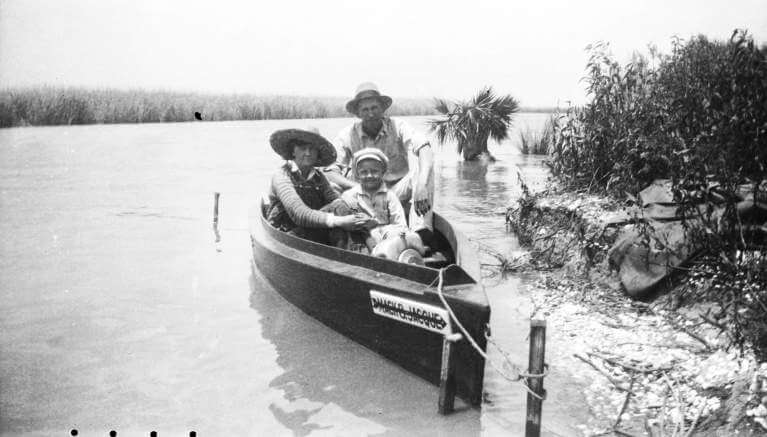 Rauschenberg boating with his parents Ernest and Dora Rauschenberg on the bayou near Port Arthur, Texas, fall ca. 1927
Rauschenberg boating with his parents Ernest and Dora Rauschenberg on the bayou near Port Arthur, Texas, fall ca. 1927
1943-49
1943
Fall: Enters The University of Texas at Austin to study pharmacology, at parents’ recommendation; drops out due to the difficulty of the coursework (not recognizing at this point that he is dyslexic) and to his refusal to dissect a frog in biology class.
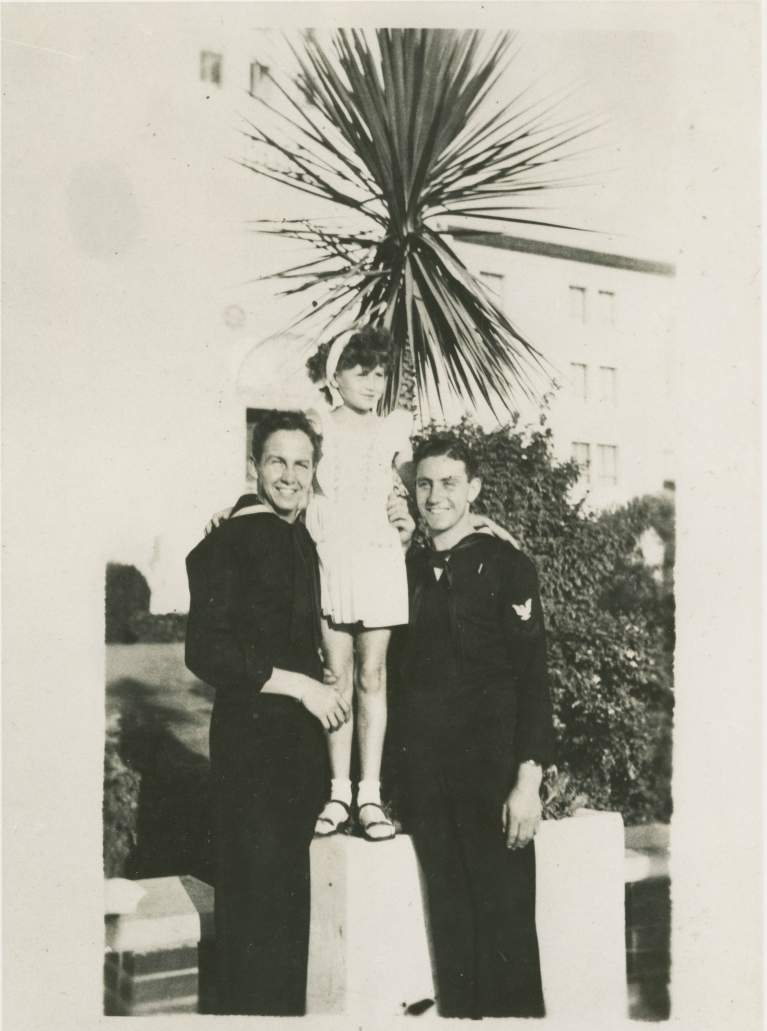 Rauschenberg, his sister Janet, and a friend from the Navy, San Diego Naval Repair Base, ca. 1944
Rauschenberg, his sister Janet, and a friend from the Navy, San Diego Naval Repair Base, ca. 1944
1944
Winter: Works briefly at a soda fountain in a drugstore in Austin.
February: Drafted into the U.S. Navy. Enters boot camp at Farragut, Idaho, where he draws portraits for fellow GIs to send home.
April: After proclaiming to the Navy that he does not want to kill anyone, is transferred to Hospital Corps School for nursing instruction and works in various Naval hospitals in California.
1945–1946
Fall 1945–Winter 1946: Trains as a neuropsychiatric technician in the Navy Hospital Corps, while stationed at Camp Pendleton, San Diego. Experiences with traumatized sailors strengthen his antiwar convictions. During this time, he visits the Huntington Library, Art Collections and Botanical Gardens in San Marino—his first visit to an art museum—where he discovers original oil paintings, including Thomas Gainsborough’s The Blue Boy (1770) and Thomas Lawrence’s Sarah Barrett Moulton: Pinkie (1794), previously seen only as reproductions in books and on playing cards. Even though he has enjoyed drawing all his life, Rauschenberg now realizes for the first time that he can become an artist. Buys art supplies and begins painting.
Receives an honorable discharge from the U.S. Navy. Hitchhikes from San Francisco to Port Arthur, Texas.
Settles in Los Angeles and works briefly as an illustrator for a Westwood newspaper and later as a packing clerk at a bathing suit factory where he meets Pat Pearman, an assistant designer, who convinces him that he has talent after seeing his drawings.
1947
Late January: Follows Pat Pearman to Kansas City, Missouri. Upon arrival in Kansas City, changes his name from Milton to Bob (subsequently Robert) after considering the most common names he could think of while sitting all night in a Savarin coffee shop.
February–December: At Pearman’s suggestion, enrolls in the Kansas City Art Institute on the GI Bill. With fellow students, paints backdrop used at Kansas City Municipal Auditorium for an appearance by President Truman. While attending classes at night, works at many odd jobs, including preparing window displays, making models for an industrial designer, and fabricating movie sets and photographers’ props. Saves money to study art in Paris.
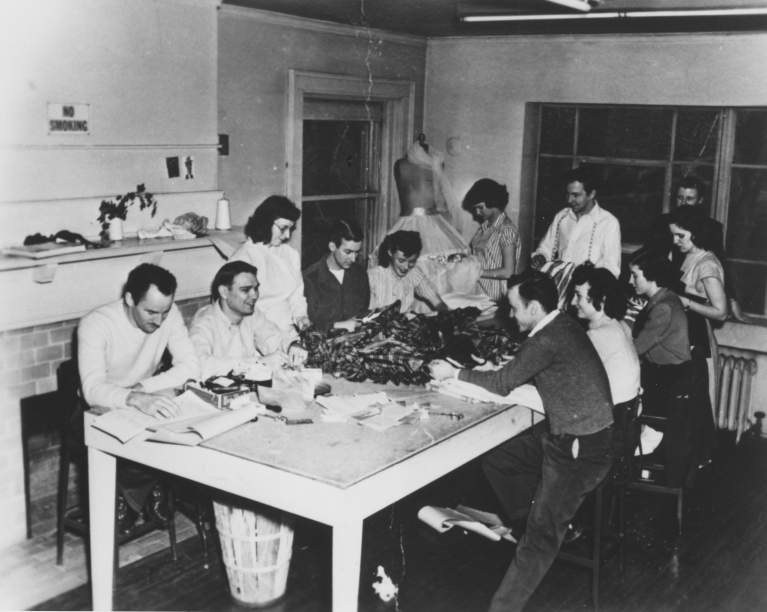 Rauschenberg (standing at rear of table) with fellow students, Fashion Design studio, Kansas City Art Institute, Missouri, 1947
Rauschenberg (standing at rear of table) with fellow students, Fashion Design studio, Kansas City Art Institute, Missouri, 1947
1948
April: Rauschenberg's father is promoted to line foreman at Gulf States Utilities and relocates to Lafayette, Louisiana. His wife and daughter will join him by the fall.
June 2: After a brief stay in New York, departs for Paris on the SS Marine Falcon. On the GI Bill, enrolls in the Académie Julian.
Summer: Meets Susan Weil, who also attends the Académie Julian and lives in the same rooming house on Rue Stanislas. Dissatisfied with the instruction and the apathy of his fellow students, Rauschenberg spends most of his time with Weil, visiting galleries where he first views works by such European modernists as Henri Matisse and Pablo Picasso. Inspired, he paints passionately, often dispensing with brushes and using his hands.
September 23–October 3: Departing from Le Havre, France returns to the United States aboard the SS Marine Tiger. After arriving in New York, visits his family in Lafayette, Louisiana.
October–December: With Weil, enrolls in Black Mountain College, near Asheville, North Carolina, after reading an article in the August issue of Time magazine on the disciplined approach to art of Josef Albers, formerly an instructor at the Bauhaus in Germany; a professor at Black Mountain College since 1933, Albers becomes rector in 1948. Although they are often at odds, Rauschenberg will later regard Albers as his most important teacher. Rauschenberg studies the basic methods of Werklehre (“practical instruction”), Albers’s method that he developed at the Bauhaus of working with the inherent properties of materials and developing “combination” techniques of “structure, texture, and facture.”1 Creates This Is the First Half of a Print Designed to Exist in Passing Time (1948); one of the few works, along with two photographs, still extant from this period. It is a woodcut for which the block of wood is progressively cut with lines, the image emerging from black to white over fourteen stages.
- 1. Josef Albers, quoted in Martin Duberman, Black Mountain: An Exploration in Community (New York: W. W. Norton, 1993), p. 56.

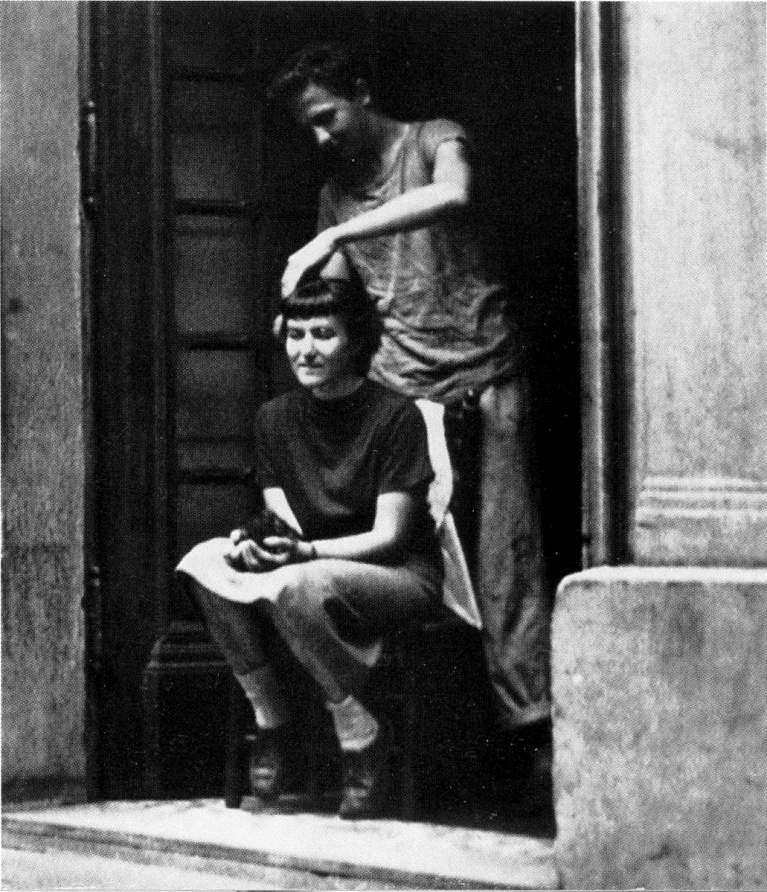 Susan Weil and Rauschenberg, Paris, 1948
Susan Weil and Rauschenberg, Paris, 1948
1949
January: At Albers’s request, Rauschenberg and Weil deliver Albers’s artworks to New York for his Egan Gallery exhibition that opens on January 24.
Late spring: Completes first academic year at Black Mountain College, near Asheville, North Carolina.
Summer: Passes summer at Weil’s family home on Outer Island, Connecticut, where Weil introduces Rauschenberg to the method of exposing blueprint paper.
Late summer–fall: Moves to New York, renting a room on East Eighty-seventh Street near the Weil family’s apartment. Enrolls in the Art Students League, New York, again on the GI Bill, where he studies under Vaclav Vytlacil and Morris Kantor. Rauschenberg receives very little positive feedback for his work, which differs markedly from that of his fellow students such as Knox Martin and Julius Hatofsky, but the league’s education is less important to Rauschenberg than its offering of studio space and a milieu for artists. Creates a work, no longer extant, by collecting imprints of students’ feet as they walk through a doorway of the school. The action is later recounted by poet Robert Creeley in the exhibition catalogue Poets of the Cities: New York and San Francisco 1950–1965 (1974). Moves to a studio in a building on Willett Street, near the Williamsburg Bridge in downtown Manhattan, which he shares with a group of fellow students. Rauschenberg and Weil frequent the vanguard galleries of Charles Egan, Samuel Kootz, and Betty Parsons, viewing the first generation of American postwar art and admiring in particular the freedom of expression of the Abstract Expressionists.
October: Paints a scene for the baptistery of the newly constructed Church of Christ building in Lafayette.
1950-59
1950
January–March: Continues to attend classes at the Art Students League, New York.
June 21: Marries Weil and, after honeymooning in Bermuda, spends summer at the Weils’ home on Outer Island, Connecticut.
Fall: Rauschenberg and Weil rent an apartment at 6 West Ninety-fifth Street, New York, which also serves as their studio. Painter Jack Tworkov visits apartment.2
Between October 16–November 4: Visits Franz Kline’s first solo exhibition, Egan Gallery, New York.
Late fall: Approaches gallery owner Betty Parsons for a critique of his work. Parsons, who represents major artists such as Barnett Newman, Jackson Pollock, Mark Rothko, and Clyfford Still, unexpectedly offers Rauschenberg a show in spring 1951. Accompanied by Still, Parsons visits Rauschenberg’s apartment/studio space to select works for the exhibition.
- 2. Thanks to Sarah Roberts and Meredith Van Dyke of the San Francisco Museum of Modern Art for confirming the exact address of the 95th Street apartment, based on the address included in an expense report dated June 6, 1951. Box 14, folder 20, Betty Parsons Gallery records and personal papers, ca. 1920–91, bulk 1946–83, Archives of American Art, Smithsonian Institution, Washington, D.C.

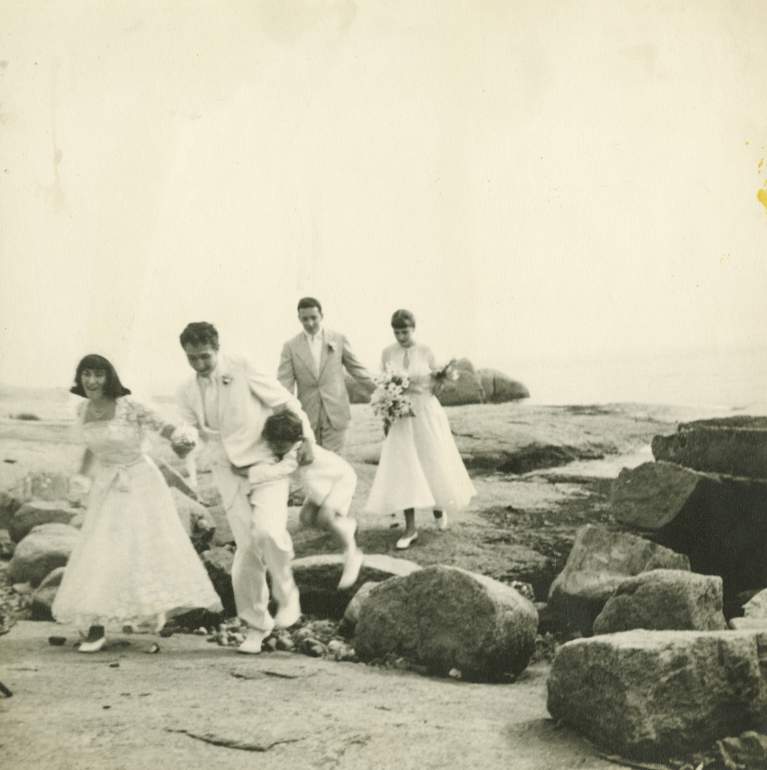 Susan Weil and Rauschenberg on their wedding day with members of their wedding party, Outer Island, Connecticut, June 1950
Susan Weil and Rauschenberg on their wedding day with members of their wedding party, Outer Island, Connecticut, June 1950
1951
Gene Moore, chief window designer for Bonwit Teller and later Tiffany & Co., includes blueprints by Rauschenberg and Weil in one of his window displays at Bonwit Teller, New York. These blueprints are no longer extant and were likely discarded when the windows were deinstalled. Work for Moore will provide critical economic support for several years.
February–May: Continues to attend Art Students League, New York. Meets fellow student Cy Twombly.
April 9: “Speaking of Pictures,” a three-page article in Life magazine, features Rauschenberg and Weil making blueprints, which are no longer extant.
May 2–July 4: Rauschenberg’s and Weil’s Blueprint: Photogram for Mural Decoration (now entitled Female Figure, ca. 1950) is exhibited in Abstraction in Photography, organized by Edward Steichen, Director of the Department of Photography, Museum of Modern Art, New York.
May 14–June 2: First solo exhibition, Betty Parsons Gallery, New York. To Parsons’s surprise, Rauschenberg has attempted to improve some of the works originally selected for the show by repainting them. The exhibition is held in the smaller gallery; the original checklist includes thirteen artworks, and perhaps as many as seven others circulated through the gallery during the two weeks of the exhibition.3 The larger, main room exhibits works by Walter Tandy Murch, an artist known for his realistic depictions of mechanical objects and illustrations for such magazines as Forbes and Scientific American. None of Rauschenberg’s paintings are sold.4 Jack Tworkov brings art dealer Charles Egan to the exhibition. Rauschenberg meets gallerist Leo Castelli and composer John Cage for the first time. Discusses Black Mountain College with Cage, who taught there in summer 1948 (prior to Rauschenberg’s arrival), and gives Cage Number 1 (1951), a painting that is no longer extant; Rauschenberg recycles the canvas in 1953 and makes Untitled [small black painting]. The friendship between Rauschenberg and Cage will solidify the following summer, which they will both spend at Black Mountain College, near Asheville, North Carolina.
May 24–June 10: Upon invitation by Castelli and Tworkov, participates in Today’s Self-Styled School of New York, the first Artists’ Annual exhibition at the Ninth Street Gallery, New York, also known as the Ninth Street Show. Exhibits 22 The Lily White (ca. 1950), which he removes from the Parsons Gallery exhibition, and an unidentified painting. The exhibition, which is conceived by members of the Club—a loosely organized group of intellectuals, artists, dealers, writers, and musicians—presents vanguard works by sixty-one artists who have been overlooked by museums and marks the first time that the group exhibits together, consolidating a movement that comes to be known as the New York School.
July 16: Birth of son, Christopher, in New York. Aaron Siskind takes baby pictures.
Summer–fall: Returns to Black Mountain College, where Weil and Christopher join him briefly until Rauschenberg and Weil decide to separate. Poet Charles Olson has assumed leadership of Black Mountain College following Albers’s departure in 1949. Fellow students include Dorothea Rockburne and Twombly. Faculty members include Hazel Larsen Archer, with whom Rauschenberg first studies photography. Also in residence during the summer session are photographers Harry Callahan and Siskind, and painters Ben Shahn and Robert Motherwell. Rauschenberg conceives a project in which he will photograph the United States “inch by inch.”5 Begins several groups of paintings, most of which he will complete by summer 1952. The Night Blooming series (1951) consists of approximately eighteen large, predominantly black canvases, often impressing gravel or dirt into the pigment. Siskind takes some of these works to an exhibition at Seven Stairs Gallery, Chicago; the exhibition, however, is never held, and all but three works are now believed to be lost. The White Painting series (1951) consists of modular canvases painted entirely in white, and which reflect changes in light and the chance effect of shadows in the surrounding space. In a letter to Parsons, trying to convince her to exhibit the White Paintings, he writes that he “will forfeit all right to ever show again for their being given a chance to be considered for this year’s calendar.”6 Due to the premium Rauschenberg puts on keeping the white canvases pristine, over the years he directed assistants and friends to repaint and sometimes entirely remake them. Several of the original White Paintings will be reused in the making of later works, including many of the Combines. Also begins extended period on a body of work known as the Black Paintings (1951–53). An artistic concern until the spring of 1953, the Black Paintings were created using matte or glossy paint, sometimes in multiple panels with newspaper frequently as the ground—a characteristic sometimes revealed, but occasionally only apparent by the activated picture surfaces.
Fall: Illustrates Joel Oppenheimer’s “The Dancer,” a poem commemorating a performance by Black Mountain College dance instructor Katherine Litz (whose students include Viola Farber, a future Rauschenberg collaborator), published in an edition of 150.7 For the photo-offset reproduction, Rauschenberg creates abstract drawings of arrows that simulate the dance-like energy of movement.
Late fall: Returns to New York, occasionally works as a freelance window designer. Between November 26 and December 15, views Jackson Pollock exhibition, Betty Parsons Gallery.
- 3. Susan Davidson, “Mother of God,” Rauschenberg Research Project (San Francisco: San Francisco Museum of Modern Art, July 2013), http://www.sfmoma.org/explore/collection/artwork/37592/essay/mother_of_god.
- 4. Many of the exhibited works are destroyed the following summer in a fire at the Weils’ summer home or in 1957 in a fire at the apartment of artist Sari Dienes. Only four of the seventeen works are extant today: Crucifixion and Reflection (ca. 1950), Mother of God (ca. 1950), 22 the Lily White (ca. 1950), and Untitled (1951). Two additional works, Number 1 (1951) and Should Love Come First? (ca. 1951; now known as Untitled [small black painting]), were repainted black in 1953. Photographs by Aaron Siskind document four of the lost or destroyed works; the photographs are published in Roni Feinstein, “The Unknown Early Robert Rauschenberg: The Betty Parsons Exhibition of 1951,” Arts Magazine (New York) 59, no. 5 (Jan. 1985), pp. 126–29.
- 5. Quoted in Alain Sayag, “Interview with Robert Rauschenberg,” Robert Rauschenberg Photographs (New York: Pantheon Books, 1981), unpaginated.
- 6. The handwritten letter is reproduced in Walter Hopps, Robert Rauschenberg: The Early 1950s, exh. cat. (Houston: The Menil Collection and Houston Fine Arts Press, 1991), p. 230.
- 7. Joel Oppenheimer, “The Dancer,” Jargon, no. 2 (Black Mountain College, N.C.: Sad Devil Press, 1951).


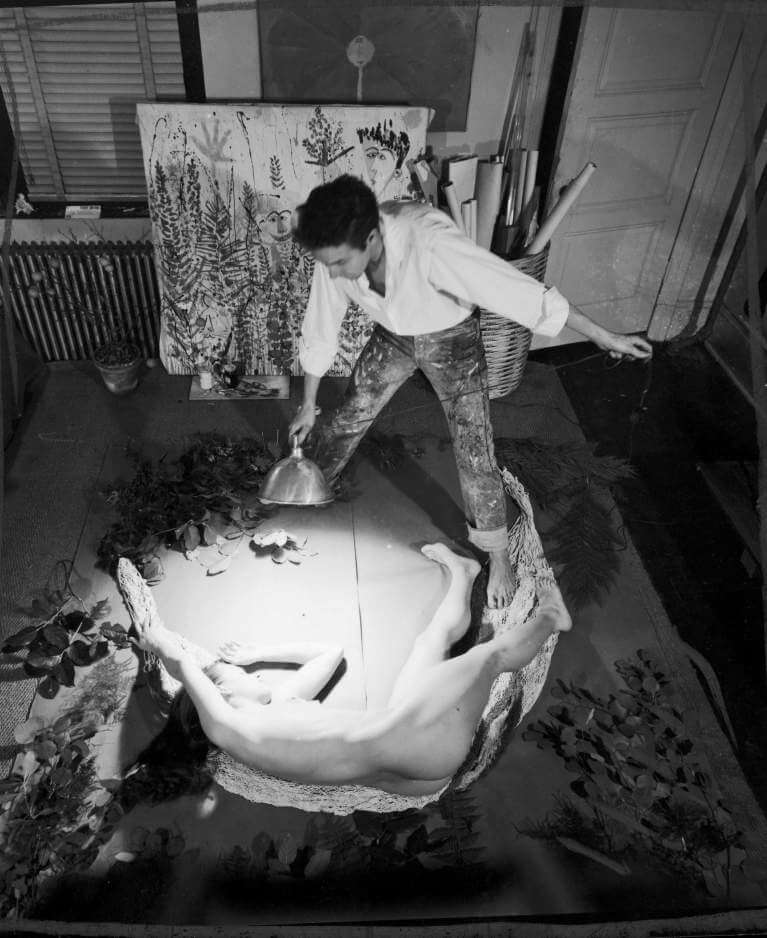 Rauschenberg making a blueprint with a Life magazine model, West Ninety-fifth Street apartment, New York, spring 1951. Photo: Wallace Kirkland/Time & Life Pictures/Getty Images
Rauschenberg making a blueprint with a Life magazine model, West Ninety-fifth Street apartment, New York, spring 1951. Photo: Wallace Kirkland/Time & Life Pictures/Getty Images

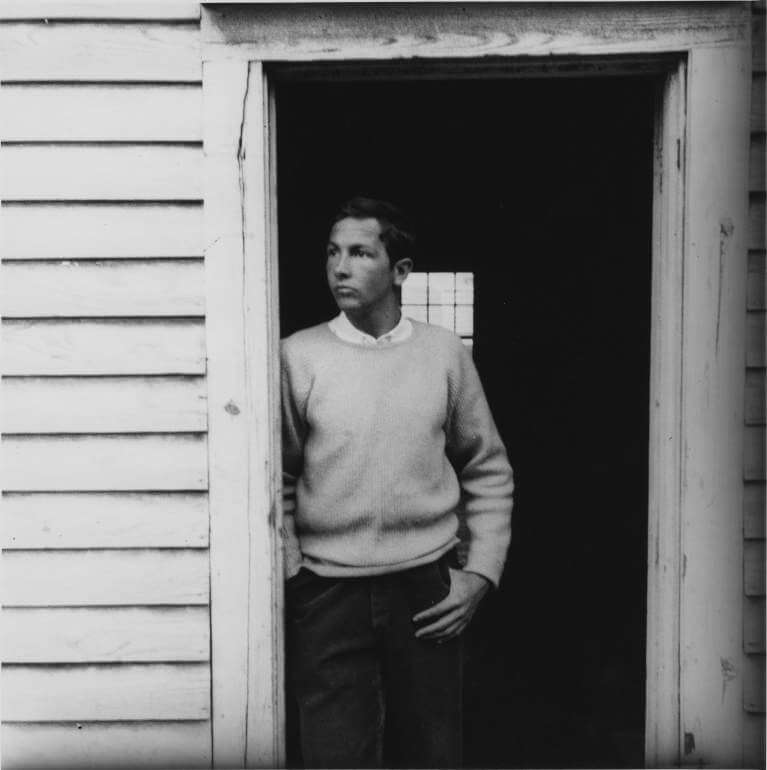 Rauschenberg at Black Mountain College, North Carolina, ca. 1951. Photo: Cy Twombly. Courtesy Fondazione Nicola Del Roscio
Rauschenberg at Black Mountain College, North Carolina, ca. 1951. Photo: Cy Twombly. Courtesy Fondazione Nicola Del Roscio
1952
January: For the Museum of Modern Art, New York, Edward Steichen acquires two photographs made by Rauschenberg at Black Mountain College, near Asheville, North Carolina: Untitled (Interior of an Old Carriage) (1949) and Untitled (Cy on Bench) (1951); these works are the first acquired by a museum.
Spring–summer: Continues at Black Mountain College, studying with visiting faculty Jack Tworkov and Franz Kline. Also studies with John Cage and Merce Cunningham, collaborators since 1942, who allow movement and music to coexist without any predetermined relationship except for that of time. Rauschenberg’s friendship with Cage and Cunningham solidifies over the course of the summer, and their collaborations will manifest and develop for the remainder of their lives.
Spring break: Travels with Cy Twombly to Charleston, South Carolina; New Orleans; Key West; and Cuba. While in Cuba, Rauschenberg experiments with transfer drawing, rubbing the back of a printed image to transfer images to another sheet of paper, a technique he will fully develop in 1958.
Summer: Participates in an untitled event (later referred to as Theater Piece No. 1, now considered the first Happening) organized by Cage, in the dining hall of Black Mountain College. Varying accounts of the unscripted event describe activities occurring simultaneously: Cunningham improvises a dance around and through the audience, Cage delivers a lecture, M. C. Richards recites poetry from a ladder, David Tudor plays piano, and Rauschenberg plays old records by Edith Piaf and others on a hand-wound, Edison, horn record player. Charles Olson also participates, most likely reading his own poetry. Slides and a flickering eight-millimeter film, possibly by Nick (Nicola) Cernovich, may have been projected onto the walls and ceiling. Panels of Rauschenberg’s White Paintings are hung from the rafters overhead. Other participants include R. Buckminster Fuller and Dorothea Rockburne.8
August: Cage creates his silent piece 4'33", a work in three movements in which Tudor, seated quietly at a piano, signals the beginning and end of each movement by opening and closing the keyboard cover. Cage acknowledges that Rauschenberg’s White Paintings, as well as a visit to Harvard University’s anechoic chamber—a soundproof and reverberation-free environment—inspired the work.
August 10: The exhibition Paintings by Robert Rauschenberg opens at Black Mountain College. 9
August 20: Sets sail for Naples, Italy aboard the SS Argentina, scheduled to arrive on September 1, stopping in the Sicilian port of Palermo on the way. Travels with Twombly, who has won a travel fellowship from the Virginia Museum of Fine Arts, Richmond. Rauschenberg had photographed Twombly’s paintings for the application portfolio.
September: Rauschenberg and Twombly settle in Rome, near Piazza di Spagna.
September 1952–February 1953: Takes numerous photographs and accumulates a collection of objects from which he creates three significant groups of work: (1) A series of collages, referred to as North African Collages (1952), fabricated on cardboard from laundered shirts using local printed papers and old engravings found in bookstalls and flea markets.10 (2) Feticci Personali, hanging “fetish” assemblages of wood, rope, animal fur, and various small objects, which may be inspired by ritual artifacts used by North African tribes that he sees during his travels. These works are Rauschenberg’s first to involve suspension; although none are known to be extant, several are documented in photographs by the artist in Rome (ca. 1953) and in the Fulton Street studio (ca. 1954). (3) Scatole Personali (1952–53), wood or metal boxes containing found objects and materials such as pebbles, sticks, dirt, engravings, and beads. These three groups reveal the influence of Joseph Cornell with whom Rauschenberg was familiar through exhibitions at Egan Gallery, New York (for example, a December 1949 exhibition from which Susan Weil’s parents bought three of Cornell’s works) and having visited Cornell’s home on Utopia Parkway, Queens, New York, to transport works to the Egan Gallery.
October: Rauschenberg and Weil’s divorce is finalized.
Late October: Out of money, the artist travels to North Africa and gets a job with the Atlas Construction Company in Casablanca. Twombly joins him later in the year, and the two travel through Morocco to Tangier, where they meet writer Paul Bowles, a friend of Cage, with whom they travel to Tétouan in northern Morocco.
- 8. For additional accounts of the event, see Duberman, Black Mountain, pp. 350–58, and William Fetterman, “The Untitled Event at Black Mountain College, Theatre Piece, Solos in Song Books, and Dialogue: Variations on Small-Group Simultaneities,” in John Cage’s Theatre Pieces: Notations and Performances (Amsterdam: Harwood Academic Publishers, 1996).
- 9. No information other than the printed announcement survives.
- 10. Of these intimately scaled collages, thirty-eight are known to still exist. In 1990, Rauschenberg created Shirtboards, an editioned version of these collages.

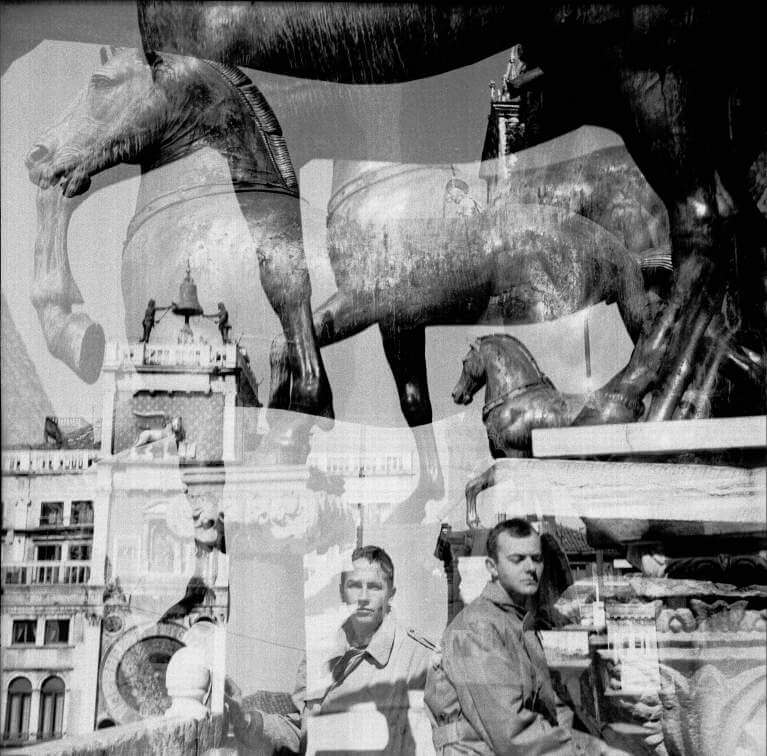 Robert Rauschenberg, Bob + Cy, Venice, 1952
Robert Rauschenberg, Bob + Cy, Venice, 1952


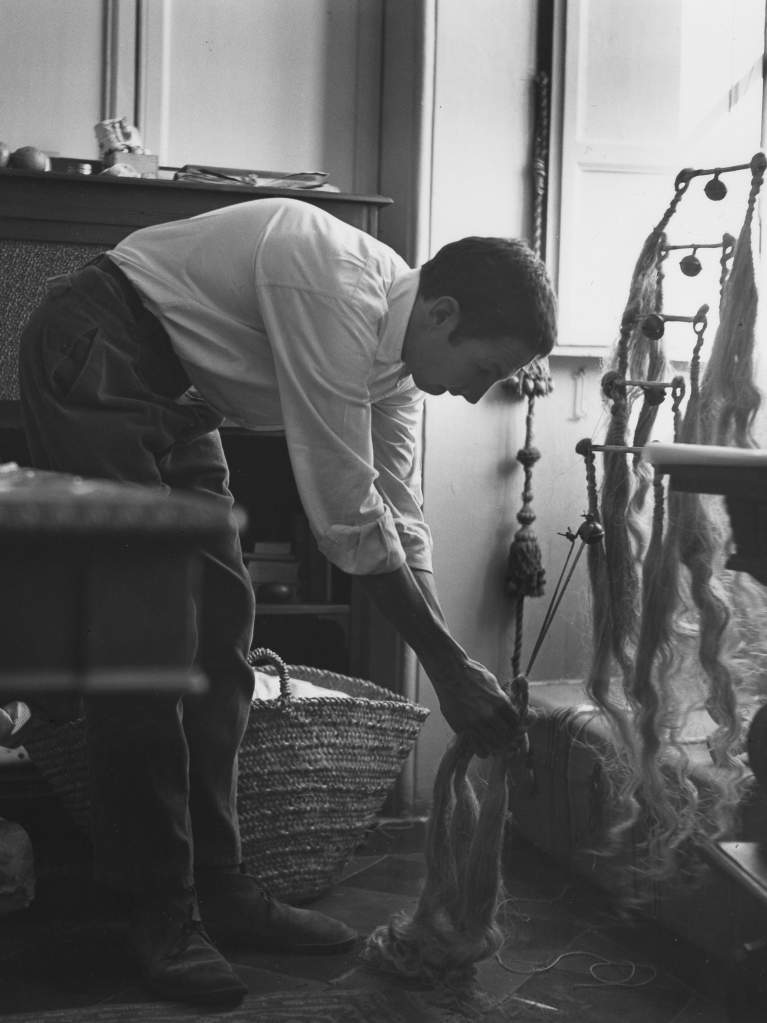 Rauschenberg working on Feticci Personali series (1952–53), Rome, 1953. Photo: Attributed to Cy Twombly
Rauschenberg working on Feticci Personali series (1952–53), Rome, 1953. Photo: Attributed to Cy Twombly
1953
January 11–February 7: Participates in 2nd Annual Exhibition of Painting and Sculpture, successor to the Ninth Street Show of 1951, Stable Gallery, New York. One of Rauschenberg’s Black Paintings, submitted by Jack Tworkov, who had been storing it, is exhibited.
February: Rauschenberg and Cy Twombly return to Rome from Africa by way of Spain.
March: In Rome, visits artist Alberto Burri, who is ill, and offers him a healing fetish, a small box construction, as a get-well gift. Burri gives a small work to Rauschenberg in return, Senza Titulo (1952), made of paint and fabric collage on Masonite.
March 3–10: First solo exhibition in Europe, Scatole e Feticci Personali, Galleria dell’Obelisco, Rome, a gallery that exhibits works by such contemporary Italian artists as Afro and Burri. To both Rauschenberg’s and the gallery owner’s amazement, some of the boxes and hanging wall pieces are sold, and Rauschenberg earns enough money to travel back to New York. In a statement for the exhibition, Rauschenberg writes, “Many of the boxes are a third- dimensional poem of one work: White.”11 The show travels as Scatole e Costruzioni Contemplative di Bob Rauschenberg to Galleria d’Arte Contemporanea, Florence, where Twombly’s exhibition Mostra de Arazzi di Cy Twombly opens on the same day.
April: Returns to New York on the SS Andrea Doria and moves into a loft at 61 Fulton Street in downtown Manhattan. Rauschenberg is one of the first New York artists to establish a studio loft in a formerly industrial building. Cage, Cunningham, Morton Feldman, and Philip Guston live in a nearby loft building. Photographs document that Twombly occasionally worked in Rauschenberg’s studio.
Between April 15 and May 9: Visits Dada 1916–1923, Sidney Janis Gallery, New York, curated by Marcel Duchamp, who also designs the poster.
Spring–summer: Completes the last of the Black Paintings, begun at Black Mountain College in 1951, and begins the Elemental Sculpture series (1953/1959), made of wood, stones, twine, steel spikes, and other materials found in the Fulton Street neighborhood. Also at the Fulton Street studio, Rauschenberg makes the first of the Gold Painting series (1953–ca. 1960), in which he applies gold leaf to a ground of newsprint, paper, on wooden supports. These are small works with highly tactile surfaces. Rauschenberg will return to the Gold Painting series later in the decade. The earliest Gold Paintings were created as part of the series of elemental paintings (ca. 1953), a term later coined to refer to artist’s work made with unconventional art materials including dirt, grass, gold, lead, clay, mold, and tissue paper, and often contained in wooden frames.12 Cage brings Feldman to Rauschenberg’s studio, where he buys a Black Painting for the amount of money in his pocket: $16 and some change. Continues to freelance window design for Gene Moore at Bonwit Teller, New York as a means of support.
Summer: Merce Cunningham Dance Company is formed during summer residency at Black Mountain College. The original dancers of the small company are Carolyn Brown, Remy Charlip, Judith Dunn, Viola Farber, Jo Anne Melsher, Marianne Preger, and Paul Taylor. Cage is musical director.
Eleanor Ward, owner of Stable Gallery, New York, is brought to Rauschenberg’s Fulton Street studio by painter Nicolas Carone. Ward offers Rauschenberg and Twombly a joint exhibition. Rauschenberg and Twombly clean out the basement of the gallery, a former horse stable, to exhibit their works there, as well as in the first-floor galleries. Rauschenberg will go on to work as a handyman and janitor for the gallery.
September 15–October 3: Concurrent exhibition of works by Rauschenberg and Twombly, Stable Gallery, New York. Rauschenberg exhibits two White Paintings and a selection of Black Paintings, as well as Elemental Sculptures.13 Cage writes a statement on the White Paintings for the exhibition: To whom/No subject/No image/No taste/No object/No beauty/No message/No talent/No technique (no why)/No idea/No intention/No art/No object/No feeling/No black/No white (no and)/After careful consideration, I have come to the conclusion that there is nothing in these paintings that could not be changed, that they can be seen in any light and are not destroyed by the action of shadows./Hallelujah! the blind can see again; the water’s fine.14 The show elicits six, mostly negative, reviews in the New York press and in art journals. None of the works are sold until the final day of the exhibition, when friends Carolyn and Earle Brown, a dancer and composer respectively, purchase a Black Painting for a total sum of $26.30—the amount of money in their pockets from cashing a telephone-deposit refund check.
Fall: Creates Automobile Tire Print and Erased de Kooning Drawing (both 1953). The first work is made with the collaboration of Cage and his Model A Ford on a quiet Sunday morning outside the Fulton Street studio. Cage slowly drives the car while Rauschenberg applies black house paint to the rear tire that also rolls down a long strip of paper, approximately twenty-two feet in length, which Rauschenberg has made by gluing together twenty sheets of paper. The work can be partially displayed like a rolled Japanese scroll. To create Erased de Kooning Drawing, Rauschenberg asks Willem de Kooning for a drawing to be erased and presented as Rauschenberg’s own work; de Kooning offers him a drawing made from pencil, crayon, and possibly ink, which will present a serious challenge. Spends almost a month erasing the work on which traces of de Kooning’s original marks still remain. Erased de Kooning Drawing will be exhibited for the first time in a group exhibition at Poindexter Gallery, New York (December 19, 1955–January 7, 1956),15 and then not again until 1964 at the Wadsworth Atheneum, Hartford, Connecticut.
Late fall: Begins Red Paintings (1953–54) that he will continue to work on until early summer 1954. Rauschenberg welcomes the challenge to explore what he regards to be “the most difficult color” with which to work.16 Like the Black Paintings completed at Fulton Street, the early Red Paintings are painted on canvases that incorporate newspapers and patterned fabrics as grounds. Heavily painted pigments are applied to the canvas in a variety of ways, including brushstrokes, drips, impasto, and color squeezed directly from the tube. As he continues to develop the series the following summer, Rauschenberg will begin to incorporate found objects, anticipating the three-dimensionality of the Combine series to follow.
Late fall: Introduced to Jasper Johns by Suzi Gablik (a painter friend from Black Mountain College and later an art critic) on a New York street corner near Marboro Books, an art bookstore where Johns works.
- 11. Rauschenberg’s statement is reproduced in Hopps, p. 32.
- 12. At this time, the known extant works from this group are: nine gold; one lead; one dirt; and two clay paintings, one of which was remade by the artist as a replacement for the 1953 original belonging to John Cage that had been borrowed for exhibition but was never returned.
- 13. Ten of the works, which have been lost or destroyed, are documented in photographs of the exhibition made for Life, although they were never published in the magazine.
- 14. John Cage’s statement, distributed as a handout in the gallery, is quoted in its entirety in Emily Genauer, “Art and Artists: Musings on Miscellany,” New York Herald Tribune, Dec. 27, 1953, sec. 4, p. 6.
- 15. The 1955–56 exhibition of the work is discussed in Sarah Roberts, “Erased de Kooning Drawing,” Rauschenberg Research Project (San Francisco Museum of Modern Art, July 2013). Accessed Sept. 15, 2014. http://www.sfmoma.org/explore/collection/artwork/25846/essay/erased_de_kooning_drawing. The exhibition dates are confirmed by the Estate of Jack Tworkov website, where the exhibition announcement is also available. Accessed Sept. 15, 2014. http://jacktworkov.com/exhibitions/index.php?.
- 16. Quoted in Barbara Rose, Rauschenberg (New York: Vintage Books, 1987), p. 53.

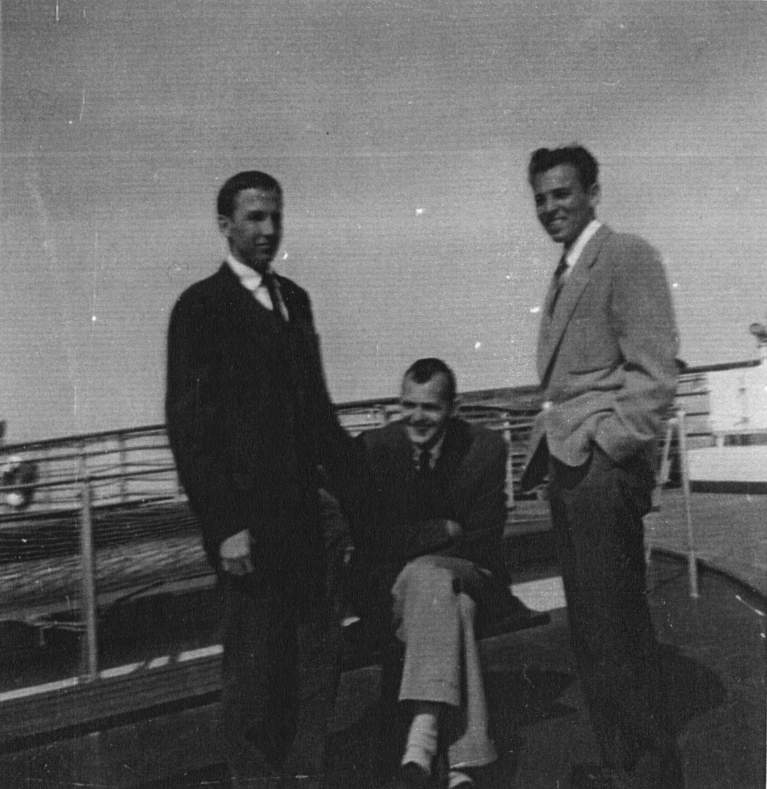 Rauschenberg (left) and Cy Twombly (seated) returning from Italy to New York City aboard SS Andrea Doria with fellow passenger Kurt Osinsky (right), April 1953. Photo: Edith Osinsky
Rauschenberg (left) and Cy Twombly (seated) returning from Italy to New York City aboard SS Andrea Doria with fellow passenger Kurt Osinsky (right), April 1953. Photo: Edith Osinsky

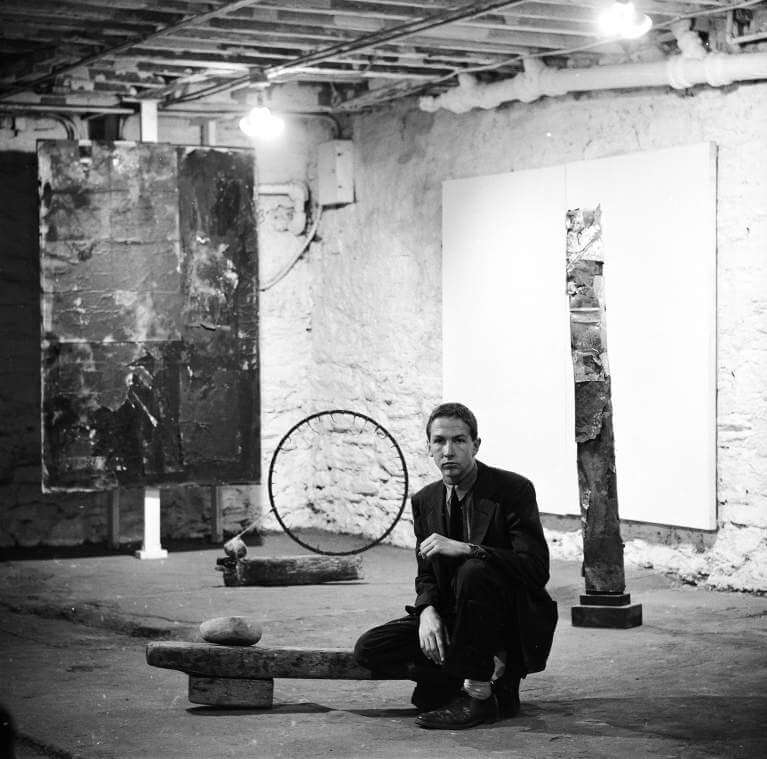 Rauschenberg at Robert Rauschenberg: Paintings and Sculpture, Stable Gallery, New York, fall 1953. Photo: Allan Grant/Time & Life Pictures/Getty Images
Rauschenberg at Robert Rauschenberg: Paintings and Sculpture, Stable Gallery, New York, fall 1953. Photo: Allan Grant/Time & Life Pictures/Getty Images
1954
Winter: Meets Jasper Johns again at Sari Dienes’s New York studio, where informal salons for young artists frequently take place. Johns begins to work with Rauschenberg on window displays; in the summer, Johns will quit his job at Marboro Books and support himself with display work.
January 27–February 20: Participates in the 3rd Annual Exhibition of Painting and Sculpture, Stable Gallery, New York. Exhibits Growing Painting (1953). The work had been created when seeds that Rauschenberg fed to birds accidentally fell into a dirt painting. Rauschenberg watered it until it became a grass painting. During the exhibition, Rauschenberg visits the gallery every day to water the work, but ultimately the grass, and thus the painting, dies.
While tending to Growing Painting meets dancer/choreographer Paul Taylor, who has recently left Merce Cunningham Dance Company to form his own company. Rauschenberg will begin work as set and costume designer with Paul Taylor Dance Company later this year. Taylor will assist Rauschenberg and Johns on window displays and rescue Pink Clay Painting (To Pete) (1953), one of Rauschenberg’s clay paintings (the only extant example), from the garbage.
May 30: Premiere of Paul Taylor Dance Company’s Jack and the Beanstalk, Henry Street Playhouse, New York, for which Rauschenberg designed the costumes and set. It includes an illuminated golden egg and a beanstalk suspended by gas-filled balloons.
Mid-summer: Works again on Red Painting series. Begins to reveal more of the newspaper surfaces and incorporate found objects, art reproductions, and constructed appendages, resulting in works such as Untitled, Collection, and ultimately Charlene, which although still predominantly red in color, are considered to be the first Combines. Coins the term “combine” to refer to a body of work that he will continue to expand upon through 1964, some of which are freestanding, while others hang on the wall—conflating aspects of both painting and sculpture.
[Fall]: Makes Untitled (ca. 1954), a Combine that includes a stuffed Plymouth Rock hen, a “black painting,” and several autobiographical references, including photographs and drawings by Twombly and Tworkov, as well as a pair of white shoes. Rauschenberg later describes this work as the “first real Combine.”17
November: Tworkov brings Egan to the Fulton Street studio to view Red Paintings and Combines.
December 8: Premiere of Merce Cunningham Dance Company’s Minutiae, Brooklyn Academy of Music, New York, for which Rauschenberg designed the set. Instructed by Cunningham to make a self-contained set through which dancers can move, Rauschenberg creates the Combine Minutiae by applying paint and various collage elements to fabric on a wooden structure.
December 13, 1954–January 22, 1955: Exhibition of Red Paintings and Combines, entitled Joyeux Noël by Rauschenberg, Egan Gallery, New York. Among the works exhibited are Collection, Yoicks, and two Untitled works [54.014 and 54.016] (all 1954).18 One visitor, John Blair Lynn Goodwin, half brother of sculptor David Hare, buys two works for $50 total.19 Mainly negative reception appears in the press except for a review by poet and critic Frank O’Hara in Artnews, perhaps the first enthusiastic review of Rauschenberg’s career to date.
December 20, 1954–January 20, 1955: Shows Paint Cans (1954), a small Combine, in a group exhibition at Tanager Gallery, New York. Exhibition also includes Johns’s Construction with Toy Piano (1954) and a work by Rachel Rosenthal.

 Rauschenberg with his untitled Combine (ca. 1954), in the exhibition U.S. Paintings: Some Recent Directions, Stable Gallery, New York, late fall 1955. Photo: Ed Wergeles
Rauschenberg with his untitled Combine (ca. 1954), in the exhibition U.S. Paintings: Some Recent Directions, Stable Gallery, New York, late fall 1955. Photo: Ed Wergeles

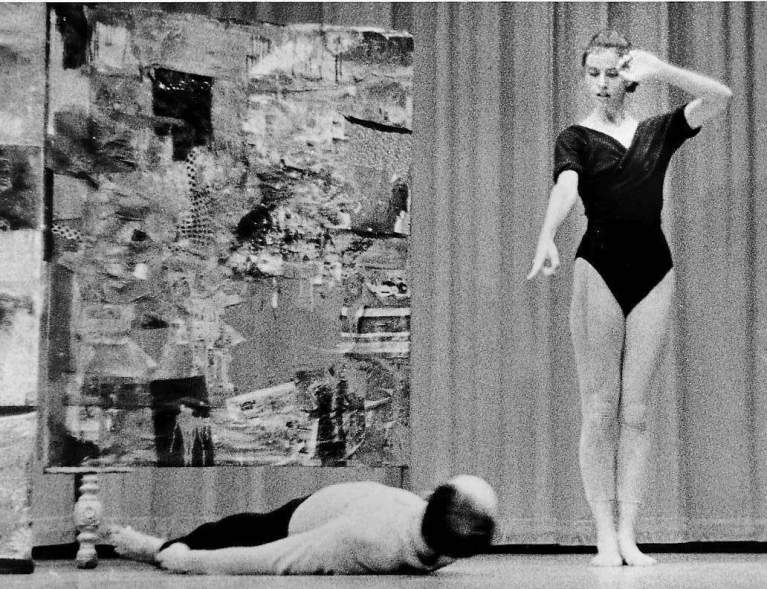 Set by Rauschenberg for Merce Cunningham Dance Company’s Minutiae (1954), rehearsal, ca. 1954. Pictured: Remy Charlip and Anita Dencks. Photo: Louis Stevenson
Set by Rauschenberg for Merce Cunningham Dance Company’s Minutiae (1954), rehearsal, ca. 1954. Pictured: Remy Charlip and Anita Dencks. Photo: Louis Stevenson
1955
Continues to work on Combines: Bed (1955) is composed of a quilt, taken at Black Mountain College, near Asheville, North Carolina, from artist Dorothea Rockburne, that he stretches over a board and paints (at the time, he does not have enough money to buy canvas). Rauschenberg also applies red fingernail polish and striped toothpaste to the work. Odalisk (1955/1958), in which female imagery is prevalent, is a counterpart to the earlier Untitled (ca. 1954). Elements include a miniature blueprint of the full-size blueprint Female Figure (ca. 1950), as well as photographs of pinup girls and a reproduction of a figure in Titian’s Pastoral Concert (ca. 1510–11). Rather than the Plymouth Rock hen of Untitled (ca. 1954), a stuffed Plymouth Rock rooster sits atop the work. Rauschenberg will return to Odalisk in 1958 to adjust the electric-light elements. Monogram (1955–59) will evolve through three states, documented in drawings and photographs, before its completion in 1959. The work originates with a stuffed Angora goat that Rauschenberg purchases from a used furniture store. In its first state (1955–56), the goat stands on a shelf attached to a Combine painting that is later reworked and entitled Rhyme (1956).
January 1: Rauschenberg arranges a concert by composer Morton Feldman, a member of Cage’s circle, during the run of his exhibition at the Egan Gallery, New York. The event—Feldman’s first public performance of his own compositions—will later become known as the “Morton Feldman Concert with Paintings.”
March 15: Premiere of Paul Taylor’s solo dance performance Circus Polka (the work will be enlarged into Little Circus, which will premiere on June 6), Master Institute Theater, New York, for which Rauschenberg designed the costumes and set. The costumes include a necklace of cow bones for the ringmaster and a two-man horse outfit.
April 26–May 21: For the 4th Annual Exhibition of Painting and Sculpture at Stable Gallery, New York, Rauschenberg enters Short Circuit (1955), a work protesting the absence of the artists for whom he had recommended, and who had never exhibited in the previous annuals (the policy of this annual series is for past participants to suggest new artists). Rauschenberg asked four artists—Jasper Johns, Ray Johnson, Stan VanDerBeek, and Susan Weil—for works to be added to his larger painting, but only two paintings were ready for inclusion: a small encaustic flag painting by Johns and an oil painting by Weil. Rauschenberg also incorporates an early John Cage concert program and Judy Garland’s autograph into the larger work. Wooden doors marked “do not open” conceal Johns’s and Weil’s works. Johns’s painting will be stolen from the work while on exhibit in 1965, and Rauschenberg will replace it with a facsimile created by Elaine Sturtevant in 1967.
May 24: Premiere of Merce Cunningham Dance Company’s Springweather and People, Bard College, Annandale-on-Hudson, New York. Rauschenberg collaborates with Remy Charlip, Ray Johnson, and Vera Williams on the costume designs, which he will redesign in 1957.
Summer: Creates Rebus (1955), a Combine painting, on drop cloths (later remounted on canvas), which incorporates magazine illustrations, comic strips, and political posters to refer to a contemporary urban world dominated by mass media. As Rauschenberg later explains, the work is intended to be “a concentration of that particular week in that particular neighborhood.”20 It is painted with what he terms a “pedestrian color,”21 whereby no color stands out or is determined by his own personal taste but rather resembles the blur of colors one encounters on the street. The lighter, more open ground will be common in works from 1956–58.
September: Moves from Fulton Street to top floor studio at 278 Pearl Street, New York, where artist Rachel Rosenthal had lived. Johns’s studio is one floor below in the same building, and Rauschenberg and Johns see each other daily, exchanging ideas and discussing their work.
[Fall]: Continues to support himself by preparing window displays in New York for Bonwit Teller and Tiffany & Co. With Johns as partner, forms Matson Jones–Custom Display; “Matson” is Rauschenberg’s mother’s maiden name and “Jones” stands for Johns.
October 15: Meets director and producer Emile de Antonio at an evening of performances by Merce Cunningham and Cage, organized by de Antonio, Clarkstown High School, New City, New York.
November 29–December 23: Participates in U.S. Painting: Some Recent Directions, Stable Gallery, New York, organized by Thomas B. Hess, editor of Artnews. Exhibits Untitled (ca. 1954/1958) and – – – – (1950–55). The latter work, originally designated simply with four dashes, is later referred to as Self-Made Retrospective; it is a shallow cabinet inside of which hang miniature versions of Rauschenberg’s 1950–54 paintings: a Red Painting, a white lead painting, a dirt painting, a Gold Painting, a black painting, and a work modeled on paintings exhibited at the Betty Parsons Gallery, New York, in 1951. The work will be dismantled in the late 1950s, and at present two of the original pieces are known to survive; the Parsons-related work, Untitled (1954) was made expressly for Self-Made Retrospective, and it is likely that Untitled [small white lead painting] (ca. 1953) was included as well.

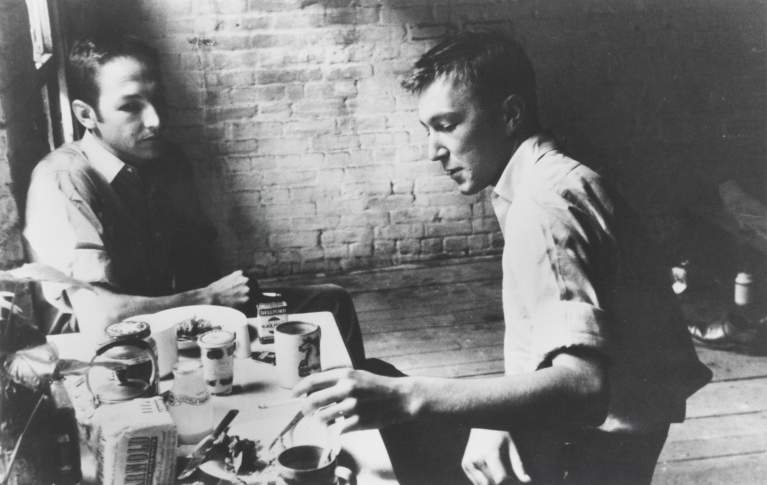 Rauschenberg and Jasper Johns in Johns’s Pearl Street studio, New York, ca. 1954. Photo: Rachel Rosenthal
Rauschenberg and Jasper Johns in Johns’s Pearl Street studio, New York, ca. 1954. Photo: Rachel Rosenthal

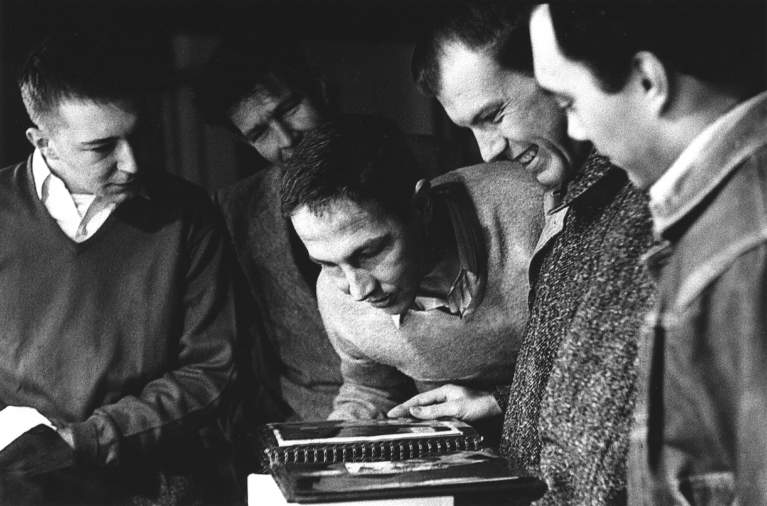 Rauschenberg with Jasper Johns, John Cage, and others in Rauschenberg’s or Johns’s Pearl Street studio, New York, ca. 1955 Photo: Jerry Schatzberg
Rauschenberg with Jasper Johns, John Cage, and others in Rauschenberg’s or Johns’s Pearl Street studio, New York, ca. 1955 Photo: Jerry Schatzberg
1956
Continues work on Monogram. In its second state, dated as early as 1956 by a photograph of the Combine in the artist’s studio, the goat is encircled by an automobile tire and set on a platform in front of a vertical canvas.
January 31–February 7: Untitled [red Combine painting] (1954) is shown in one of Gene Moore’s window displays at Bonwit Teller, New York. The painting, which has been altered since the 1954 exhibition of Red Paintings at Egan Gallery, New York, is missing the two left panels as well as the far right panel. Within the year, Rauschenberg will further dismantle the work by cutting it into sections to make several smaller red Combine paintings.
February–November: In New York, Matson Jones–Custom Display creates six window displays: three for Bonwit Teller and three for Tiffany & Co. The displays present a tableaux of a mushroom field, cans pouring paint, caves, a night scene, seventeenth-century still lifes, and a Christmas forest.
March 27: Premiere of Paul Taylor Dance Company’s Three Epitaphs, Master Institute Theater, New York, for which Rauschenberg designed the costumes. A revised version, Four Epitaphs, will premiere in May, however, the work will assume its original title in 1957.
May 6: Premieres of Paul Taylor Dance Company’s Four Epitaphs (a revised version of Three Epitaphs), The Least Flycatcher, for which Rauschenberg designed the costumes and created a score consisting of recorded kitchen sounds, and Untitled Duet, for which Rauschenberg designed costumes that incorporate noise-making elements, Henry Street Playhouse, New York.
May 18: Premiere of Merce Cunningham Dance Company’s Suite for Five in Space and Time, University of Notre Dame, South Bend, Indiana, for which Rauschenberg designed the costumes and lighting. The dance is one of Cunningham’s first to abandon meter, causing the dancers to rely on their own sense of timing within a designated time length. A revised version with a set and costumes by Rauschenberg will be performed with Nocturnes at the Brooklyn Academy of Music, New York on January 12, 1957.
July 11: Premiere of Merce Cunningham Dance Company’s Nocturnes, Jacobs Pillow, Lee, Massachusetts, for which Rauschenberg designs the set and costumes. The set includes a scrim of transparent white netting, partially obscuring some of the dancers. The costumes in the dance are made in white to recall the moonlight, while the headdresses are like “inhabited seashells” in the watercolors of Holbein.22
December 4: Premiere of Paul Taylor Dance Company’s Tropes, Master Institute Theater, New York, for which Rauschenberg designs the set and costumes.
- 22. Merce Cunningham and Dance Company, brochure (New York: Foundation for Contemporary Performance Arts, 1963), unpaginated.


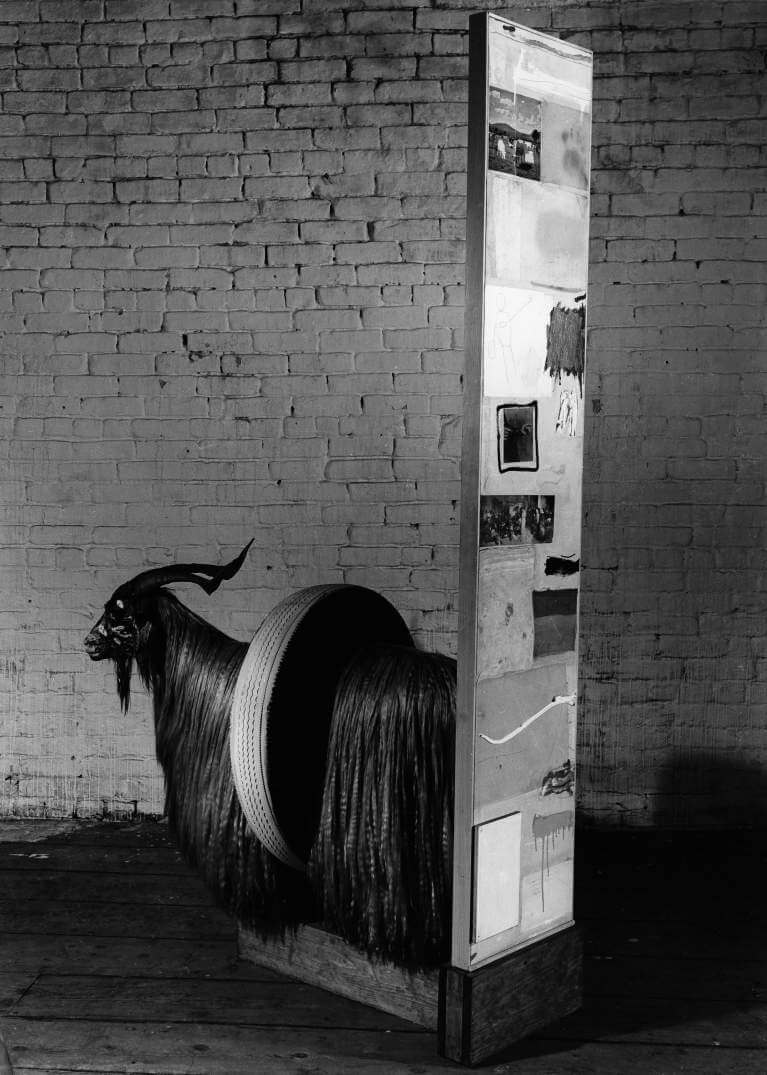 Second state of Rauschenberg's Monogram (1955-59; second state 1956-58) in his Pearl Street Studio, New York, ca. 1958. Photo: Rudy Burckhardt
Second state of Rauschenberg's Monogram (1955-59; second state 1956-58) in his Pearl Street Studio, New York, ca. 1958. Photo: Rudy Burckhardt
1957
January–October: Matson Jones–Custom Display designs three window displays for Tiffany & Co., New York, that present separate tableaux of desert landscapes, cobwebs, and falling leaves.
January 12: Performance of Merce Cunningham Dance Company’s Nocturnes (1956), Brooklyn Academy of Music, New York. When the original set is deemed unsafe by fire inspectors, Rauschenberg quickly improvises a new set design, reminiscent of his sculpture Greenhouse (ca. 1950), consisting of wire screening interwoven with green branches from nearby Prospect Park.
February 7: Premiere of John Cage’s Winter Music, Hobart and William Smith College, Geneva, New York. Composed for one to twenty pianists, Winter Music is dedicated to Rauschenberg and Jasper Johns. The composition marks Cage’s first significant foray into indeterminacy, or music based on unrepeatability.
February 10: Leo Castelli opens a gallery at 4 East 77th Street in New York devoted to the work of young American and European abstractionists.
Premiere of Paul Taylor Dance Company’s The Tower, Kaufmann Concert Hall, 92nd Street YM-YWHA, New York, with set by Rauschenberg and costumes by Johns. The set consists of a Combine, The Tower (1957). The performance also includes Tropes, The Least Flycatcher, Three Epitaphs, and Untitled Duet (all 1956), for which Rauschenberg created the set, costumes, and/or sound.
March 8: Morton Feldman and Ilse Getz bring Castelli and his wife Ileana (later Ileana Sonnabend) to Rauschenberg’s Pearl Street studio. Rauschenberg introduces them to Johns, whose work Castelli saw the previous day at the preview for Artists of the New York School: Second Generation at the Jewish Museum, New York. The Castellis are excited by Johns’s work and offer him a show, but leave without any offer to Rauschenberg. Several days later, they offer Rauschenberg a show in March 1958.
March 10–April 28: Participates in Artists of the New York School: Second Generation, an invitational, juried exhibition of twenty-three artists. Exhibits Red Import (1954) and three collages, including Opportunity #2, Opportunity #7, and Opportunity #9 (all 1956). Johns exhibits Green Target (1955).23
May 6–29: Participates in New Work: Bluhm, Budd, Dzubas, Johns, Leslie, Louis, Marisol, Ortman, Rauschenberg, Savelli, Leo Castelli, New York. Exhibits Gloria (1956). Johns exhibits Flag (1954–55).
October 20: Premiere of Paul Taylor Dance Company’s new program, Seven New Dances, Kaufmann Concert Hall, 92nd Street YM-YWHA, New York. According to the program, Rauschenberg and Johns are artistic collaborators. Set and costumes by Rauschenberg and Taylor, working under the pseudonym George Tacet. The performance includes the dances Epic, Events I, Resemblance, Panorama, Duet, Events II, and Opportunity. Based on Taylor’s interest in familiar movements, Rauschenberg suggests that the dancers wear their own clothing rather than designed costumes. For the set of Resemblance, Rauschenberg proposes that a dog signal the beginning of the piece by walking onto the stage and sitting, and the dog then designates the end by leaving the stage; during the actual performance, however, the dog does not perform as trained.
November 30: Premiere of Merce Cunningham Dance Company’s Changeling and Labyrinthian Dances, Brooklyn Academy of Music, New York. Rauschenberg designs the set and costumes for both works and also provided the lighting for Changeling. Springweather and People (1955) is also performed with redesigned costumes by Rauschenberg.
December 16, 1957–January 4, 1958: Participates in Collage in America, Zabriskie Gallery, New York, a traveling exhibition organized by the American Federation of Arts, New York. Exhibits Collage with Rock (1957).
- 23. The first state of Rauschenberg’s Monogram (1955–59; first state 1955–56) and Johns’s Target with Plaster Casts (1955) had both been submitted with the encouragement of Horace Richter (who had been introduced to the artists by Allan Kaprow), a member of the Jewish Museum’s Administrative Committee, but the works were ultimately declined by the jury and the other works were exhibited instead.


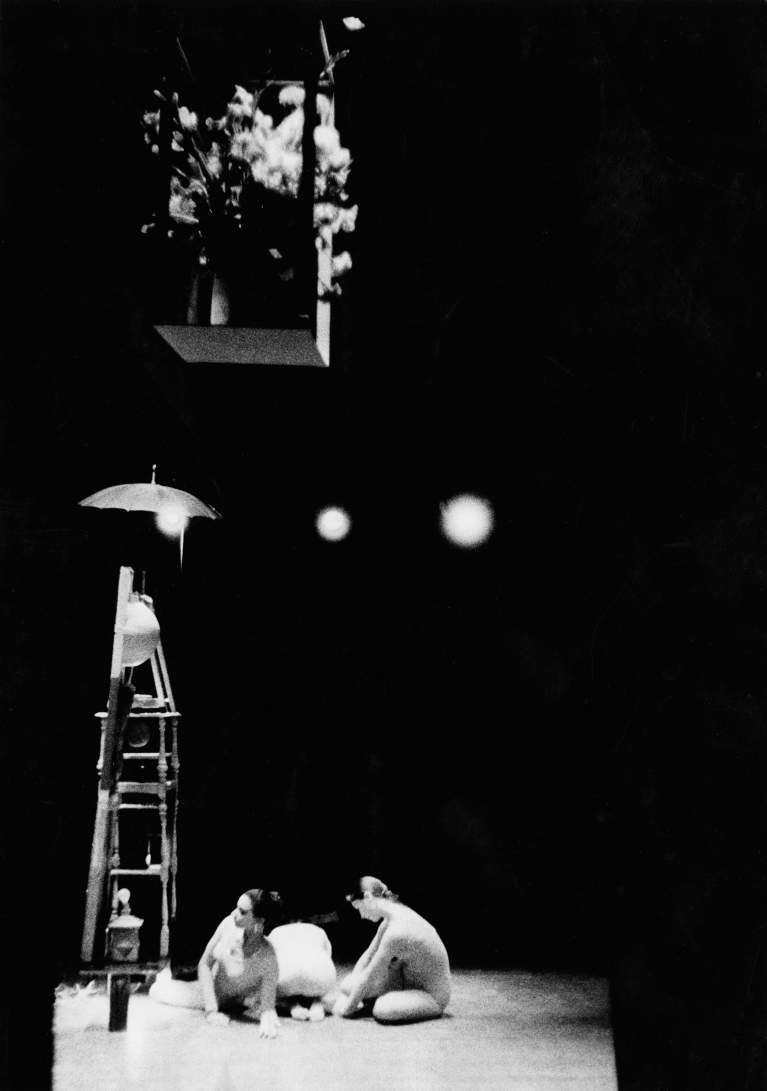 Set by Rauschenberg for Paul Taylor Dance Company’s The Tower (1957). Pictured: Matt Turney, Carol Rubenstein, and Barbara Janezic. Photo: Louis Stevenson
Set by Rauschenberg for Paul Taylor Dance Company’s The Tower (1957). Pictured: Matt Turney, Carol Rubenstein, and Barbara Janezic. Photo: Louis Stevenson
1958
January 20–February 8: Johns mounts his first solo exhibition, Jasper Johns: Paintings, Leo Castelli, New York. All but two paintings are sold by the close of the exhibition, including three to the Museum of Modern Art, New York.
February 27–April 6: Participates in Collage International: From Picasso to the Present, Contemporary Arts Museum, Houston. Exhibits Collage with Letter (1957). Johns exhibits Figure 1 (1955).
[Late winter]: Begins using solvent-transfer techniques with photographic reproductions from magazines to make drawings. Solvents, such as turpentine, are applied to the printed image, which when rubbed with the tip of a pen or other implement is transferred to the paper. He later uses lighter fluid in place of turpentine. The resulting image is a reversal of the original and reveals the artist’s use of the pen, the effect of which resembles hatching. Rauschenberg finds that glossy magazine illustrations work best and frequently selects images from Newsweek, Time, Sports Illustrated, and Life.
March: Moves to 128 Front Street after the Pearl Street building is condemned by New York City authorities. Johns also moves into the same building. Rauschenberg’s and Johns’s studios are above Marotta’s Real Italian Hero Sandwiches on the second and third floors respectively.
March 4–29: Robert Rauschenberg, Leo Castelli, New York. Exhibits approximately twenty Combines.24 Castelli buys Bed (1955), the only artwork sold.
March 18: Premiere of Paul Taylor Dance Company’s Rebus, Rutgers University, New Brunswick, New Jersey, for which Rauschenberg designs the set and costumes.
March 27: Participates in panel discussion “Patriotism and the American Home,” Eighth Street Club, moderated by Frederick Kiesler, who becomes a champion of Rauschenberg’s work. Other participants include Allan Kaprow, George Ortman, and Richard Stankiewicz.
May 15: With Emile de Antonio and Johns, organizes Twenty-Five Year Retrospective Concert of the Music of John Cage, Town Hall, New York. David Tudor selects music and Merce Cunningham conducts. A recording of the concert by George Avakian will later be released as a boxed record set. In conjunction with the concert, an exhibition of Cage’s scores is held at Stable Gallery, New York.
[Late spring]: Begins work on a series of transfer drawings based on the thirty-four cantos of Dante’s Inferno (1958–1960), which he has never previously read. Rauschenberg will spend two and a half years on the project, finishing in late 1960. Using John Ciardi’s translation of the poem, Rauschenberg works with Michael Sonnabend, a Dante scholar (and future husband of Ileana Castelli), to develop compositions, one for each of the thirty-four cantos (which he reads one at a time). Rauschenberg combines his own drawings and watercolors with reproductions from magazines using the solvent-transfer technique. By including popular images of figures such as John F. Kennedy and Adlai Stevenson, Rauschenberg gives Dante’s poem a contemporary context. Wanting to preserve Dante’s poetic structure, the artist illustrates each canto on a separate book-size sheet.
June 8–29: Bed (1955) is included in Exhibition of Painting and Sculpture—First Selection of Young American and Italian Artists, an exhibition selected by Artnews editors Alfred Frankfurter, Thomas B. Hess, and Irving Sandler, Festival of Two Worlds, Spoleto, Italy. Officials, however, refuse to show the painting in the main gallery and place it in a storage room.
[July]: Participates in The Newport Jazz Festival Exhibition, Newport, Rhode Island. Exhibits Satellite (1955).
August 14: Premiere of Merce Cunningham Dance Company’s Antic Meet, Eleventh American Dance Festival, Connecticut College, New London, where Cunningham is in summer residency at the School of Dance. Rauschenberg designs the set and costumes, including a door on wheels and an umbrella lined with tiny Christmas lights. The costumes are basic black tights and leotards that were augmented with ready-made clothes and objects like “overalls, sacks, a nightgown, parachutes, and hooped undershirts.”25 David Tudor performs John Cage’s Concert for Piano and Orchestra on an amplified piano; accessory noisemakers are connected to electrical circuits.
August 17: Premiere of Merce Cunningham Dance Company’s Summerspace, Eleventh American Dance Festival, Connecticut College, New London, for which Rauschenberg designs the set, costumes, and lighting. The costumes are covered with pointillist dots, so that they blend in with a similarly painted backdrop.
September: Matson Jones–Custom Display design two window displays for Tiffany & Co., New York, that present a tableaux of birds and a forest; the latter is the company’s last project.
October 5: Premiere of Merce Cunningham Dance Company’s Night Wandering with the title Nattvandrare at the Kungi Teatern, Stockholm. Original costumes and lighting by Nick (Nicola) Cernovich will be redesigned by Rauschenberg. The redesigned costumes, made in fur to keep with the Nordic theme of the dance, are believed to have been used for the first time for Seven Performances, Sixteenth American Dance Festival, Connecticut College, July 27–August 18, 1963.
Fall: After completing six Dante drawings (1958–60), applies for, but does not receive, a John Simon Guggenheim Foundation grant to complete the remaining twenty-eight drawings. Discouraged, Rauschenberg sets the project aside until mid-1959, when he will resume in earnest.
[Late fall]: With Johns, visits the Philadelphia Museum of Art to see works by Marcel Duchamp in the permanent installation of the Louise and Walter Arensberg Collection.
December 5, 1958–February 8, 1959: Participates in the Pittsburgh Bicentennial International Exhibition of Contemporary Painting and Sculpture, Carnegie Institute. Exhibits Painting with Red Letter S (1957). Seymour Knox acquires the painting for his private collection, which will later become part of the Albright-Knox Art Gallery, Buffalo.
December 20: Premiere of Paul Taylor Dance Company’s Images and Reflections, Kaufmann Concert Hall, 92nd Street YM-YWHA, New York, for which Rauschenberg designs the set and costumes. The costumes include a white mane worn by Taylor, transparent veils worn by three female dancers, and a brown and green shawl.
December 29, 1958–January 24, 1959: Participates in Beyond Painting, Alan Gallery, New York. Exhibits Talisman (1958). Johns exhibits Three Flags (1958).
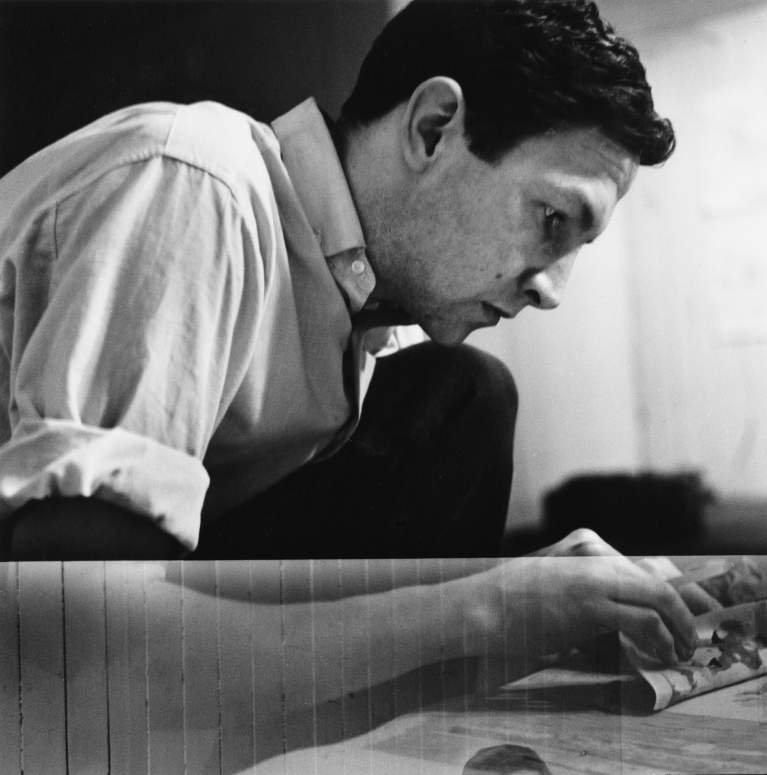 Rauschenberg working on a solvent transfer drawing in his Front Street studio, New York, 1958. Photo: Jasper Johns
Rauschenberg working on a solvent transfer drawing in his Front Street studio, New York, 1958. Photo: Jasper Johns
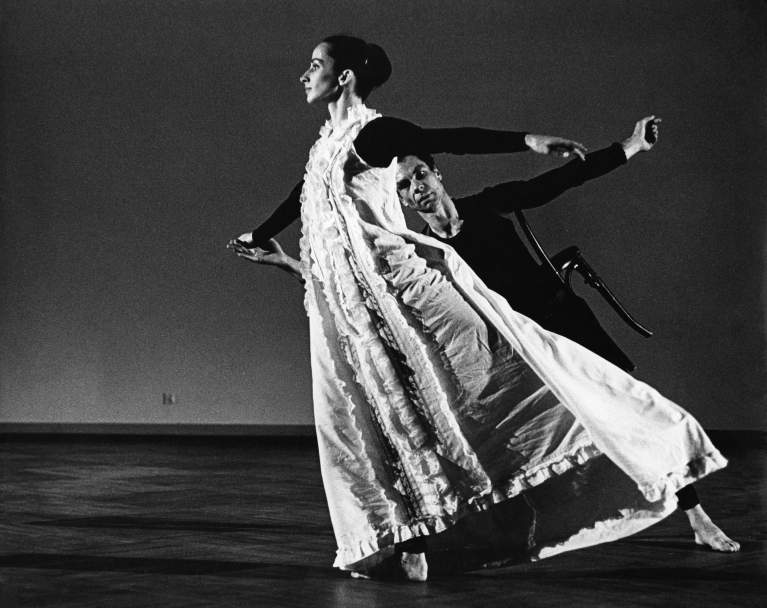 Costumes by Rauschenberg for Merce Cunningham Dance Company’s Antic Meet (1958), Five New York Evenings, Moderna Museet, Stockholm, September 1964. Pictured: Carolyn Brown and Merce Cunningham. Photo: Hans Malmberg
Costumes by Rauschenberg for Merce Cunningham Dance Company’s Antic Meet (1958), Five New York Evenings, Moderna Museet, Stockholm, September 1964. Pictured: Carolyn Brown and Merce Cunningham. Photo: Hans Malmberg
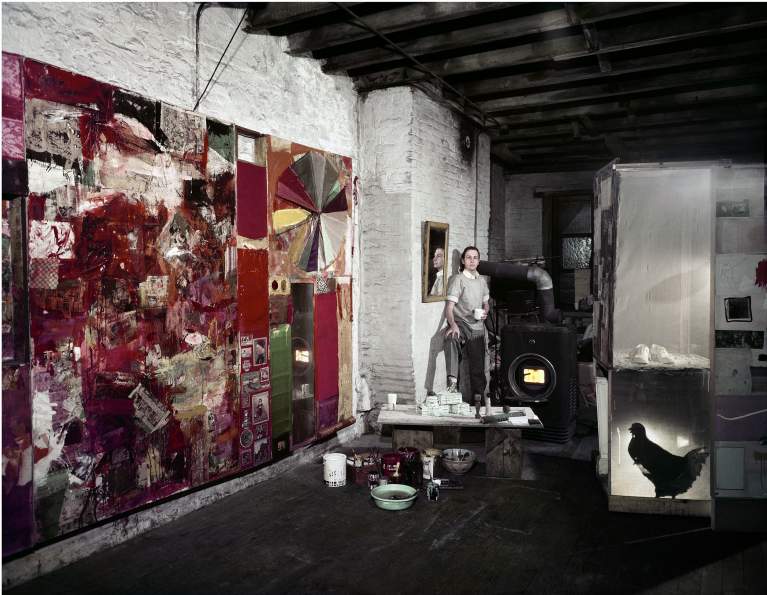 Rauschenberg in his Pearl Street studio, New York, March, 1958. Works shown are Charlene (1954), Untitled (ca. 1954), and partial rear view of the second state of Monogram (1955–59; second state 1956–58). Photo: Dan Budnik
Rauschenberg in his Pearl Street studio, New York, March, 1958. Works shown are Charlene (1954), Untitled (ca. 1954), and partial rear view of the second state of Monogram (1955–59; second state 1956–58). Photo: Dan Budnik
 Set and costumes by Rauschenberg for Paul Taylor Dance Company’s Images and Reflections, 1958. Pictured: Maggie Newman and Taylor
Set and costumes by Rauschenberg for Paul Taylor Dance Company’s Images and Reflections, 1958. Pictured: Maggie Newman and Taylor
1959
Makes Broadcast (1959), a painting in which three radios are concealed behind the canvas. Viewers are invited to manipulate dials that adjust the volume and change the stations. The work anticipates Rauschenberg’s technology works of the 1960s. Alan Solomon, director of the Andrew Dickson White Museum (subsequently the Herbert F. Johnson Museum), Cornell University, Ithaca, New York, purchases Migration (1959) for the institution’s collection; this is the first museum purchase of a Rauschenberg painting.
[Winter]: Completes Monogram (1955–59). For its final state, following Johns’s suggestion that the animal be set within a picture on the floor, Rauschenberg places the goat in the center of a collaged and painted square platform mounted on wheels. The title results from the union of the goat and tire, which reminds Rauschenberg of the interweaving letters of a monogram.
January 12–February 6: Participates in Art and the Found Object, Time-Life Reception Center, New York. Exhibits Odalisk (1955/1958), Gloria (1956), and Interior (1956). Rauschenberg purchases a ready-made by Marcel Duchamp, Bottle Rack (1914, fourth version 1960), from the exhibition for $3.26
[Around January 30]: Poet and critic Nicolas Calas brings Duchamp to visit Rauschenberg’s and Jasper Johns’s Front Street studios.
March 1–April 5: Participates in Contemporary American Painting and Sculpture, University of Illinois at Urbana. Exhibits Curfew (1958).
March 14: Single performance of Merce Cunningham Dance Company’s From the Poems of White Stone and Gambit for Dancers and Orchestra, Festival of Contemporary Arts, University of Illinois at Urbana-Champaign. Rauschenberg designed costumes for both and the set for the latter.
March 31–April 8: Participates in Three: Norman Bluhm, Jean Dubuffet, and Robert Rauschenberg, Leo Castelli, New York. Exhibits final state of Monogram (1955–59). Collector Robert Scull offers to buy the work as a donation to the Museum of Modern Art, New York, but director Alfred H. Barr Jr., declines the offer. In December 1964, the work will be purchased by Moderna Museet, Stockholm.
April 8: In an interview with critic and journalist Jerry Tallmer of the Village Voice, published in conjunction with the solo exhibition Marcel Duchamp at Sidney Janis Gallery, New York, Duchamp raises the question, “Do you know the works of Rauschenberg and Jaspers [sic]?” Rauschenberg clips out and saves the article.27
May: Leo Castelli introduces Rauschenberg and Johns to Yoshiaki Tono, whose writings bring their work to the attention of a Japanese audience.
May 30: Rauschenberg, a solo exhibition of solvent-transfer drawings opens, Galleria la Tartaruga, Rome.
June: Robert Rosenblum, then teaching at Princeton University, introduces Frank Stella to Rauschenberg and Johns.
July 11–October 11: Participates in Documenta II: Kunst nach 1945 (Art after 1945), Kassel, West Germany. Exhibits Bed (1955), Thaw (1958), and Kickback (1959).
August 14: Premiere of Merce Cunningham Dance Company’s Rune, Twelfth American Dance Festival, Connecticut College, New London, for which Rauschenberg provides a projection and designs the costumes (costumes will be redesigned by Mark Lancaster in 1982 and 1995).
[Late summer]: Makes Trophy I (for Merce Cunningham) (1959), the first work in a series of six “trophies” dedicated to his peers; the subsequent works are dedicated to Marcel and Teeny Duchamp (1960), Jean Tinguely (1961), John Cage (1961), Johns (1962), and Darryl Pottorf (1994). Only Trophy I contains a literal portrait—a photograph—of the subject.
September 21–December 2: Participates in 5th São Paulo Biennial, Museu de Arte Moderna, in the American section of the exhibition, organized by the Minneapolis Institute of Art. Exhibits Hazard (1957), Painting with Red Letter S (1957), and Trophy I (for Merce Cunningham).
October 2–25: Participates in First Paris Biennial, Musée d’Art Moderne de la Ville de Paris. Exhibits Talisman(1958), Forge (1959), and Photograph (1959).
October 4, 6–10: Allan Kaprow’s 18 Happenings in 6 Parts, Reuben Gallery, New York. During one evening’s performance, Rauschenberg and Jasper Johns substitute for Red Grooms and Lester Johnson. In the fifth part of the event, they leave their seats in the audience and paint, each with a single color, circles (which Rauschenberg makes by using the paint-can lid) and straight lines (Johns) on opposite sides of an unprimed canvas.
October 6–17: Participates in a group show inaugurating new space of Leo Castelli, New York. Exhibits Inlet (1959). Other artists shown include Norman Bluhm, Paul Brach, Nassos Daphnis, Gabriel Kohn, Ludwig Sander, Sal Scarpitta, Stella, Cy Twombly, and Johns, who exhibits Black Target (1959).
November 26–December 27: Participates in Out of the Ordinary: The Audience as Subject, Contemporary Arts Association of Houston. Exhibits Interview (1955) and Inlet (1959), Johns exhibits Flag (1958).
December 15, 1959–January 9, 1960: Participates in School of New York: Some Younger Artists, Stable Gallery, New York. Exhibits Monogram (1955–59), Lincoln (1958), and Trophy I (for Merce Cunningham) (1959). Eleven artists, including Rauschenberg and Johns, are represented. The exhibition coincides with publication of the book School of New York: Some Younger Artists, edited by B. H. Friedman and includes a text on Rauschenberg by David Myers.
December 15, 1959–January 5, 1960: Participates in Exposition internationale du surréalisme: 1959–1960, organized by André Breton and Marcel Duchamp, Galerie Daniel Cordier, Paris. Exhibits Bed (1955) and Odalisk (1955/1958). Johns exhibits Target with Plaster Casts (1955).
December 16, 1959–February 14, 1960: Participates in Sixteen Americans, organized by Dorothy C. Miller, Museum of Modern Art, New York. Exhibits seven Combines: Satellite (1955), Wager (1957–59), Curfew (1958), Double Feature, Kickback, Magician, and Summerstorm (all 1959). The exhibition, which includes some younger artists who have never had solo exhibitions in New York, presents works by Rauschenberg, Jay De Feo, Wally Hedrick, James Jarvaise, Johns, Ellsworth Kelly, Alfred Leslie, Landes Lewitin, Richard Lytle, Robert Mallary, Louise Nevelson, Julius Schmidt, Richard Stankiewicz, Frank Stella, Albert Urban, and Jack Youngerman. The exhibition catalogue includes Rauschenberg’s statement: “Painting relates to both art and life. Neither can be made. (I try to act in that gap between the two.)”28
[December 25]: Marcel and Teeny Duchamp visit Rauschenberg and Johns at their Front Street studios. They dine together in Chinatown.
- 26. Rauschenberg, typescript of interview, July 1991, with Miranda McClintic for her proposed book Recycling Reality: The Found Object in Twentieth-Century Art. Copy in Robert Rauschenberg Archives, Robert Rauschenberg Foundation. The readymade was acquired in 1959, but when Rauschenberg asked Duchamp to sign it in 1960, Duchamp inscribed it “1960.”
- 27. Paul B. Franklin, “Chronology,” in Dancing around the Bride: Cage, Cunningham, Johns, Rauschenberg, and Duchamp, exh. cat. (Philadelphia: Philadelphia Museum of Art, 2013), p. 323.
- 28. Rauschenberg, statement in Dorothy C. Miller, ed., Sixteen Americans, exh. cat. (New York: The Museum of Modern Art, 1959), p. 58.

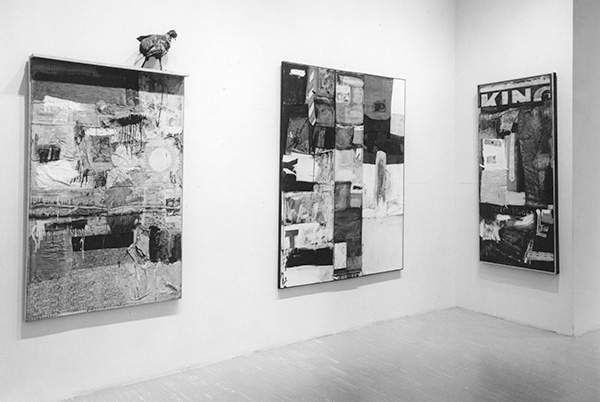 Sixteen Americans, the Museum of Modern Art, New York, 1959–60. Works shown are Rauschenberg’s Satellite (1955), Summerstorm (1959), and Kickback [formerly titled King] (1959). Photo: Rudy Burckhardt
Sixteen Americans, the Museum of Modern Art, New York, 1959–60. Works shown are Rauschenberg’s Satellite (1955), Summerstorm (1959), and Kickback [formerly titled King] (1959). Photo: Rudy Burckhardt
1960-69
1960
Continues to work on Combines, which tend to be more painterly with larger fields of bright color and fewer photographic images than earlier Combine works. Incorporates new collage materials, such as hardware, electrical devices, and mechanical objects. Rauschenberg explains to a reviewer that he is trying to avoid the “souvenir quality” of some of his earlier works: “Nostalgia tends to eliminate some of the directness. Immediacy is the only thing you can trust.”29
In Los Angeles, Edward Kienholz creates Odious to Rauschenberg, an electromechanical work with a rotating deer’s head and a hidden diathermy machine. It is originally intended as a practical joke to be given to Rauschenberg, but Kienholz keeps it.
February 16: Merce Cunningham Dance Company performance, Phoenix Theater, New York, organized by Rauschenberg, Emile de Antonio, and Jasper Johns. Works performed include the New York premiere of Summerspace (1958).
March 17: Jean Tinguely’s Homage to New York staged in the sculpture garden, Museum of Modern Art, New York. Tinguely’s large kinetic sculpture of bicycle wheels, old motors, a piano, and other objects found in junkyards is designed to self-destruct within thirty minutes. Tinguely is assisted by Billy Klüver, an engineer in the Communications Research Department at Bell Telephone Laboratories, Murray Hill, New Jersey. Rauschenberg contributes Money Thrower for Tinguely’s H.T.N.Y. (1960), conceived as the mascot, a sculpture that scatters a dozen silver dollars into the audience. It is likely that while working on Homage to New York, Rauschenberg and Klüver first meet.
March 29–April 16: Robert Rauschenberg, Leo Castelli, New York. Exhibits Broadcast, Canyon, Gift for Apollo, Inlet, and Winter Pool (all 1959), Allegory (1959-60), and Hawk (1960).
April 21: Participates in Art 1960, a symposium moderated by Robert Goldwater at New York University’s Eisner and Lubin Auditorium. Participating artists, selected from the Sixteen Americans exhibition of the previous year, include Rauschenberg, Johns, Alfred Leslie, Robert Mallary, Louise Nevelson, Richard Stankiewicz, and Frank Stella.
April 22–May 30: Exhibits solvent-transfer drawings along with works by Cy Twombly in Zwei amerikanische Maler, Galerie 22, Düsseldorf.
May 2: Rauschenberg, John Cage, and Merce Cunningham pose for photographer Richard Avedon. A triple portrait from the session will appear in the September 1960 issue of Harper’s Bazaar, accompanying the short piece “The Gift of Nonconforming” by Jean Dutourd, and is later featured in Avedon’s monograph, An Autobiography, published in 1993. Individual portraits of Rauschenberg were taken the same day, only one of which was later published, in 2005, on the cover of the exhibition catalogue Robert Rauschenberg: Combines.
May 18–June 18: Participates in Society for Contemporary Art 20th Annual Exhibition, Art Institute of Chicago. Exhibits the Combine Inlet (1959), for which he is awarded a prize of $3,000.
May 31–June 25: Participates in Summary 1959–1960, Leo Castelli, New York.
June 6–30: Participates in New Media—New Forms One: Junk Culture as Tradition, Martha Jackson Gallery, New York. Exhibits Odalisk (1955/1958).
August 18–21: 13th American Dance Festival, Connecticut, College New London. Includes the American premiere of Merce Cunningham Dance Company’s renamed Night Wandering (1958) (originally Nattvandrare) on August 18, and the world premiere of Cunningham Dance Company’s Crises on August 19, for which Rauschenberg designed the costumes in “red” tones, ranging from pink to deep red, with one yellow chosen for Viola Farber.30
Fall: Begins involvement with a group of young choreographers who attend a dance composition class taught by Robert Dunn at Merce Cunningham’s studio from 1960 to 1962. Dunn, a composer who studies with John Cage, encourages dancers to separate composition from choreography and to arrange material using methods of chance. The group will come to be known, in 1963, as Judson Dance Theater. Striving to break with conventions of modern dance, they explore unfixed choreography and nondance movements, and they adopt Rauschenberg’s practice of using whatever is available for props and performers. Rauschenberg later states that “a good Judson piece was really boring, usually too long with never enough happening.”31
Fall: Retreats to Treasure Island, a small fishing village near St. Petersburg, Florida, to complete illustrations for Dante’s Inferno (1958–60). Ileana Castelli and Johns visit on separate occasions.
September 24: Premieres of Merce Cunningham Dance Company’s Hands Birds and Waka, Festivale Internazionale di Musica Contemporanea, 23rd Biennale Internazionale d’Arte, Teatro La Fenice, Venice, for which Rauschenberg designs the costumes. For Waka, he reuses costumes that he had created for From the Poems of White Stone (1959).
November: Creates solvent-transfer drawing Election (1960) during the televised broadcast of the results of the presidential election, in which John F. Kennedy becomes the thirty-fifth president of the United States.
November 28, 1960–January 14, 1961: Participates in International Surrealist Exhibition, D’Arcy Galleries, New York. Exhibits Bed (1955). Johns exhibits Target with Plaster Casts (1955).
December 6, 1960–January 7, 1961: First exhibition of Rauschenberg’s series of transfer drawings illustrating Dante’s Inferno, Leo Castelli, New York.
- 29. Quoted in “The Emperor’s Combine,” Time (New York) 75, no. 16 (April 18, 1960), p. 92.
- 30. Merce Cunningham and Dance Company, brochure (New York: Foundation for Contemporary Performance Arts, 1963), unpaginated.
- 31. Quoted in David Sears, “A Trisha Brown–Robert Rauschenberg Collage,” Ballet Review (New York) 10, no. 3 (Autumn 1982), p. 48.

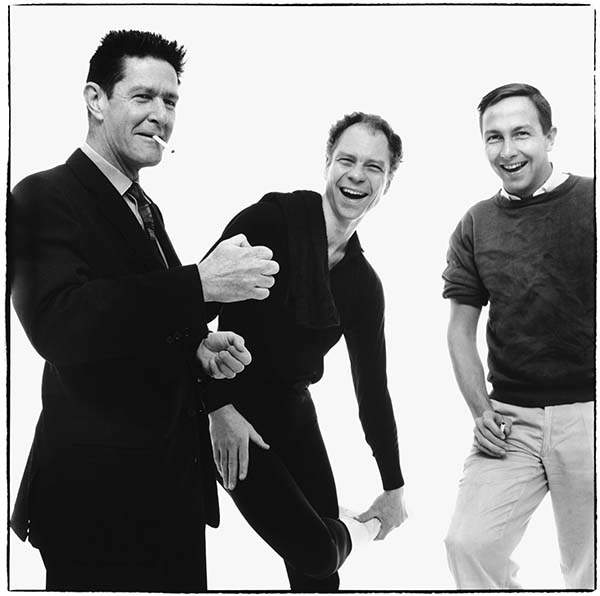 John Cage, musician; Merce Cunningham, choreographer; and Robert Rauschenberg, artist, New York City, May 2, 1960. Photo: Richard Avedon. © The Richard Avedon Foundation
John Cage, musician; Merce Cunningham, choreographer; and Robert Rauschenberg, artist, New York City, May 2, 1960. Photo: Richard Avedon. © The Richard Avedon Foundation
1961
Makes Combine paintings, such as Pantomime (1961) and Reservoir (1961), which incorporate working electric fans, clocks, and other elements to create a sense of motion and real time. The works that “perform” have a theatrical dimension.
February 10–March 12: Participates in Six Decades of American Painting of the Twentieth Century, Des Moines Art Center, Iowa. Exhibits one of the Red Paintings (1953–54), Untitled (1954).
March 10–April 17: At Billy Klüver’s invitation, creates the Combine, Black Market (1961) for the exhibition Bewogen beweging. Stedelijk Museum, Amsterdam. The exhibition and its tour is commonly referred to as Art in Motion. Black Market consists of a painting, a rope, and a valise, and it invites the viewer to exchange small objects with it, taking items from the valise and replacing them with messages or drawings. The drawings thus record the work’s development over time. When objects and drawings are taken from the work and are not replaced, Rauschenberg withdraws the invitation for viewer participation. The exhibition travels to Moderna Museet, Stockholm (as Rörelse i konsten) and the Louisiana Museum of Modern Art, Humlebaek, Denmark (as Bevaegelese i kunsten).
April 15: Sends Election (1960) to President and Mrs. Kennedy. The work will be auctioned from the Jacqueline Kennedy Onassis estate in 1996, selling for $220,000. In a letter accompanying the gift, Rauschenberg writes:
Dear Mr. President:
This drawing should belong to you or me. If you enjoy it I would be deeply honored if you accept it. My concern with the election, primarily your becoming our next president, interrupted a 2 1⁄2 year project of illustrating Dante’s Inferno. That fact + a need to celebrate your victory in my own medium is the subject. It is the only drawing in which the Dante image is used outside of the illustrations. (Small figure, lower right hand corner next to large D). The Greek head and Washington reiterates that the content of the drawing is art and politics. Red, white + blue is your color. The headlined, televised, radioed purple is Jacqueline’s. The rest is, I think, self-explanatory, including the formal fading waves of “Dick + Pat” in the upper right.
Very truly yours,
Robert Rauschenberg1
May: Solo exhibition, Galerie Daniel Cordier, Paris. Exhibits a selection of drawings and twelve Combine paintings: Hymnal (1955), Rebus (1955), Gloria (1956), K24976S (1956), Forge (1959), Allegory (1960), Diplomat (1960), Hawk (1960), Pilgrim (1960), Summer Rental + 3 (1960), Untitled (1960–61), and Trophy II (for Teeny and Marcel Duchamp) (1960). Only one drawing and one painting are sold, although the show is popular with critics and artists.
May: Interview conducted by André Parinaud, “Un ‘Misfit’ de la peinture new-yorkaise se confesse,” published in Arts, a Parisian weekly newspaper. The interview establishes Rauschenberg’s reputation in Europe, where he becomes popular with European critics.
May: The short-lived but widely circulated Italian journal, Metro, publishes three significant articles on Rauschenberg by art critic Dore Ashton, John Cage, and artist Gillo Dorfles.
Mid-May: During the installation of Rörelse i konsten [Art in Motion], Moderna Museet, Stockholm, May 16–September 10, Rauschenberg creates Johanson’s Painting and Door (both 1961), Combine paintings made of materials gathered from nearby demolished building sites. The title Johanson’s Painting results from a woman’s comment to Rauschenberg at the exhibition’s opening reception on May 17; unaware he is the artist, she tells him that “Ingemar Johansson could have made that painting” (a reference to the Swedish boxer), which immediately compels Rauschenberg to write on the canvas, “This is Johanson’s [sic].” The startled woman forcibly stops him from writing more, but he later returns to add the word “painting.”
May 15: Opening of Les 41 présentent Iris Clert [41 Portraits of Iris Clert], Galerie Iris Clert, Paris, a group exhibition of portraits of the art dealer made by forty-one artists in her honor. Rauschenberg, who is in Stockholm, forgets to submit the requisite portrait and sends instead a telegram: “This is a portrait of Iris Clert if I say so—Robert Rauschenberg.”2 (1961)
May 17: Opening evening for the exhibition Rörelse i konsten [Art in Motion], Moderna Museet, Stockholm, begins with a formal dinner. Directly following, Jean Tinguely and Per Olof Ultvedt shoot off “anti-fireworks” into the water from a rowboat on the Strömmen next to Skeppsholmen. After the vernissage, guests took a ferry to the Arena Theater on Djurgårdsvägen where Rauschenberg, Niki de Saint Phalle, Tinguely, and Ultvedt organize a performance wearing coattails, followed by a performance by Thelonious Monk. At the end of the evening, de Saint Phalle and Ultvedt plan to unveil “the world’s largest instant work of art,” however, it is not done, leaving Billy Klüver and Rauschenberg to carry the painting home. During their failed attempt to flag a car home, Rauschenberg drops the painting in the middle of Djurgårdsvägen to let cars run over it, leaving tire tracks.3
May 23: Participates in a de Saint Phalle “tir,” Staket sandpit, near Värmdö, Sweden. During a “tir,” participants create explosions of color by shooting rifles at a prepared (and often white) canvas or assemblage, to which small sacks of colored paint have been attached and then covered with plaster, creating the works Grand Tir—séance Stockholm and Tir (séance Stockholm). Other participants include Pontus and Klara Hulten, Klüver, Ulf Linde, Tinguely, Anna Lena Wibom, Katrin Wibom. Shunk-Kender produces photo documentation of the event, while Klüver creates a Super 8 film.4
June 1961–May 1962: Participates in Vanguard American Painting, organized by the U.S. Information Agency, and curated by H. H. Arnason, Solomon R. Guggenheim Museum, New York, and Jerome A. Donson. The exhibition travels to Vienna, Salzburg, Belgrade, Skopje, Zagreb, Maribor, Ljubljana, Rijeka, London, and Darmstadt. Exhibits Double Feature (1959), Trophy I (for Merce Cunningham) (1959), and Summer Rental + 1 (1960).
June 20: Participates in Homage to David Tudor, organized by Darthea Speyer, Théâtre de l’Ambassade des États-Unis, Paris. During simultaneous events staged by Rauschenberg, de Saint Phalle, Jasper Johns, Tinguely, and Tudor, each artist performs spontaneous acts of their own choosing within a set amount of time. Rauschenberg creates First Time Painting (1961) on stage, amplifying the sound of its construction with contact microphones attached to the canvas; the back of the canvas faces the audience throughout the performance. When an alarm clock attached to the painting rings, Rauschenberg wraps the work in brown paper and gives it to a bellhop from the Hôtel du Pont Royale (where Rauschenberg is staying), who carries it offstage. The audience never actually sees the work. De Saint Phalle creates Homage to Bob Rauschenberg (Shot by Rauschenberg), Rauschenberg is reported to have shot the paint rifle for several minutes while shouting “Red! Red! I want more red!”5
June 28: Attends opening of de Saint Phalle’s exhibition Feu à volonté [Fire at Will], organized by Pierre Restany, Galerie J, Paris, at which visitors are invited to participate in a “tir.”
[July]: Moves from Front Street into a studio at 809 Broadway, New York, a commercial building where residential occupation is illegal. Painter Öyvind Fahlström moves into Rauschenberg’s former Front Street studio.
[Late July]–September 15: Participates in Le Nouveau Réalisme à Paris et à New York, organized by Pierre Restany, Galerie Rive Droite, Paris. Also exhibited are works by Arman, Lee Bontecou, César, John Chamberlain, Chryssa, Raymond Hains, Johns, Yves Klein, de Saint Phalle, Richard Stankiewicz, and Tinguely.
August 5: Premiere of Merce Cunningham Dance Company’s Aeon, La Comédie Canadienne, Montreal Festival. Rauschenberg designs the set, costumes, and lighting, creating elaborate effects with exploding flares, a smoking machine, and, with Klüver’s assistance, stroboscopic lights that are attached to dancers’ wrists. Rauschenberg becomes the official lighting director and stage manager; he tours with Merce Cunningham Dance Company through 1964. Rauschenberg later writes, “Local touring with dance co. was awkward, but beautiful addition to my work. The dances, the dancers, the collaboration, the responsibilities and trust which are essential in cooperative art because the most important & satisfying element in my life worked positively with the privateness and loneliness of painting.”6
September 22–October 14: Participates in group exhibition, Leo Castelli, New York. Exhibits First Landing Jump (1961).
October 4–November 12: Participates in The Art of Assemblage, organized by William Seitz, Museum of Modern Art, New York. Exhibits Talisman (1958) and Canyon (1959). The exhibition includes works from the fifteenth century to the present with examples from non-Western cultures, marking the first museum recognition of assemblage as an art form and will travel to the Dallas Museum for Contemporary Arts and San Francisco Museum of Art.
October 13–December 31: Participates in American Abstract Expressionists and Imagists, Solomon R. Guggenheim Museum, New York. Exhibits Blue Exit (1961).
October 19: Participates in a symposium at the Museum of Modern Art, New York, in conjunction with The Art of Assemblage. Panelists include Lawrence Alloway, Marcel Duchamp, Richard Huelsenbeck, Seitz (moderator), and Roger Shattuck. Rauschenberg, selected to represent the younger generation of artists, assumes the role of provocateur in the discussion. During the symposium, Rauschenberg notices Duchamp taking many notes. When Rauschenberg asks Duchamp what he found so interesting, Duchamp reveals a page of doodles, which he signs and gives to Rauschenberg.
October 20: Issue of Art International with cover design by Rauschenberg. The magazine includes Françoise Choay’s “Dada, Néo-Dada, et Robert Rauschenberg,” an article on Rauschenberg’s Combines.
October 24–December: Rauschenberg, Galleria dell’Ariete, Milan. Exhibits Hymnal (1955), Rebus (1955), Gloria (1956), K24976S (1956), Forge (1959), Allegory (1960), Diplomat (1960), Hawk (1960), Pilgrim (1960), Summer Rental + 3 (1960), Untitled (1960), and Trophy II (for Teeny and Marcel Duchamp) (1960).
October 27, 1961–January 7, 1962: Participates in Pittsburgh International Exhibition of Contemporary Painting and Sculpture, Carnegie Institute. Exhibits Second Time Painting (1961).
November 7–December 5: Opens Rauschenberg, Leo Castelli, New York. For the installation, Rauschenberg gradually replaces works in the previous exhibition with his own paintings and sculptures. The show ends as he replaces his works with works by other artists. Rauschenberg’s works, which are assembled from tires, signs, and other materials found on city streets, include the Combines: Aen Floga, Coexistence, Empire I, Empire II, First Landing Jump, Magician II, Pantomime, Reservoir, and Trophy IV (for John Cage) (all 1961). Rauschenberg’s design for the exhibition announcement, which was also a foldout poster, consists of his photograph of printed fragments that contain the title, location, and date of the exhibition strewn among junk piled on his studio floor.
December 13, 1961–February 4, 1962: Participates in Contemporary American Painting, Whitney Museum of American Art, New York. Exhibits Third Time Painting (1961).
- 1. Robert Rauschenberg Archives, Robert Rauschenberg Foundation.
- 2. Tomkins, Off the Wall, p. 192.
- 3. Billy Klüver and Robert Rauschenberg. “Art in Motion—A Combined Memory.” Konsthistorisk tidskrift/Journal of Art History (Stockholm) 27, nos. 1–2 (2007), pp. 114–18.
- 4. Participants cited in Niki de Saint Phalle: Catalogue Raisonné, 1949–2000 (Lausanne: Acatos and Benteli, Bern, 2001), p. 107. Super 8 film, 13 minutes, 22 seconds, Klüver-Martin Archive, New Jersey.
- 5. Full citation to come.
- 6. “Autobiography,” in Andrew Forge, Rauschenberg (New York: Harry N. Abrams, 1969), p. 226. The text originally appears in the lithograph Autobiography (1968).

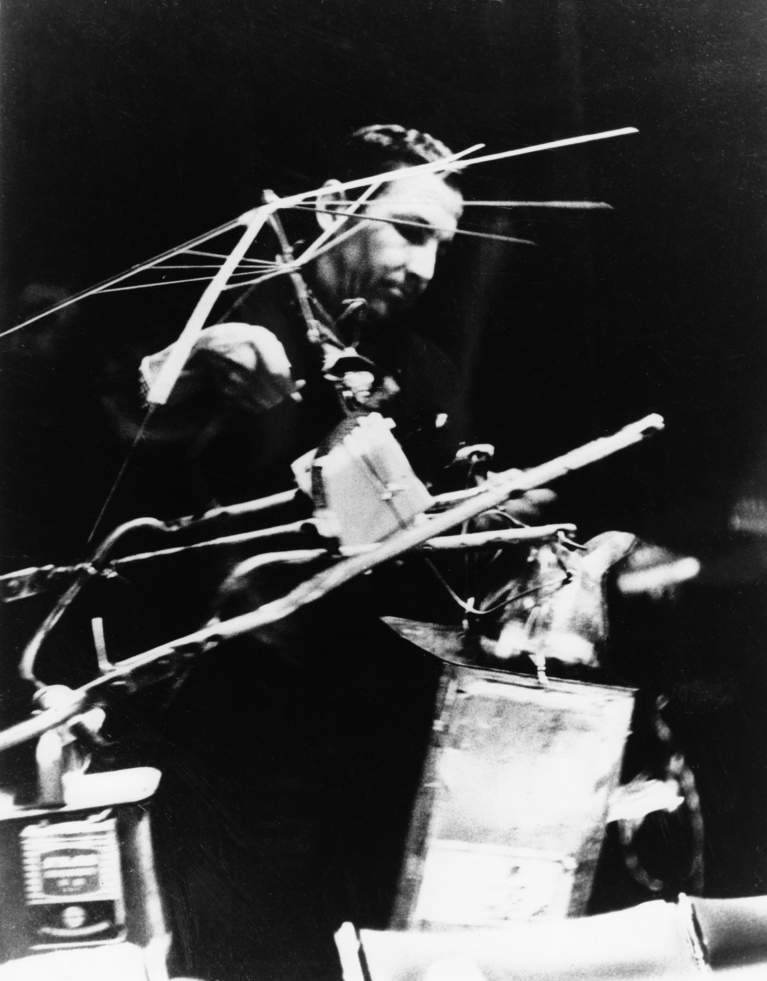 Rauschenberg assembling the Aeon “machine,” part of Rauschenberg’s set for Merce Cunningham Dance Company’s Aeon (1961), Japan, 1964
Rauschenberg assembling the Aeon “machine,” part of Rauschenberg’s set for Merce Cunningham Dance Company’s Aeon (1961), Japan, 1964


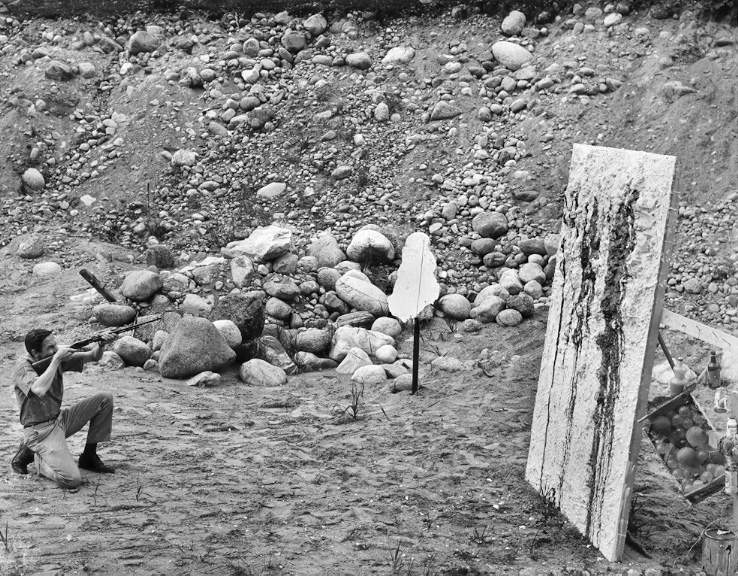 Rauschenberg shooting at Grand Tir - séance Stockholm, anlässlich einer Tir-Session de Saint Phalles in a stone quarry near Stockholm, 1961. Photo: Shunk-Kender © J. Paul Getty Trust
Rauschenberg shooting at Grand Tir - séance Stockholm, anlässlich einer Tir-Session de Saint Phalles in a stone quarry near Stockholm, 1961. Photo: Shunk-Kender © J. Paul Getty Trust

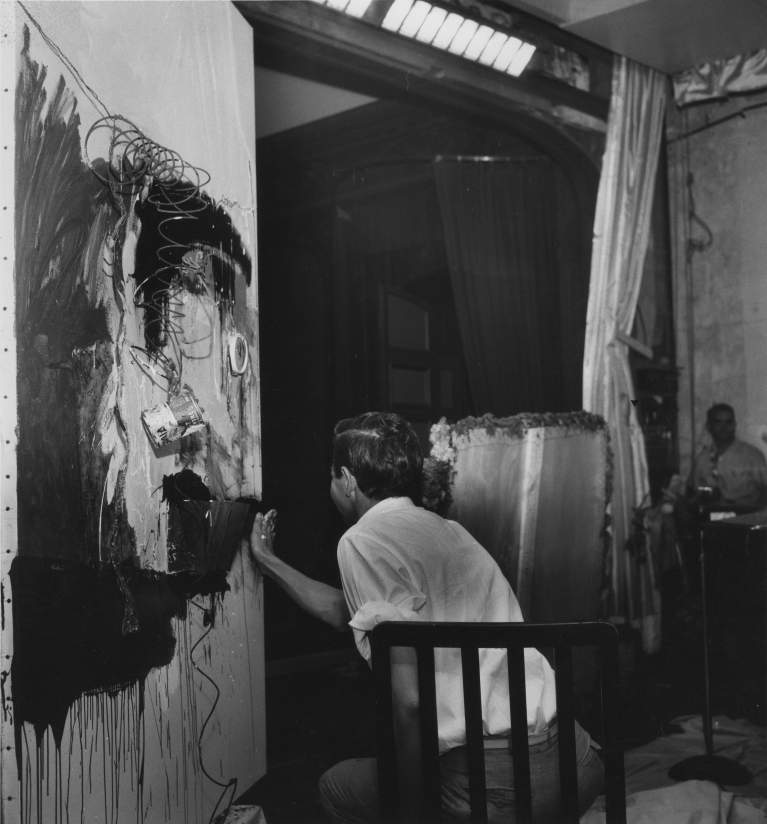 Rauschenberg creating First Time Painting (1961) during Homage to David Tudor, Théâtre de l’Ambassade des États-Unis, Paris, June 20, 1961. Photo: Shunk-Kender © J. Paul Getty Trust
Rauschenberg creating First Time Painting (1961) during Homage to David Tudor, Théâtre de l’Ambassade des États-Unis, Paris, June 20, 1961. Photo: Shunk-Kender © J. Paul Getty Trust
1962
Creates the series On Tour, a group of works on paper including solvent transfer, gouache, and pencil.
March 4, 7: Helps Niki de Saint Phalle and Jean Tinguely create “tir” performances in front of Virginia Dwan’s home in Malibu, California, and in the parking lot of the Renaissance Club, Sunset Boulevard, Los Angeles.
March 4–31: Robert Rauschenberg, Dwan Gallery, Los Angeles. The exhibition provides many from the West Coast their first opportunity to see Rauschenberg’s work in person.
March 6: Attends opening of Edward Kienholz’s exhibition of Roxys (1960–61), a walk-through tableau, Ferus Gallery, Los Angeles.
March 17–May 6: Participates in 4 Amerikanare: Jasper Johns, Alfred Leslie, Robert Rauschenberg, Richard Stankiewicz, organized by Pontus Hultén, Moderna Museet, Stockholm. Exhibits Bed (1955), Odalisk (1955/1958), and Gift for Apollo (1959). The exhibition will travel to Stedelijk Museum, Amsterdam, and Kunsthalle Bern.
Early spring: After two years of invitations from Tatyana Grosman, founder of Universal Limited Art Editions (ULAE), West Islip, New York, and with the encouragement of Jasper Johns, who began working at ULAE in 1960, Rauschenberg accepts offer to create prints at the press. Makes first lithograph, Abby’s Bird (1962), published in an edition of fifty for New York Hilton Hotel. Lighter fluid is used on the print to transfer magazine images to the lithography stone, and the work is subsequently named after a friend, Abby Friedman, wife of writer and critic B. H. Friedman. Later this year, Rauschenberg creates Stunt Man (1962), three editions of color lithographs also published by ULAE.
April 7–21: Exhibits Ace (1962), a five-panel Combine, Leo Castelli, New York.
April 11: Premiere of Paul Taylor Dance Company’s Tracer, Théâtre des Nations, an international theater-arts festival, Paris. Rauschenberg designed the costumes (marked with tire treads) and set, a stationary bicycle wheel that an onstage motor spins at different speeds.
May 4: Performs in The Construction of Boston, Maidman Playhouse, New York, and designs the set, which resembles a furnished apartment. The fifteen-minute play is a collaboration among Rauschenberg, de Saint Phalle, poet Kenneth Koch, who wrote the text, and Tinguely. Merce Cunningham directed, but declined credit at the last moment. The actors include the collaborators (excluding Koch), who chose doubles to speak their lines: Elmarie Dooley doubles for de Saint Phalle, Henry Geldzahler for Tinguely, and Frank Stella for Rauschenberg. Highlights include de Saint Phalle performing a “tir” by shooting a rifle at a plaster statue of Venus de Milo, which then “bleeds,” and Tinguely, in a white gown, building a cinder-block wall between audience and performers. Rauschenberg operates Tinguely’s weather machine, which scatters plastic balls into the audience and soaks the actors with “rain,” and plants a rosebush.
May 6–27: Participates in the 18th Salon de mai, Musée d’Art Moderne de la Ville de Paris. Exhibits Cartoon (1962).
Spring: Work commences with engineers Billy Klüver and Harold Hodges on an interactive sculpture, Oracle (1962–65), which incorporates radios to be operated by viewers, a plan originally intended for Ace (1962).
Late spring: Makes lithographs Urban and Suburban (both 1962) by covering lead type and photoengraved newspaper plates—salvaged from the New York Times composing room—with lithographic tusche and transferring imagery onto the stone.
Summer: Creates the Combine Inside-Out (1962), featured in Gene Swenson’s “Rauschenberg Paints a Picture,” Artnews, an article on the making of the work.
July 6: First Concert of Dance presented by Judson Dance Theater at Judson Memorial Church, New York. The three-hour program includes dances by William Davis, Ruth Emerson, David Gordon, Deborah Hay, Fred Herko, John Herbert McDowell, Gretchen MacLane, Steve Paxton, Yvonne Rainer, Carol Scothorn, and Elaine Summers, as well as a collaboration by Alex Hay, Deborah Hay, and Charles Rotmil, and music by John Cage. The group will perform at the Judson Church and other nonproscenium spaces—including lofts, television studios, pools, and skating rinks—until 1968.
August: Travels to Amsterdam to collect materials for his artwork Dylaby (1962) to be presented in the upcoming exhibition Dylaby (Dynamisch Labyrint), Stedelijk Museum, Amsterdam.
August 30–September 30: Dylaby (Dynamisch Labyrint), Stedelijk Museum, Amsterdam. The exhibition consists of installations by Rauschenberg, Martial Raysse, de Saint Phalle, Daniel Spoerri, Tinguely, and Per Olof Ultvedt. Rauschenberg designs the cover of the exhibition catalogue. Stedelijk Museum director Willem Sandberg and curator Ad Peterson invite the artists to collaborate on a single sculptural work—an environment or labyrinth to be walked through; the artists find it too difficult, however, to reconcile their diverse views and, to Rauschenberg’s disappointment, decide to create separate pieces. His installation is a mechanized cityscape. The viewer walks on a floor painted to look like a street between large rectangular areas that are enclosed by wire fences and contain assemblages of found objects, including an airplane wing, seashells, and a cluster of clocks operating at different speeds and times. While the clocks hum, an electric device pumps air into a large tub of water to produce bubbling sounds. The experience, especially the effort required to work with such bulky objects, steers Rauschenberg away from sculpture and back toward painting, “I was really sick of sculpture. Nothing appealed to me more when I got back than the gentility of a beautifully stretched piece of canvas.”1 Nevertheless, he will later produce such technology-based sculptural works as Soundings (1968) and Mud Muse (1968–71).
September 18: At the invitation of art critic and curator Henry Geldzahler, visits—along with David Bourdon, artist Carl Fredrik Reuterswärd, and Ileana and Michael Sonnabend—Andy Warhol’s studio in New York. During his visit, views Warhol’s recent silkscreen paintings. In the previous month, Warhol had begun to silkscreen canvas using photographic images rather than stencils.
After September 18: Warhol creates series of silkscreen portraits of Rauschenberg, including Let Us Now Praise Famous Men (1963), for which he requests family photographs from Rauschenberg. Using a process of overlay and repetition, the resulting canvas serves as an homage to Rauschenberg. In the top three rows, Rauschenberg family photographs are rendered in sepia tones, channeling a nostalgic past; the fourth register, transitions to black and white and includes images of Rauschenberg’s former wife, Susan Weil, and his sister, Janet; while the remaining two rows of the canvas repeat an image of Rauschenberg from a contemporary photograph by Steve Paxton. Taking its title from James Agee’s and Walker Evans’s photo essay from 1941, Warhol pays tribute to Rauschenberg and the transformation from his childhood in the South during the Great Depression to his adult life as an artist living in New York.2
September 22–October 13: Participates in group exhibition, Leo Castelli, New York. Exhibits Rigger (1961).
October: After previous failed attempts to photosensitize canvas, begins to silkscreen paintings, finding the use of photographic imagery in the Combines and solvent-transfer drawings restrictive because of the inability to alter their size or reuse the images. Similar to the materials used for the illustrations for Dante’s Inferno (1958–60), sources for images include National Geographic, Life, Esquire, Boxing and Wrestling, and newspapers, as well as his own photographs. Photographic images are sent to a commercial screenmaker, Aetna Silk Screen Products, New York, with instructions that indicate the dimensions desired and the number of screens, one for each color, needed. Approximately fifty screens, reused for numerous artworks, will be made between October 1962 and June 1963. A black-and-white color scheme, Rauschenberg’s preference in his own photography, will be dominant until 1963, when he will begin to use more color. The silkscreened images are complemented by gestural applications of oil paint, and in some works, Rauschenberg experiments with additional collage elements, for example, a deflated inner tube in Tadpole (1963).
October 6–November 11: Participates in 3rd International Biennial Exhibition of Prints, National Museum of Modern Art, Tokyo. Exhibits nine lithographs made at Universal Limited Art Editions (ULAE), West Islip, New York, including Abby’s Bird (1962) and Merger (1962). Awarded Ohara Art Museum Prize.
November 18–December 15: Participates in My Country ’Tis of Thee, Dwan Gallery, Los Angeles. Exhibits Coexistence (1961).
[Late fall]: Begins—and substantially completes in twenty-four hours, during the filming of a CBS television documentary by Mike Wallace—Barge (1962–63), a 32-foot-long silkscreen painting and his largest work to date.3 Finishing touches were added later, at the end of 1962 into the beginning of 1963. Geldzahler, who will encounter the work at the Jewish Museum in 1963, describes its effect as “very much like sitting in the first row of a black and white, large-screen movie. The images flash by and we make connections; we end up without a story, but with something much richer—the associative and imaginative leaps that Rauschenberg’s works open up for us.”4
December 12, 1962–February 3, 1963: Participates in Annual Exhibition of Sculpture and Drawing, Whitney Museum of American Art, New York. Exhibits Letterhead (now Headline, 1962), a solvent-transfer drawing.
- 1. Dorothy Gees Seckler, oral history interview with Rauschenberg, Dec. 21, 1965, Archives of American Art, Smithsonian Institution, Washington, D.C. Accessed Sept. 15, 2014. http://www.aaa.si.edu/collections/interviews/oral-history-interview-robert-rauschenberg-12870.
- 2. Thomas Crow, “Social Register,” Artforum (New York) 47, no. 1 (Sept. 2008), pp. 426–29.
- 3. Susan Davidson, “Robert Rauschenberg,” in Guggenheim Museum Bilbao Collection (Bilbao: Guggenheim Museum Bilbao, 2009), p. 93, nn. 23–24.
- 4. Henry Geldzahler, “Robert Rauschenberg,” Art International (Lugano) 7, no. 7 (Sept. 25, 1963), p. 66.

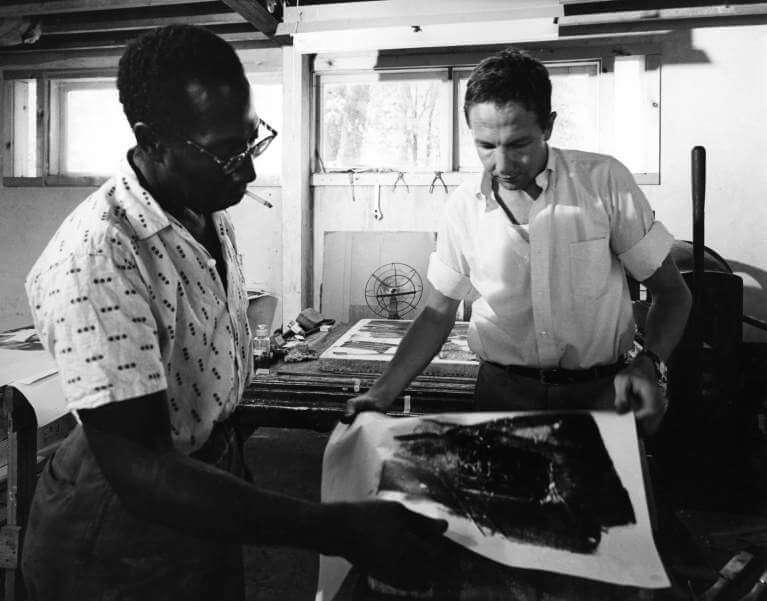 Rauschenberg working with master printer Robert Blackburn at ULAE (Universal Limited Art Editions), West Islip, New York, 1962. Photo: Hans Namuth
Rauschenberg working with master printer Robert Blackburn at ULAE (Universal Limited Art Editions), West Islip, New York, 1962. Photo: Hans Namuth

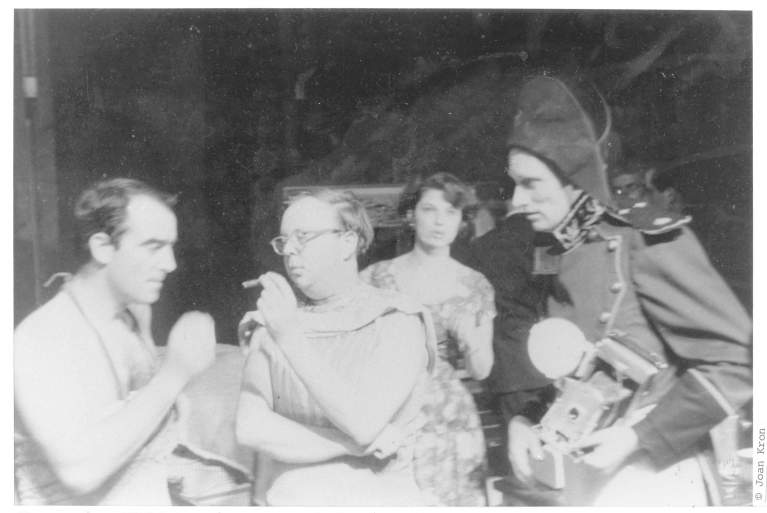 The Construction of Boston, Maidman Playhouse, New York, May 4, 1962. Pictured: Jean Tinguely, Henry Geldzahler, Marion Javits, and Billy Klüver. Photo: © Joan Kron
The Construction of Boston, Maidman Playhouse, New York, May 4, 1962. Pictured: Jean Tinguely, Henry Geldzahler, Marion Javits, and Billy Klüver. Photo: © Joan Kron

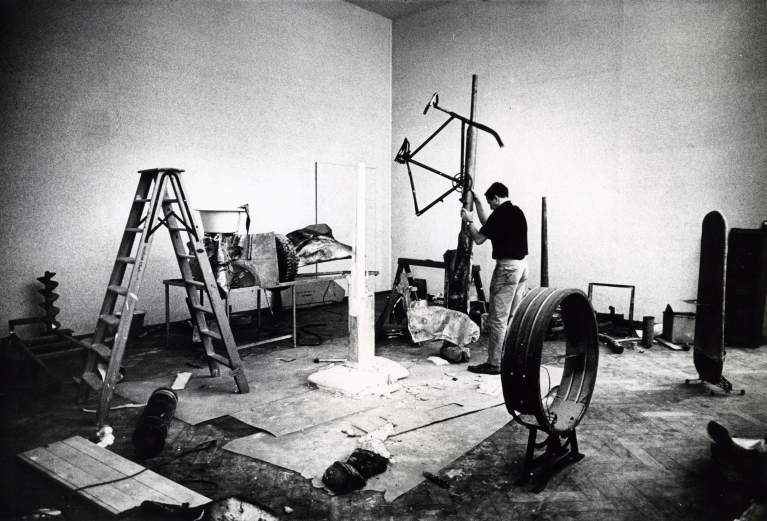 Rauschenberg working on his mechanized cityscape environment for Dylaby (Dynamisch Labyrint), Stedelijk Museum, Amsterdam, September 1962. Photo: © Ed van der Elsken/Nederlands Fotomuseum
Rauschenberg working on his mechanized cityscape environment for Dylaby (Dynamisch Labyrint), Stedelijk Museum, Amsterdam, September 1962. Photo: © Ed van der Elsken/Nederlands Fotomuseum

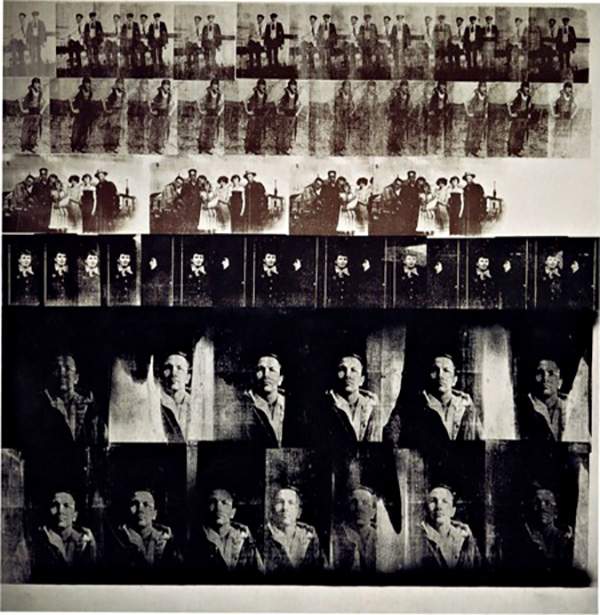 Andy Warhol, Let Us Now Praise Famous Men, 1963, silkscreen ink on canvas, 82 x 82 inches, collection Michael D. Abrams. © 2014 The Andy Warhol Foundation for the Visual Arts, Inc./Artists Rights Society (ARS), New York
Andy Warhol, Let Us Now Praise Famous Men, 1963, silkscreen ink on canvas, 82 x 82 inches, collection Michael D. Abrams. © 2014 The Andy Warhol Foundation for the Visual Arts, Inc./Artists Rights Society (ARS), New York
1963
The Museum of Modern Art, New York, acquires the illustrations for Dante’s Inferno (1958–60) through an anonymous gift from a donor who had purchased them for $30,000 from Leo Castelli, New York. Under the auspices of the International Council of the Museum of Modern Art, the drawings will be exhibited in museums throughout Europe over the next two years and throughout the United States from 1966 to 1968.
In collaboration with engineer Harold Hodges, makes Dry Cell (1963), an interactive sculpture where motion is voice activated. Viewers are encouraged to speak into a small microphone that is wired to a motor that in turn causes a small, irregularly shaped piece of metal to spin. The face of the work is Plexiglas onto which is screened an image of the army helicopter that also appears in many of the silkscreen paintings, including Kite (1963).
January: Foundation for Contemporary Performance Arts, New York, founded to support performances by avant-garde artists and composers. Directors include John Cage, Jasper Johns, Elaine de Kooning, and other artists.
February 1–16 and February 20–March 9: Consecutive solo exhibitions Rauschenberg: Première Exposition (Oeuvres 1954–1961) and Rauschenberg: Seconde Exposition (Oeuvres 1962–1963), Galerie Ileana Sonnabend, Paris. Première Exposition includes Combines Charlene (1954), Hymnal (1955), Monogram (1955–59), Gloria (1956), Memorandum of Bids (1956), Rhyme (1956), Untitled (1956), Gift for Ileana (1956–59), Blue Collage (now Collage with Blue, 1957), Collage with Cuff (1957), Bypass (1959), and Dylaby (1962). Seconde Exposition includes silkscreen paintings: Almanac (1962), Brace (1962), Calendar (1962), Crocus (1962), Echo (1962), Exile (1962), Glider (1962), Payload (1962), Shortstop (1962), Vault (1962), and four untitled paintings (all 1963). Man Ray attends opening. Critic Pierre Schneider describes the work as “combining ‘raw’ objects (radio sets, stuffed goats, keys, neckties, etc.) with paint as sweetly tasty as the Good Humor man’s goodies. There they are, the erstwhile ruffians of mass production with pretty pigments round their necks, like repentant delinquents meekly wearing the choir boy’s surplice.”1
February 3–28: Exhibits silkscreen paintings—Cove, Tadpole, Express, Junction, and Dry Run (all 1963)—at Beaumont-May Gallery, Hopkins Center, Dartmouth College, Hanover, New Hampshire, where he is a visiting artist for the spring semester.
February 25–March 2: Participates in Exhibition for the Benefit of the Foundation for Contemporary Performance Arts, Allan Stone Gallery, New York. Contributes Overcast II (1962), a black-and-white silkscreen painting.
March 14–June 2: Participates in Six Painters and the Object, curated by Lawrence Alloway, Solomon R. Guggenheim Museum, New York. Exhibits Untitled (now Collection, 1954), Factum II (1957), Migration (1959), Overcast I (1962), Overcast II (1962), and Junction (1963). His inclusion in the exhibition, along with artists Jim Dine, Johns, Roy Lichtenstein, James Rosenquist, and Andy Warhol, led critics to identify Rauschenberg with Pop art, an affiliation that he rejected.
March 31–May 12: First retrospective museum exhibition, Robert Rauschenberg, organized by Alan Solomon, director of the Jewish Museum, New York. The show consists of fifty-five works spanning his entire career to date. Rauschenberg creates the exhibition poster, an offset lithograph which is an adaptation of the lithograph Rival (1963). The exhibition marks the first occasion for a museum to present the work of a post–World War II artist from New York and initiates the Jewish Museum’s contemporary art program, which will thrive throughout the rest of the decade. Victor and Sally Ganz, prominent collectors, purchase Winter Pool (1959) from Leo Castelli, New York, the day after the opening.
Spring: Creates “Random Order,” published in Location, a short-lived New York–based magazine. The work consists of a full-page reproduction of silkscreen painting Sundog (1962), a two-page collage of Rauschenberg’s own photographs and handwritten text, a full-page reproduction of silkscreen painting Renascence (1962), and a full-page reproduction of a photograph by Rauschenberg labeled “View from the artist’s studio.” The project illustrates Rauschenberg’s interest in finding connections among the disparate events of daily life or, as he writes, locating the “random order that cannot be described as accidental.”2
April 18–June 2: Participates in The Popular Image, Washington Gallery of Modern Art, Washington, D.C. Exhibits Backwash (1959), Black Market (1961), Cove (1963), and Express (1963).
April 28, 29: An Evening of Dance, Judson Memorial Church, New York, a program for which Rauschenberg serves as lighting director and designs the flyer. This is the first event to use the name Judson Dance Theater in its promotional materials. Yvonne Rainer’s Terrain premieres.
May 3–June 10: Participates in Schrift en beeld [Art and Writing], Stedelijk Museum, Amsterdam. Exhibits a Combine painting, Bypass (1959), a lithograph, Urban (1962), and a transfer drawing, Comment Drawing (1962). The exhibition will travel to Staatliche Kunsthalle, Baden-Baden.
May 9: Premiere of Pelican, the first performance choreographed by Rauschenberg, Concert of Dance Number Five, an evening of performances by Judson Dance Theater, Pop Art Festival, Washington, D.C. (Rauschenberg does the lighting for all events). The festival of theater, dance, and film is organized by curator Alice Denney in conjunction with the exhibition The Popular Image, Washington Gallery of Modern Art, Washington, D.C. In the performance, which takes place at America on Wheels, a roller-skating rink, Rauschenberg and artist Per Olof Ultvedt (replaced by Alex Hay in later performances), wear circular structures of stretched parachute silk on their backs and propel themselves on roller skates while Carolyn Brown, a member of Merce Cunningham Dance Company, dances on pointe between them. The accompanying sound track, created by Rauschenberg, is a collage of sounds ranging from radio, television, and film to music by George Frideric Handel and Franz Joseph Haydn.
[June]: Begins using color in silkscreen paintings, occasionally using some of the same images previously included in the black-and-white silkscreen paintings. Rauschenberg quickly abandons attempts to replicate realistic color and to maintain exact color registration, choosing instead to highlight a handmade quality.
June 9: Accident (1963) wins Grand Prize, 5th International Exhibition of Graphic Art, Moderna Galerija, Ljubljana, Yugoslavia. This is the first time the award goes to an American. The title of the print, published by Universal Limited Art Editions (ULAE), West Islip, New York, in an edition of twenty-nine, derives from the breaking of the lithography stones twice during the printing. When the second stone broke, Rauschenberg decides that he wants to go ahead with the printing; the imprint of the crack and broken chips of stone at the bottom of the print documents the event. The print and award establish ULAE as a preeminent print workshop.
June 10: Rauschenberg performs his Prestidigitator Extraordinary, a solo work, at the Pocket Follies, a benefit organized by James Waring for the Foundation for the Contemporary Performance Arts, Pocket Theater, New York.
July 17: Premiere of Merce Cunningham Dance Company’s Field Dances, Royce Hall, University of California, Los Angeles, for which Rauschenberg designed the lighting and costumes (a harlequin outfit and nightdresses).
July 24: Premiere of Merce Cunningham Dance Company’s Story, Royce Hall, University of California, Los Angeles, for which Rauschenberg designs the costumes, lighting, and set. The costume designs reflect Cunningham’s “open form” technique, realized in Story, in which dancers spontaneously choose to perform a sequence of material from a carefully rehearsed selection. At any moment, dancers may don any of thirty-five items (including shirts, pants, sweaters, dresses, a football player’s shoulder pads, and a gas mask) located in bags in the wings. For each performance of Story during the 1964 world tour, Rauschenberg will design a new set, using existing features of the performance space and objects found locally. As Rauschenberg later explains, “Neither dancers nor choreographers ever knew what to expect until curtain.”3
Early October: Father dies of a heart attack. Rauschenberg returns to Louisiana for the funeral.
October 26–November 21: Solo exhibition of color silkscreen paintings, Leo Castelli, New York. Exhibits Archive, Bicycle, Die Hard, Overdrive, Shaftway, and Windward (all 1963).
Between October 31 and November 2: Writes “Note on Painting” while on tour in the Southwest with Merce Cunningham Dance Company. The text, which will be published in the anthology Pop Art Redefined (1969), is punctuated with single-word descriptions of sights he sees along the road.
November 22: President Kennedy is assassinated in Dallas.
[Late fall]: Begins to incorporate portraits of Kennedy into approximately eight silkscreen paintings, including Retroactive I and Retroactive II (both 1963). Rauschenberg, who had made the screens prior to the assassination, considers not using the images of Kennedy, then realizes that it would be just as self-conscious a decision to not use as to use them.4 Selects an active, authoritative image of Kennedy and integrates it into a variety of contexts. At the same time, Andy Warhol depicts Jacqueline Kennedy in a series of silkscreen paintings, but his approach is to isolate the image and present it in repetition.
December 6, 7: Rauschenberg provides lighting for Motorcyle, Judith Dunn’s two-day performance program with the Judson Dance Theater, Judson Memorial Church, New York.
- 1. Pierre Schneider, “Art News from Paris,” Artnews (New York) 62, no. 2 (April 1963), p. 48.
- 2. Rauschenberg, “Random Order,” Location (New York) 1, no. 1 (Spring 1963), p. 28.
- 3. Quoted in Robert Rauschenberg, exh. cat. (Washington, D.C.: National Collection of Fine Arts, Smithsonian Institution, 1977), p. 40.
- 4. Forge, Rauschenberg, p. 18.

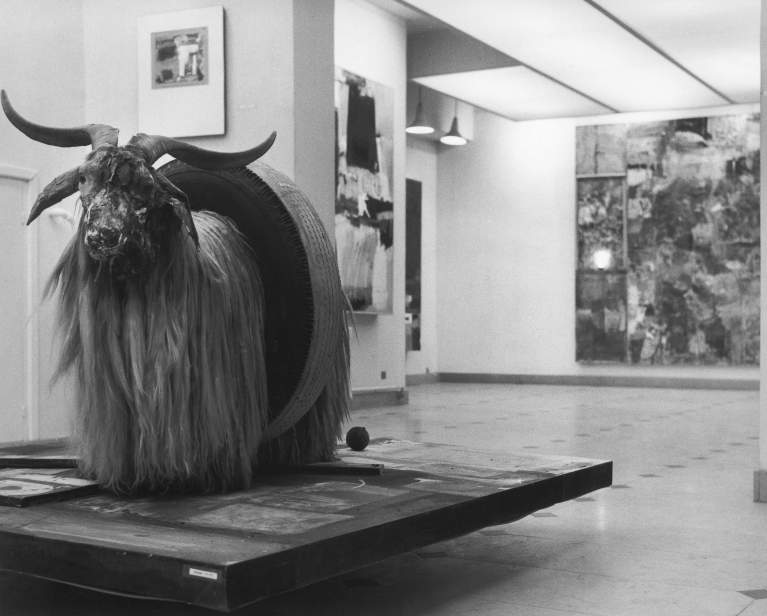 Rauschenberg: Première Exposition (Oeuvres 1954–1961), Galerie Ileana Sonnabend, Paris, February 1963. Works shown include Monogram (1955–59), Broadcast (1959), and Charlene (1954). Photo: Shunk-Kender © J. Paul Getty Trust
Rauschenberg: Première Exposition (Oeuvres 1954–1961), Galerie Ileana Sonnabend, Paris, February 1963. Works shown include Monogram (1955–59), Broadcast (1959), and Charlene (1954). Photo: Shunk-Kender © J. Paul Getty Trust

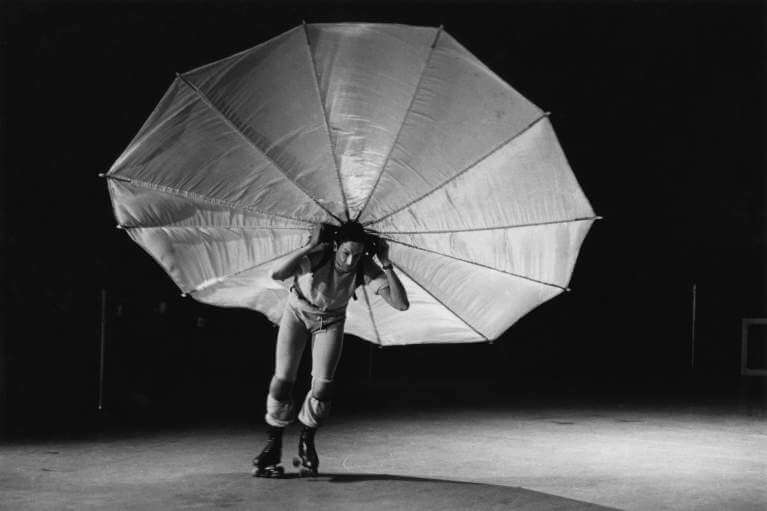 Rauschenberg performing his piece Pelican (1963), First New York Theater Rally, former CBS studio, Broadway and Eighty-first Street, New York, May 1965. Photo: Peter Moore © Barbara Moore/Licensed by VAGA, NY
Rauschenberg performing his piece Pelican (1963), First New York Theater Rally, former CBS studio, Broadway and Eighty-first Street, New York, May 1965. Photo: Peter Moore © Barbara Moore/Licensed by VAGA, NY
1964
Creates Shades (1964), an artist’s book, published by Universal Limited Art Editions (ULAE), West Islip, New York, in an edition of twenty-four. The work is an object-multiple, or editioned sculpture, consisting of lithographs printed on six square Plexiglas sheets, five of which are interchangeable and can be rearranged by the installer. An electric light placed inside an aluminum base can be set to blink or burn steadily. Rauschenberg’s decision to use Plexiglas arises from a remark made by Tatyana Grosman about the length of time required to make paper, to which he responds that they try printing on a transparent material. After experimentation, he settles on Plexiglas. Shades’ “text” consists of images culled from discarded photographic plates and printers’ mats from the New York Times.
One of twenty-eight artists to contribute a lithograph to 1¢ Life, a portfolio of poetry by Walasse Ting.1
Performs in Party, Judson Memorial Church gymnasium, New York, with Judith Dunn, Alex Hay, Deborah Hay, and Steve Paxton. Gene Friedman features the performance in his short film Three Dances (1964), along with Public, performed by museum-goers in the sculpture garden of the Museum of Modern Art, New York, and Private, an improvisation by Judith Dunn in her studio.2
January 9–February 9: Participates in Black, White and Grey Contemporary Painting and Sculpture, Wadsworth Atheneum, Hartford, Connecticut. Exhibits a White Painting (1951), a black painting (1951–52), Erased de Kooning Drawing (1953), and an untitled transfer drawing (ca. 1959).
January 30: Premiere of Rauschenberg’s Shot Put, Concert for New Paltz, State University of New York at New Paltz. In the solo performance, he dances in the darkness with a flashlight attached to his right foot, drawing with light in space. Dances to the accompaniment of an eleven-minute tape recording of excerpts from painter Öyvind Fahlström’s A Lecture on Birds in Sweden (1963), which is a reading of Edgar Allan Poe’s The Raven (1845) using stylized vocalizations. Rauschenberg provides lighting for all dances in the program, and also performs in Lucinda Childs’s Minus Auditorium Equipment and Furnishings, Alex Hay’s Colorado Plateau, and Deborah Hay’s They Will (previously Would They or Wouldn’t They) (all 1963).
February 2: Bryan Robertson’s interview with Rauschenberg broadcast on BBC television program Monitor.
February 5–March 8: Retrospective exhibition Robert Rauschenberg, Paintings, Drawings and Combines, Whitechapel Art Gallery, London.
February 10, 17: Surplus Dance Theater presents sur+, a series of performances at Stage 73, New York, for which Rauschenberg serves as lighting director. The group’s members include Rauschenberg, Lucinda Childs, Judith Dunn, Alex Hay, Deborah Hay, Robert Morris, Steve Paxton, Yvonne Rainer, and Albert Reid. Performs Shot Put and dances in Alex Hay’s Colorado Plateau (1963). Deborah Hay’s All Day Dance with Two, for which Rauschenberg designs costumes and props, is also performed.
February 27: Performs Shot Put, ONCE Festival, Ann Arbor, Michigan. Also performs in Steve Paxton’s Proxy (1962).
February 29: Calvin Tomkins’s extensive profile of Rauschenberg, “Moving Out,” appears in The New Yorker. A self-portrait—an ink thumbprint with a stenciled monogram “RR”—is the accompanying illustration.
March 2, 9: Surplus Dance Theater presents Exchange, a series of performances at Stage 73, New York, for which Rauschenberg serves as lighting director. Performs in Deborah Hay’s They Will (previously Would They or Wouldn’t They) (1963) and one evening in Lucinda Childs’s Pastime (1963).
March 21: Premieres of Merce Cunningham Dance Company’s Paired and Winterbranch, Wadsworth Atheneum, Hartford, Connecticut. Rauschenberg designs the costumes for Paired, a duet performed by Cunningham and Viola Farber. For Winterbranch, he designs the set, costumes (black sweatshirts and sweatpants), and creates an unusual lighting scheme regulated by chance, which often leaves areas of the stage in complete darkness.
April 22: New York World’s Fair opens. Rauschenberg’s silkscreen painting Skyway (1964) is installed on the exterior of the New York State Pavilion designed by architect Philip Johnson. Other artists commissioned to contribute murals and sculptural works include Peter Agostini, John Chamberlain, Robert Indiana, Ellsworth Kelly, Alexander Liberman, Roy Lichtenstein, Robert Mallory, James Rosenquist, and Andy Warhol.
April 27: With Alex Hay, Rauschenberg choreographs and performs in Dredge, an improvisational piece, during Concert of Dance #14: Improvisations by the Dance Theatre, Judson Dance Theater, Judson Memorial Church. Also participates in Deborah Hay’s group performance, Untitled Improvisation.
May–June: Develops new lithography technique at ULAE, West Islip, New York, pushing lithographic tusche through commercial photosilkscreens to transfer images, some of which also appear in silkscreen paintings, onto the stone. Resulting prints include Kip-Up, Spot, Front Roll, and Breakthrough I (all 1964).
May 8: Mike Wallace interviews Rauschenberg in his Broadway studio for the CBS television program Eye on New York. The segment, which focuses on the reopening of the Museum of Modern Art, New York, on May 27, will be broadcast on May 26.
June–November: Travels with Merce Cunningham Dance Company as lighting, set, and costume designer, and stage manager for the world tour. Itinerary includes thirty cities throughout Europe and Asia: Strasbourg, Paris, Bourges, Venice, Vienna, Mannheim, Essen, Cologne, Les Baux, Devon, London, Stockholm, Turku, Helsinki, Prague, Ostrava, Warsaw, Poznan, Krefeld, Brussels, Antwerp, Scheveningen, Bombay, Ahmadabad, Chandigarh, Delhi, Bangkok, Tokyo, Kobe, and Osaka.
June 18: Merce Cunningham Dance Company performs Antic Meet (1958), Summerspace (1958), and Story (1963), Teatro La Fenice, Venice. Controversy surrounding Rauschenberg’s eligibility for a Biennale prize adds excitement to the performance. His notoriety and increasingly visible presence on stage soon results in an end to his collaboration with the Merce Cunningham Dance Company for the next thirteen years.
June 19: Awarded International Grand Prize in Painting and two million lire ($3,200), 32nd Venice Biennale. Previously, the only Americans to win painting prizes were James McNeill Whistler, in 1895, and Mark Tobey, in 1958. Alexander Calder won the sculpture prize in 1952. The jury includes representatives from Brazil, Italy, the Netherlands, Poland, Switzerland, and an American, Sam Hunter, Director of the Rose Art Museum and of the Poses Institute of the Arts at Brandeis University, Waltham, Mass. The jury’s decision is controversial, since only one Rauschenberg work, Stop Gap (1963), has been exhibited in the U.S. Pavilion on the festival’s grounds; the remaining paintings were hung in the former American Consulate. At the last minute, Alan Solomon moves three additional works by Rauschenberg—Studio Painting (1960–61), Express (1963), and Tree Frog (1964)—to the U.S. Pavilion to satisfy the judges’ eligibility requirements. Some European critics feel that the award selection is evidence of an American “takeover” in Europe. But as critic G. di San Lazzaro writes, for all the controversy, “no one can deny his real talent as a painter, and it is to this that the jury wanted to pay homage.”3 Upon receiving the prize, Rauschenberg calls studio assistant Tony Holder in New York, asking him to destroy the approximately 150 silkscreens in his studio as a preventive measure against self-repetition.4
June 20–October 18: Exhibits works in the United States Pavilion and the former American Consulate, 32nd Venice Biennale. Organized by Solomon under the auspices of the U.S. Information Agency, the United States is represented by two related exhibitions: Four Germinal Painters, featuring Rauschenberg, Jasper Johns, Morris Louis, and Kenneth Noland; and Four Younger Artists, featuring Chamberlain, Jim Dine, Claes Oldenburg, and Frank Stella. Rauschenberg exhibits Charlene (1954), Untitled (1954), Bed (1955), Rebus (1955), Factum I (1957), Curfew (1958), Canyon (1959), Double Feature (1959), Gift for Apollo (1959), Magician (1959), Winter Pool (1959), Studio Painting (1960–61), Third Time Painting (1961), Ace (1962), Glider (1962), Express (1963), Kite (1963), Stop Gap (1963), Tracer (1963), Buffalo II (1964), Flush (1964), and Tree Frog (1964).
June 24: Premiere of Merce Cunningham Dance Company’s first “event,” Museum Event #1, Museum des 20. Jahrhunderts, Vienna. The event consists of excerpts from previous works, performed without interruption as a single one-and-a-half-hour piece. For this event, as well as those at Moderna Museet, Stockholm (September 8 and 14), Rauschenberg and Alex Hay design the costumes and props.
June 27–October 5: Axle (1964) exhibited in Documenta III, Museum Fridericianum, Kassel.
July 31: Rauschenberg designs the lighting for Merce Cunningham Dance Company’s performance of Cross Currents, Sadler’s Wells Theatre, London.
August 10–13: For the set of Merce Cunningham Dance Company’s Story (1963), Phoenix Theatre, London, Rauschenberg creates a new painting on stage (as he had done in the collaborative performance Homage to David Tudor in 1961). The resulting Combine, completed during four consecutive evenings of performance, is also entitled Story (1964).
September 12–October 18: Robert Rauschenberg, an exhibition of twenty-six Combines and silkscreen paintings and the thirty-four illustrations for Dante’s Inferno (1958–60), Museum Haus Lange, Krefeld, Germany.
September 13: While on tour with Merce Cunningham Dance Company, performs his works Shot Put and Elgin Tie, the latter in its only presentation, Five New York Evenings, Moderna Museet, Stockholm. In Elgin Tie, Rauschenberg lowers himself from a skylight by rope, donning pieces of clothing that are tied to the rope. He descends into a barrel of water on a flatbed hand truck and then emerges to slip his feet into a large pair of boots that are nailed to the truck. Meanwhile, a cow is led into the performance space. David Tudor’s music, his first score, entitled Fluorescent Sound, consists of the sounds that are picked up by microphones attached to fluorescent lights when the lights are turned off and on by Tudor. Also performs in Alex Hay’s Colorado Plateau (1963) and Steve Paxton’s Jag vill gärna telefonera (I Would Like to Make a Phone Call).
Fall: Fylkingen Society for Experimental Music, Stockholm, invites Billy Klüver to arrange for the participation of American artists in a festival of Art and Technology in Stockholm. When the Fylkingen Society pulls out in 1966, plans will proceed for a festival in New York, 9 Evenings: Theatre and Engineering.
Buffalo II (1964) appears on book jacket, Of Poetry and Power: Poems Occasioned by the Presidency and by the Death of John F. Kennedy, edited by Erwin A. Glikes and Paul Schwaber.5
Harry N. Abrams, New York, publishes the limited deluxe-edition XXXIV Drawings for Dante’s Inferno, a facsimile portfolio of Rauschenberg’s Dante illustrations (1958–60). Each of the 300 boxed sets includes one original lithograph selected from an untitled series of seven published by ULAE: Ark, Kar, Mark, Plank, Prize, Rank, and Sink (all 1964).
November 20: Rauschenberg performs Shot Put and the only staging of Tango, a solo piece where he drinks a quart of milk to music by Junosuke, Sogetsu Art Center, Tokyo. He also performs in Deborah Hay’s Contract.
November 28: While on tour with Merce Cunningham Dance Company, Rauschenberg is invited to participate in a public conversation with critic Yoshiaki Tono at Sogetsu Art Center, Tokyo. During the event, entitled Twenty Questions to Bob Rauschenberg, Rauschenberg does not respond verbally to questions but rather answers by painting on or adding objects to a gold Japanese folding screen, creating the Combine Gold Standard (1964). Deborah Hay, Alex Hay, and Steve Paxton are invited by Rauschenberg to add to the work at any time during the performance. The entire four-hour performance is filmed for Japanese television.
December 21: Monogram (1955–59) acquired by director Pontus Hultén for the Moderna Museet, Stockholm.
- 1. Walasse Ting, 1¢ Life, ed. Sam Francis (Bern, Switzerland: E. W. Kornfeld, 1964).
- 2. Sally Banes, Greenwich Village 1963: Avant-Garde Performance and the Effervescent Body (Durham, N.C.: Duke University Press, 1993), p. 90.
- 3. G. di San Lazzaro, “La XXXIIe Biennale de Venise,” XXe Siècle (Paris) 26, no. 24 (Dec. 1964), unpaginated supplement.
- 4. Tomkins, Off the Wall, p. 235.
- 5. Erwin A. Glikes and Paul Schwaber, eds., Of Poetry and Power: Poems Occasioned by the Presidency and by the Death of John F. Kennedy, with foreword by Arthur Schlesinger Jr. (New York: Basic Books, 1964).
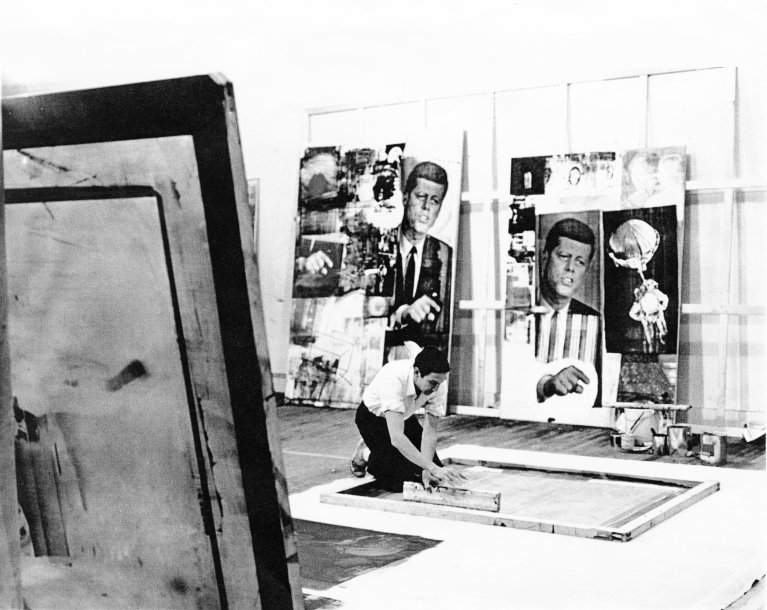 Rauschenberg working on the lower panel of Skyway (1964), Broadway studio, New York, 1964. Works in background are Buffalo II (1964) and Retroactive II (1963). Photo: Hans Namuth
Rauschenberg working on the lower panel of Skyway (1964), Broadway studio, New York, 1964. Works in background are Buffalo II (1964) and Retroactive II (1963). Photo: Hans Namuth

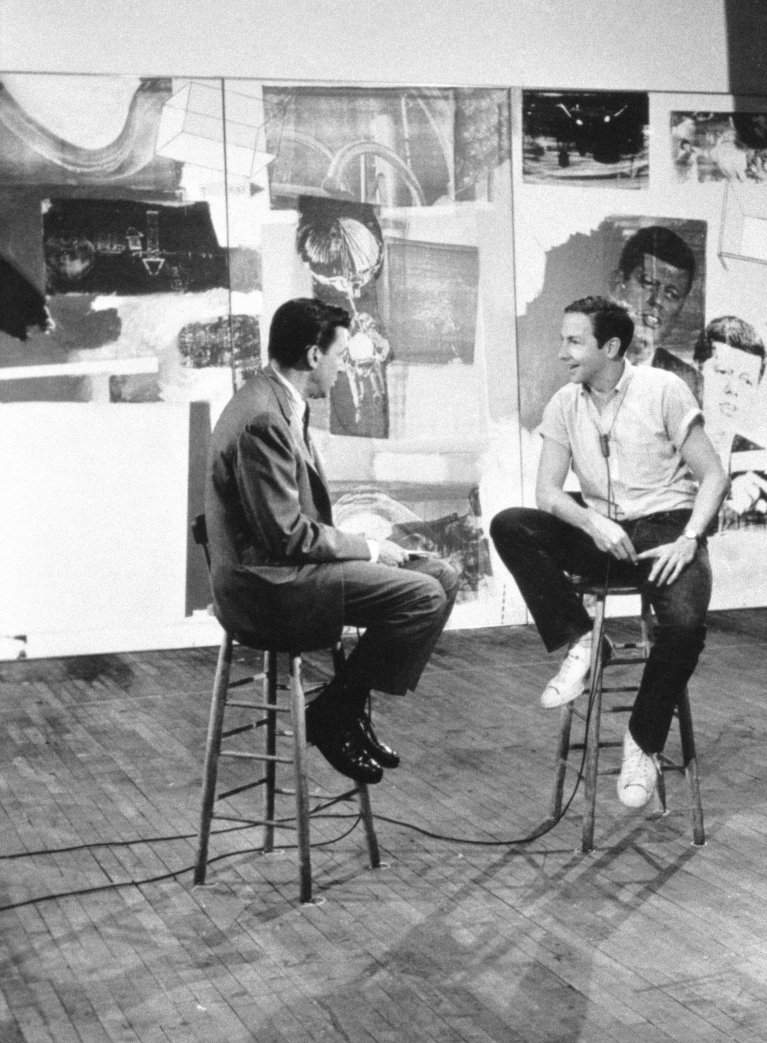 Rauschenberg interviewed by TV anchor Mike Wallace for the CBS television program Eye on New York. New York, May 1964. Work in background is Axle (1964). Photo: CBS/Landov
Rauschenberg interviewed by TV anchor Mike Wallace for the CBS television program Eye on New York. New York, May 1964. Work in background is Axle (1964). Photo: CBS/Landov

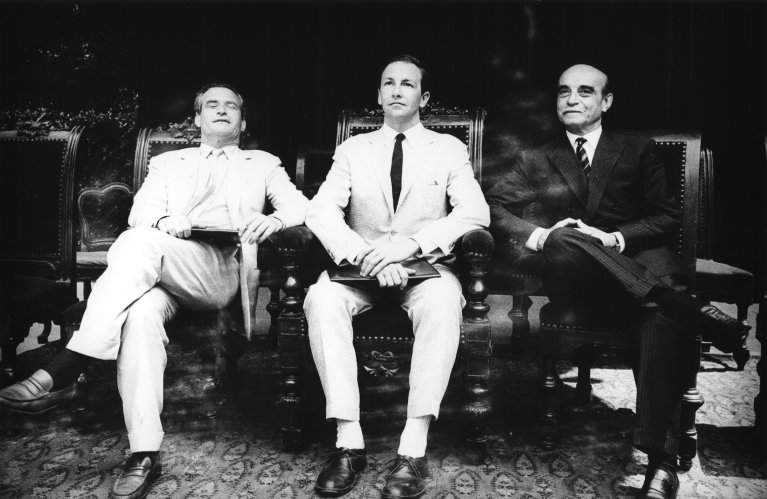 Rauschenberg and officials at the Grand Prize in Painting presentation ceremony, "XXXII Esposizione Biennale Internazionale d'Arte," Venice, June 19, 1964. Photo: Shunk-Kender © J. Paul Getty Trust
Rauschenberg and officials at the Grand Prize in Painting presentation ceremony, "XXXII Esposizione Biennale Internazionale d'Arte," Venice, June 19, 1964. Photo: Shunk-Kender © J. Paul Getty Trust

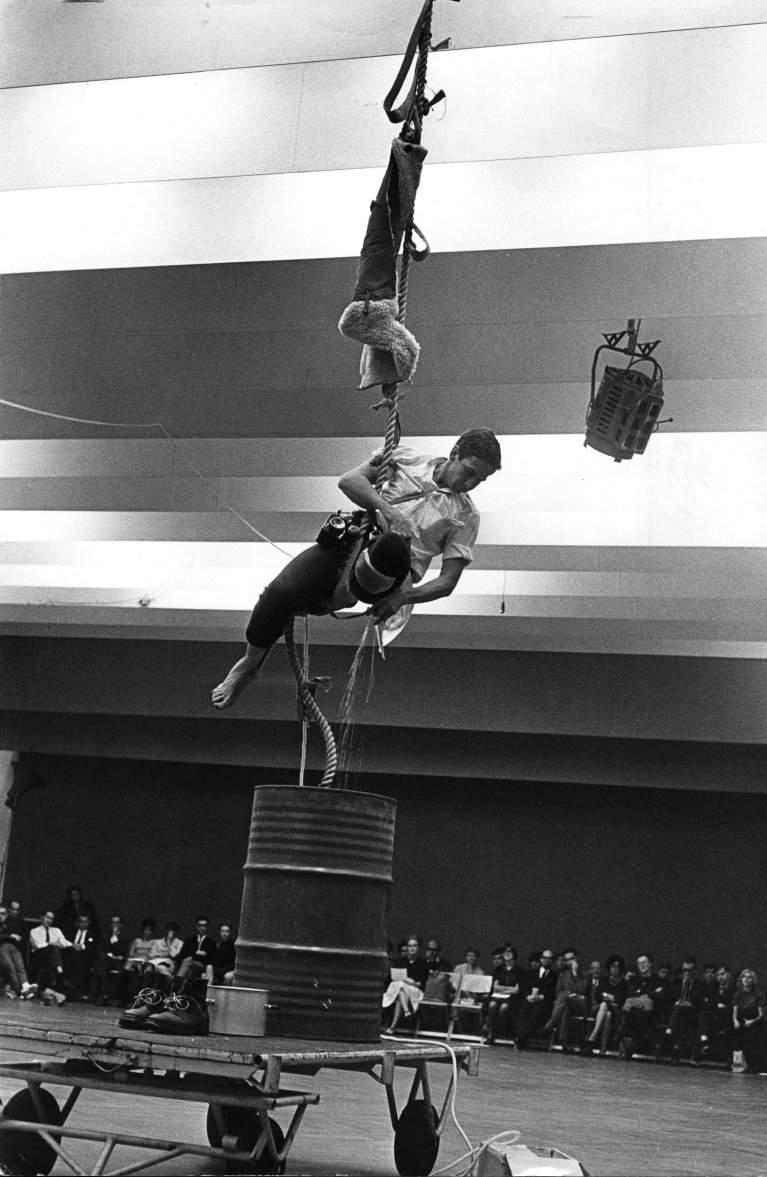 Rauschenberg performing his Elgin Tie, Five New York Evenings, Moderna Museet, Stockholm, September 13, 1964. Photo: Hans Malmberg
Rauschenberg performing his Elgin Tie, Five New York Evenings, Moderna Museet, Stockholm, September 13, 1964. Photo: Hans Malmberg

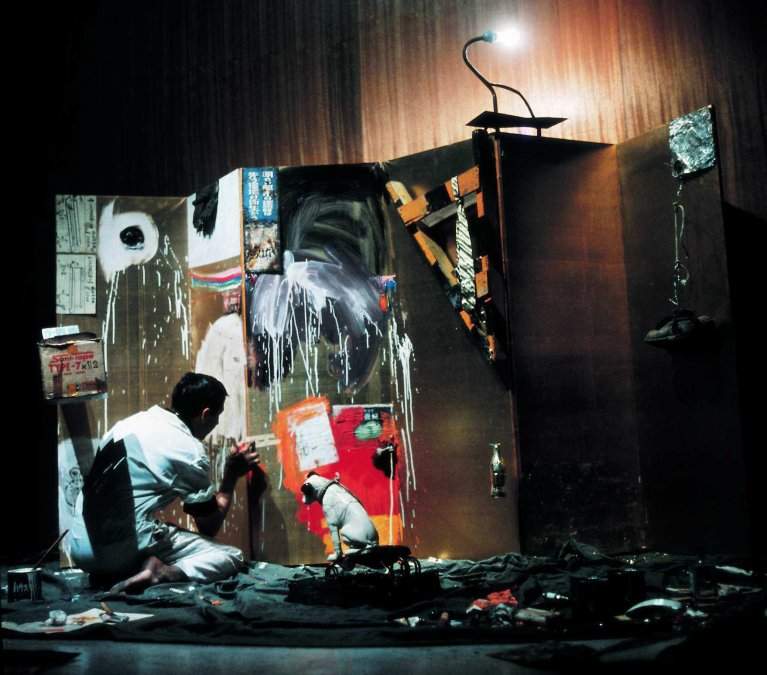 Rauschenberg creating Gold Standard (1964) during Twenty Questions to Bob Rauschenberg performance, Sogetsu Art Center, Tokyo, November 28, 1964. Photo: Courtesy of the Solomon R. Guggenheim Museum
Rauschenberg creating Gold Standard (1964) during Twenty Questions to Bob Rauschenberg performance, Sogetsu Art Center, Tokyo, November 28, 1964. Photo: Courtesy of the Solomon R. Guggenheim Museum
1965
Creates CORE Poster (1965) for a Congress of Racial Equality (CORE) benefit. CORE is a civil-rights organization, established in 1942, that protests segregation in the South through direct-action demonstrations, such as restaurant sit-ins and voter-registration marches. The poster, typical of Rauschenberg’s collages, incorporates magazine images of John F. Kennedy, a Native American, the Statue of Liberty, and the statue of a Civil War soldier, as well as New York street scenes. Rauschenberg’s involvement with the project marks the development of his direct political activism.
January 8–February 4: Robert Rauschenberg: Bilder, Zeichnungen, Lithos, Amerika Haus, Berlin, includes nine silkscreen paintings, four drawings, and six lithographs.
February: Mademoiselle issue contains Leo Lerman’s article, “The New Old Masters,” featuring Rauschenberg and Jasper Johns, with portraits by Duane Michals. Rauschenberg had been photographed in his studio by Michals and had been asked to assume various poses. The resulting composition, Collage Portrait of Rauschenberg in His Studio (1962), shows the artist at different angles.
February 26–April 18: Participates in the 29th Biennial Exhibition of Contemporary American Painting, Corcoran Gallery of Art, Washington, D.C. Exhibits Axle (1964), which is awarded the William A. Clarke Gold Medal and first prize of $2,000.
March 6, 7: Performs in Yvonne Rainer’s We Shall Run (3⁄4) (1963) and Parts of Some Sextets, Two Evenings of Modern Dance, Wadsworth Atheneum, Hartford, Connecticut.
March 12–April 15: Robert Rauschenberg, Contemporary Arts Museum, Houston. Works exhibited include Wager (1957–59), Magician (1959), Allegory (1960), Pilgrim (1960), Trophy II (for Teeny and Marcel Duchamp) (1960), and Barge (1962–63).
Spring: Artist is the guest of honor at the Purim in Venice Ball, Jewish Museum, New York, as Grand Prize winner of the 32nd Venice Biennale.
March 23–25: Rauschenberg provides the lighting and technical assistance for the Judson Dance Theater program, Yvonne Rainer and Robert Morris, at the Judson Memorial Church. Performs in Rainer’s Parts of Some Sextets.
April 13–May 8: Rauschenberg at Dwan, Dwan Gallery, Los Angeles; Rauschenberg also designs poster.
May 1–26: First New York Theater Rally, a series of performances produced by Steve Paxton and Alan Solomon, former CBS Studio, Broadway and Eighty-first Street, New York; Rauschenberg was among the sponsors. Participating artists include Rauschenberg, Carolyn Brown, Trisha Brown, Jim Dine, Judith Dunn, David Gordon, Alex Hay, Deborah Hay, Tony Holder, Robert Morris, Claes Oldenburg, the ONCE Group, Paxton, Yvonne Rainer, and Robert Whitman. For Dance Concert I (May 5–7) Rauschenberg performs in Brown’s Rule Game 5 (1964) and Deborah Hay’s Victory 14 (1964). For Dance Concert II (May 11–13) Rauschenberg performs in Spring Training, which he created for the program. Spring Training involves turtles with flashlights strapped to their backs (one of which becomes Rauschenberg’s lifelong pet Rocky); the amplified sound of pages being ripped from a phone book; water poured onto dry ice to create a cloud that envelops Rauschenberg; and such props as a shopping cart full of alarm clocks, stilts, tin cans, and a watermelon. During one segment, slides of the Empire State Building, the New York City skyline, canned food, and other scenes are projected onto a screen carried on a dancer’s back. For Dance Concert III (May 24–26), Rauschenberg performs in his Pelican as well as with Dunn in her Speed Limit (1963).
Concurrent with Dance Concert III, Rauschenberg collaborates with the Hays on Dark Horse Concert, a series of surprise performances during which Rauschenberg performs in his N.Y. 172619, Deborah Hay’s Fig, Paxton’s Flat, a revised version of Alex Hay’s Prairie (1963) (May 25 only), and Alex Hay’s The Rio Grande (on May 26 only).
May 3–June 6: Robert Rauschenberg, Paintings 1953–1964, Walker Art Center, Minneapolis. Exhibits Untitled (1954), Red Interior (ca. 1955), Bed (1955), Painting with Red Letter S (1957), Wager (1957–59), Thaw (1958), Bride’s Folly (1959), Magician (1959), Trophy I (for Merce Cunningham) (1959), Winter Pool (1959), Allegory (1960), Pilgrim (1960), Trophy II (for Teeny and Marcel Duchamp) (1960), Barge (1962–63), Express (1963), Junction (1963), Tideline (1963), Axle (1964), Quote (1964), and Tree Frog (1964).
May 15–June 19: Exhibits Oracle (1962–65), Leo Castelli, New York. The mobile sculpture consists of five separate pieces, each of which contains a radio operated by remote control from a console unit that the viewer is invited to manipulate.
May 26: Breaks foot after final performance of First New York Theater Rally. The next day, creates the lithograph Post Rally (1965), which includes an impression of the cane he receives from Saint Vincent’s Hospital, New York, where he was treated.
June 3: Makes collage Untitled (For Astronaut White) (1965) on the occasion of American astronaut Edward H. White’s becoming the first person to walk in space during the Gemini 4 space mission.
June 14: David Sylvester conducts an interview with Rauschenberg intended for BBC radio, which never airs.51
June 23: Named the most important artist to have emerged since World War II in a survey conducted by the Paris weekly newspaper Arts of one hundred French intellectuals asked to identify the ten greatest artists less than fifty years of age. Rauschenberg is the only American on the list. The other artists nominated are, in order, Jean Tinguely, Pierre Soulages, Georges Mathieu, Yves Klein, Friedensreich Hundertwasser, Bernard Buffet, Paul Guiramand, François Arnal, and Cesar.
September 17–19: ONCE Again Festival, University of Michigan, Ann Arbor. Performs in Spring Training (September 18) and in John Cage’s Talk 1 (September 19).
September 29: Attends ceremony with U.S. Senator Jacob Javits (R-N.Y.) and his wife Marion Javits in which the bill establishing the National Endowment for the Arts is signed. In honor of his active lobbying for the bill, Rauschenberg is presented with one of the pens used by President Lyndon B. Johnson to sign the bill.
November 4: Stages Map Room (later known as Map Room [I]), Goddard College, Plainfield, Vermont. The work, created by Rauschenberg, is performed by him, Alex Hay, Deborah Hay, Steve Paxton, and two student volunteers. After showing slides on a screen, Rauschenberg instructs some audience members to hang large white cards onto their backs on which he projects a travelogue movie. He sits in a chair, illuminated from behind, making shadow pictures on the wall. Deborah Hay lies on a settee in a body stocking, performing sensuous movements. For the finale, Rauschenberg walks across the stage with cans of dry ice attached to his ankles and flashlights on his legs, which illuminate the vapor. He is dissatisfied with the piece and will redevelop it as Map Room II.
Late fall: Purchases former orphanage building and chapel of Saint Joseph’s Union Mission of the Immaculate Virgin, Lafayette Street, New York. Will spend approximately one year renovating the space into a studio and living quarters before moving in.
December 1–3, 16–18: Premiere of Map Room II, New Cinema Festival I (also known as the Expanded Cinema Festival), Film-Makers’ Cinematheque, New York; the series, organized by Jonas Mekas and others, features recent experiments in New York cinema. Performers include Rauschenberg, Trisha Brown, Jim Hardy (technician), Alex Hay, Deborah Hay, and Steve Paxton. The work begins with four blindfolded participants wearing tuxedoes and holding up random selections from four sets of word cards to create nonsensical sentences. Blank cards are distributed to audience members to hang on their backs for a movie projection. Tires are prevalent props: one dancer crouches inside a tire and rolls across the floor, other dancers have tires attached to their legs. Deborah Hay wears a chicken-wire costume that holds three live doves. For the finale, Rauschenberg holds glowing neon tubes while wearing shoes encased in twenty-pound blocks of clear polyester resin by Arman. Critic John Gruen describes the piece as “an enigmatic, evocative study in juxtaposition—a Rauschenberg painting come to life—one of his combines seen moving and producing shattering noises.”52
December 17: Life magazine issue commemorates the 700th anniversary of Dante’s birth. Life commissioned Rauschenberg to create the illustration “A Modern Inferno” to accompany Frank Kappler’s feature article. The double panoramic image (Drawing for Dante’s 700th Birthday, 1965) is reproduced in two foldout sections (six pages in all). The project’s recognizable imagery consists primarily of photographs taken from Life and similar magazines depicting a mushroom cloud caused by an atomic explosion, concentration camps, civil-rights demonstrations, and figures representing “good” (John F. Kennedy) and “evil” (Joseph McCarthy and members of the Ku Klux Klan). Life will later be sued by police officer Warren E. Wilson, whose blood-splattered face is featured in the collage.
December 21: Interviewed by Dorothy Gees Seckler for American Art Oral History Program, Archives of American Art, Smithsonian Institution, Washington, D.C. Seckler will incorporate the interview into the article, “The Artist Speaks: Robert Rauschenberg,” Art in America (May–June 1966).
December 21, 1965–May 6, 1966: Rauschenberg: Illustrations for Dante’s Inferno, Museum of Modern Art, New York, the first exhibition of the drawings at the museum since their acquisition in 1963; they had previously been in an exhibition touring throughout Europe since February 1964.
December 26, 1965–February 13, 1966: Participates in Den inre och den yttre rymden: En utställning rörande en universell konst [Inner and outer space], organized by Pontus Hultén, Moderna Museet, Stockholm. Rauschenberg had given Hultén permission and clear instructions to fabricate a new set of White Paintings for the exhibition, but only the two-panel White Painting (1951) is fabricated and exhibited.
December 27: Invited to speak at the funeral of Frederick Kiesler in New York, Rauschenberg instead rolls a tire down the aisle of the church, props it near the coffin, and proceeds to paint it blue, yellow, green, and red, transforming it into a symbolic wreath.
- 51. June 14, 1961 has been recorded as an airdate for the interview. However, Sylvester published the transcript and indicates that the interview never aired. David Sylvester, Interviews with American Artists (New Haven: Yale University Press, 2001).
- 52. John Gruen, “Painter Dancing in the Dark,” Sunday Herald Tribune Magazine (New York), Jan. 2, 1966, p. 34.

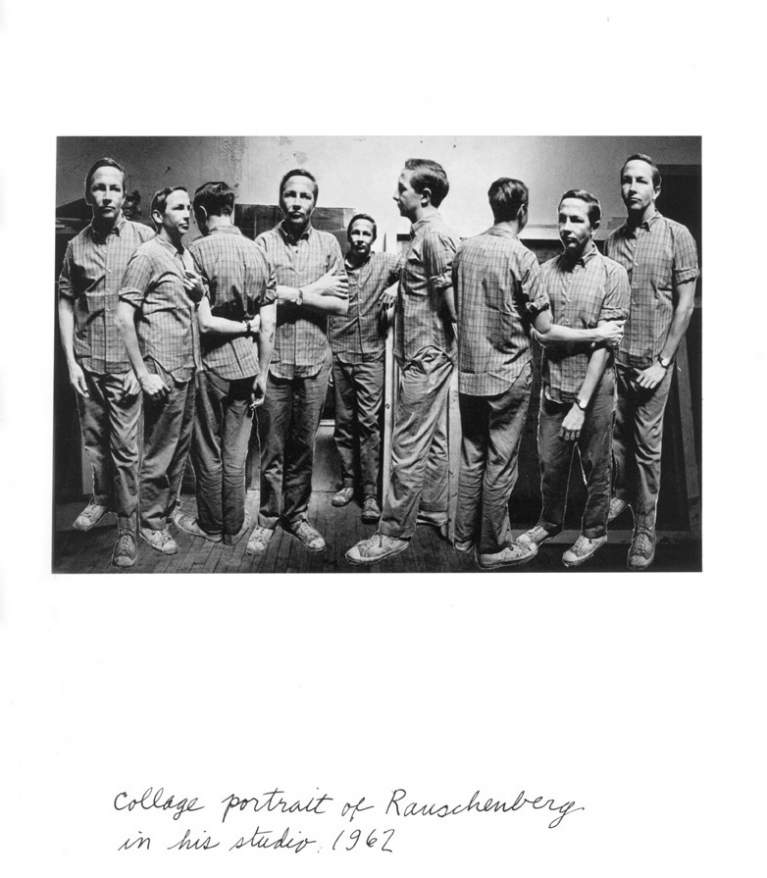 Collage Portrait of Rauschenberg in his Studio, 1962. Courtesy of Duane Michals and DC Moore Gallery, New York
Collage Portrait of Rauschenberg in his Studio, 1962. Courtesy of Duane Michals and DC Moore Gallery, New York


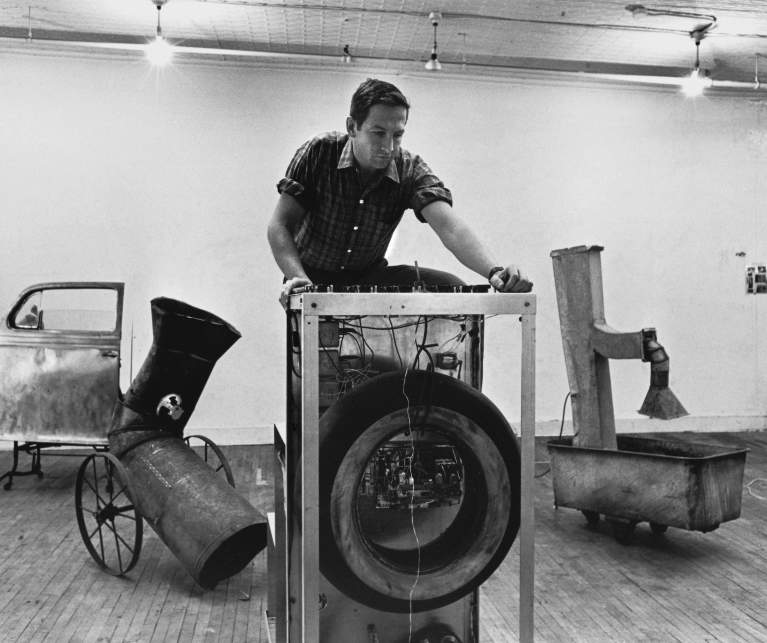 Rauschenberg working on Oracle (1962–65) in his Broadway studio, New York, 1965. Photo: Ugo Mulas © Ugo Mulas Heirs. All rights reserved
Rauschenberg working on Oracle (1962–65) in his Broadway studio, New York, 1965. Photo: Ugo Mulas © Ugo Mulas Heirs. All rights reserved

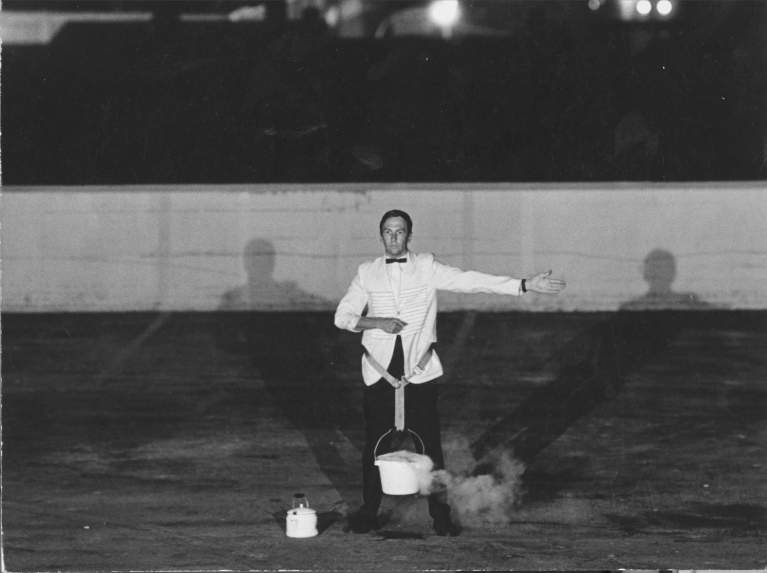 Rauschenberg’s Spring Training performed at ONCE Again Festival, Maynard Street Parking Structure, University of Michigan, Ann Arbor, September 18, 1965. Photo: Peter Moore © Barbara Moore/Licensed by VAGA, NY
Rauschenberg’s Spring Training performed at ONCE Again Festival, Maynard Street Parking Structure, University of Michigan, Ann Arbor, September 18, 1965. Photo: Peter Moore © Barbara Moore/Licensed by VAGA, NY


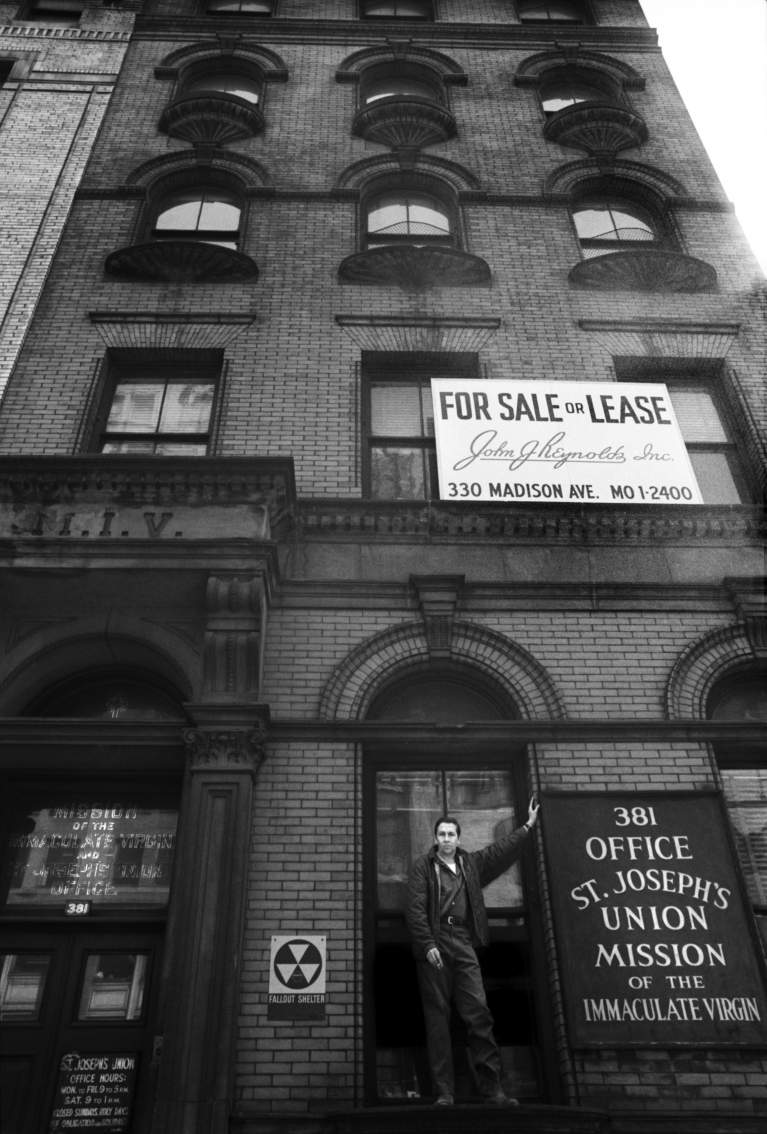 Rauschenberg in front of the Office of St. Joseph’s Union Mission of the Immaculate Virgin, 381 Lafayette Street, New York, shortly after purchasing the building, 1965. Photo: Ugo Mulas © Ugo Mulas Heirs. All rights reserved
Rauschenberg in front of the Office of St. Joseph’s Union Mission of the Immaculate Virgin, 381 Lafayette Street, New York, shortly after purchasing the building, 1965. Photo: Ugo Mulas © Ugo Mulas Heirs. All rights reserved
1966
January 10–12: Performs in Steve Paxton’s Proxy (1962) and Section of a New Unfinished Work: Augmented (modified from Section of an Unfinished Work, 1965) in A Dance Concert of Old and New Works, Judson Dance Theater, Judson Memorial Church, New York.
January 14: First meeting between artists and engineers for the performance festival 9 Evenings: Theatre & Engineering to be held in October.
February 26: Dedication of Artist’s Peace Tower, Los Angeles, one of the first and most dramatic efforts of an art movement protesting the Vietnam War. More than 400 artists attach their paintings to the 58-foot-tall tower, built by sculptor Mark di Suvero in an empty lot rented with funds contributed by Rauschenberg and CPLY (William Copley). Despite pro-war groups continually threatening its existence, thousands of people will come to the site during its three-month installation. Money raised through the sales of the works (about $12,000) is donated to the Los Angeles Peace Center.
March 29, 30: Performs with Alex Hay in Deborah Hay’s Serious Duet, A Concert of Dance by Trisha Brown and Deborah Hay, Judson Dance Theatre, Judson Memorial Church, New York.
April 13, 20: Participates in Five Choreographers in Three Dance Concerts, sponsored by the Los Angeles County Museum of Art, Rollerdrome, Culver City, California. Performs in his works Map Room II (1965) (April 13) and Pelican (1963) (April 20).
April 22: Participates in a site-specific performance of Deborah Hay’s Hill (1965) with Hay and Paxton at the reflecting pool of the Los Angeles County Museum of Art, as part of Five Choreographers in Three Dance Concerts. Rauschenberg, Hay, and Paxton were invited to Los Angeles by the director of the museum, James Elliot. While there, they attended Elliot’s wedding on a bare mesa overlooking the city. Paxton recounts that after the ceremony the couple mounted a motorcycle and “drove off into the future,” adding that later he learned they dismounted the cycle and actually drove a car into the future.1
April 26–May 1: NOW Festival, National Arena roller-skating rink, Washington, D.C. The festival includes performance pieces by Rauschenberg, Claes Oldenburg, Andy Warhol, and Robert Whitman. Rauschenberg performs in premiere of Linoleum and in Pelican (1963) (both April 26), and in Deborah Hay’s Serious Duet (April 29). Paxton performs his Earth Interior, where performers are invited to contribute events around and inside a 100-foot polyethylene tunnel 8 feet in diameter. Rauschenberg is photographed in the tunnel with Paxton, but was not an “invited contributor.” Linoleum, choreographed by Rauschenberg, features plastic suits wired for sound by engineer Cecil Coker; a performer eating fried chicken and pushing himself and a few live chickens across the stage in a wire-mesh cage on wheels; and motorized sculptures by Robert Breer. Rauschenberg projects his film Canoe (1966), created by editing footage from a found film. Linoleum will be performed and videotaped in the studios of WNET Channel 13, New York, for television broadcast.
Also during the last week in April, Indiana Congressman John Brademas hosts a lunch for artists and politicians, many of whom are in Washington for the NOW Festival. Among those included are John Cage, Billy Klüver, Yvonne Rainer, Rauschenberg, Robert Whitman, Metropolitan Museum of Art curator Henry Geldzahler, and U.S. Senator Jacob Javits.
May–June: Art in America issue with cover designed by Rauschenberg. The design, a collage of photographs of Ohio and works from the Cleveland Museum of Art’s collection, honors the museum’s fiftieth anniversary.
June 28: As part of the television program U.S.A. Artists, National Educational Television presents “Robert Rauschenberg,” featuring conversations with Rauschenberg and Leo Castelli, and footage of Rauschenberg at work in his studio and in performances.
August 19–October 16: Participates in the 68th American Exhibition, Art Institute of Chicago. Exhibits Oracle (1962–65), for which he is awarded the Norman Wait Harris Silver Medal and prize of $2,500.
Fall: With renovations complete, moves into the building at 381 Lafayette Street, New York, which becomes both his working and living space.
September 25: With Klüver, engineer Fred Waldhauer, and Whitman, cofounds Experiments in Art and Technology (E.A.T.), New York. The organization seeks to promote the use of technology for nonindustrial purposes by arranging collaborations between artists and engineers, creating “the possibility of a work which is not the preoccupation of either the engineer, the artist, or industry, but the result of the exploration of the human interaction between these three areas.”2 As vice president, Rauschenberg will assist in fundraising and organizing events and meetings. In September 1968, he will become chair, a position he will hold until 1972. By 1969, E.A.T. will have forty chapters in the United States and abroad.
September 29: Press conference announcing 9 Evenings: Theatre & Engineering, held in the chapel at Rauschenberg’s Lafayette Street studio. Speakers included Cage, Öyvind Fahlström, Deborah Hay, Klüver, and Rauschenberg.
October 9: Dressed in the plastic costume he wore in Linoleum and the Arman shoes he wore in Map Room II (1965), Rauschenberg appears on the cover of the New York Times Magazine, containing Richard Kostelanetz’s profile of Rauschenberg, “The Artist as Playwright and Engineer.”
October 13–16, 18–19, 21–23: 9 Evenings: Theatre & Engineering, 69th Regiment Armory, New York. Performers in the series include Rauschenberg, Cage, Lucinda Childs, Fahlström, Alex Hay, Deborah Hay, Paxton, Rainer, David Tudor, and Whitman. Rauschenberg designed the festival’s poster and choreographed Open Score (October 14 and 23). The performance features a tennis match played with rackets that are wired for sound; with each impact of the tennis ball, the armory lights shut off one by one until the space becomes completely dark and the large screens of a closed-circuit, infrared television system reveal to the audience the cast of over 500 performers who have quietly assembled onstage. Rauschenberg also performs in Alex Hay’s Grass Field (October 13 and 22), Deborah Hay’s Solo (October 13 and 23), and Fahlström’s Kisses Sweeter than Wine (October 21 and 22).3
November 10: Participates in “Is Easel Painting Dead,” a symposium in the Critics Colloquium series, New York University. Other panel members include Walter Darby Bannard, Donald Judd, and Larry Poons; Barbara Rose is moderator.
November 30: Speaks at the first meeting of E.A.T., Broadway Central Hotel, New York, attended by 300 people.
December 6–10: With Alex Hay and Paxton, organizes and participates in benefit exhibition for E.A.T. at Leo Castelli, New York, to recoup expenses from the 9 Evenings event. Rauschenberg contributed an interactive sculptural costume comprised of a Salvation Army thrift shop overcoat (previously used in an Oldenburg happening) with objects hanging from the left side, including a lightbulb, a Blue Cleaner can, and a cardboard box, and topped with a scrap-metal headpiece. An old sneaker resting on a pillow accompanies the assemblage. For a donation, visitors don the modified coat and put their right foot in the sneaker. Rauschenberg then photographs them with a Polaroid camera.
- 1. E-mail correspondence from Deborah Hay, July 2, 2014, and from Steve Paxton, July 3, 2014, with Julia Blaut. Hay was the first to mention the details of the wedding, which were further clarified by Paxton.
- 2. Quoted in Hopps, Robert Rauschenberg, p. 45.
- 3. The collaborations at the festival resulted in about nineteen new patents obtained by the engineers.

 Herb Schneider, Rauschenberg, Lucinda Childs, L.J. Robinson, Per Biorn and Billy Klüver in Berkeley Heights, NJ, preparing for *9 Evenings: Theatre and Engineering*, Berkeley Heights, New Jersey, 1966. Photo: Attributed to Frances Breer
Herb Schneider, Rauschenberg, Lucinda Childs, L.J. Robinson, Per Biorn and Billy Klüver in Berkeley Heights, NJ, preparing for *9 Evenings: Theatre and Engineering*, Berkeley Heights, New Jersey, 1966. Photo: Attributed to Frances Breer


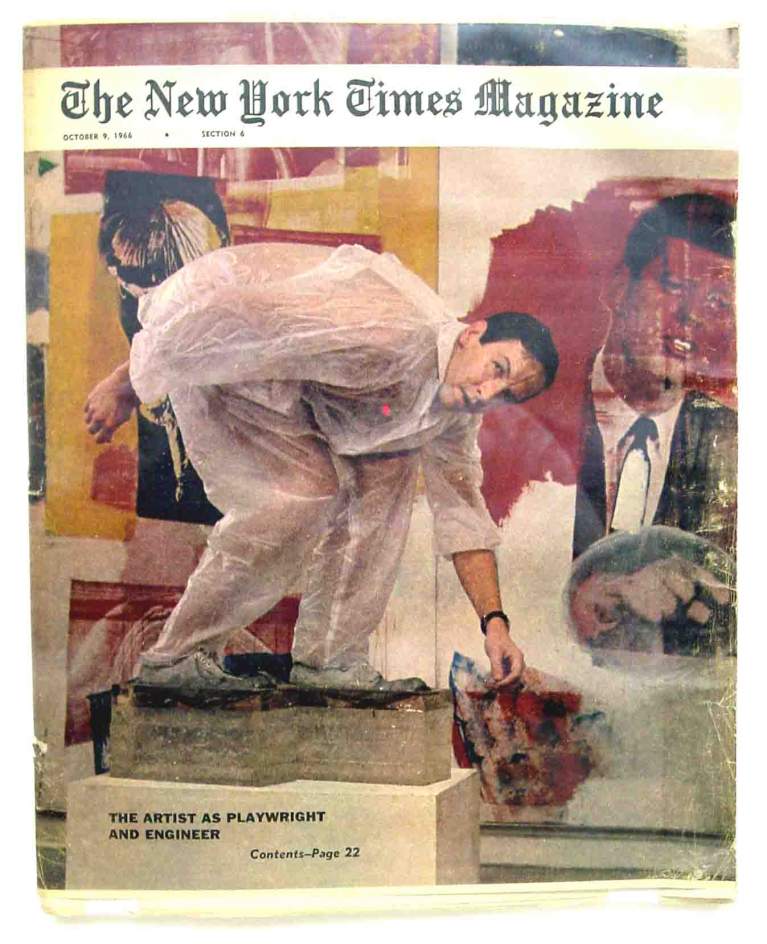 Rauschenberg on the cover of October 9, 1966 issue of The New York Times Magazine wearing Linoleum (1966) costume and Map Room II (1965) shoes
Rauschenberg on the cover of October 9, 1966 issue of The New York Times Magazine wearing Linoleum (1966) costume and Map Room II (1965) shoes
1967
Creates two untitled transfer drawings for the book In Memory of My Feelings by Frank O’Hara. One drawing is overlaid with O’Hara’s poem “A Step Away from Them”; both are gifted to the Illustrated Book Collection of the Museum of Modern Art, New York. The limited-edition volume includes photo-offset reproductions of forty-six drawings by Rauschenberg, Jasper Johns, Willem de Kooning, Roy Lichtenstein, Robert Motherwell, Barnett Newman, Claes Oldenburg, Niki de Saint Phalle, and other artists.
Designs book cover for Poems by John Giorno.1
January 15: Experiments in Art and Technology (E.A.T.), New York, publishes first issue of E.A.T. News, designed by Rauschenberg. Subsequent issues of their newsletter will be published later this year on June 1, November 1, and December 20, and the following year on March 18.
February–April: Begins working relationship with print workshop Gemini G.E.L., Los Angeles, making Booster and 7 Studies (all 1967). Booster, at 6 feet in height, is the largest hand-pulled lithograph to date. The work reproduces six X-rays which together depict Rauschenberg's full skeleton to scale, requiring two lithography stones connected by a honeycomb structure. To create the lithograph, Rauschenberg uses a new transfer technique of photomechanically reproducing newspaper and magazine images onto printing plates. The project, which incorporates silkscreen and lithography, represents Gemini G.E.L.’s first activity in combination printing.
March: Participates in Art in Process, Finch College Museum of Art, New York. Exhibits Short Circuit (1955).
March 7: Rauschenberg performs in Outskirts, which he created for the event Body, organized by Jon Gibson and coordinated by Irving Sandler, Loeb Student Center, New York University. The performers crawl along the stage, their heads poking through holes in a white sheet onto which Rauschenberg’s film Canoe (1966) is projected. Also performs in John Giorno’s Raspberry.
Early spring: Makes Revolver series, six sculptures consisting of silkscreened ink on five rotating Plexiglas discs, each one mounted behind the other in no particular order, with electric motors. By using a control box, the viewer rotates the discs and creates a kaleidoscopic effect with the images. The works will be featured in the broadcast “The Walls Come Tumbling Down” on the CBS television program Eye on New York.
April 28–October 27: Participates in American Painting Now, organized by Alan Solomon for Expo ’67, Montreal, U.S. Pavilion. Exhibits Green Shirt (1965–67), a multicolored painting of neon and enameled metal installed inside R. Buckminster Fuller’s geodesic dome. The work, commissioned in 1965, contains motifs found in Rauschenberg’s silkscreen paintings such as Peter Paul Rubens’s Venus in Front of the Mirror (1614–15), insects, and a diagram of cubes. The exhibition will travel to the Institute of Contemporary Art, Boston.
May 13–June 10: Exhibits Revolvers, Leo Castelli, New York.
May 26: Rauschenberg and artists Jack Levine and Andrew Wyeth are featured in a broadcast of the NBC television program The American Image, a documentary series exploring American life as depicted by artists from colonial to contemporary times, focusing on four broad themes: the land, industrialization and cities, patriotism and politics, and the people.
June 6–8: Giant Model Airplanes, an exhibition and auction organized by Christie’s of London to benefit E.A.T., is held in Rauschenberg’s Lafayette Street studio, New York. The works, created for donation by ONCE Group, Ann Arbor, Michigan, are precisely scaled with detailed enlargements of stick-and-tissue models of vintage aircraft.
[Summer]: Works, along with Alex Hay, Deborah Hay, and Steve Paxton, with students at Port Townsend Theater Workshop, Washington.
July 5–31: Exhibition of Booster and 7 Studies, Douglas Gallery, Vancouver.
October 10: Press conference and exhibition of artworks involving technology, including Oracle (1962–65), held at Rauschenberg’s Lafayette Street studio, to formally introduce E.A.T. to the public. Speeches are delivered by Rauschenberg; Warren Brodey, director of M.I.T. Science Camp; Ralph Gross, President, Commerce and Industry Association; U.S. Senator Jacob Javits (R-N.Y.); Herman Kenin, President, American Federation of Musicians; Theodore Kheel, President, American Foundation on Automation and Employment, and labor mediator; Robert Morris; and John Pierce, Executive Director, Bell Telephone Laboratories.
October 24: Participates in Elaine Sturtevant’s Relâche, School of Visual Arts, New York, a (non)performance based on Francis Picabia and Erik Satie’s 1924 ballet of the same name. Sturtevant’s “performance” consists of a sign on the theater door announcing its cancellation (relâche) and a photograph entitled Relâche, which imitates a Man Ray photograph of a scene from Picabia’s play Cinésketch (December 31, 1924) in which Marcel Duchamp and Brogna Perlmutter (Francine Picabia) appeared naked as Adam and Eve in a tableau vivant of Lucas Cranach’s Adam and Eve (1533). In Sturtevant’s photograph, Rauschenberg poses nude as Duchamp posing as Adam (with false beard and fig leaf) and she poses as Eve.2
October 24–December 2: Participates in Protest and Hope: An Exhibition of Contemporary American Art, New School Art Center, New York. Exhibits silkscreen painting, Caller (1965). Forty-three artists, including Rauschenberg, Red Grooms, Elaine de Kooning, George Segal, and Andy Warhol, contribute works relating to the show’s antiwar and civil-rights themes.
October 29: Receives honorary degree, Doctor of Humane Letters, Grinnell College, Iowa. Meets Martin Luther King, Jr., who has been temporarily released from prison to accept an honorary degree from the college.
November 9–December 17: Participates in Kompas 3: Schilderkunst na 1945 uit New York (Paintings after 1945 in New York), Stedelijk Museum, Amsterdam. Exhibits Charlene (1954), Pilgrim (1960), and Wall Street (1961). The exhibition will travel to Frankfurter Kunstverein (as Kompass New York: Malerei nach 1945 aus New York).
November 10, 19: Rauschenberg performs in Urban Round, which he creates for Fall Gallery Concerts, School of Visual Arts, New York. The work is performed by him, Mel Bochner, Sandy Daley, Simone (Whitman) Forti, Susan Hartnett, Deborah Hay, Billy Klüver, Brice Marden, Julie Martin, Steve Paxton, Yvonne Rainer, Christopher Rauschenberg, Dorothea Rockburne, Annina Weber, John Weber, and David White. A silkscreen painting is used as the backdrop against which performers read aloud from newspapers while being carried on brightly colored wood boards. Each performer reads an article and then descends to help carry a new reader.
December 8: Time magazine features cover designed by Rauschenberg using film stills from Bonnie and Clyde to accompany the article “Hollywood: The Shock of Freedom in Films.”


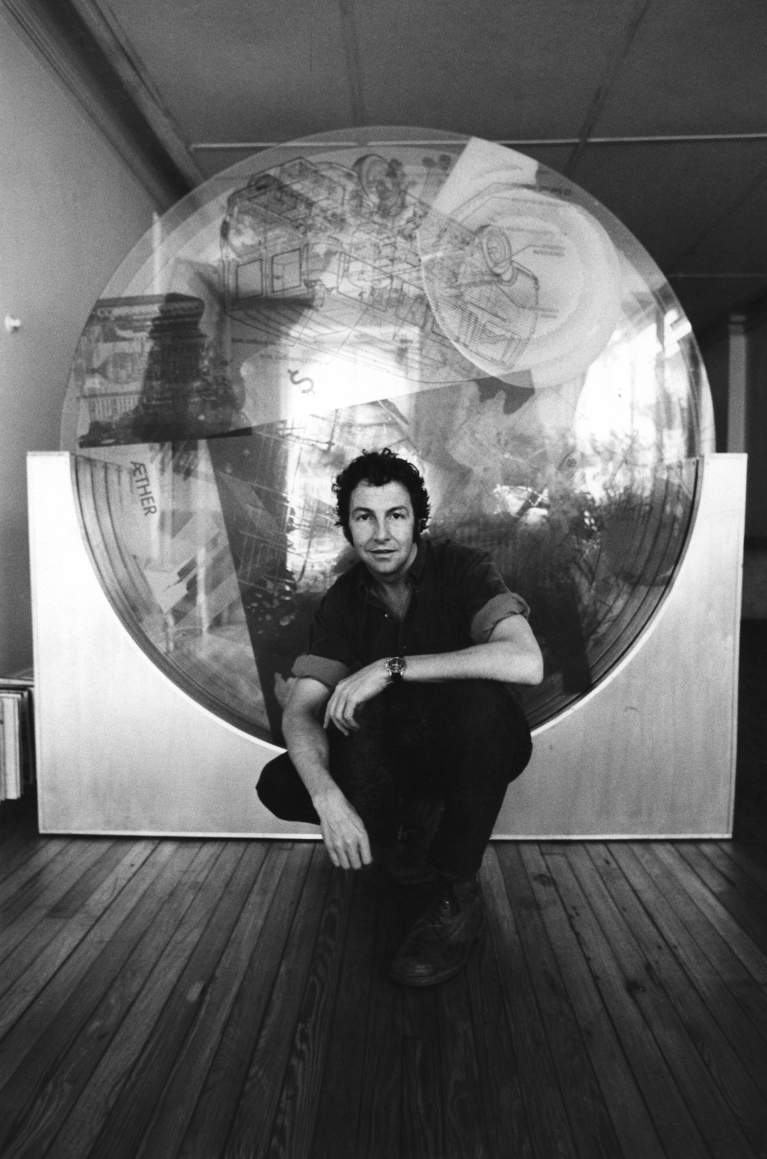 Rauschenberg in his Lafayette Street studio with Revolver VI (1967), New York, ca. 1967. Photo: Maurice Hogenboom
Rauschenberg in his Lafayette Street studio with Revolver VI (1967), New York, ca. 1967. Photo: Maurice Hogenboom
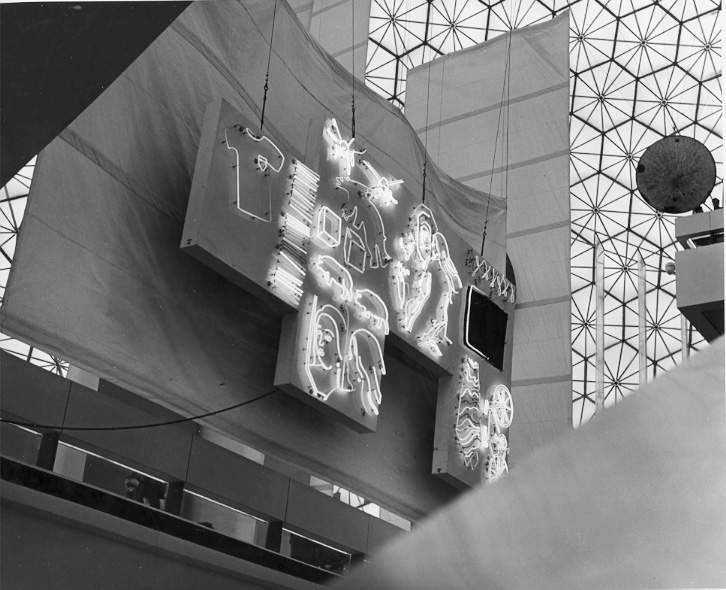 Rauschenberg’s Green Shirt (1967) on view in American Painting Now, R. Buckminster Fuller’s geodesic dome, United States Pavilion, Expo 67, Montreal. Photo: Shunk-Kender © J. Paul Getty Trust
Rauschenberg’s Green Shirt (1967) on view in American Painting Now, R. Buckminster Fuller’s geodesic dome, United States Pavilion, Expo 67, Montreal. Photo: Shunk-Kender © J. Paul Getty Trust

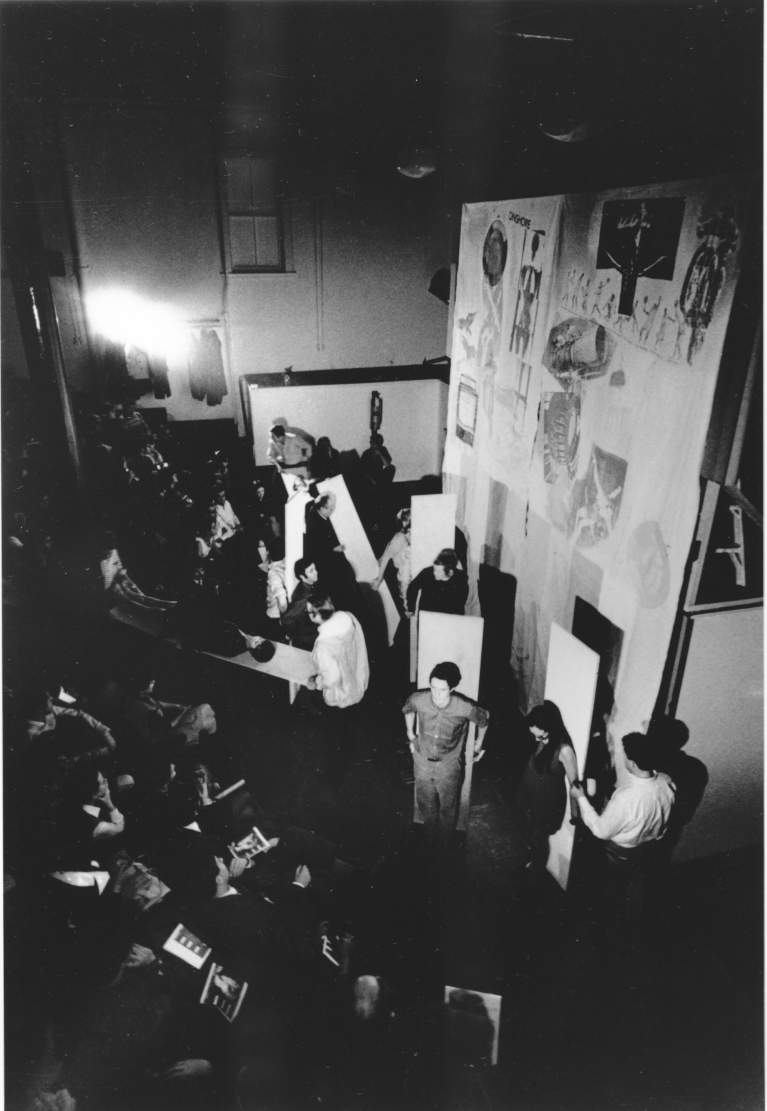 Rauschenberg’s Urban Round, Fall Gallery Concerts, School of Visual Arts, New York, November 1967. Photo: Peter Moore © Barbara Moore/Licensed by VAGA, NY
Rauschenberg’s Urban Round, Fall Gallery Concerts, School of Visual Arts, New York, November 1967. Photo: Peter Moore © Barbara Moore/Licensed by VAGA, NY
1968
Creates poster for the reelection campaign of U.S. Senator Jacob Javits (R-N.Y.).
Creates preface for WORDSWORDSWORDS, an artist’s book of poetry by Edwin Schlossberg, published by Universal Limited Art Editions (ULAE), West Islip, New York, in an edition of twenty-five. The poems are printed on a variety of materials, including folded paper, aluminum, acetate, and Plexiglas. Rauschenberg creates the preface using blind-embossed imagery and the phrase “Solar wind and its effect on the Earth and Moon.”
Meets singer Janis Joplin, a fellow native of Port Arthur, Texas, at Max’s Kansas City, a New York nightclub. They become close friends until her death on October 4, 1970.
January 14–16: Evolving from his Time magazine cover project on Bonnie and Clyde, Rauschenberg creates the lithographic series Reels [B + C] during sixty-four hours of continuous work, using publicity and film stills. Gemini G.E.L., Los Angeles, will publish the six prints in editions ranging from forty-six to fifty-one.
January 22–February 22: Robert Rauschenberg: Print, Whitney Museum of American Art, New York. The exhibition consists entirely of Autobiography (1968), an approximately 16 1/2-foot-tall color offset lithograph on three sheets of paper, published in an edition of 2,000 by Broadside Art, Inc., New York, a new press sponsored by Marion Javits, wife of Senator Javits, to make billboard presses available to artists. Autobiography is the first fine-art print created on a billboard press. Presented vertically in this exhibition, the work can also be displayed in a horizontal orientation. Each sheet includes an image of Rauschenberg: (top or left) a full-body X-ray (comprised of six 1-foot tall X-rays, also used in Booster, 1967) superimposed on the artist’s astrological chart; (middle) a childhood photograph overlaid on spiraling autobiographical text; (bottom or right) a photograph of Rauschenberg performing in Pelican (1963) set within a montage of silkscreened images, including the New York City skyline and a navigational chart of the Gulf of Mexico, off the coast of Port Arthur.
February 23–April 7: Robert Rauschenberg, Stedelijk Museum, Amsterdam. The exhibition will travel to Kölnischer Kunstverein, Cologne, and Musée d’Art Moderne de la Ville de Paris. The thirty-seven works exhibited include a new technology work, Soundings (1968), a collaboration with Experiments in Art and Technology (E.A.T.), New York, and engineers Billy Klüver, L. J. Robinson, Fred Waldhauer, Cecil Coker, Per Biorn, and Ralph Flynn. The work consists of a wall, 7 feet and 10 inches in height and 36 feet in length, made of three layers of panels: the outermost of mirrored Plexiglas and the inner two of Plexiglas silkscreened with repeated images of a chair in various orientations. Concealed electric lights between the layers expose the images when activated by viewers’ sounds. Two hundred different combinations of imagery are possible.
March: An important series of lectures is delivered by Leo Steinberg at the Museum of Modern Art, New York. The ending lines of the final lecture are extemporized from notes that read:
One final point concerning the picture plane. [Clement] Greenberg’s criticism, oriented to the problems of Cubism, spoke in terms of its flatness, integrity, autonomy and so forth. There is another criterion—the angle of it. The upright worlds of earlier art—their makers were still nature painters [showing slide of Jackson Pollock’s Autumn Rhythm: Number 30, 1950]. There is a radical shift in the fifties [slides of Jean Dubuffet’s Still Life with Passport, 1953, and Rauschenberg’s 22 The Lily White, ca. 1950]. Not spaces . . . but imprints. The PP [picture plane] is horizontal.
Steinberg, in an amended version of the lectures published in Artforum (March 1972) including a new section, “The Flatbed Picture Plane,” will write:
What I have in mind is the psychic address of the image, its special mode of imaginative confrontation, and I tend to regard the tilt of the picture plane from vertical to horizontal as expressive of the most radical shift in the subject matter of art, the shift from nature to culture.
Discussing the Combine paintings, he explains, “Though they hung on the wall, the pictures keep referring back to the horizontals on which we walk and sit, work and sleep.”1
April 1: E.A.T. and Amalgamated Lithographers of America, Local 1 Chapter, New York, launch a project inviting artists to work with printers and presses. Rauschenberg acts as advisory board chair of the printing workshop.
May 28: Performs in Linoleum (1966) as part of Spring Gallery 68 at Bert Stern’s studio, New York.
June 7–9: Performs in Simone (Whitman) Forti’s Pedestals (1961), in a vacant apartment at 200 Park Avenue South, New York.
June 27–October 6: Participates in Documenta IV, Museum Fridericianum, Kassel. Exhibits the new technology work Solstice (1968); the paintings Pilgrim (1960), Wall Street (1961), and Almanac (1962); the lithographs Breakthrough I (1964), Front Roll (1964), Kip-Up (1964), Shades (1964), Spot (1964), and Booster and 7 Studies (all 1967); and another technology work from the Revolver series (1967). Creates with the assistance of engineers Robinson, Biorn, Tony Tedona, and Flynn, the five motorized Plexiglas doors of Solstice slide open when approached by viewers. Each door is silkscreened with images of architectural details, technical drawings, urban photographs, and words. Rauschenberg donates Solstice to Automation House, New York, where E.A.T.’s headquarters is located; it will later be sold to the National Museum of Art, Osaka.
July 26: Purchases his first property in Captiva, Florida, the so-called “Beach House.”
September: Begins three-year collaboration with Teledyne, Los Angeles, on Mud Muse (1968–71), which is made for inclusion in the exhibition Art and Technology at the Los Angeles County Museum of Art in 1971. Created in collaboration with Frank LaHaye and Lewis Ellmore, engineers at Teledyne,2 Mud Muse is a room-size vat filled with driller’s mud that bubbles in response to sound through a system of control valves and compressed-air inlets inside the tank. A tape recording of the bubbling mud plays, causing the mud’s continuing response.
Early fall: Creates Political Folly (1968), a transfer drawing with images of Democratic presidential candidates Hubert Humphrey and Eugene McCarthy and the Grant Park antiwar demonstrations in Chicago, for the collective exhibition Response to Violence in Our Society, organized by several Chicago galleries to protest police brutality during the recent Democratic National Convention in their city. Proceeds from the exhibition are donated to the American Civil Liberties Union.
October 10–November 10: Robert Rauschenberg: Oeuvres de 1949 à 1968, Musée d’Art Moderne de la Ville de Paris. The exhibition, originally set to open in June, is postponed due to the May student riots. Twenty-six lithographs and Solstice (1968) are added to the exhibition since its presentation at the Stedelijk Museum, Amsterdam; Soundings (1968) is not included.
October 12–27: White Paintings 1951, Leo Castelli, New York. Since most of the original panels of the White Painting series were recycled into later artworks, including Yoicks (1954), K24976S (1956), Trophy II (for Teeny and Marcel Duchamp) (1960), and Stripper (1962), Rauschenberg has studio assistant Brice Marden prepare a new set of paintings, which continue to bear the date of their original conception (1951) regardless of when they are made. The refabrication is considered controversial.
October 22, 1968–January 26, 1969: Exhibits Soundings (1968), Museum of Modern Art, New York.
November 26, 1968–January 5, 1969: The exhibition Some More Beginnings: Experiments in Art and Technology, Brooklyn Museum, New York, includes 137 of the submissions to a competition for collaborations between artists and engineers, organized by E.A.T. and selected by a jury of scientists and engineers. Rauschenberg, who participates in formulating and establishing the ground rules for the competition, designs the exhibition catalogue in collaboration with Klüver and Julie Martin.
November 27, 1968–February 9, 1969: Participates in The Machine As Seen at the End of the Mechanical Age, organized by K. G. Pontus Hultén, Museum of Modern Art, New York. Exhibits Pantomime (1961) and Oracle (1962–65). The exhibition includes several works by the finalists to the E.A.T. competition, who were selected “for the most inventive use of new technology as it evolves through the collaboration of artist and engineer.”3 The exhibition will travel to Rice Museum, Rice University, Houston, and San Francisco Museum of Art.
- 1. The content of the lectures and published texts was clarified by Leo Steinberg in a telephone conversation with Susan Davidson and Joan Young, August 11, 1997, and by a facsimile of the original lecture notes. For the complete amended text, see Steinberg, “Reflections on the State of Criticism,” Artforum (New York) 10, no. 7 (March 1972), pp. 37–49; for the two quotations, see pp. 46–47.
- 2. LaHaye and Ellmore were the primary engineering collaborators. George Carr supervised the building of a prototype in fall 1969; in 1970, Jim Wilkinson was chief engineer overseeing construction and Carl Adams coordinated the actual construction. Maurice Tuchman, A Report on the Art and Technology Program of the Los Angeles County Museum of Art, 1967–1971 (Los Angeles County Museum of Art, 1971), pp. 279–88.
- 3. E.A.T. competition advertisement, New York Times, Nov. 12, 1967, sec. D, p. 38.

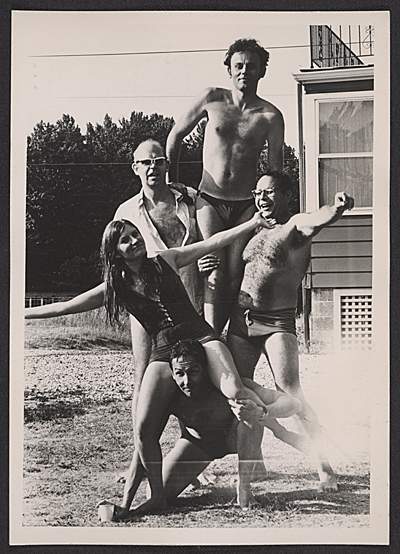 Patty Mucha, Claes Oldenburg, Lucas Samaras, George Segal, and Rauschenberg at Robert Scull's East Hampton residence, ca. 1968. Photo: unidentified. Robert Scull papers. Archives of American Art, Smithsonian Institution
Patty Mucha, Claes Oldenburg, Lucas Samaras, George Segal, and Rauschenberg at Robert Scull's East Hampton residence, ca. 1968. Photo: unidentified. Robert Scull papers. Archives of American Art, Smithsonian Institution
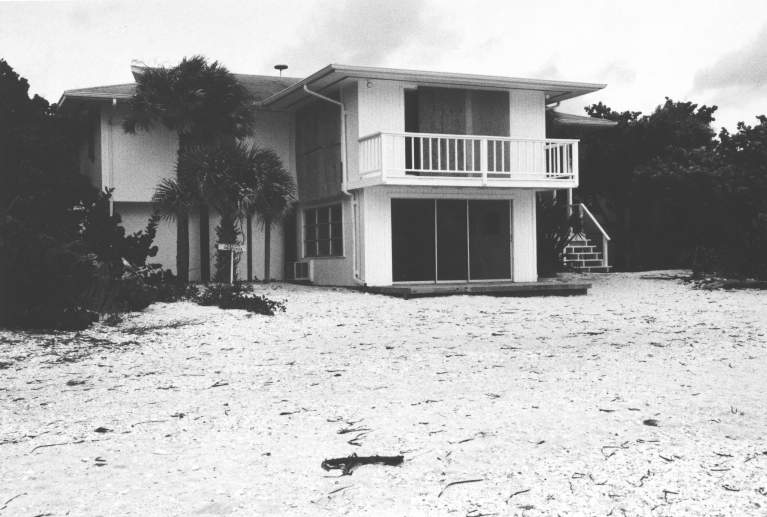 Rauschenberg’s beach house, Captiva, Florida, ca. 1971. Photo: Robert Petersen
Rauschenberg’s beach house, Captiva, Florida, ca. 1971. Photo: Robert Petersen
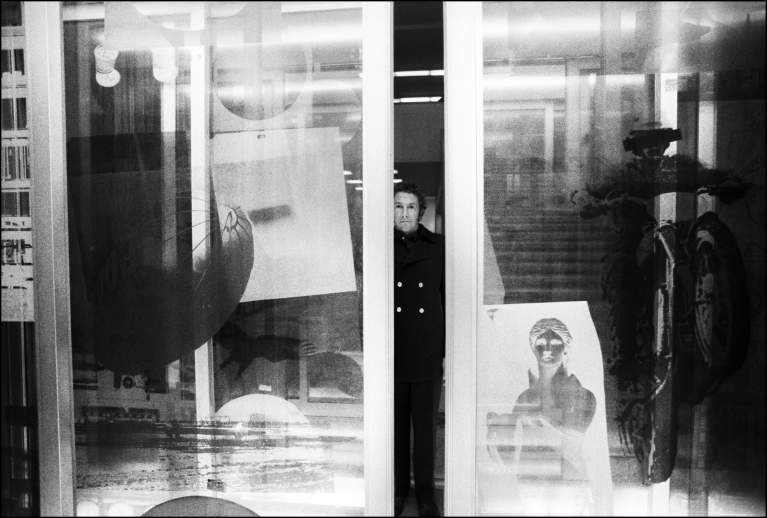 Rauschenberg with Solstice (1968) at Robert Rauschenberg: Oeuvres de 1949 à 1968, Musée d’Art Moderne de la Ville de Paris, summer 1968. Photo: Ugo Mulas © Ugo Mulas Heirs. All rights reserved
Rauschenberg with Solstice (1968) at Robert Rauschenberg: Oeuvres de 1949 à 1968, Musée d’Art Moderne de la Ville de Paris, summer 1968. Photo: Ugo Mulas © Ugo Mulas Heirs. All rights reserved
1969
Andrew Forge’s monograph Rauschenberg is published. The volume includes the artist’s autobiographical statement written for Autobiography (1968). Rauschenberg designs a unique layout in which his own black-and-white photographs, published for the first time, are overlaid with the printed text, making reading difficult.1 In a review, Timothy Hilton describes the enormous effort required to read the text as “something much more than book design, and can be thought of as a characteristically Rauschenbergian move. For it is in just such enlargements of our normal apperceptions that we realize a part of the power of his painting.”2
Winter: Makes Carnal Clock series, a group of unique timepieces consisting of metal boxes, each measuring 5 feet by 5 feet, with a mirrored Plexiglas face. In place of numerals, the face is a composed of silkscreened photographs by Rauschenberg, including genitals, animals, and other images characteristic of the artist. A timing mechanism and electrical lights illuminate the hours and minutes. At noon and midnight, the clocks are fully lit. In April and May the Carnal Clocks are exhibited at Ace Gallery, Venice, California, and Leo Castelli, New York.
January 5–February 2: Robert Rauschenberg: Selections, Fort Worth Art Center Museum, Texas. The exhibition presents a survey of his career, including White Paintings (1951), black paintings (1951–53), Red Paintings (1953–54), Combine paintings and Combines (1954–64), silkscreen paintings (1962–64), a Revolver (1967), and Solstice (1968).
January 10: Proclaimed an Honorary Citizen of Lafayette, Louisiana.
Spring: Commissioned to create a poster commemorating one-hundredth anniversary of the Metropolitan Museum of Art, New York, Rauschenberg composes a handwritten proclamation on graph paper that incorporates images from the museum’s collections, and is signed by museum officials. The text reads: “Treasury of the conscience of man. Masterworks collected, protected and celebrated commonly. Timeless in concept the museum amasses to concertize a moment of pride serving to defend the dreams and ideals apolitically of mankind aware and responsive to the changes, needs and complexities of current life while keeping history and love alive.” Rauschenberg passes the print through the press twice after reviewing the first proof and finding it lacking. The original lithograph is printed by Universal Limited Art Editions (ULAE), West Islip, New York, in an edition of forty-five in 1969; the poster is published by Telamon Editions Limited, a branch of ULAE, in 1970.
April: Rauschenberg had worked with Klüver on the text and design of the logo, masthead, and subtitle for TECHNE, a newspaper of Experiments in Art and Technology (E.A.T.) to replace E.A.T. News. Although intended for a broader audience, only two issues were published and a third was unpublished. Rauschenberg suggested the subtitle: A Projects and Process Paper.3
July 9–September 3: Participates in Pop Art, Hayward Gallery, London, an exhibition organized by John Russell and Suzi Gablik. Exhibits Pail for Ganymede (1959), Winter Pool (1959), and Art Box (1962–63). Exhibition catalogue (Pop Art Redefined) reproduces Rauschenberg’s “Note on Painting” (1963).
July 16: At the invitation of the NASA Art Program, witnesses launching of Apollo 11, the space mission that accomplishes the first landing of humankind on the moon, from Cape Kennedy, Florida. Rauschenberg has always admired the space program for being one of the few technological projects not involved in war and destruction.
August: With some of the same photographs used in Carnal Clocks (1969), Rauschenberg makes lithographs Tides, Drifts, and Gulf (all 1969) using lithography stones coated with photosensitive emulsion on which photographic negatives are exposed—an early-twentieth-century experimental German technique further developed in collaboration with Zigmunds Priede at ULAE. The titles evolve from Rauschenberg’s observation of the effect of the printed photographs, which resemble reflections in water. The stones for Unit (Buffalo), Unit (Turtle), and Unit (Hydrant) (all 1970) are also made, each from one stone used in the previous works, but they will not be released until 1970.
August 1969–July 1970: Inspired by the launching of Apollo 11, Rauschenberg creates the Stoned Moon series at Gemini G.E.L., Los Angeles (the first works are printed in September 1969 and the last in July 1970). The series of thirty-four lithographs employs photosensitized lithography stones to capture images supplied by NASA, as well as drawings made directly on the stones with water-based tusche and crayon. Waves (Stoned Moon) and Sky Garden (Stoned Moon) (both 1969) are the largest prints made thus far on a hand-operated lithographic press. In December, Banner (Stoned Moon) (1969) is the cover image of Studio International, which also includes a two-page “collage comment” by Rauschenberg on the making of the print series.4 In 1970, the artist will make drawings for Stoned Moon Book, a publication that is not realized. The pages are collages of archival and original photographs, media images, transfer drawings, and typescript excerpts and fragments from an epistolary exchange between Rauschenberg and Henry Hopkins, director of the Fort Worth Art Center.
September 21: Meets with John Stoller and Felice Wender of Dayton’s Gallery 12, Minneapolis, to discuss the creation of a work for a 51-foot-long wall in the gallery. Consequently, he will begin to develop the concept for the Currents project (1970).
October 25: Fire occurs in Rauschenberg’s Lafayette Street studio, New York. Very few works are damaged.
November 19–20: Apollo 12, the second lunar-landing mission, leaves behind on the moon an untitled drawing by Rauschenberg, along with drawings by John Chamberlain, Forrest Myers, David Novros, Claes Oldenburg, and Andy Warhol. Engineer Fred Waldhauer reduces and etches versions of the works onto a tiny ceramic wafer that was attached to the leg of the Intrepid, the lunar module that explores the moon’s surface. This comes to be known as the “Moon Museum.”5
December 10, 1969–January 18, 1970: Rauschenberg in Black and White: Paintings 1962–63, Lithographs 1962–67, Newport Harbor Art Museum, Newport Beach, California. Exhibits fourteen black-and-white silkscreen paintings and nineteen lithographs. The exhibition will travel to Phoenix Art Museum and Seattle Art Museum.
- 1. In 1972, Abrams will publish an offprint of the text in the Meridian Modern Artists series for easier accessibility.
- 2. Timothy Hilton, “Heroic Monograph,” Studio International (London) 180, no. 927 (Nov. 1970), p. 207.
- 3. TECHNE: A Projects and Process Paper (New York) 1, no. 1 (April 14, 1969) and 1, no. 2 (Nov. 6, 1970).
- 4. “Robert Rauschenberg: Notes on Stoned Moon Lithographic Project (Oct. 28, 1969).” Studio International (London) 178, no. 917 (Dec. 1969), cover and pp. 246–47.
- 5. Helen Hsu, “Chronology,” in Susan Davidson, ed. John Chamberlain: Choices (New York: Solomon R. Guggenheim Museum, 2012), p. 206. See also Grace Glueck, “New York Sculptor Says Intrepid Put Art on Moon,” New York Times, Nov. 22, 1969, p. 19.

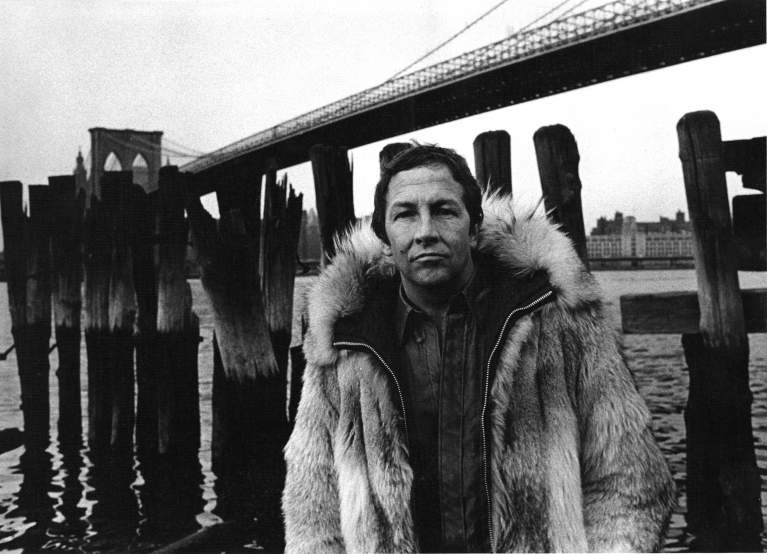 Rauschenberg near the Brooklyn Bridge, New York, 1969. Photo: Gianfranco Gorgoni
Rauschenberg near the Brooklyn Bridge, New York, 1969. Photo: Gianfranco Gorgoni
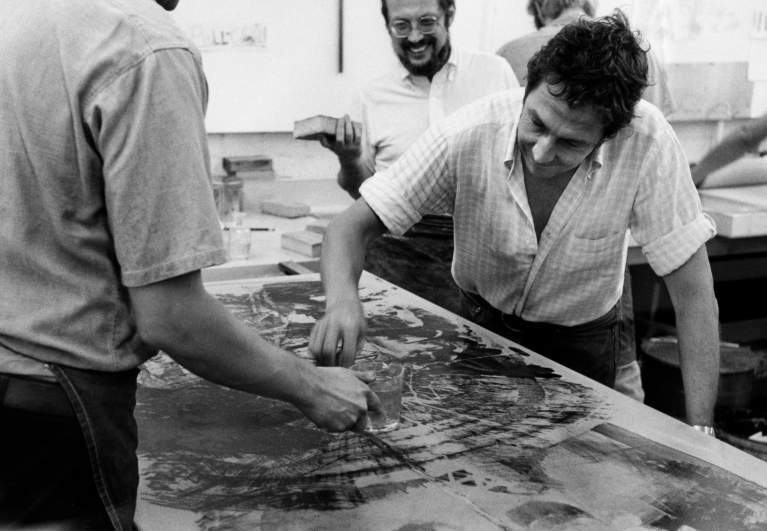 Rauschenberg and Stanley Grinstein working on the prototype for Waves (Stoned Moon), Gemini G.E.L., Los Angeles, 1969. Photo: Sidney B. Felsen © 1969
Rauschenberg and Stanley Grinstein working on the prototype for Waves (Stoned Moon), Gemini G.E.L., Los Angeles, 1969. Photo: Sidney B. Felsen © 1969

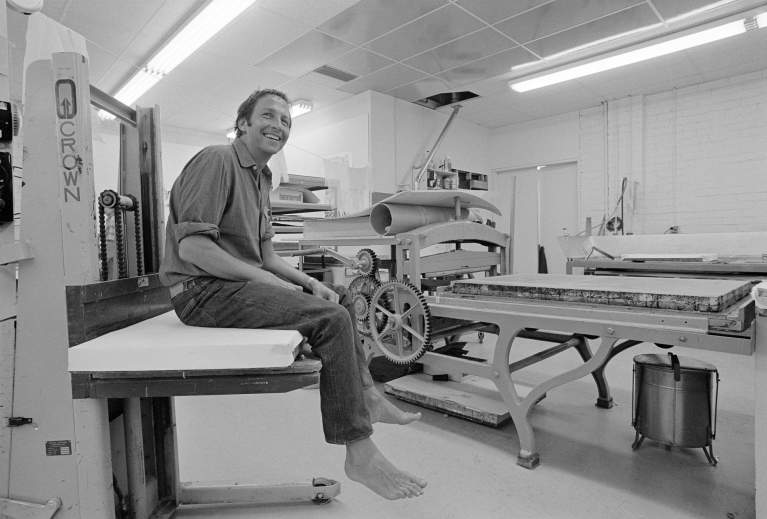 Rauschenberg in the print workshop at Gemini G.E.L., Los Angeles, during the making of Stoned Moon series (1969). © Malcolm Lubliner/CORBIS
Rauschenberg in the print workshop at Gemini G.E.L., Los Angeles, during the making of Stoned Moon series (1969). © Malcolm Lubliner/CORBIS
1970-79
1970
Creates Syn-Tex series, a drawing and collage series that includes both solvent transfer imagery and cut-and-pasted newsprint, printed reproductions, and photographs on paper.
Dancer/choreographer Trisha Brown founds Trisha Brown Dance Company.
Late January: Rauschenberg begins work on Currents in Malibu, California, with the assistance of Robert Petersen, a printer at Gemini G.E.L., Los Angeles. The project will mark the beginning of Rauschenberg’s increased focus on political and social activism. Contemporary photojournalism, headlines, and texts from the New York Times, New York Daily News, Los Angeles Times, Los Angeles Herald Examiner, San Francisco Examiner, Chicago Tribune, Minneapolis Star, and Minneapolis Tribune will serve as source material for thirty-six collages entitled Study for Currents #1–36 (1970). Silkscreens are prepared from these original newspaper collages. Rauschenberg will work with printer Adolph Rischner at Styria Studio, Glendale, California, to create the screenprint Currents (1970), 54 feet long (on paper measuring 6-by-60 feet), the largest known printed work at the time. Completing the edition of six impressions, incorporating all thirty-six screens on a single sheet, will consume almost 300 hours. Rauschenberg described the impetus for the series as “an active protest attempting to share + communicate my response to + concern with our grave times + place. Art can encourage individual conscience.”1 Styria Studio will also issue two related series of smaller, square screenprints: Surface Series 37–54 (from Currents) (all 1970), eighteen prints published in an edition of one hundred, and Features (from Currents) 55–80 (all 1970), twenty-six prints published in an edition of fifty, all based on Study for Currents.
February 1: Automation House advertising supplement with cover designed by Rauschenberg is distributed in the New York Times.
February 18: Alan Solomon, an active supporter of Rauschenberg’s work since 1959, dies.
April 1–May 10: Rauschenberg: Graphic Art, the first significant exhibition of Rauschenberg’s prints, Institute of Contemporary Art, University of Pennsylvania, Philadelphia. The exhibition will travel to Art Gallery, State University of New York, Albany; Marion Koogler McNay Art Institute, San Antonio; and Museum of Contemporary Art, Chicago.
April 4–May 2: Exhibits Currents and selections from the related Studies for Currents, Surface Series (from Currents), and Features (from Currents) (all 1970), Dayton’s Gallery 12, Minneapolis. The exhibition is accompanied by a recorded soundtrack of excerpts from various news reports. Rauschenberg created the exhibition poster, published in an edition of 300 (one hundred are signed), from fragments of the Minneapolis Tribune and other newspapers. Currents and selections from the related series will be exhibited at Automation House and Castelli Graphics, New York; and Pasadena Art Museum, California.
April 22: First annual Earth Day, for which Rauschenberg creates the poster Earth Day (1970), published in an edition of 300 signed and 10,000 unsigned copies by Castelli Graphics, New York, to benefit the American Environment Foundation, Washington, D.C. The work consists of images of cleared forests, land devastated by strip mining, factories emitting black smoke, junkyards, and living creatures, including the endangered bald eagle and gorilla. Gemini G.E.L., Los Angeles, will publish a lithograph based on the poster design in an edition of fifty.
May 25: Presents Dance Magazine Award to Carolyn Brown, New York.
June: Joins a group of artists who withdraw their artworks from the U.S. Pavilion, 35th Venice Biennale, in protest of U.S. military action in Vietnam. The Emergency Cultural Government of the New York Art Strike, which represents the artists, states in a telegram to the Biennale’s organizing committee that the artists “are denying the use of their art as a cultural veneer to cover policies of ruthless aggression abroad and intolerable repression at home.”67 The retracted works will be exhibited at Museum, a cooperative gallery on lower Broadway, New York, in July.
June 4–26: Exhibits Signs (1970), Castelli Graphics, New York. Signs is a screenprint, printed at Styria Studio, New York, and published in an edition of 250 by Castelli Graphics. The original collage—incorporating images of Janis Joplin, John F. Kennedy, Robert F. Kennedy, American soldiers in Vietnam, an astronaut in space, demonstration scenes, and Martin Luther King, Jr. lying in his casket—was initially designed as a cover for Newsweek but not used. Rauschenberg writes that it was “conceived to remind us of love, terror, violence of the last 10 years. Danger lies in forgetting.”68
July 9–August 30: Solo exhibition of prints, including Booster and 7 Studies (all 1967), Stoned Moon series (1969–70), and Currents (1970), New York Cultural Center.
July 13: Collaborates with Dan Freeman, Laddie John Dill, and Robert Petersen (all printers or former printers at Gemini G.E.L., Los Angeles) in The Light Show, an event held on a hilltop in Baldwin Hills, a Los Angeles suburb.
August 6–September 27: Robert Rauschenberg: Prints 1948/1970, a comprehensive retrospective exhibition devoted to Rauschenberg’s prints, Minneapolis Institute of Arts. The exhibition catalogue provides an extensively annotated summary of the artist’s prints to date.
September: Establishes the nonprofit organization Change, Inc. that provides small sums of money to artists for such nonart emergency expenses as rent and medical costs. The organization is supported by contributions of art for benefit auctions. From this point on, Rauschenberg will donate to Change, Inc. proceeds from the sale of one print in each new edition and later his reproduction royalties as well.
September 20–26: Participates in Art for Peace, an exhibition held at thirty-two New York galleries and twelve additional out-of-town galleries, culminating in a Sotheby Parke Bernet auction on September 29, the proceeds of which go to Referendum 70, a group that supports antiwar Congressional candidates.
[Fall]: The Peace Portfolio, for which twelve artists contribute original prints, is printed by Jerry Solomon in an edition of 175. The project is coordinated by Percy Goodman, a peace activist. Using Rauschenberg’s submission of an untitled collage painting made predominantly of newspaper clippings, Styria Studio, New York, prints an offset lithograph. Proceeds from the sale of works in the portfolio, exhibited at Martin Gordon Gallery, New York, benefit the Academic and Professional Committee for a Responsible Congress.
November: Arts Magazine cover designed by Rauschenberg.
Late fall: Establishes permanent residence and studio in Captiva, Florida. Though he maintains his studio on Lafayette Street, New York, he will spend most of his time living and working in Captiva. Over the years, Rauschenberg buys adjacent properties and structures in order to preserve the land from development, often allowing previous owners the use of the property for their lifetimes. The so-called “Print Shop” will be purchased in October 1971 and will be used for his in-house printing establishment, Untitled Press, Inc. Another structure, the “Fish House,” built by cartoonist and conservationist J. N. “Ding” Darling in 1942, is acquired by Rauschenberg in December 1978.
December 1970: At his new studio in Captiva, begins the Cardboard series (1971–72), wall sculptures made from found cardboard, and the Cardbird series (1971), print facsimiles of cardboard prototypes that are published in an edition of seventy-five by Gemini G.E.L., Los Angeles.
- 1. Rauschenberg, Currents, exh. brochure (New York: Castelli Graphics and Automation House, 1970), unpaginated.
- 67. Quoted in Grace Glueck, “Artists to Withdraw Work at Biennale,” New York Times, June 6, 1970, sec. 1, p. 27.
- 68. Rauschenberg, exh. announcement (New York: Castelli Graphics and Automation House, 1970).

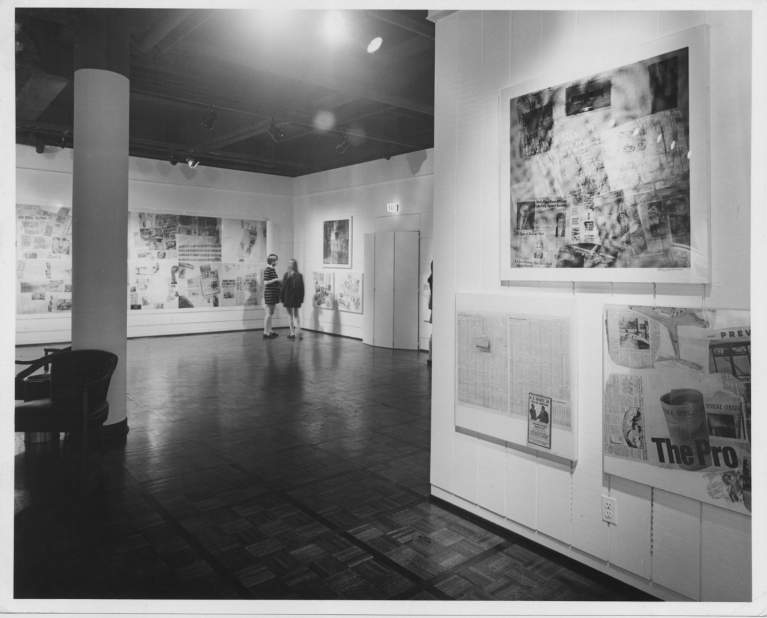 Installation view, Rauschenberg Currents, Dayton’s Gallery 12, Minneapolis, 1970
Installation view, Rauschenberg Currents, Dayton’s Gallery 12, Minneapolis, 1970
1971
Creates Star Quarters (1971), a limited-edition work, of which there are forty-five sets of four units. Commissioned by Fortune, the print is made at Styria Studio, New York. Deriving its subject matter from astronomy, the images are silkscreened on mirror-coated, Plexiglas surfaces that integrate the reflection of the viewer. The suite is published by Mutiples Inc., in cooperation with Castelli Graphics.
January: Exhibits Currents (1970) at Galerie Ileana Sonnabend, Paris.
January 12–February: Participates in Duchamp, Johns, Rauschenberg, Cage, Contemporary Arts Center, Cincinnati, an exhibition exploring the influence of Duchamp on the other three artists. Exhibits Shades (1964) and three Revolvers (all 1967).
Spring: With the assistance of Robert Petersen, establishes Untitled Press, Inc., Captiva, Florida. Rauschenberg’s neighbor, artist Maybelle Stamper, contributes proofing stones and an old Fuchs and Lang proofing press that Petersen, Rauschenberg, and assistant Hisachika Takahashi restore. Gemini G.E.L., Los Angeles, contributes lithography stones. The press’s name is taken on Ileana and Michael Sonnabend’s recommendation that the word “untitled” is widely understood in Europe, where it is commonly associated with contemporary art.1 The prints are distributed by Castelli Graphics, New York. Cy Twombly makes the first series of prints in April. Other visiting artists include Brice Marden (February–April 1972), David Bradshaw (January 1972–March 1973), Robert Whitman (fall 1973), and Susan Weil (February 1974). Eventually, the press room will serve less as a guest-artist workshop than as a studio for Rauschenberg.
May 11–August 29: Participates in Art and Technology, Los Angeles County Museum of Art. Exhibits Mud Muse (1968–71). The exhibition, organized by Maurice Tuchman, features collaborations between artists and engineers. Among the participating artists are Rauschenberg, Newton Harrison, Rockne Krebs, Roy Lichtenstein, Claes Oldenburg, Richard Serra, Tony Smith, Andy Warhol, and Whitman. On opening day, visitors unexpectedly seize the mud from Mud Muse and smear it on the museum’s walls.
June: Exhibits Cardboards, Dayton’s Gallery 12, Minneapolis.
October 16–November 6: Exhibits works from ongoing Cardboards series (1971–72), Leo Castelli, New York (closes November 2); and Cardbirds (1971), Castelli Graphics, New York.
October 22: Performs in Trisha Brown’s Rummage Sale and the Floor of the Forest, Trisha Brown Dance Company, New York University.
December 3–4: Benefit for Artists’ Television Project, sponsored by Experiments in Art and Technology (E.A.T.), New York, and the American Foundation on Automation and Employment, held at Automation House, New York. With a casino theme, the party features gambling with “Artcash” bills designed by Rauschenberg, Tom Gormley, Red Grooms, Marisol, Warhol, and Whitman and printed by a banknote company on genuine banknote paper.
Late fall: Poster for Peace (1971), designed in 1970, is published in an edition of 250, for the National Peace Action Coalition, New York. Viewers are invited to add newspaper clippings to designated areas of the poster.
[Late fall]: At Styria Studio, New York, creates Opal Gospel (1971), published by Racolin Press, Briarcliff Manor, New York, in an edition of 230 artist’s proofs. Rauschenberg’s second artist’s book, it is similar to Shades (1964). For the project, nine traditional Native American poems from six nations (Apache, Chippewa, Iglulik, Navajo, Nootka, and Pawnee) and Rauschenberg’s images of animals and nature are silkscreened in iridescent inks on ten Plexiglas sheets mounted upright in any order in a slotted Lucite base and stainless-steel case.
- 1. Jack Cowart and James Elliott, Prints from the Untitled Press, Captiva, Florida, exh. cat. (Hartford, Conn.: Wadsworth Atheneum, 1973), p. 5.

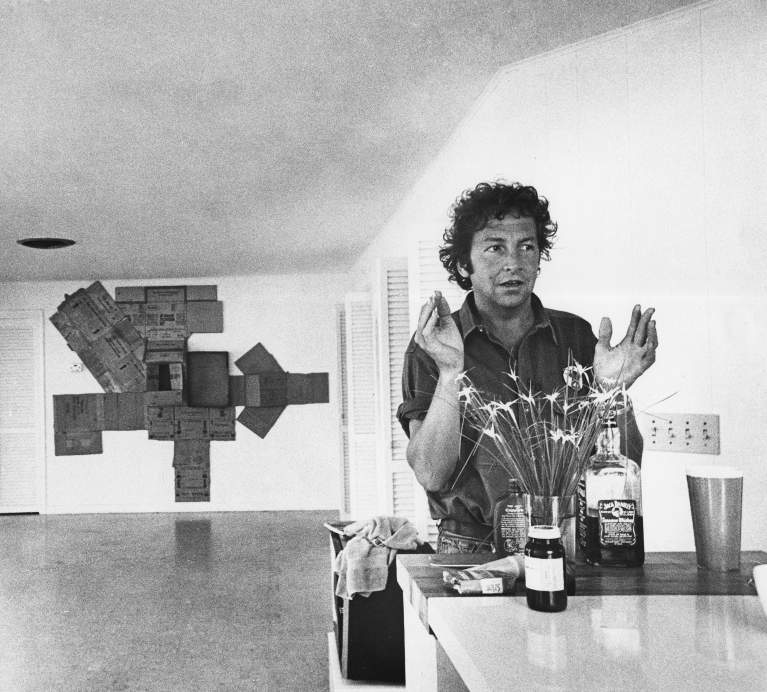 Rauschenberg in his beach house, Captiva, Florida, 1971. Work in background is Tropicana Channel (Cardboard) (1971). Photo: Hans Namuth
Rauschenberg in his beach house, Captiva, Florida, 1971. Work in background is Tropicana Channel (Cardboard) (1971). Photo: Hans Namuth

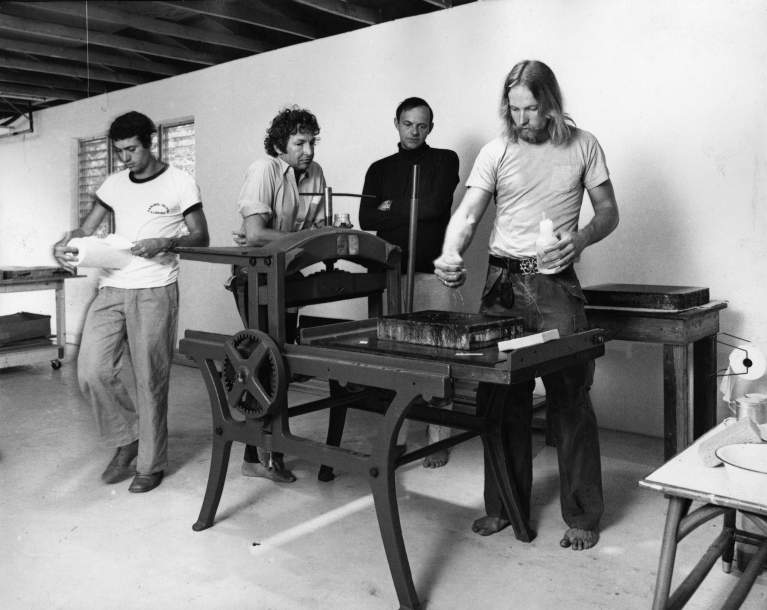 Nicola del Roscio, Rauschenberg, Cy Twombly, and Robert Petersen working in Rauschenberg’s print shop, Captiva, Florida, 1971. Photo: Hans Namuth
Nicola del Roscio, Rauschenberg, Cy Twombly, and Robert Petersen working in Rauschenberg’s print shop, Captiva, Florida, 1971. Photo: Hans Namuth
1972
First Landing Jump (1961) acquired by the Museum of Modern Art, New York, as a gift from Philip Johnson, who had purchased the work in 1964 at the encouragement of the museum’s director, Alfred H. Barr Jr.
Emile de Antonio’s film Painters Painting, which includes an interview with Rauschenberg, is released. The film is based on the exhibition New York Painting and Sculpture, 1940–1970, organized by Henry Geldzahler, Metropolitan Museum of Art, New York (October 18, 1969–February 8, 1970).
Introduced by U.S. Senator Jacob Javits (R-N.Y.) to Israeli Foreign Minister Abba Eban. Through Eban, Rauschenberg meets Prince Sadruddin Aga Khan of Egypt and becomes interested in creating a work, never realized, relating to the Arab-Israeli conflict.
January: Establishes working relationship with Graphicstudio, USF Institute for Research in Art, Tampa, which is under the direction of Donald Saff, who founded the studio in 1968 as a center for print research and collaboration with the university’s departments of chemistry, engineering, and architecture.
January–March: At Graphicstudio, working with Saff, makes Made in Tampa series (1972–73), twelve works published in editions of forty, incorporating lithography, blueprint, and sepia print, as well as elements of collage. Makes Tampa Clay Piece series(1972–73), five clay works published in an edition of twenty, at the suggestion of Graphicstudio sculptor Alan Eaker, who proposed that Rauschenberg turn cardboard boxes into ceramic pieces, just as he had previously created Cardbirds (1971) from cardboard prototypes. For the Tampa Clay Pieces, the printers mix garden soil with the clay, then apply oil from their own faces to the fired surface to replicate the color and texture of cardboard.
April 25: Receives Skowhegan Medal for Graphics, Skowhegan School of Painting and Sculpture, Maine, at the Plaza Hotel, New York. Jasper Johns receives the Medal for Painting and Claes Oldenburg the Medal for Sculpture.
May: Exhibits Cardboards, Galerie Ileana Sonnabend, Paris.
Under the sponsorship of Universal Limited Art Editions (ULAE), West Islip, New York, begins collaboration with novelist, philosopher, and screenwriter Alain Robbe-Grillet on a book, Traces suspectes en surface (1978), published in an edition of thirty-six. Tatyana Grosman, aware of Rauschenberg’s interest in working on a handmade book, pairs the artist and the author after hearing Robbe-Grillet express admiration for Rauschenberg in a lecture at New York University in April. Robbe-Grillet and Rauschenberg agree that Rauschenberg will loosely respond to the text of the novel, which deals with romance and murder, rather than diligently illustrate it. Robbe-Grillet will send Rauschenberg the first three pages of text inscribed on aluminum plates in the fall of 1972. Rauschenberg will respond with three pages of lithographs made using a solvent-transfer technique with images of everyday life from European publications to complement the text and suggest new ideas to Robbe-Grillet. By 1974, after about twelve exchanges, all of the text and images will be completed. Printing will begin in 1976. The book will be published in 1978. Rauschenberg will create a simple red clothbound box for the prints.
Late June: Begins Venetian series, the majority of which is made in 1973. These sculptural works, inspired by his many visits to Venice, are made of nontraditional art materials, including branches, tire treads, and glass jars, with an emphasis on the natural shapes of the found objects.
September 18: Travels to California and while there begins work on Horsefeathers Thirteen (1972–73) published by Gemini G.E.L., Los Angeles. The series consists of lithographs with collage and embossing, each print containing both fixed and variable images.
October 27: Party held in honor of Princess Christina of Sweden, Rauschenberg’s Lafayette Street studio, New York, raises funds for the New York Collection for Stockholm, a collection of works by American artists selected by Pontus Hultén and organized by Experiments in Art and Technology (E.A.T.), New York, between 1971 and 1973, for donation to Moderna Museet, Stockholm. Three hundred people attend the event. At Rauschenberg’s request, Teledyne, Los Angeles, will donate Mud Muse (1968–71) to the collection. A preview of the artworks is presented at Leo Castelli, Sonnabend, and John Weber Galleries, 420 West Broadway, New York (October 27–28). Rauschenberg, however, does not exhibit Mud Muse and instead shows Volon (Cardboard) (1971).
December 2–24: Exhibits Tampa Clay Pieces (1972–73), Leo Castelli, New York, and Made in Tampa (1972–73), Castelli Graphics, New York.

 Rauschenberg and Tatyana Grosman, 1972
Rauschenberg and Tatyana Grosman, 1972
1973
Appears in the film American Art in the Sixties, written and narrated by Barbara Rose and produced by Michael Blackwood Productions.
Modeled on the Cardbird series (1971), Rauschenberg makes bronze versions of two of the earlier sculptural prints. These works are sand-cast and painted by hand, produced by Gemini G.E.L., Los Angeles.
Makes Crops, an editioned series where the artist combines the solvent transfer process with screenprinting, creating variations between the prints within each edition, published by Graphicstudio, USF Institute for Research in Art, Tampa. The series title is derived not only from the plant life that the individual prints are named for, but also for the process of “cropping” an image in preparation for publication.
Makes Support (1973), a silkscreened poster published in an edition of 250, for the Pan American Development Foundation to aid victims of the Managua earthquake in 1972.
January 7–26: Robert Rauschenberg: Prints, Mitchell Gallery, Southern Illinois University, Carbondale.
March 31–April 21: Venetians (1972–73) on view at Leo Castelli, New York.
April 10–May 15: White Paintings, 1951, shown at Ace Gallery, Venice, California. The exhibition will travel to Ace Gallery, Vancouver.
June: Awarded an Honorary Grand Prize for Tampa (1972), 10th Biennial of Graphic Art, Ljubljana, Yugoslavia. The “jubilee” exhibition includes a retrospective of winners of the previous nine biennials; Rauschenberg was the Grand Prize winner in 1963.
June 17–22: Participates in the International Design Conference, Aspen, with his work Performance. Rauschenberg supplied the following information for the conference brochure. Proposal: “To work.” Anticipation: “Nothing.” Comments: “Isn’t that enough or is that too much?”1 On June 18 Rauschenberg begins a site-specific installation with volunteers around the light pole of the conference parking lot. The initial size of the installation was estimated to be 50 feet, growing in size over the course of the next three days and ending on June 21. The resulting artwork was destroyed after the conference, however, notes and photographs from the installation are included in the artist’s Untitled (original collage for print in Man Ray Portfolio) (1973) and Untitled (for Man Ray Portfolio) (1973). Rauschenberg leads the unrehearsed performance Beer Bottle Band (June 19) on the stage in the main conference tent with approximately fifty volunteers. Rauschenberg describes the performance as an attempt to do things with a group without “aesthetic binds,” seeking to make “fantastic sound” from a simple bottle.2 During the conference Rauschenberg also leads a group of participants (approximately six to eight couples) into the woods near his installation. The participants are asked to take two rocks and bang them together while walking away from the group. They are to keep walking until they can no longer hear anyone else’s rocks beating against each other and then come back.3
August: Makes Pages and Fuses over a four-day period at Moulin à Papier Richard de Bas, a producer of high-quality handmade paper since the fourteenth century, in Ambert, France, under the auspices of Gemini G.E.L., Los Angeles, and in collaboration with Marius Peraudeau, the mill’s director. For the five Pages, Rauschenberg shapes plain paper pulp, adding elements used to make the paper itself, such as rags and twine. For the seven Fuses, he designs molds, constructed by a local tinsmith, into which he pours colored-paper pulp and incorporates images that he had previously silkscreened onto Japanese rice paper. The editions, published in 1974 (the editions of Pages range from eleven to thirty-five; the editions of Fuses range from fourteen to thirty-four), are the first of Rauschenberg’s collaborations with artisans abroad, an activity he will fully develop throughout the Rauschenberg Overseas Culture Interchange (ROCI) project of 1984–91.
[Summer]: Rauschenberg creates Egyptian Series (1973), works on paper with flattened paper bags, gouache, and pencil. He also begins the Early Egyptian series (1973–74) of primarily sculptural works made from cardboard boxes coated with glue, rolled in sand, or wrapped in gauze. Often painted with Day-Glo colors, the luminescence of the paint reflects on the wall adjacent to the work.
Late summer: Creates poster and limited edition of one hundred signed silkscreened prints with vinyl collage entitled Haze (1973) to support the reelection campaign of Representative John Brademas (D-Ind.), a strong supporter, along with Senator Jacob Javits (R-N.Y.), of artists’ rights and tax-reform legislation for artists.
September 29–October 13: Castelli Graphics, New York, exhibits New York Collection for Stockholm Portfolio. Rauschenberg participates in the concept and design of the print portfolio to raise money for the New York Collection for Stockholm, a group of works that will be gifted to the Moderna Museet, Stockholm. He contributes a lithograph based on his Sketch for Mongram (1959). Among thirty contributing artists to the portfolio are Lee Bontecou, Robert Breer, John Chamberlain, Walter De Maria, Öyvind Fahlström, and Dan Flavin.
October 18: Auction of postwar and contemporary paintings and sculpture from the collection of Robert C. Scull, Sotheby Parke Bernet, New York. Rauschenberg’s Combines Thaw (1958) and Double Feature (1959), for which Scull had originally paid $900 and $2,500 respectively, were sold at auction for record prices, $85,000 and $90,000. Rauschenberg is quoted in the New York Post as telling Scull: “I worked my ass off just for you to make a profit.”4 The experience heightens Rauschenberg’s concern over profits made by collectors through the resale of their artworks and from which artists do not benefit. It is an impetus for him to campaign for new legislation that would assure artists and their heirs a share in these profits.
October 27–December 9: Participates in New York Collection for Stockholm, Moderna Museet, Stockholm. Rauschenberg designed the exhibition poster.
- 1. Brochure, International Design Conference, Aspen, 1973, unpaginated.
- 2. From audio recording, transferred to DVD, June 19, 1973. International Design Conference in Aspen papers, Richard J. Daley Library Special Collections and University Archives, University of Illinois, Chicago.
- 3. Telephone conversations between Gina Guy and Robert Petersen, Oct. 22, 2013 and April 1, 2014.
- 4. Roberta B. Gratz, “Artist’s a Study in Blue at Scull’s SRO Auction,” New York Post, Oct. 19, 1973, p. 3.

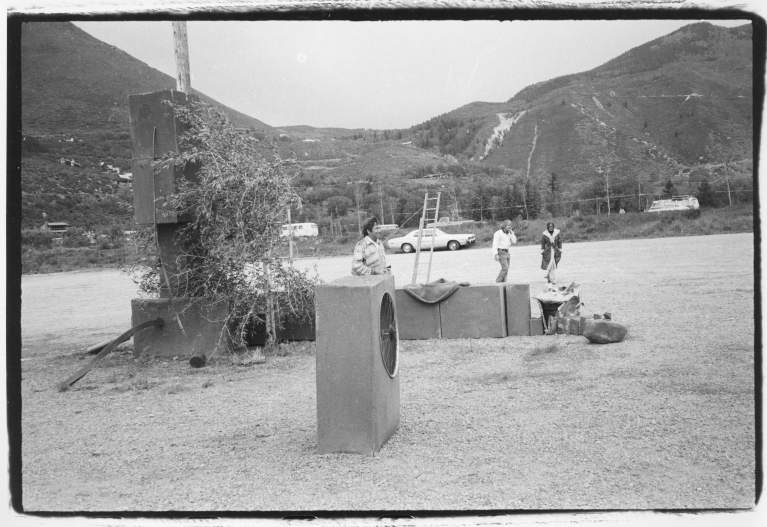 Rauschenberg and volunteers working on environmental construction for the International Design Conference, Aspen, Colorado, June 1973. Photo: Barbara Kulicke
Rauschenberg and volunteers working on environmental construction for the International Design Conference, Aspen, Colorado, June 1973. Photo: Barbara Kulicke

 Rauschenberg with an unidentified studio assistant adhering sand to Early Egyptian series (1973–74) on the beach in Captiva, Florida, ca. 1973. Photo: Gianfranco Gorgoni
Rauschenberg with an unidentified studio assistant adhering sand to Early Egyptian series (1973–74) on the beach in Captiva, Florida, ca. 1973. Photo: Gianfranco Gorgoni
1974
Creates an original print, Cunningham Relief (1974), for a portfolio of seven prints devoted to Merce Cunningham Dance Company collaborations. The other contributing artists are John Cage, Jasper Johns, Robert Morris, Bruce Nauman, Frank Stella, and Andy Warhol, with text by Calvin Tomkins. Multiples, Inc., New York, and Castelli Graphics, New York, will publish one hundred portfolios and thirty artist’s proofs in 1975. Rauschenberg’s print, on embossed paper, is a variation of a poster he made for a performance by the Merce Cunningham Dance Company at the Brooklyn Academy of Music, New York, in January 1969.
Makes Pyramid Series, works created from fabric sandwiched between two pieces of blank white paper.1
Creates Tablet Series, featuring collages of cardboard and tape sandwiched between paper; occasionally small portions protrude past the paper’s edge.
January 11–February 15: Exhibition Rauschenberg at Graphicstudio, Library Gallery, University of South Florida, Tampa.
May: Travels to Israel to prepare for an upcoming exhibition at the Israel Museum, Jerusalem. Invited as guest artist by the museum, lives in the Jerusalem Foundation’s Mishkenot Sha’ananim, a residence for artists and scholars. Spends three weeks gathering materials—such as sand from various sites in Israel, local newspapers, and found objects—creating Made in Israel, a series of sculptures that relates to the Early Egyptian works (1973–74). In tribute to the Dead Sea Scrolls and Israel’s religious heritage, the artist creates Scripture, a suite of drawings incorporating paper bags, cardboard, and gauze. All artworks are made inside the museum, and several are donated to the museum. Rauschenberg documents the projects in a book of photographs that he designs, Robert Rauschenberg in Israel (1975).
May 29–Aug. 3: Robert Rauschenberg in Israel, Israel Museum, Jerusalem. Exhibits Made in Israel sculptures and Scripture drawings. Although some Israelis are offended at his use of “trash,” Rauschenberg explains that he has always sought “to confront people with something that might remind them of their own lives. In some way, they might look at it differently.”2 Later, in December 1975, Rauschenberg receives a letter of blessings and greetings from Jerusalem’s Mayor.
Summer: Following his return from Israel, Rauschenberg creates Airport Suite, a series of relief and intaglio prints on fabric with collage elements published by Graphicstudio, USF Institute for Research in Art, Tampa. The proofing, editing, sewing, and application is conducted at the artist’s studio in Captiva, Florida, while supplies, including an etching press, are shipped from Graphicstudio in Tampa, making it the only Graphicstudio project to be executed entirely offsite.
Fall: Begins Hoarfrost series, on which he will work through 1976. The series uses solvent to transfer images onto unstretched fabric and develops when Rauschenberg notices that the cheesecloth used in print workshops to clean lithography stones retains traces of ink when it was hung up to dry. The series is also inspired by James Rosenquist’s birthday gift to Rauschenberg of a bolt of shimmering transparent silk that reminds Rauschenberg of “hoarfrost,” a word used in Dante’s Inferno. Makes a related series of nine prints, the Hoarfrost Editions that are published in editions from fifteen to thirty-three by Gemini G.E.L., Los Angeles, for which Rauschenberg selects a 1930s lingerie fabric that is recreated in Italy. Images are either transferred directly from newspapers and magazine photographs or from offset lithographs made from the same sources.
November 20–December 29: Participates in Poets of the Cities: New York and San Francisco, 1950–1965, Dallas Museum of Fine Arts. Exhibits Untitled [glossy black four-panel painting] (ca. 1951), Erased de Kooning Drawing (1953), Painting with Red Letter S (1957), Double Feature (1959), Pail for Ganymede (1959), Sketch for Monogram (1959), Octave (1960), Blue Eagle (1961), and Oracle (1962–65). The exhibition will travel to San Francisco Museum of Art and Wadsworth Atheneum, Hartford, Connecticut.
December 7–28: Exhibits Hoarfrosts, Leo Castelli, New York, and Sonnabend Gallery, New York; and Hoarfrost Editions, Castelli Graphics, New York (closed January 4, 1975).
- 1. See Robert S. Mattison, “Pyramid Series,” Rauschenberg Research Project (San Francisco Museum of Modern Art, July 2013). Accessed Sept. 15, 2014. http://www.sfmoma.org/explore/collection/artwork/25849.
- 2. Quoted in Mary Lynn Kotz, Rauschenberg: Art and Life (New York: Harry N. Abrams, 1990), p. 195. From unpublished transcript of meeting with Israeli students, Israel Museum, Jerusalem, May 29, 1974.

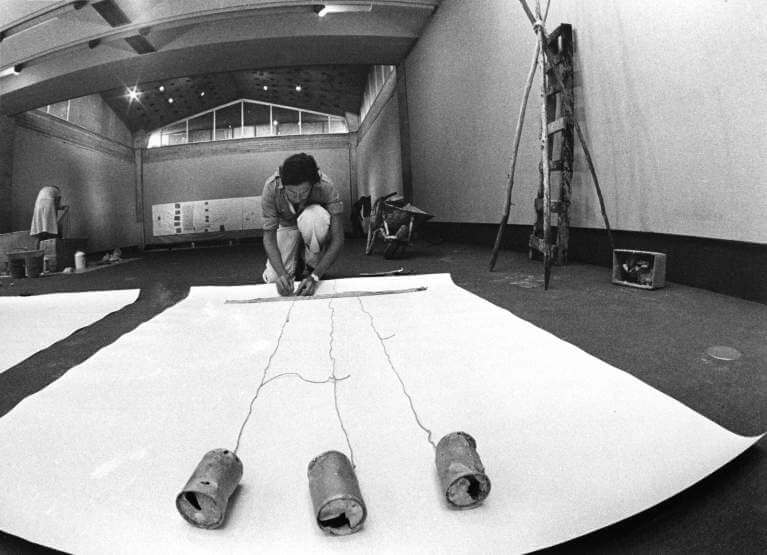 Rauschenberg working on Scripture (1974) for Rauschenberg in Israel exhibition at the Israel Museum, Jerusalem, 1974. Works in background are Scripture I and two untitled works (all 1974). Photo: Nir Bareket
Rauschenberg working on Scripture (1974) for Rauschenberg in Israel exhibition at the Israel Museum, Jerusalem, 1974. Works in background are Scripture I and two untitled works (all 1974). Photo: Nir Bareket


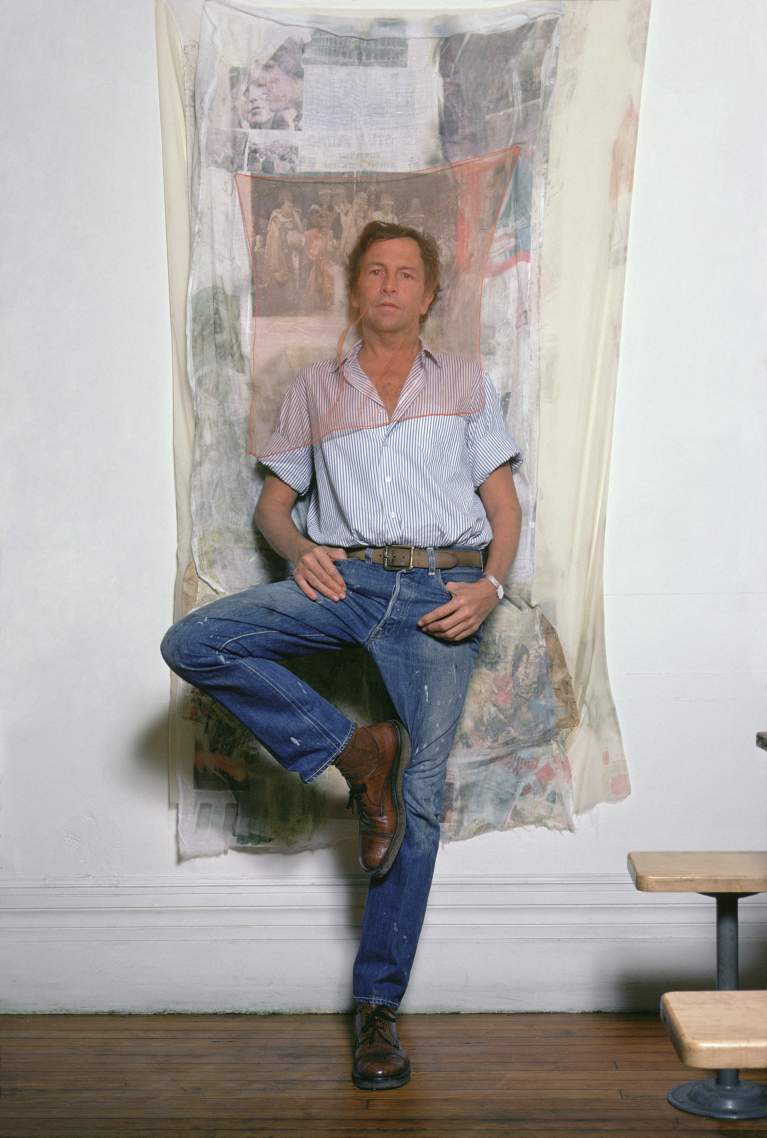 Rauschenberg in his Lafayette Street studio with Mint (Hoarfrost) (1974), New York, 1974. Photo: Art Kane
Rauschenberg in his Lafayette Street studio with Mint (Hoarfrost) (1974), New York, 1974. Photo: Art Kane
1975
Contributes a statement to Merce Cunningham, a selection of texts by artists, composers, dancers, and critics, edited and with introduction and photographs by James Klosty. Reflecting on historical accounting, Rauschenberg wrote, “Details are fickle and political and tend to destroy the total events.”1
February 15–March 27: Exhibits Hoarfrosts, Dayton’s Gallery 12, Minneapolis. The exhibition will travel to Galerie Ileana Sonnabend, Paris, and Galleria Alessandra Castelli, Milan.
May: Arrives in Ahmedabad, in the Indian state of Gujarat, home to a textile center founded by Mohandas K. Gandhi, who was of Gujarati descent. Rauschenberg works for a month at an ashram, creating the Bones and Unions series under the auspices of Gemini G.E.L., Los Angeles. As this capital city was a former center for handloom weaving, the ashram was founded by Gandhi to provide specialized training in papermaking and other handicrafts.2 Rauschenberg had been invited to work on a project of his choosing by a prominent Indian family, the Sarabhais, whom he had met during the 1964 Merce Cunningham Dance Company tour. It is the first collaborative effort for the mill, which primarily produces writing paper; later invitations will be offered to other American artists, including James Rosenquist, Keith Sonnier, and Frank Stella. Rauschenberg’s son Christopher, who accompanies his father to India, describes him as being “just amazed at the colors. A new sense of fabric came to him there.”3 The experience will influence later examples of the Hoarfrost series (1974–76), executed after his return from India, as well as the Jammer series (1975–76), in which colorful silks are used.
August 30–October 11: Exhibits Bones and Unions, Gemini G.E.L., Los Angeles. The exhibition will travel to Castelli Graphics, New York.
September 6–October 6: Robert Rauschenberg, Museo d’Arte Moderna Ca’ Pesaro, Venice. Exhibits selected works from the Cardboard (1971–72), Early Egyptian (1973–74), Scripture (1974), and Hoarfrost (1974–76) series.
Fall: Begins Jammer series, on which he will work through 1976. Largely devoid of imagery, these works are mostly made from colorful sewn silk, usually hung directly on the wall, often in conjunction with rattan poles or other everyday objects. The series title derives from “windjammer,” a type of sailboat; many of the individual works have nautical titles as well.
[December]: Makes Yule (Spread) (1975), the first of the Spread series, which he will work on in earnest the next year and continue through 1983. Rauschenberg cuts Yule into fifty-six irregular pieces to distribute as Christmas gifts to friends. The work will be reassembled for Rauschenberg’s 1976 retrospective exhibition at the National Collection of Fine Arts (now the Smithsonian American Art Museum), Smithsonian Institution, Washington, D.C. “Spreads,” a term used to describe a wide expanse of land, also refers to the large scale of these particular artworks. Paint and solvent transfer are applied to wood panels and often to fabric collage, while found objects, mirrored Plexiglas, and electric lights are commonly included.

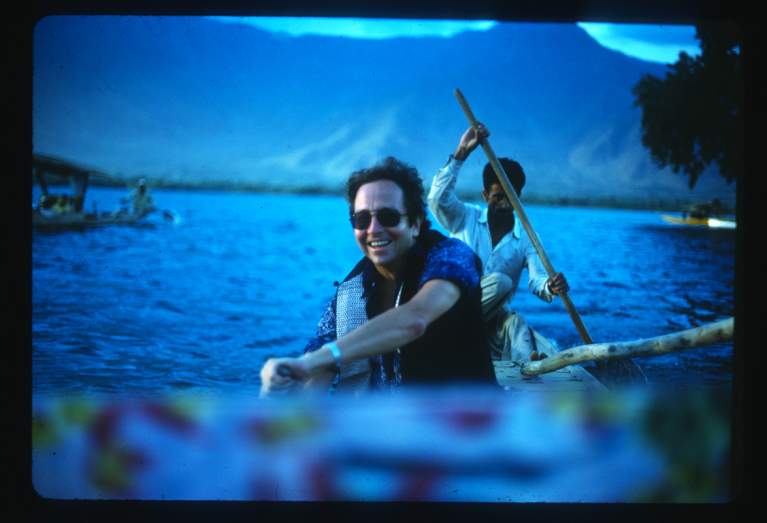 Rauschenberg in India, 1975. Photo: Hisachika Takahashi
Rauschenberg in India, 1975. Photo: Hisachika Takahashi
1976
Creates Tracks, a series of tire prints consisting of cast dirt with a resin binder, fiberglass, and a wet soil patina, published by Pyramid Arts, Ltd., Tampa.
January 25–April 11: Exhibits Rodeo Palace (Spread) (1976), commissioned by the Fort Worth Art Museum for The Great American Rodeo, an exhibition celebrating the American Bicentennial. The show exhibits the work of ten other contemporary artists—John Alberty, Terry Allen, Ed Blackburn, George Green, Mimi Gross Grooms, Red Grooms, Joe Ferrell Hobbs, Andy Mann, Garry Winogrand, and Joe Zucker—all of whom were either born in Texas or had lived there. Rodeo Palace, which does not portray the rodeo but rather the glamour and grit of a rodeo performer’s life, is in many ways a celebration of Rauschenberg’s roots, containing references to his own experiences both past and present.
January 26–March 9: Participates in Drawing Now, Museum of Modern Art, New York. Exhibits Erased de Kooning Drawing (1953).
February: Creates mixed-media print Artists Rights Today (1976), published in an edition of 125 with fifty deluxe prints, whose sale benefits Artists Rights Today (A.R.T.), New York, a nonprofit foundation run by arts advocate and accountant Rubin Gorewitz. A.R.T. supports legislation that benefits artists, such as gift-tax reform and copyright and residual-rights protection.
February 21–March 10: Exhibits selected works from the Jammer series (1975–76), Leo Castelli, New York. Works from the series will also be exhibited at Ace Gallery, Los Angeles, and Ace Gallery, Vancouver.
March 13–May 9: Participates in 72nd American Exhibition, Art Institute of Chicago. Exhibits Flood (Hoarfrost) (1974), which wins the Logan Award.
June 13: Awarded an Honorary Doctorate of Fine Arts, University of South Florida, Tampa.
June 22: Lobbies Congress, Washington, D.C., with Gorewitz and James Rosenquist for bill to reinstate law regarding tax-exempt status of artworks donated by artists to nonprofit, educational, and other institutions. Shortly thereafter, on August 4, the Senate will pass Senator Jacob Javits’s (R-N.Y.) tax-reform amendment that allows artists to contribute artworks to cultural institutions at market value and receive an equitable tax credit for their contributions.1
September 22: California governor Jerry Brown signs into law the Resale Royalties Bill, establishing the droit de suite for the first time in the U.S., which enables artists to receive a percentage of the proceeds from future sales of their artworks, subsequent to their initial transfer. Rauschenberg travels to witness and celebrate the enactment. He began lobbying in earnest on behalf of this issue after the 1973 Scull auction. Following the California victory, he continues to pursue nationwide legislation to benefit artists in the resale of their work.
September 11–October 19: Exhibits selected works from the Early Egyptian (1973–74), Scripture (1974), Hoarfrost (1974–76), and Jammer (1975–76) series, Forte di Belvedere, Florence.
October 29, 1976–January 2, 1977: Retrospective exhibition, Robert Rauschenberg, organized by Walter Hopps, National Collection of Fine Arts (now Smithsonian American Art Museum), Washington, D.C. Exhibits 158 works, installed in reverse chronological order, beginning with Rodeo Palace (Spread) (1976). Rauschenberg designed the poster and cover of the exhibition catalogue. The exhibition will travel to Museum of Modern Art, New York; San Francisco Museum of Modern Art; Albright-Knox Art Gallery, Buffalo; and Art Institute of Chicago. Hopps, curator of twentieth-century painting and sculpture, had proposed that the Smithsonian select Rauschenberg as the living American artist who will honor the American Bicentennial. Hopps later recalls reasoning to Joshua Taylor, director of the National Collection of Fine Arts, “The program should celebrate life and vision. What you want is an artist who is also a great citizen, who is engaged in the political dialogue and discourse, takes public stands, is a benefactor and philanthropist, who believes not only in his own art, but in the fate and lives of other artists, and has invested in them.”2
Late fall: Creates Opal Reunion (Spread) (1976) for Five from Louisiana, New Orleans Museum of Art (January 28–March 27, 1977).
Between November 17, 1976, and March 15, 1977: Rauschenberg visits Treasures of Tutankhamen, National Gallery of Art, Washington, D.C., an exhibition he later acknowledges as having a significant impact on the Spread (1975–83) and Scale (1977–81) series: “I was so moved by it that I was afraid I’d never be able to paint again—so I went to Florida and started right in. . . . Seeing the Tut show was very close, for me, to the surprise of walking down a New York street . . . to me it was as foreign and as titillating as walking in New York and seeing the changes—the marvelous catalogue of trash.”3
November 29: Time magazine issue with cover story about Rauschenberg. He designs cover image, Rauschenberg by Rauschenberg, a collage consisting of reproductions of several of his artworks and color photographs of himself and of Captiva, Florida. Robert Hughes wrote the accompanying article, “The Most Living Artist.”
[December]: Spends two weeks in Dallas with composer David Tudor and the Viola Farber Dance Company working on the video performance Brazos River, for a “television exhibition,” documenting a dance choreographed by Farber, in which movements create electronic sound. The collaborative project was conceived by the Fort Worth Art Museum’s Performing Arts Director, Anne Livet, in conjunction with their Texas Bicentennial program, and was coproduced by KERA-TV Channel 13, Dallas–Forth Worth. Rauschenberg designs the sparse set in the KERA-TV studios, as well as the costumes. Rauschenberg served as the unofficial creative director for the project along with KERA-TV’s Dan Parr. As this was Rauschenberg’s first use of video, he spent time working with the studio technicians to understand the colors that could be transmitted on television, eventually selecting forty colors that would be used as the solid colors of the dancers’ costumes.4 For the final filming, the colored leotards are changed frequently so that it is difficult to follow the individual dancers. After the taping, Rauschenberg works with the production team to edit the 40 hours of video into a dance conceived as “a running stream of color motion and imagery.”5 The 60-minute video will air in 1977.
- 1. Amendment 308 to the Tax Reform Bill, H.R. 10612.
- 2. Quoted in Kotz, Rauschenberg, p. 210.
- 3. Quoted in “The Talk of the Town: Rauschenberg,” New Yorker 53, no. 14 (May 23, 1977), p. 31.
- 4. Anne Livet, Brazos River: A Video Collaboration, unpublished exh. cat., 1977, tape 2. Robert Rauschenberg Archives, Robert Rauschenberg Foundation.
- 5. Rauschenberg quoted in Janet Kutner, “An Artist at Work,” Dallas Morning News, Jan. 2 1977, sec. C, p. 1.


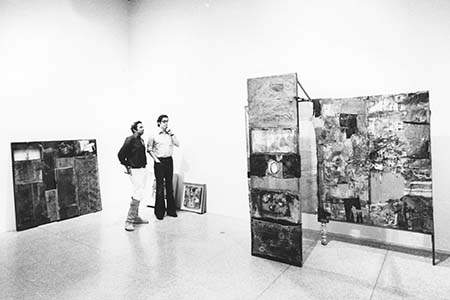 Rauschenberg and Walter Hopps discussing Minutiae (1954) during the installation of the retrospective exhibition Robert Rauschenberg, National Collection of Fine Arts, Smithsonian Institution, Washington, DC, 1976. Photo: Gianfranco Gorgoni
Rauschenberg and Walter Hopps discussing Minutiae (1954) during the installation of the retrospective exhibition Robert Rauschenberg, National Collection of Fine Arts, Smithsonian Institution, Washington, DC, 1976. Photo: Gianfranco Gorgoni

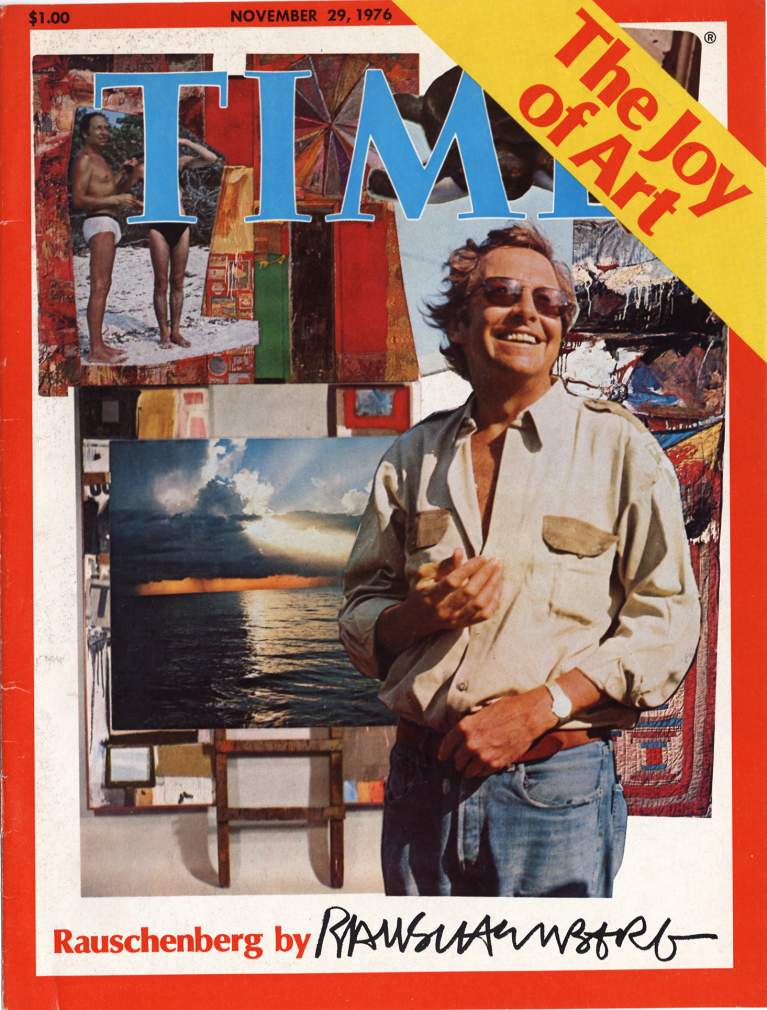 Robert Rauschenberg, Cover for Time Magazine–November 29, 1976
Robert Rauschenberg, Cover for Time Magazine–November 29, 1976
1977
Joins board of directors, Institute for Art and Urban Resources, P.S.1, New York.
Begins Scale series, on which he will work through 1981. Related to the Spreads (1975–83), Scales is a large-scale sculptural series that incorporates solvent transfer onto wood structures usually comprised of fabric, mirrored Plexiglas, and found objects.
January: With his traveling retrospective on view at the National Collection of Fine Arts in Washington, D.C., Rauschenberg is the featured artist on the cover of Artnews, pictured with his Combine Bed (1955) in a photograph by Gianfranco Gorgoni.
January 18: Premiere of Merce Cunningham Dance Company’s Travelogue, Minskoff Theatre, New York, the first collaboration among Rauschenberg, John Cage, and Cunningham in thirteen years. Rauschenberg designs the set and costumes. The set, which he titles Tantric Geography, consists of a row of chairs, and on each chair appears an upturned, sometimes spinning, bicycle wheel. The colorful silk panels used in the costumes and set reflect the influence of the Jammer series (1975–76). Cunningham gave Rauschenberg only the slightest description of the work, explaining that the dancers “were going to travel around the stage at different points in different ways.”1 Cage’s soundtrack, “Telephones and Birds,” unknown to the dancers until the first performance, consists of Australian birdcalls and telephone recordings, including horse-racing results.
January 28: Rauschenberg is named an Honorary Citizen of New Orleans.
March 3: Receives the first Mayor’s Award of Honor for Arts and Culture by the Commission for Cultural Affairs, New York. The twenty-one award recipients include Rauschenberg, choreographer Alvin Ailey, comedian Woody Allen, art dealer Leo Castelli, and architect Philip Johnson.
March 17: A 1-minute display designed by Rauschenberg shows once an hour for a month on computer-operated Spectacolor electronic sign at No. 1 Times Square tower, New York. The sign has operated since December 1, 1976, for commercial and public messages, but Rauschenberg is the first to create an artwork for it.2
March 25: On the same day as the opening of his retrospective exhibition Robert Rauschenberg, Museum of Modern Art, New York, Rauschenberg’s “Announcement” is published in the New York Times. He designed it to illustrate John Russell’s article, “Art That Sings.”
April 23–May 23: Exhibits selected works from the Spread (1975–83) and Scale (1977–81) series, Leo Castelli, New York; Sonnabend Gallery, New York; and Ace Gallery, Venice, California.
June 1–September 19: Participates in inaugural exhibition, Paris—New York, Museé National d’Art Moderne, Centre National d’Art et de Culture Georges Pompidou, Paris.
June 14: Attends a luncheon at the White House, Washington, D.C., given by President Carter in honor of Inaugural Impressions, an exhibition held at the Capitol and a portfolio (1977) published by Universal Limited Art Editions (ULAE), West Islip, New York, in an edition of one hundred to help defray expenses of Carter’s presidential inauguration. Rauschenberg contributes the lithograph Presidential Inauguration (1977), which includes images of the Lincoln Memorial, the Capitol, and a photograph of Carter embracing his daughter, Amy. Other artists who create prints for the portfolio are Jacob Lawrence, Roy Lichtenstein, Andy Warhol, and Jamie Wyeth.
Early summer: Completes Chow Bags series (1976–77), screenprints published by Styria Studio, New York, in editions of one hundred. Each work includes the checkered border and label from packages of Purina-brand pet food, a drawing of a particular animal (for example a mink or a rabbit), and collage and photographic elements.
June 27: Participates in a panel discussion on the role of governmental support in the arts, sponsored by Northern California branch of Artists’ Equity and held at the University of California Extension Center, San Francisco. Other panelists include Rubin Gorewitz and sculptor Richard Mayer.
September 11: Whistle Stop (Spread) (1977) is unveiled at the Fort Worth Art Museum. The museum commissioned the work for its permanent collection. Rauschenberg dedicates Whistle Stop to his father. On September 10, Rauschenberg was named honorary citizen of Fort Worth by Mayor Hugh Parmer and presented with a key to the city.
September 26: Lobbies Congress in Washington, D.C., for artists’ rights and support for the arts with Donald Judd, Jack Youngerman, and other artists.
Early fall: Establishes a medical-assistance fund through Change, Inc., which is administered by the Hospital for Joint Diseases, New York (now affiliated with New York University Langone Medical Center), to provide emergency funds for artists. The program is financed through sales of artworks donated by artists and collectors.
October 20–November 20: Participates in Jim and Bob: The Florida Connection, Jacksonville Museum of Contemporary Art, an exhibition recognizing two contemporary artists—James Rosenquist and Rauschenberg—who live and work in Florida.
October 31–December 17: Participates in Artists’ Sets and Costumes, Philadelphia College of Art.
December 3, 1977–January 15, 1978: Retrospective exhibition, Robert Rauschenberg, Art Institute of Chicago. Receives 2nd Annual Chicago Art Award presented to an “out-of-town artist showing in Chicago.”
- 1. Merce Cunningham quoted in Anna Kisselgoff, “A Dance Revolutionary on Broadway,” New York Times, Jan. 16, 1977, sec. D, p. 8.
- 2. “The Talk of the Town,” pp. 30–31. Rauschenberg was not satisfied with the experience: “Doing it didn’t yield any new experience for me aesthetically. It’s a good idea, but to make it interesting for artists they’d have to modify it considerably . . . make it more flexible” (p. 31).

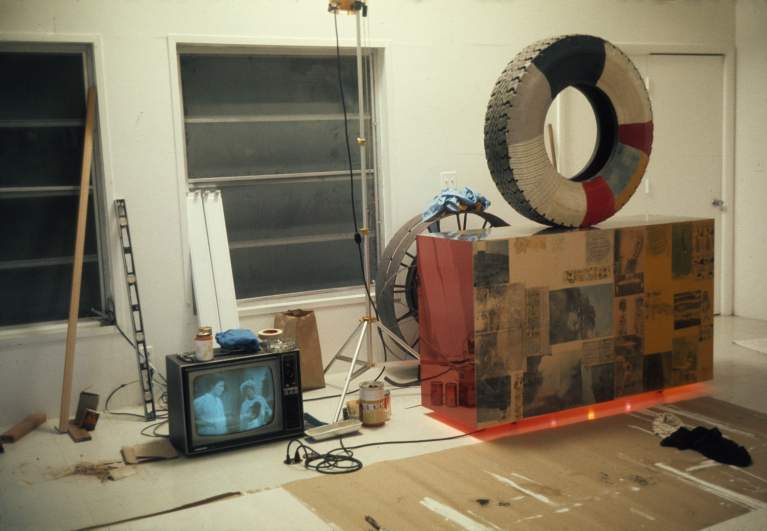 Rauschenberg’s Laika Lane studio, Captiva, Florida, 1978. Work shown is Phoenix (Scale) (1978)
Rauschenberg’s Laika Lane studio, Captiva, Florida, 1978. Work shown is Phoenix (Scale) (1978)

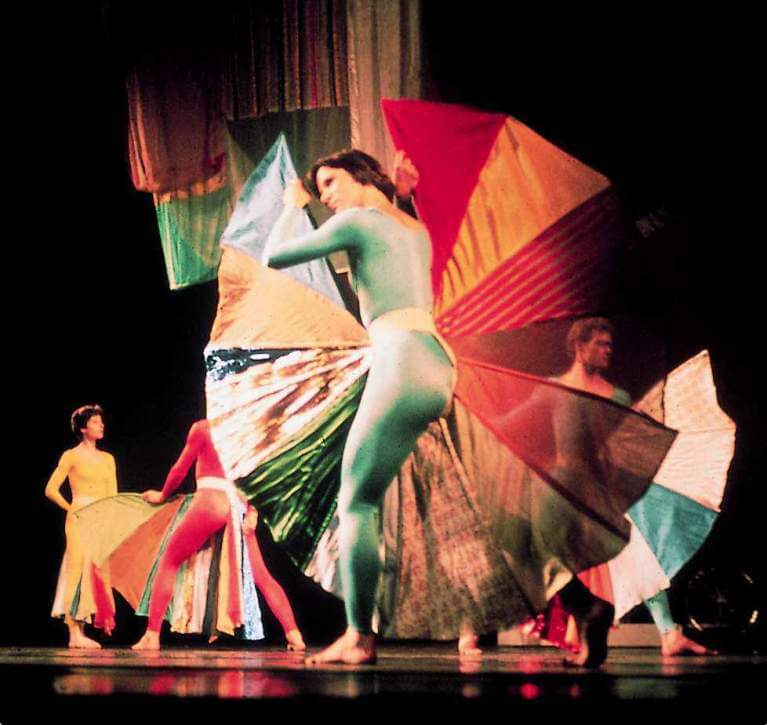 Costumes and set, entitled Tantric Geography, designed by Rauschenberg for Merce Cunningham Dance Company’s Travelogue (1977). Photo: Charles Atlas
Costumes and set, entitled Tantric Geography, designed by Rauschenberg for Merce Cunningham Dance Company’s Travelogue (1977). Photo: Charles Atlas
1978
Creates Rigs, a series of works made up of solvent transfer and collage on dark blue or green paper.
Makes Van Vleck Series, named for Joseph Van Vleck, a neighbor on Captiva, Florida; the series consists of solvent transfer on fabric and acrylics.
Designs costumes for Viola Farber’s Dandelion.1
Winter: Meets Russian poet Andrei Voznesensky through Tatyana Grosman, who began working with the poet in December 1977. In July, Rauschenberg will create lithographs at Universal Limited Art Editions (ULAE), West Islip, New York, for six poems by Voznesensky: “Darkness Mother,” “ECHO WHEN,” “Long Island Beach” (dedicated to Rauschenberg), “From a Diary,” “Seagull-Bikini of God,” and “Picture Gallery,” all eventually published in Voznesensky’s Nostalgia for the Present.2
January 11: Receives first President’s Fellow award from the Rhode Island School of Design, Providence, along with Tatyana Grosman and Les Line, photographer and editor of Audubon magazine.
February 6: Elected as a member of the American Academy of Arts and Letters, New York, an organization that provides awards and scholarships to writers, artists, and composers.
April 19: Receives a Medal of Achievement from the Brandeis University Creative Arts Awards Commission, Waltham, Massachusetts, for distinguished contribution to painting, in a ceremony at the Solomon R. Guggenheim Museum, New York. Other recipients this year include Saul Bellow, Hume Cronyn, Grace Paley, Jessica Tandy, and Paul Taylor.
May–August: Exhibits selected works from the Spread (1975–83) and Scale (1977–81) series, Galerie Ileana Sonnabend, Paris, and Mayor Gallery, London.
May 3: Named a Fellow of the American Academy of Arts and Sciences, Massachusetts.
[Summer]: Makes Publicon series with Gemini G.E.L., Los Angeles, a series of six sculptures created in editions of thirty. The works, which relate to the Stations of the Cross, are cabinets, which open to reveal an enshrined object, such as an oar, a bicycle wheel, fabric, electric lights, or mirrors. The title merges “icon,” a reference to medieval reliquaries and Renaissance altarpieces, and “public,” since the sculptures can be manipulated by the viewer.
September 8–October 29: Robert Rauschenberg: Works from Captiva, Vancouver Art Gallery. This is the first presentation of Hiccups (1978), a 62-foot-long artwork comprised of transfer drawings on ninety-seven handmade sheets of paper joined by metal zippers. The exhibition also includes thirteen works from the Spread (1975–83) and Scale (1977–81) series.
September 11–30: Exhibits Publicons, Gemini G.E.L., Los Angeles.
[Fall]: Conceives of an exhibition of his work that will travel throughout the world, an idea that ultimately evolves into the Rauschenberg Overseas Culture Interchange (ROCI) project.
November 7–25: Exhibits Publicons, Castelli Graphics, New York.
- 1. Rauschenberg’s role as costume designer for Dandelion is confirmed in Jeff Slayton, The Prickly Rose: A Biography of Viola Farber (Bloomington, Ind.: AuthorHouse, 2006), p. 360. The premiere date, venue, and cast, however, are unconfirmed by primary sources.
- 2. Andrei Voznesensky, Nostalgia for the Present (New York: Doubleday, 1978).

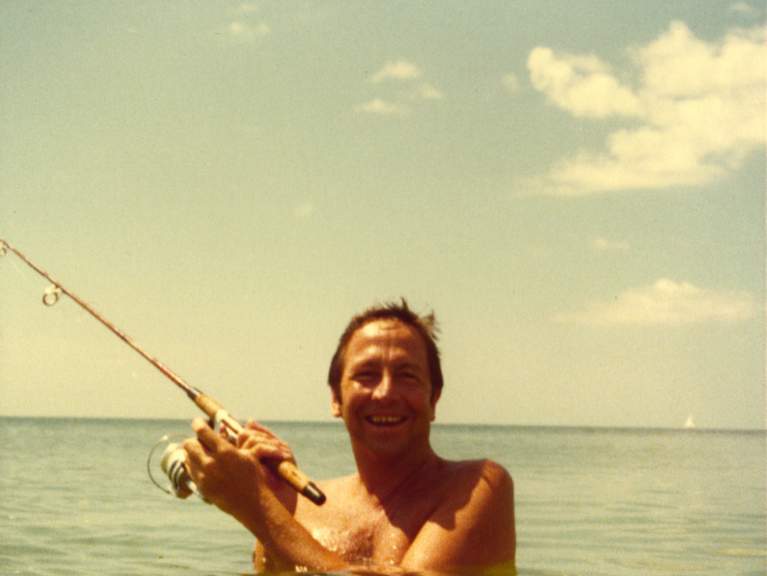 Rauschenberg in Captiva, Florida, 1978. Photo: Attributed to Billy Klüver
Rauschenberg in Captiva, Florida, 1978. Photo: Attributed to Billy Klüver
1979
Receives Special Award, International Biennial of Graphic Art, Cracow.
Conversation with Rauschenberg and Leo Castelli included in Inside New York’s Art World, a collection of interviews by Barbaralee Diamonstein that evolves from the course she taught at the New School for Social Research, New York.
Makes Slide series, comprised of works on paper with solvent transfer on fabric collaged to the picture surface.
January–March: Exhibits selected works from the Spread (1975–83) and Scale (1977–81) series, Sonnabend Gallery, New York; Richard Gray Gallery, Chicago; Akron Art Institute, Ohio; Ace Gallery, Venice, California; and Richard Hines Gallery, Seattle.
February 24–April 8: 36th Biennial Exhibition of Contemporary American Painting, Corcoran Gallery of Art, Washington, D.C., that features Backpack Index (Spread), Credit Blossom (Spread), Crystal Hive (Spread), Golden Grebe (Scale), and Half a Grandstand (Spread) (all 1978). Jane Livingston, the Corcoran’s associate director, chose Willem de Kooning, Jasper Johns, Ellsworth Kelly, Roy Lichtenstein, and Rauschenberg—enfants terribles of the 1950s and 1960s—to represent, with examples of their new works, the best contemporary painting in America. The exhibition includes video portraits of each artist created by the artist Joan Logue for the occasion.
May 5–June 24: Robert Rauschenberg: Das zeichnerische Werk, 1949–1979, Kunsthalle Tübingen, West Germany. The exhibition of works on paper will travel to Kunstmuseum Hannover mit Sammlung Sprengel, West Germany.
May 7: Premiere of Glacial Decoy (1979), Trisha Brown Dance Company, Walker Art Center, Minneapolis, for which Rauschenberg designed the set and costumes; after the first performance, he will redesign the costumes, which will premiere during the performances at Marymount Manhattan College Theater, New York (June 20–24). The Walker presentation is the first occasion Brown uses a formal set and marks a turn for the company from minimalist, conceptual dance to more intuitive forms. Rauschenberg’s white, pleated, diaphanous gowns with wing-like sleeves emphasize the dancers’ flowing movements. The set consists of four floor-to-ceiling screens onto which several hundred black-and-white photographs, taken in and around Fort Myers, Florida, are projected at four-second intervals, moving sequentially from stage right to stage left. The clicking sounds of the projectors serve as the soundtrack for the dance. The images will appear again in a series of five prints that use color etching and photoetching, and in a series of four lithographs, both in the Glacial Decoy Series (1979–80), published by Universal Limited Art Editions (ULAE), West Islip, New York. He will also use them in a series of eleven lithographs called Rookery Mounds (1979), which will be printed by Gemini G.E.L., Los Angeles. The hundreds of unique photographs that the set required rekindles Rauschenberg’s passion for photography and will inspire him to begin the Photem Series (1981/1991).
June 8–September 5: Participates in 13th International Biennial of Graphic Art, Moderna Galerija, Ljubljana, Yugoslavia. Awarded Honorary Grand Prize.
[Fall]: Receives first architectural commission from Equitable Trust, Baltimore, for its new corporate headquarters. Creates Bank Job (1979), a 29-foot-long Spread, which will be exhibited for the first time at Leo Castelli, New York, in February 1980, before its dedication at the Equitable Bank Center, Baltimore, on May 17, 1981.
December 30: A wraparound cover designed by Rauschenberg encloses a special end-of-the-decade issue of Tropic (Miami Herald weekly magazine). The design, entitled Piece for Tropic (1979), is a collage of Rauschenberg’s photographs of Florida. The cover is printed in an edition of more than 600,000; one hundred signed copies are delivered at random to the newspaper’s subscribers. Rauschenberg receives a $1,000 honorarium that he donates to Change, Inc.

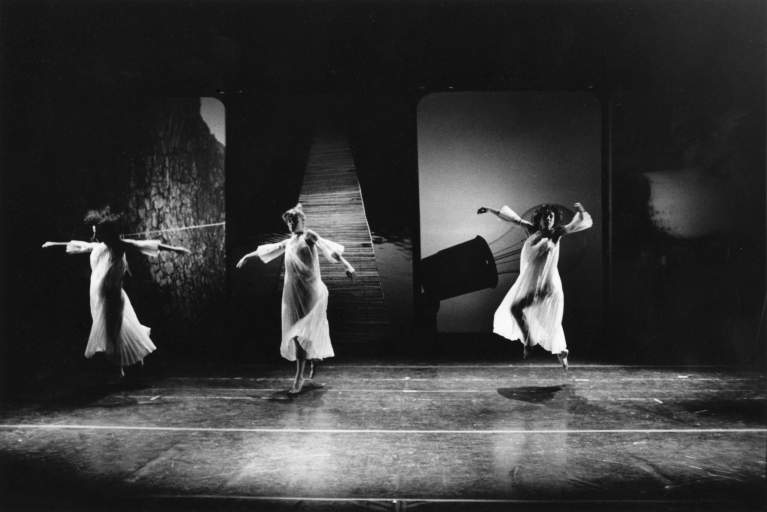 Set, costumes, and lighting by Rauschenberg for Trisha Brown Dance Company’s Glacial Decoy (1979). Pictured: Trisha Brown, Nina Lundborg, and Lisa Kraus. Photo: Babette Mangolte
Set, costumes, and lighting by Rauschenberg for Trisha Brown Dance Company’s Glacial Decoy (1979). Pictured: Trisha Brown, Nina Lundborg, and Lisa Kraus. Photo: Babette Mangolte

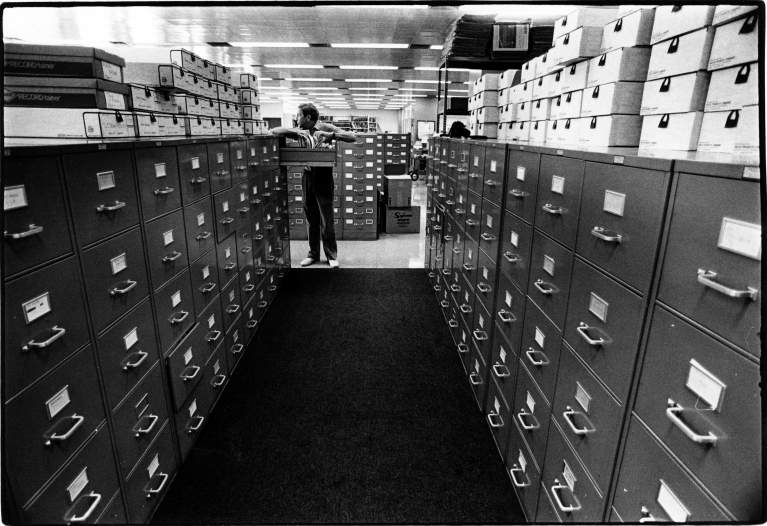 Rauschenberg at the Miami Herald, looking through photography archives for source material for Cover for Tropic, The Miami Herald (1979), published in an edition of 600,000 in Miami, December 1979. Photo: Attributed to John Doman
Rauschenberg at the Miami Herald, looking through photography archives for source material for Cover for Tropic, The Miami Herald (1979), published in an edition of 600,000 in Miami, December 1979. Photo: Attributed to John Doman
1980-89
1980
Rauschenberg and Gemini G.E.L., Los Angeles, settle a lawsuit filed against them by Morton Beebe, a photographer, whose image of a diver was incorporated into Pull (Hoarfrost Edition) (1974). Beebe’s photograph, entitled Diver, had been published as part of an advertisement for Nikon in the early 1970s. Rauschenberg and Gemini admit no wrongdoing, arguing that Rauschenberg’s process of transfer, collage, and reversal transforms the printed imagery. Rauschenberg had been sued earlier by Dennis Brack for the use of his photograph taken during the 1967 Detroit riots and published in Newsweek, which Rauschenberg then incorporated into the silkscreen Signs (1970).
Begins Cloister series (1980–81), works on paper with solvent transfer and collage, each with a beveled-edge "mat," a cloister-like surround (from which the series takes its name) that was also painted and collaged.
Begins The Razorback Bunch (1980–82) series of photoetchings, produced in an edition of twenty-four, and published by Universal Limited Art Editions (ULAE), West Islip, New York. Some of the series’ source images were used in the set for Trisha Brown’s Glacial Decoy (1979).
Creates Signal series, paintings that include solvent transfer imagery and collage mounted on plywood with metal frames. The series title was inspired by the uniform square shape of the paintings, reminding Rauschenberg of nautical signal flags.
Receives commission from Rockefeller Center Development Corporation, New York, for the new Wells Fargo Building, Los Angeles. Rauschenberg will create Fargo Podium (1981), a three-dimensional, mixed-media installation. The work will be installed in 1981.
Sale of the limited-edition screenprint After Homage to Picasso (1973/80) raises $400,000 for the unsuccessful bid for the Democratic presidential nomination by U.S. Senator Ted Kennedy (D-Mass.).
Designs costumes for Viola Farber’s Tracks.88
January 11: Featured at work in Captiva, Florida, on ABC television program Good Morning America and discusses commissions for public spaces, including Bank Job (1979) for the corporate headquarters of Equitable Trust, Baltimore, and Periwinkle Shaft (1979–80) for the Children’s Hospital Medical Center, Washington, D.C.
March 23–May 4: Retrospective exhibition Rauschenberg: Werke 1950–1980, Staatliche Kunsthalle, West Berlin. The exhibition will travel to Kunsthalle Düsseldorf; Louisiana Museum of Modern Art, Humlebæk, Denmark; Städel, Frankfurt; Städtische Galerie im Lenbachhaus, Munich; and Tate Gallery, London.
April 20–May 30: Photos In + Out City Limits: Ft. Myers, Florida, Photographer’s Gallery, Sanibel Island, Florida. The exhibition is the first in a series of presentations featuring Rauschenberg’s photographs of various locales in the United States: Baltimore; Boston; the area around his home in Captiva, Florida; Charleston, South Carolina; Los Angeles; and New York. Exhibitions will be held in each of these cities. The project seeks to fulfill, with some modifications, Rauschenberg’s early intention, first conceived in 1952 at Black Mountain College, near Asheville, North Carolina, of photographing the United States “inch by inch.” ULAE will publish Photos In + Out City Limits: Boston (1981) and Photos In + Out City Limits: New York C. (1982).
Fall: Off the Wall: Robert Rauschenberg and the Art World of Our Time by Calvin Tomkins is published.
October 3: Dedication of Periwinkle Shaft (1979–80), Children’s Hospital Medical Center. The colorful mural, which is installed in an escalator shaft, contains mirrors and animal images.
[Late fall]: Begins The 1/4 Mile or 2 Furlong Piece (1981–98), intended to be the longest artwork in the world, using techniques employed throughout his career. By 1998, Rauschenberg will have created 190 panels and sculptural elements for a total length of nearly one thousand feet. Sequences in The 1/4 Mile or 2 Furlong Piece will recall past series from his oeuvre, while others reflect current trends in art, visually representing significant trajectories that have developed throughout the artist’s career. The work will be shown at its existing length at the time of various exhibitions, accompanied by an audio recording of sounds from his home and travels.
December: Receives Gold Medal, Biennial of Graphic Art, Fredrikstad, Norway.
- 88. Rauschenberg’s role as costume designer for Tracks is confirmed in Slayton, The Prickly Rose, p. 361. The premiere date, venue, and cast, however, are unconfirmed by primary sources.

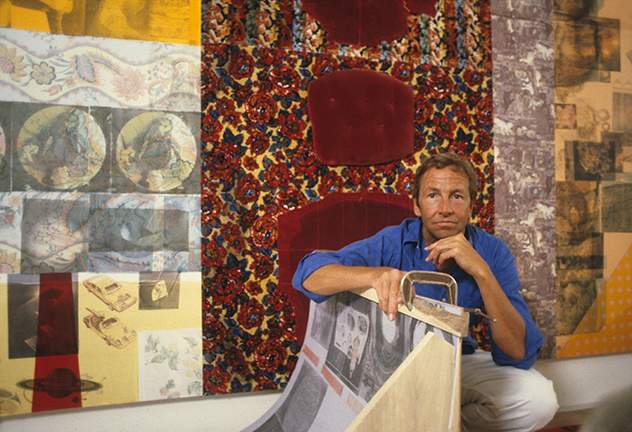 Rauschenberg with Mongolian Cousin (Spread), Captiva, Florida, 1980
Rauschenberg with Mongolian Cousin (Spread), Captiva, Florida, 1980
1981
Begins Kabal American Zephyr series (1981–83/1985/1987–88). The sculptural series is inspired by nineteenth-century Japanese woodblock printmaker Tsukioka Yoshitoshi, whose work Rauschenberg had seen in the exhibition The Bizarre Imagery of Yoshitoshi: The Herbert R. Cole Collection (1980), Los Angeles County Museum of Art. Yoshitoshi’s prints depict violent events in beautiful settings, creating what Rauschenberg later calls a sense of “fantasy-macabre” that he seeks to capture in his juxtapositions of found objects and transfer-printed imagery.89 Rauschenberg also appropriates several of Yoshitoshi’s titles.
Creates an untitled lithograph with embossing, printed in an edition of two hundred by Styria Studio, New York, and published by the Democratic Congressional Campaign Committee for the benefit of Artists Rights Today, New York.
January: Creates Photem Series (1981/1991), large-scale, multiple-image totemic configurations of his own black-and-white photographs mounted together on aluminum. Rauschenberg will return to the series in 1991 when several Photems are editioned by PaceMacGill, New York.
February 22: Featured on the CBS television program Sunday Morning at work in Captiva, Florida.
Spring: Gemini G.E.L., Los Angeles, arranges a collaboration with author William S. Burroughs on a series of six lithographs, American Pewter with Burroughs, each printed in an edition of thirty-four to forty-eight. Burroughs provides a sheet of text, written specifically for the project, from which Rauschenberg selects six phrases. In Captiva, Florida, Rauschenberg prepares the lithography stones, then sends them to Los Angeles, where they will be printed by Gemini. In colors of metallic-gray and gray-green, which suggest pewter, Burroughs’s phrases are embossed on paper and surrounded by Rauschenberg’s photographs of America. The project, which will be completed in 1982, is Gemini’s first collaboration between an artist and an author.
March 25: Lobbies U.S. Congress, with choreographers Eliot Feld and Jerome Robbins and actors James Earl Jones and Jean Stapleton, against budget cuts for the National Endowment for the Arts, Washington, D.C.
March 28–April 25: Rauschenberg at Sonnabend: Photems Series, Sonnabend Gallery, New York. Works from this series were also exhibited at the Institute of Contemporary Art, Boston, September 16–November 1.
April 1–May 27: Rauschenberg Photographe, organized by Alain Sayag, Musée National d’Art Moderne, Centre Georges Pompidou, Paris. The exhibition will travel throughout Europe. As Rauschenberg notes in a statement for the catalogue, when he first began to work with photography in 1949, “the camera functioned as a social shield. In 1981 I think of the camera as my permission to walk into every shadow or watch while any light changes. . . . Photography is the most direct communication in nonviolent contacts.”90
May 12: Named Officier de l’Ordre des Arts et Lettres, Le Ministère de la Culture et de la Communication, Paris.
May 16–30: Benefit art sale for Trisha Brown Dance Company, Leo Castelli, Greene Street, New York, for which Rauschenberg designed the poster For Trisha Brown Dance Co. (1981).
June: AFL-CIO American Federationist magazine publishes poster by Rauschenberg, AFL-CIO Centennial Commemorative Artwork (1981), as its cover. The poster, an offset lithograph, incorporates images of workers’ protests.
October 27–December 10: Photos In + Out City Limits: Charleston, Gibbes Art Gallery, Charleston, South Carolina.
October 30–December 12: Photos In + Out City Limits: Boston, Magnuson Lee Gallery, Boston.
November 5–29: Photos In + Out City Limits: Baltimore, Grimaldis Gallery, Baltimore.
December 31, 1981–January 23, 1982: Photos In + Out City Limits: Los Angeles, Rosamund Felsen Gallery, Los Angeles.

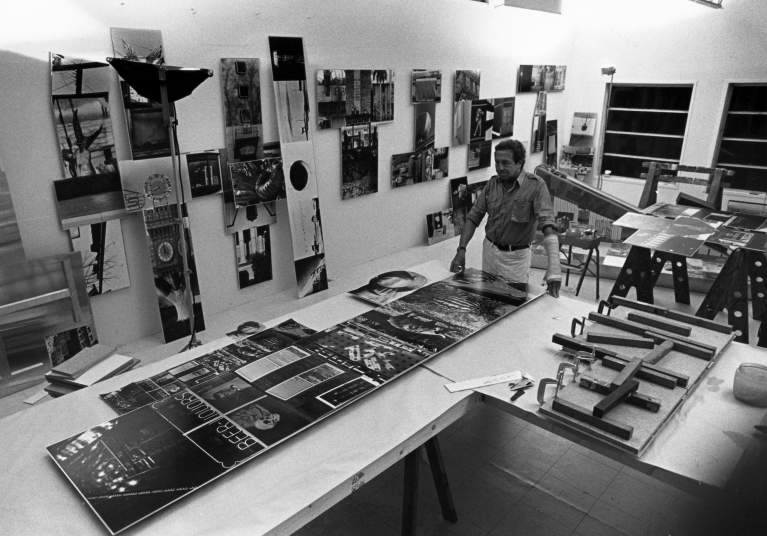 Rauschenberg working on Photem Series I #25 (1981) in his Laika Lane studio, Captiva, Florida, January 1981. Photo: Emil Fray
Rauschenberg working on Photem Series I #25 (1981) in his Laika Lane studio, Captiva, Florida, January 1981. Photo: Emil Fray
1982
Creates poster for 1984 Summer Olympic Games in Los Angeles.
Creates photo-offset poster for “Wall to Wall, John Cage and Friends,” a tribute to John Cage held at Symphony Space, New York. Styria Studio, New York, publishes a screenprint of the work in an edition of 125.
Produces Bifocal series, consisting of collage on cardboard, often with the addition of solvent transfer, acrylic, or pencil, where both the front and the back of the cardboard support are embellished and integral to the finished work of art.
Makes L.A. Flakes, a print series published by Gemini G.E.L., Los Angeles.
January 9–30: Photos In + Out City Limits: New York C., Sonnabend Gallery, New York.
April 27: Receives Skowhegan Medal for Painting, Skowhegan School of Painting and Sculpture, Maine, at the Plaza Hotel, New York. Out of forty-five awards, Jasper Johns and Rauschenberg are the only two artists to win twice, once for painting and once for graphic work.
June 10–July 14: Travels to China to work on a project initiated by Gemini G.E.L., with the assistance of curator and interpreter Chun-Wuei Su Chien, at Xuan Paper Mill, the world’s oldest paper mill, in Jingxian, Anhui Province. Prior to working for two weeks in Jingxian, Rauschenberg travels with Donald Saff for three weeks throughout China, visiting museums, cities, villages, and archaeological sites, and meeting with art students in Beijing.1 He also takes photographs for Chinese Summerhall (1982), a project with Graphicstudio, USF Institute for Research in Art, Tampa, which he will begin in the fall. Arriving in Jingxian, he ultimately is disallowed entry into the Xuan Paper Mill as a measure to protect craft secrets. Instead, the mill supplies him with handmade paper with which he creates 7 Characters, 491 unique collages in seven suites, in a nearby workshop.2 To a base of thirty-ply paper and a layer of silk, one of seven terms in Chinese characters—change, howl, individual, light, red heart, trunk, and truth—is added in pulp relief. Then, images from posters found in Shanghai are attached and overlaid with a thin transparent paper. In Los Angeles, Rauschenberg will apply gold leaf to the edges of the paper and attach a cloth medallion that hangs from each collage. Many of the works are included in the Rauschenberg Overseas Culture Interchange: ROCI CHINA exhibition held at the National Art Museum of China, Beijing, in 1985, in addition to other venues of the ROCI project.
July 15–August 31, September 22–October 8: Visits Japan twice and works with ceramics for the second time in his career (the first occurred in 1972 at Graphicstudio) at Otsuka Ohmi Ceramics Company, Shigaraki, Japan. Rauschenberg works with chemists to produce glazes that he will use to silkscreen photographs onto ceramic. The first group, Japanese Clayworks (1982/1985), recalls the motifs of Combines by including elements such as a ceramic tire track (a reference to Automobile Tire Print [1953]) and a ladder (Winter Pool [1959]), in combination with imagery from ancient and modern Japan. These images are printed on photographic decals, painted with glazes, and then fired. The second group, Japanese Recreational Clayworks (1982–83/1985), made while waiting for the first group to be fired, consists of ceramic paintings in which Rauschenberg reworked prefabricated Japanese art ceramics—representing such icons of Western art as Leonardo da Vinci’s Mona Lisa (ca. 1503–05) and Jacques-Louis David’s Bonaparte Crossing the Saint-Bernard (ca. 1800)—and combined with images of contemporary Japan.
Fall: Creates 30-inch-high, 100-foot-long mural of photographs taken during his travels in China over the summer. The composite image will be published as Chinese Summerhall (1982) on a single sheet of Kodak paper in an edition of five by Graphicstudio, which will also publish five studies for the work in an edition of twenty-five and twenty-eight individual photographs in editions of thirty and sixty.
October 14: Attends memorial service for Tatyana Grosman, West Islip, New York. He first collaborated with her press, Universal Limited Art Editions (ULAE), West Islip, in 1962. In her memory, he will create a ceramic piece, Tanya Litho HC 2/18 (1982), based on a 1974 lithograph by ULAE.
December 2, 1982–February 1, 1983: Rauschenberg in China, Museum of Modern Art, New York. Works from 7 Characters (1982) are exhibited.
- 1. See Larry Rohter, “China: A Brush with the Master,” Newsweek (New York), Aug. 2, 1982, p. 40, and Rauschenberg interview with Yoshiaki Tono, in ROCI JAPAN, exh. cat. (Tokyo: Setagaya Museum of Art, 1986), pp. 11–12.
- 2. Hiroko Ikegami, “ROCI East: Rauschenberg’s Encounters in China,” in East-West Interchanges in American Art: A Long and Tumultuous Relationship, Lee Glazer, Amelia A. Goerlitz, and Cynthia Mill, eds. (Washington, D.C.: Smithsonian Institution Scholarly Press, 2012), pp. 179–80. See also “The Reminiscences of Donald Saff,” 2013, pp. 98–101 and “The Reminiscences of Sidney B. Felsen,” 2014, pp. 45–46 (Robert Rauschenberg Oral History Project, Columbia Center for Oral History Research, Columbia University in the City of New York and Robert Rauschenberg Foundation Archives).
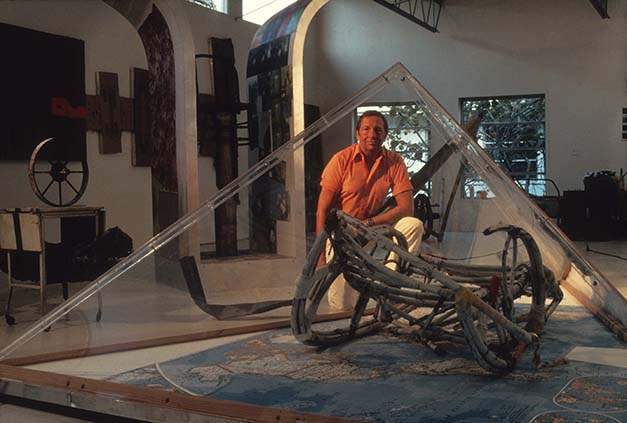 Rauschenberg with a portion of 1/4 Mile or 2 Furlong Piece (1981–98), Laika Lane studio, Captiva, Florida, 1982. Photo: Terry Van Brunt
Rauschenberg with a portion of 1/4 Mile or 2 Furlong Piece (1981–98), Laika Lane studio, Captiva, Florida, 1982. Photo: Terry Van Brunt

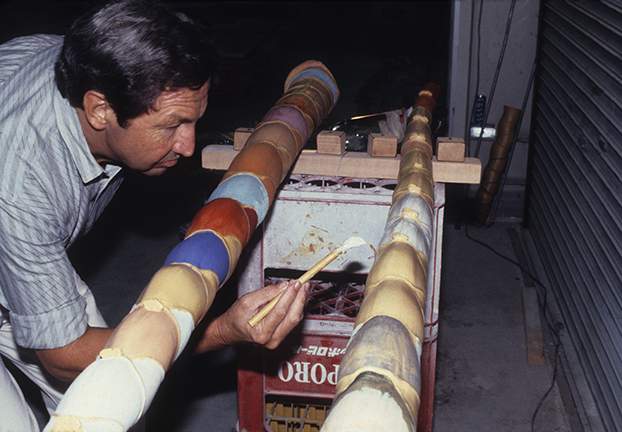 Rauschenberg applying glaze to Axis works from his Japanese Claywork series, Otsuka Ohmi Ceramics Company, Shigaraki, Japan, September 1982. Photo: Terry Van Brunt
Rauschenberg applying glaze to Axis works from his Japanese Claywork series, Otsuka Ohmi Ceramics Company, Shigaraki, Japan, September 1982. Photo: Terry Van Brunt
1983
Creates Statue of Liberty (1983), a screenprint with color offset-printed-postcard collage, for New York, New York, a portfolio of eight graphic works by different artists, published by New York Graphic Society.
February 9–March 23: Travels to Japan, Sri Lanka, and Thailand. In Japan, makes a suite of Kyoto drawings on locally acquired gold-edged dedication boards. Rauschenberg then makes a group of Sri Lanka drawings on ceremonial mat boards in that country. He will also complete a suite of Thai drawings after his return to Captiva.
March 21: International Day for the Elimination of Racial Discrimination, for which Rauschenberg created the offset lithographic poster for World Artists Against Apartheid. It is one of fifteen original posters created for 15 Artists Against Apartheid, Galerie Maeght, Paris, March 21–April 16. On November 26, 1984, he receives Certificate of Appreciation from the United Nations Special Committee Against Apartheid for his design.
June: Receives award for the series of prints Arcanum (1979), 15th International Biennial of Graphic Art, Moderna Galerija, Ljubljana, Yugoslavia. The series consists of works on paper made with solvent transfer on fabric collaged to paper.
July 3–August 6: Chinese Summerhall (1982) is included in International Festival of Photography, Arles, France.
August 11–September 30: Rauschenberg/Performance: 1954–1979, organized by Nina Sundell, Galleria di Franca Mancini, Pesaro, Italy, presents photographs documenting the artist’s performance works. An expanded version, Rauschenberg/Performance: 1954–1984, will incorporate his latest collaboration with Trisha Brown, Set and Reset (1983), as well as a selection of props and costumes, and will travel throughout the United States from December 1983 through September 1985.
[Fall]: Begins Salvage series (1983–85) that evolves from Rauschenberg’s costume designs for Trisha Brown’s Set and Reset. When silkscreening the costumes, the images bled through the fabric to a drop cloth beneath, and Rauschenberg decided he wanted to try to “salvage” the effect. The title also puns on the word “selvage,” referring to the selvage edges of the drop cloths, which, though unhemmed, will not unravel and need not necessarily be stretched. The series consists of canvases painted and silkscreened with images derived from his own photographs. In addition to salvaging earlier photographs and techniques, Rauschenberg includes other autobiographical elements, including a reproduction of Thomas Gainsborough’s The Blue Boy (1770; one of the first artworks Rauschenberg saw in a museum in 1943, and which made him realize he could be an artist) and makes reference to his colleagues (a flag for Jasper Johns and soup cans for Andy Warhol).
October 20: Premiere of Trisha Brown Dance Company’s Set and Reset, Next Wave Festival, Brooklyn Academy of Music, New York, for which Rauschenberg designed the costumes and set. Laurie Anderson composed the music that features Richard “Dickie” Landry playing jazz on the alto saxophone, electronic percussion, and Anderson whispering the song “Long Time No See.” The set entitled Elastic Carrier (Shiner) (1983) is an 11-by-36-foot freestanding structure, consisting of two pyramids, flanking a rectangular box and covered with a reflective-silver fabric developed by NASA. As the theater darkens, film montages, compiled from newsreels, television programs, and NASA footage, are projected onto the structure that then rises to float above the dancers. The costumes consist of loose-fitting, sheer outfits upon which Rauschenberg’s black-and-white photographs of New York are silkscreened.
December 5, 1983–January 31, 1984: Robert Rauschenberg, Australian National Gallery, Canberra, the artist’s first major solo exhibition in Australia.

 Rauschenberg working on Untitled (Spread) (1983) in his print shop, Captiva, Florida, 1983. Photo: © The Robert Mapplethorpe Foundation. Courtesy Art + Commerce
Rauschenberg working on Untitled (Spread) (1983) in his print shop, Captiva, Florida, 1983. Photo: © The Robert Mapplethorpe Foundation. Courtesy Art + Commerce

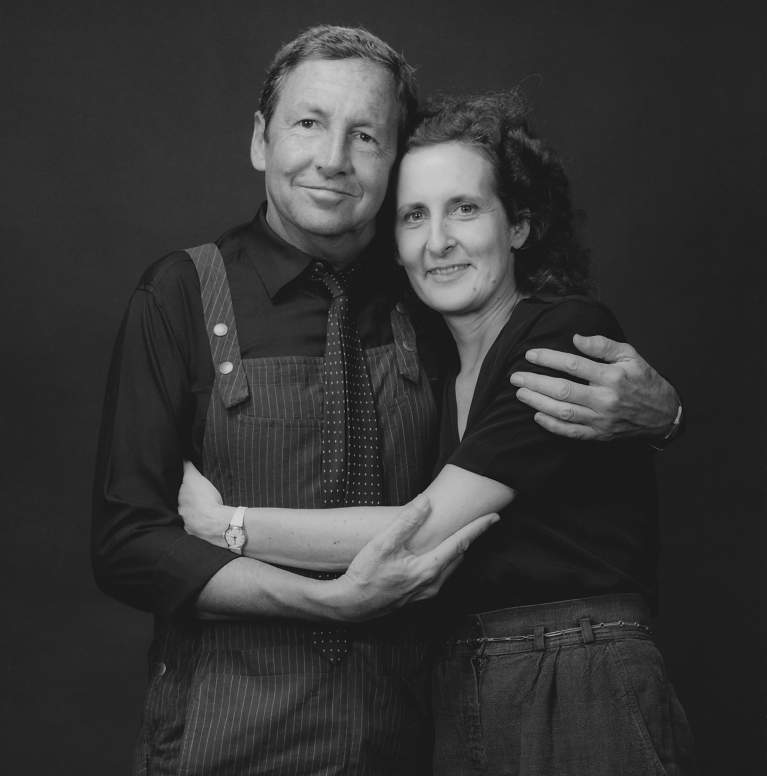 Robert Rauschenberg and Trisha Brown, 1983. Photo: © The Robert Mapplethorpe Foundation. Courtesy Art + Commerce
Robert Rauschenberg and Trisha Brown, 1983. Photo: © The Robert Mapplethorpe Foundation. Courtesy Art + Commerce
1984
Creates Moroccan series, four prints and collages published by Universal Limited Art Editions (ULAE), West Islip, New York.
Makes Renault Paper Work series with solvent transfer and acrylic on fabric-laminated paper.
Produces Sling-Shots Lit series, light-box assemblages with lithography and screenprinting on Mylar and sailcloth panels that will be published by Gemini G.E.L., Los Angeles.
January 1: Broadcast of Nam June Paik’s Good Morning Mr. Orwell. Hosted by George Plimpton and Jacques Villers, the work is simultaneously broadcast in Paris and New York and features performances by Laurie Anderson, John Cage, Merce Cunningham, Peter Gabriel, and Allan Ginsberg, among others. Rauschenberg is announced as participating; however, he is neither credited nor does he appear in the actual broadcast.
February 4–19: Exhibits work at the invitation of the Port Arthur Public Library and the Historical Association, Texas, during his first trip to his hometown in forty years. Mayor Bernis Sadler declares February 4, 1984, “Robert Rauschenberg Day.” In conjunction, a print and a poster designed by Rauschenberg are published; the sales will be used to raise funds for the Robert Rauschenberg Scholarship Fund at Lamar State College—Port Arthur.1 The poster includes photographs of Rauschenberg as a boy in front of the town’s former library, as the Venice Biennale Grand Prize winner, and on his travels.
February 28: Receives Grammy Award for Best Album Package, National Academy of Recording Artists, Los Angeles, for the commissioned cover of a limited-edition version of the Talking Heads’ Speaking in Tongues (1983). Rauschenberg’s design consists of a transparent LP and an offset-printed album cover that incorporated clear spinning discs printed with photo-derived images in red, yellow, and cyan. A deluxe edition of 50,000 albums was released by Sire Records in 1983. Rauschenberg donates proceeds from the project to Change, Inc.
May 12–June 30: Robert Rauschenberg: Peintures récentes, Fondation Maeght, Saint Paul-de-Vence, France, an exhibition that includes works from the Salvage series (1983–85).
May 24: Awarded honorary doctorate of fine arts, New York University. University President John Brademas confers the degree by saying, “Robert Rauschenberg—your work is a constant reminder of the danger that lies in forgetting. Accomplished as a painter, sculptor, environmental- and assemblage-artist, your life fulfills your own imperative: to remain ‘responsive to changes, needs and complexities of current life while keeping history and love alive.’”2
August 8–9: Attends launch of the space shuttle Discovery, Cape Canaveral, Florida. Rauschenberg is one of seventy artists invited by NASA to portray the shuttle in their own mediums. Life magazine publishes a photograph of him with his work-in-progress in its October issue.3
August 14–25: Visits Toluca, Oaxaca, and other sites in Mexico in preparation for the Rauschenberg Overseas Culture Interchange (ROCI) project.
September 14–October 27: Participates in Disarming Images: Art for Nuclear Disarmament, Contemporary Arts Center, Cincinnati. The exhibition will travel across the United States through 1986 and includes the drawing Cot (1980). An image of Cot illustrated an exhibition poster of which Rauschenberg signed one hundred copies to raise funds for Art for Nuclear Disarmament.
October 19–22: Visits Tobago, where he writes the “Tobago Statement,” later published in the Rauschenberg Overseas Culture Interchange catalogue (1991) on the purpose of the soon-to-be-announced ROCI project:
The Rauschenberg Overseas Culture Interchange, after six years of only spiritual support, is now a reality. ROCI, as we shortly put it, is a four-year private project taking, making and exchanging art and facts around the world.
Emphasis will be placed on sharing experiences with societies less familiar with non-political ideas or communicating “worldly” through art. A selection of works done in, or influenced by, participating countries will then continue to travel, including videos, photographs, sound, drawings, prints, and catalogues, to the next country, systematically eclipsing the opening exhibit, which functions as a catalyst, enabling the international exhibition and collaboration to exist and grow.
I feel strong in my beliefs, based on my varied and widely traveled collaborations, that a one-to-one contact through art contains potent peaceful powers, and is the most non-elitist way to share exotic and common information, seducing us into creative mutual understandings for the benefit of all.
Art is educating, provocative, and enlightening even when first not understood. The very creative confusion stimulates curiosity and growth, leading to trust and tolerance. To share our intimate eccentricities proudly will bring us all closer. When I was a student at the Art Students League in New York City, I was surrounded by groups of artists, all investigating the comparable similarities and likenesses between things. It was not until I realized that it is the celebration of the differences between things that I became an artist who could see. I know ROCI could make this kind of looking possible.4
October 25–November 10: Travels to Chile, visiting Santiago, the countryside, and the desert in preparation for the ROCI project. Due to President Augusto Pinochet’s repressive regime, he meets with students, artists, and political activists in Catholic churches, which is the only institution the people trust and feel safe to gather.
November 17: Awarded Jerusalem Prize for Arts and Letters, Philadelphia chapter of Friends of Bezalel Academy of Jerusalem.
December 13: Announces ROCI project at the United Nations, New York. The ambitious project is an evolving collaborative process of art making with artists and artisans in foreign countries. Through ROCI, Rauschenberg seeks to expand communication and understanding among diverse cultures. The project specifically includes countries that are developing nations, controlled by totalitarian governments, or have little contact with the United States. The initial plan includes twenty-two countries; ultimately, the project will be realized in eleven countries—Mexico, Chile, Venezuela, China, Tibet, Japan, Cuba, the Union of Soviet Socialist Republics (USSR), Germany, Malaysia, and the United States—from 1985 to 1990. Rauschenberg’s pet turtle Rocky, who performed in the artist’s Spring Training (1965), becomes the project’s symbol. Donald Saff, Rauschenberg’s collaborator at Graphicstudio, USF Institute for Research in Art, Tampa, is artistic director of ROCI. Sponsorship is not forthcoming from government, corporate, or private sources, and—ultimately preferring to keep the project free from interference—Rauschenberg funds it almost exclusively by selling his own works and those in his art collection. Over the next several years, Rauschenberg will travel to each host country for several weeks at a time, gathering materials and learning local traditions. A videotape is made by assistants to document the experience. Each project closes with an exhibition of works, one of which Rauschenberg gives to the host country. The exhibitions present Rauschenberg’s paintings and objects created from the 1970s onward; later exhibitions include works from previous ROCI exhibitions. In all, Rauschenberg will create more than 125 paintings, sculptures, and editioned objects.
- 1. Our thanks to Dr. Sam Monroe, who retired in August 2014 as long-time president of Lamar State College—Port Arthur and provided us with the details about Rauschenberg’s return visits to Port Arthur.
- 2. Quoted in “Presentation Citation and Investiture of Robert Rauschenberg with the Honorary Degree of Doctor of Fine Arts,” New York University, 1984. Robert Rauschenberg Archives, Robert Rauschenberg Foundation.
- 3. See photographs published in David Friend, “All Aboard the Shuttle,” Life (New York) 7, no. 11 (Oct. 1984), pp. 72–73.
- 4. Rauschenberg, “Tobago Statement,” in Rauschenberg Overseas Culture Interchange, exh. cat. (Washington, D.C.: National Gallery of Art, 1991), p. 154.

 Rauschenberg working on his portrayal of the Discovery space shuttle, near the Cape Canaveral launchpad, Florida, August 1984. Photo: Theo Westenberger
Rauschenberg working on his portrayal of the Discovery space shuttle, near the Cape Canaveral launchpad, Florida, August 1984. Photo: Theo Westenberger


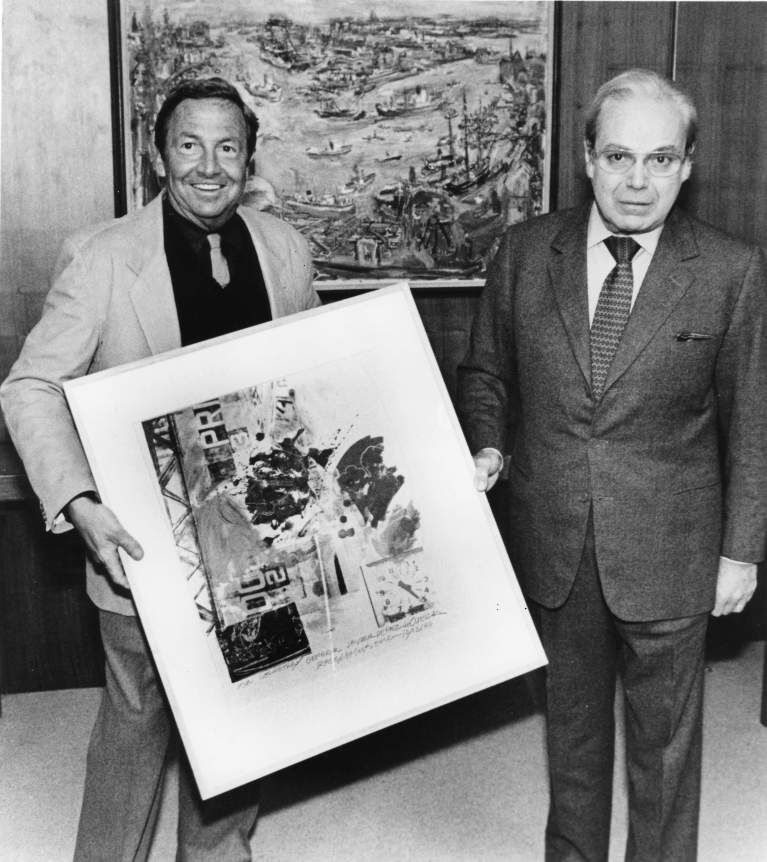 Rauschenberg presenting ROCI Announcement Print to United Nations Secretary General Javier Perez de Cuellar, United Nations, New York, 1984
Rauschenberg presenting ROCI Announcement Print to United Nations Secretary General Javier Perez de Cuellar, United Nations, New York, 1984
1985
Designs photocollage for book jacket of Anteparadise by Chilean poet Raúl Zurita.1
February 8–March 24: Rauschenberg, a small retrospective exhibition, opens at Fundación Juan March, Madrid. The exhibition will travel to Fundació Joan Miró, Barcelona.
April 17–June 23: Rauschenberg Overseas Culture Interchange: ROCI MEXICO, Museo Rufino Tamayo Arte Contemporáneo Internacional, Mexico City. The artist creates a series of paintings and collaged wall reliefs specifically for the exhibition as part of the ROCI project. Mexican poet and critic Octavio Paz wrote a poem, “A Wind Called Bob Rauschenberg,” for the exhibition catalogue.
June 20–July 1: Visits Venezuela in preparation for the ROCI project, traveling to the cities of Caracas and Maricaibo, as well as to the Amazonas Territory, where he meets with native tribes.
July 17–August 18: Rauschenberg Overseas Culture Interchange: ROCI CHILE, Museo Nacional de Bellas Artes, Santiago. Rauschenberg provided financial assistance for repairs to the museum, which had been damaged by an earthquake in March. During his research trip, Rauschenberg had visited a copper mine and foundry outside of Antofagasta, which led him to use copper supports for his silkscreened photographs, a series entitled Copperhead (1985/1989). The surfaces of the works are patinated with tarnishing agents to create somber hues. Rauschenberg chose copper as a sign of solidarity with the Chilean people, many of whom work in the mines and against Chile’s dictator, President Augusto Pinochet, whose reign of terror had begun in 1973. Dissident poet José Donoso contributed a text to the exhibition catalogue, partially quelling those groups that had opposed the exhibition’s presentation in a national museum. Rauschenberg is given a Critic’s Award for the Plastic Arts by the Circle of Art Critics, Santiago.
August 9: Appears on ABC television program Nightline, hosted by Ted Koppel, in a broadcast called “Disintegrating Works of Art,” with Seattle Art Museum curator Bruce Guenther and artist Larry Rivers. The artists and curator are challenged to defend the relevance of contemporary art.
September 12–October 27: Rauschenberg Overseas Culture Interchange: ROCI VENEZUELA, Museo de Arte Contemporáneo de Caracas. For the exhibition, Rauschenberg creates a series of paintings and collage on canvas or plywood. He receives the Andres Bello medal for outstanding achievement in the fields of culture and education, presented on behalf of Venezuela by President Jaime Lusinchi.
October 3: Supported by U.S. Senators Robert Stafford (R-Vt.) and Paula Hawkins (R-Fla.), an amendment is added to the National Foundation on the Arts and the Humanities Act, providing indemnity coverage to American exhibitions traveling abroad. The amendment, for which Rauschenberg had lobbied, specifically cites the ROCI project as a prime candidate for indemnity.
October 30: Receives Outstanding Achievers with Learning Disabilities Award for overcoming dyslexia, Lab School, Washington, D.C., presented by First Lady Nancy Reagan.
November 18–December 5: Rauschenberg Overseas Culture Interchange: ROCI CHINA, National Art Museum of China, Beijing. More than 300,000 people attend the exhibition, which includes the photographic mural Chinese Summerhall (1982). In conjunction, Trisha Brown Dance Company performs Glacial Decoy (1979), Set and Reset (1983), and other works at the Minzhu Wenhua Gong Theater, Beijing, on November 17 and 19. Rauschenberg receives a Certificate of Merit from the Ministry of Culture, Beijing, for the exhibition’s contribution to cultural exchange.
December 2–23: Rauschenberg Overseas Culture Interchange: ROCI TIBET, Tibet Exhibition Hall, Lhasa. Rauschenberg found it difficult to create works for Tibet “because they have that total respect for all things. . . . There is no hierarchy in materials. . . . I thought they were so close to my own sensibility that I think that was the most difficult show I had to make.”2 The exhibition includes sculptures constructed with found objects from junkyards in Florida. The following year, an editioned work will be produced at Graphicstudio, USF Institute for Research in Art, Tampa. Rather than donate a work of art to the people of Tibet, which has no cultural institutions to receive it, he will give video equipment.
December 21, 1985–March 16, 1986: Robert Rauschenberg, Work from Four Series: A Sesquicentennial Exhibition, organized by the Contemporary Arts Museum, Houston, tours Texas. Rauschenberg is named sesquicentennial artist of Texas during the state’s celebration of its 150th anniversary of independence from Mexico. The exhibition includes works from the Cardboard (1971–72), Hoarfrost (1974–76), Bifocal (1982), and Kabal American Zephyr (1981–83/1985/1987–88) series.

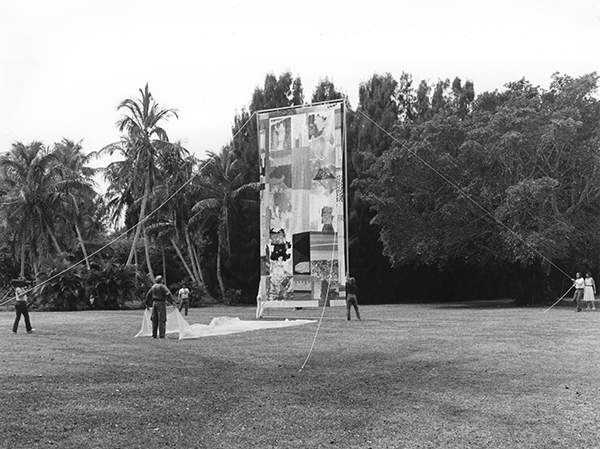 Rauschenberg unveiling Casino / ROCI MEXICO, Captiva, Florida, 1985. Photo: Terry Van Brunt
Rauschenberg unveiling Casino / ROCI MEXICO, Captiva, Florida, 1985. Photo: Terry Van Brunt

 Rauschenberg and a Tibetan official at the opening ceremony for ROCI TIBET, Revolutionary Exhibition Hall, Lhasa, December 5, 1985. Photo: Thomas Buehler
Rauschenberg and a Tibetan official at the opening ceremony for ROCI TIBET, Revolutionary Exhibition Hall, Lhasa, December 5, 1985. Photo: Thomas Buehler
1986
Collaborates with engineers Billy Klüver and Per Biorn on a large sculptural monument dedicated to U.S. Senator Jacob K. Javits (R-N.Y.) to be installed in the main hall of the Jacob K. Javits Conference Center, New York. Planned as an interactive work consisting of large rectangular panels whose movement can be controlled by the viewer, the project is ultimately vetoed by the building’s architects.
Begins Bellini series (1986–89), a group of photogravures published by Universal Limited Art Editions (ULAE), West Islip, New York, in editions ranging from thirty-six to fifty, appropriating imagery of the Virtues—including Fortune, Truth, and Justice—from small panels painted by the Venetian Renaissance artist Giovanni Bellini (ca. 1430–1516), combined with contemporary urban imagery. Rauschenberg’s Trilogy from the Bellini Series (1987), a unigraph consisting of three sheets of hand-colored photogravures, will be published by ULAE in an edition of three. Some of the proofs are further colored with washes.
Begins Shiner series (1986–93). Rauschenberg silkscreens his photographs onto large sheets of stainless steel as well as mirrored and anodized aluminum and attaches other metallic objects, such as car grilles and silver-leafed chairs.
January 6: Time magazine issue with cover designed by Rauschenberg. The magazine features Deng Xiaoping as Man of the Year, and the cover design is a collage using photographs of the Chinese leader and Rauschenberg’s own photographs of China. In 1989, Rauschenberg will win a Merit Award at the Dimensional Illustrators Awards Show, Dimensional Illustrators, New York, for this design.
[Spring]: Begins Glut series (1986–89/1991–94) that results from his recent experiences in Texas, where he became aware of how a glut of oil on the market caused a marked negative effect on the state’s economy. The first works incorporate gasoline-station signs, license plates, and street signs found in Captiva. Rauschenberg makes a small related series of Glut Books (1986), three works in scrap metal derived from gas-station signs that indicate the cost of fuel.
April 18–May 6: Rauschenberg: The White and the Black Paintings 1949–1952, Larry Gagosian Gallery, New York.
June: Receives Artie Award for avant-garde achievers, Franklin Furnace, New York, on the occasion of its tenth birthday, with Lily Tomlin presiding. Vito Acconci, Laurie Anderson, Eric Bogosian, Richard Foreman, Tehching Hsieh and Linda Montano, Allan Kaprow, the Kipper Kids, Leo Lionni, Lydia Lunch, Lisa Lyon, the Mastfor II Co., F. T. Marinetti, Pat Oleszko, Yoko Ono, Nam June Paik and Charlotte Moorman, Michael Smith, Redy Story, William Wegman and Man Ray, and Paul Zaloom also receive awards.
June 28: Receives Golden Plate Award, American Academy of Achievement, Washington, D.C., presented at the Twenty-fifth Anniversary Salute to Excellence.
September 14: Receives Award for Excellence in International Cultural Interchange, World Print Council, San Francisco, for long-term contributions to international understanding through collaborative projects. The award is presented by Japanese Minister Naohiro Kumagai at the New American Paperworks conference, Art Gallery at the University of Maryland, College Park.
Fall: Creates Art Car-BMW (1986), commissioned by BMW, by applying silkscreened decals—of images from artworks in the collection of the Metropolitan Museum of Art, New York, and from his own photographs—to a BMW 635 CSi. In 1988, he will make a series of paintings entitled Beamer, using acrylic and silkscreen ink on vinyl film on enameled aluminum with the silkscreens made for Art Car-BMW.
October 24–December 6: Robert Rauschenberg: Drawings 1958–1968, Acquavella Contemporary Art, New York.
November 22–December 28: Rauschenberg Overseas Culture Interchange: ROCI JAPAN, Setagaya Museum of Art, Tokyo. The exhibition includes Japanese Recreational Clayworks (1982–83/1985) and Japanese Clayworks (1982–83/1985), as well as a body of work made specifically for the exhibition from which the show takes its title, ROCI JAPAN, a series the artist began in 1984 and later revisits in 1987.

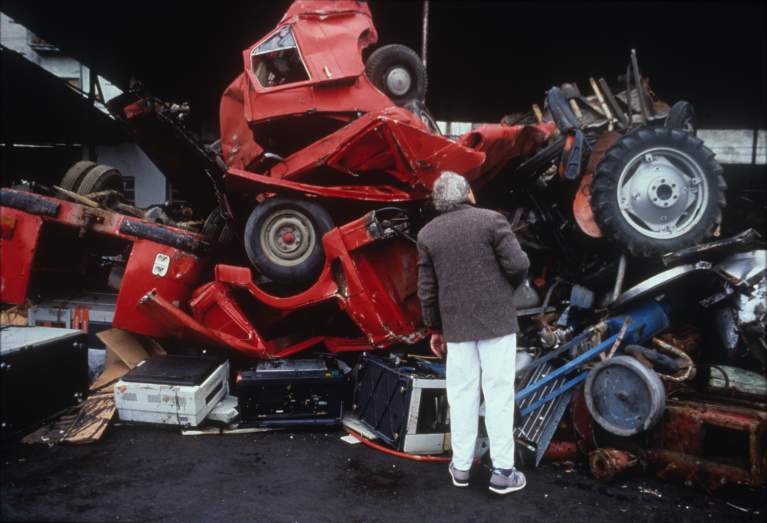 Rauschenberg in a junkyard looking for source material for his Gluts series, Naples, Italy, December 1986. Photo: Peppe Avallone
Rauschenberg in a junkyard looking for source material for his Gluts series, Naples, Italy, December 1986. Photo: Peppe Avallone
1987
Commissioned by chef Wolfgang Puck to design wine labels for his Hollywood restaurant Spago.
Creates Tibetan Keys and Tibetan Locks series, the former comprised of three-dimensional, powder-coated metal objects, and the latter comprised of powder-coated wall reliefs, both with photoscreened decals and hand painting, published by Gemini G.E.L., Los Angeles.
January 2: Provides substitute set, costumes, and lighting for Trisha Brown Dance Company’s Lateral Pass (1985), which is performed in Naples, Italy, as part of the Teatro di San Carlo’s twenty-fifth anniversary celebration festivities. The original set, designed by Nancy Graves, does not arrive as it was delayed in an overseas shipment. Rauschenberg, who is in Naples to see the company’s performance, collects scrap metal and fabric and creates a temporary replacement set of hanging sculptures. Pieces of the set will later be incorporated into the Glut series (1986–89/1991–94), referred to as Neapolitan Gluts.
February 3, 1987–January 3, 1988: Exhibition of selections from The 1/4 Mile or 2 Furlong Piece (1981–98) opens at the Metropolitan Museum of Art, New York. Eighty-one units are on view, inaugurating the Helen and Milton A. Kimmelman Gallery of the new Lila Acheson Wallace wing.
March 30: Time magazine issue with cover designed by Rauschenberg to accompany feature article “Change the Weather: America’s Agenda after Reagan” by Lance Morrow.
April 27: Receives Third Annual Infinity Award for Art, International Center of Photography, New York, for his use of photography in mixed-media artworks.
May 6: Honored with Florida Arts Recognition Award, Florida Arts Council and the Florida Department of State, Tallahassee, for a unique and significant commitment to the arts in Florida.
August: Travels throughout Cuba conducting research and taking photographs in preparation for the Rauschenberg Overseas Culture Interchange project.
September 22: Testifies before Senate Judiciary Committee, Washington, D.C., at confirmation hearing for Robert H. Bork’s nomination to the Supreme Court, expressing his fear that Bork’s interpretation of the First Amendment endangers all forms of creative expression. Rauschenberg states: “I have discovered a compulsive insistence on the letter of the law and abuse to the exceptional and the minorities. If this country is to remain the enviable land of growth and promise, that’s what has to be gardened.”1 Novelist William Styron also testifies against the nomination.
November: Artnews eighty-fifth-anniversary issue with cover designed by Rauschenberg.
Late fall: Begins Bleacher Series (1988–91). The works evolve during experiments in drying black-and-white photographs made with a large-format Polaroid camera. All of the images in this series are re-photographs of Rauschenberg’s earlier photographs. Using bleach and selectively applying print coater on the Polaroid film, Rauschenberg manipulates the fading of the images. The finished works are mounted on aluminum supports.
December 5: Receives Challenge Award for Excellence in Art, Foundation of Children with Learning Disabilities, New York.
- 1. Quoted in “Panel Hearing on Bork as Justice: Professors and Artists Voice Their Views,” New York Times, Sept. 23, 1987, sec. A, p. 28.

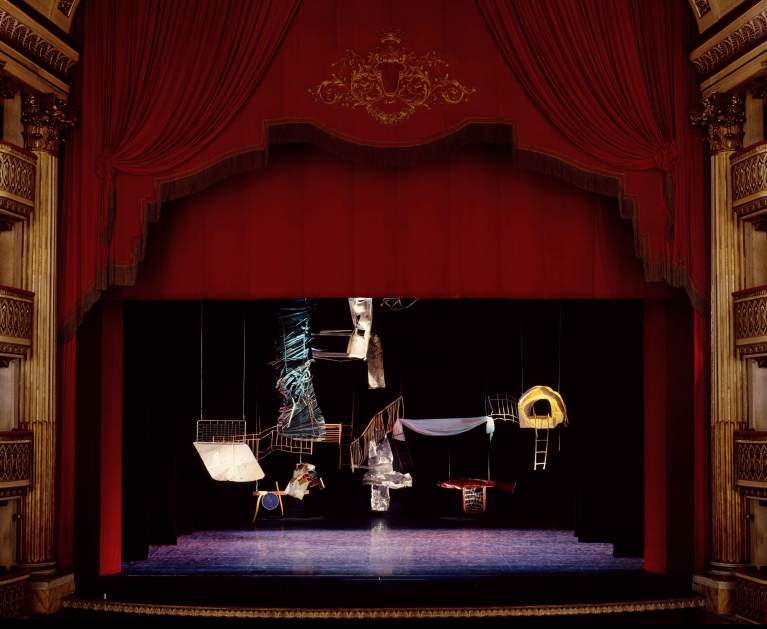 Set designed by Rauschenberg for Trisha Brown Dance Company’s Lateral Pass (1985), Napoli Teatro di San Carlo, Naples, January 1987. Photo: Luciano Romano
Set designed by Rauschenberg for Trisha Brown Dance Company’s Lateral Pass (1985), Napoli Teatro di San Carlo, Naples, January 1987. Photo: Luciano Romano
1988
January: Begins Galvanic Suite (1988–91), a series of images silkscreened with paint on stainless and galvanized steel.
January 14: Gathers with exhibiting artists, Marisol, and gallerist Bruce Helander, at the opening for the exhibition, Five Floridians (on view through February 10), Helander Gallery, Palm Beach, Florida. The five Florida artists include: John Chamberlain, Duane Hanson, Jules Olitski, Rauschenberg, and James Rosenquist.
February: Begins Urban Bourbon series (1988–96), comprised of images silkscreened with expressionistic brushstrokes—in bright blue, green, red, yellow, and orange acrylic—on enameled, mirrored, and anodized aluminum.
February 10–April 3: Rauschenberg Overseas Culture Interchange: ROCI CUBA, Museo Nacional de Bellas Artes, Castillo de la Fuerza and Casa de las Américas, Galleria Haydee Santa María, Havana. ROCI CUBA is a series of paintings on aluminum and steel executed in vivid primary colors, resembling pre-1959 American cars commonly seen in Havana and created specifically for the exhibition as part of the ROCI project. Some viewers feel that the works do not celebrate the complete history of Cuba, but during a forum for students and the public as part of ROCI CUBA, Rauschenberg counters: “To break down barriers, I think you need to see as an alien does—to get lost in the city, or in the country, to see things in Cuba that maybe you are blind to.”1 Rauschenberg is required to send works through Mexico and then to Cuba, due to U.S. policy. Premier Fidel Castro honors Rauschenberg with an official dinner at the Palacio de la Revolución, Havana, the evening before the exhibition opens.
April: Travels to the Union of Soviet Socialist Republics (USSR) to meet with the Minister of Culture and representatives from the Artists’ Union in Moscow in preparation for the ROCI project.
July: Travels to Leningrad, Tbilisi, and Samarkand in preparation for the ROCI project.
September–October: Creates several prints and posters: an offset lithograph for the International Anti-Apartheid Conference, Athens, which will be held in May 1989; a poster for the New Music American Festival, Miami, dedicated to the memory of Morton Feldman; a print and poster for the International Association of Art (IAA), an organization that works in partnership with the United Nations Educational, Scientific and Cultural Organization (UNESCO), for the latter’s 1989 World Congress in Madrid on the protection of artists’ rights; and a screenprint, Dallas Cares, in an edition of 500, for the Dallas AIDS Benefit.
November 10: Rebus (1955) sells at Sotheby’s auction, New York, to a private collector for $5,750,000, the largest sum to date reached at auction for a Rauschenberg work. The painting will subsequently be sold for $6,600,000 at a Sotheby’s auction, New York, on April 30, 1991, and is now in the collection of the Museum of Modern Art, New York.
- 1. Quoted in Kotz, Rauschenberg, p. 37. From unpublished transcript of ROCI CUBA forum for students and public, Museo Nacional de Bellas Artes, Havana, Feb. 6, 1988.

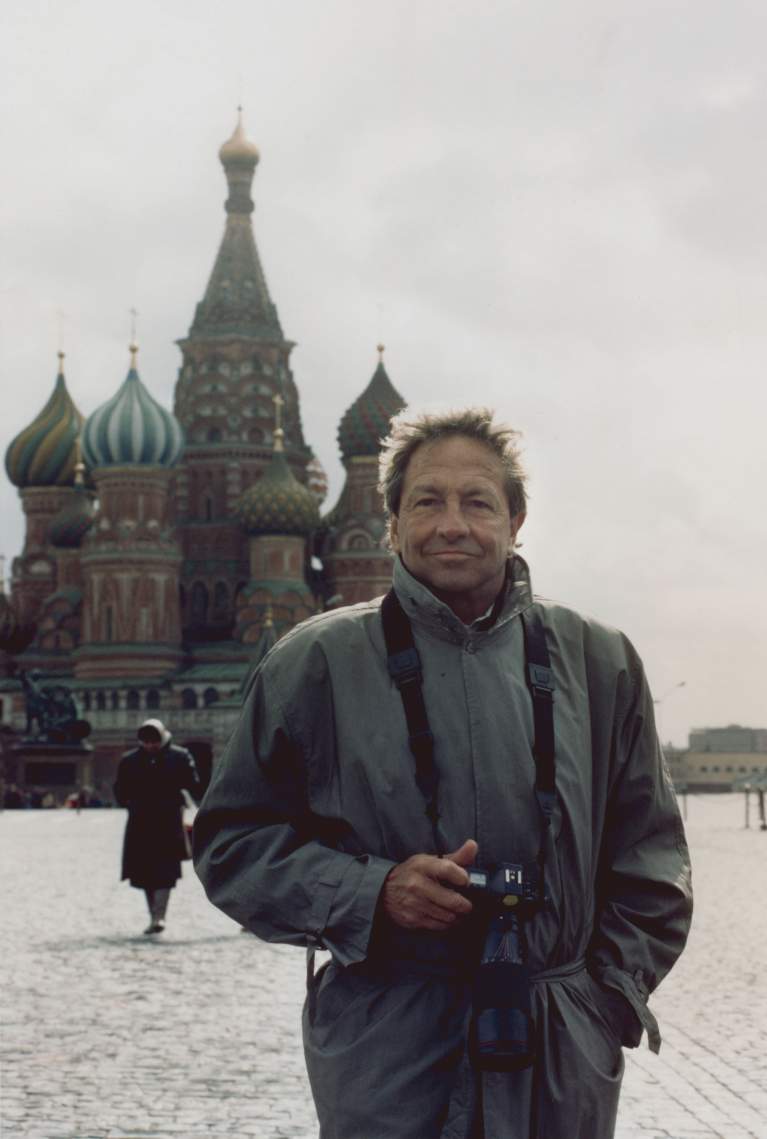 Rauschenberg in Red Square, Moscow, during a research trip for ROCI USSR, April 1988. Photo: Donald Saff
Rauschenberg in Red Square, Moscow, during a research trip for ROCI USSR, April 1988. Photo: Donald Saff
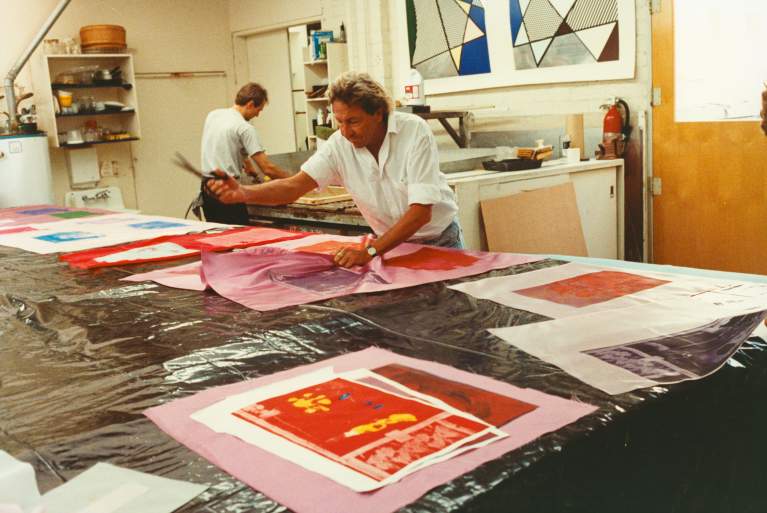 Rauschenberg and Ken Farley working on Samarkand Stitches series at Gemini G.E.L., Los Angeles, November 1988. Photo: Sidney B. Felsen
Rauschenberg and Ken Farley working on Samarkand Stitches series at Gemini G.E.L., Los Angeles, November 1988. Photo: Sidney B. Felsen
1989
Elected member of the National Advisory Council, National Society of Arts and Letters, Washington, D.C.
Begins Borealis series (1989–92). Applying tarnishing agents, such as acetic acid and ammonium salts, with a gestural stroke onto images silkscreened on sheets of brass, bronze, and copper, Rauschenberg creates what he called “corrosions.” The corrosive nature of the tarnishes results in a restrained, yet luminous, tonal range that varies from green to brown to black, depending on the metal support.
January 11: Awarded Medal of Honor for Visual Arts, National Arts Club, New York, for an outstanding contribution to art.
February 1–4: Concurrent with the opening of Rauschenberg Overseas Culture Interchange: ROCI USSR, Trisha Brown Dance Company’s Astral Convertible (1989), commissioned by the Montpellier Festival in France, previews at the Cultural Palace, Moscow. According to Per Biorn, an engineer who collaborated on the set, the company was the first modern dance group to perform in Moscow since the 1917 revolution. Rauschenberg designed the set and costumes, and Richard “Dickie” Landry composed the music. At Brown’s request, Rauschenberg created a portable, self-contained system of set, sound, and lighting. With the assistance of Biorn and engineer Billy Klüver, Rauschenberg constructed eight freestanding aluminum towers, which range from two to eight feet in height and are equipped with sensors, powered by car batteries, that detect dancers’ movements and trigger sound (Landry’s soundtrack of music and traffic noises) and lights (a system of headlights designed by Ken Tabachnick). Biorn recounts that Rauschenberg intended for the set to invoke a forest or field.1 Brown explains that Rauschenberg titled the performance in reference to the car parts he used as well as to “passage through the sky. And ‘convertible,’ [Rauschenberg] said, was to permit whatever changes [he] wanted to make.”2 The company also performs Glacial Decoy (1979) and Set and Reset (1983).
February 2–March 5: ROCI USSR, Central House of Artists, Moscow. Works exhibited include Soviet / American Arrays (1988–90), the artist’s series of photogravures that include a combination of Soviet and American imagery, published by Universal Limited Art Editions (ULAE), West Islip, New York, as well as Samarkand Stitches (1988), a suite of wall hangings made from silkscreened sewn fabric, published by Gemini G.E.L., Los Angeles. This is the first solo exhibition of a Western post–World War II artist in the Union of Soviet Socialist Republics (USSR). More than 145,000 people attend the exhibition. As poet Yevgeny Yevtushenko writes in the ROCI USSR catalogue, “For us his exhibit is one of the symbols of a spiritual perestroika of our society.”3 Donald Saff will later describe the opening day: “They were lifting and touching many of the works, especially Dirt Shrine with its ceramic chain. . . . The Soviets wanted to have a tactile relationship with the art.”4 Concurrent with the ROCI USSR exhibition, a group of young, non-union Soviet artists organized an exhibition of their own work in tribute to Rauschenberg’s arrival in Moscow. Entitled Rauschenberg to Us, We to Rauschenberg, it is the inaugural exhibition of Moscow’s first commercial gallery, which will become known as the First Gallery. The Soviet Minister of Culture will select works from Rauschenberg to Us, We to Rauschenberg to represent the USSR at the Forty-fourth Venice Biennale, in 1990.
February 17–April 22: Art in Europe and America: The 1950s and 1960s, Wexner Center for the Visual Arts, Ohio State University, Columbus. Exhibits Memorandum of Bids (1957), Gift for Apollo (1959), and a replacement version of Minutiae (1954), made in 1976 under the artist’s supervision.
March 14: Premiere of Trisha Brown Dance Company’s Astral Convertible, New York City Center. Set and costumes by Rauschenberg, with set, sound, and lighting assistance by Klüver and Biorn.
May: Creates Very Special Arts, an offset lithographic poster with silkscreen, printed by ULAE in an edition of 275, for the 1989 International Very Special Arts Festival, Washington, D.C.
May: Cancels Rauschenberg Overseas Culture Interchange: ROCI BERLIN project due to frustration with East German officials’ resistance to a simultaneous East Berlin–West Berlin installation that all Germans could visit.
June 1: Presented the Learning Through Art Award for important contributions through the ROCI project, Learning to Read Through the Arts Program, Solomon R. Guggenheim Museum, New York, on the occasion of its twentieth anniversary exhibition of children’s artworks.
June 8: Participates in Art in Embassies symposium, U.S. State Department, Washington, D.C.
June 20: Awarded Fifth Annual Florida Prize for Excellence in the Arts, New York Times Regional Newspapers in Florida, Tallahassee, presented by Florida Governor Bob Martinez and given to a Florida resident who excels in the visual and performing arts.
September 16–October 3: Travels to Malaysia in preparation for the ROCI project. He attends the inauguration ceremony for the new king; visits local tribes, including a tribe of headhunters; and witnesses a cockfight. In Sarawak, Borneo, he buys hundreds of “Save the Forest” T-shirts and bamboo bracelets hoping to help people whose livelihoods as hunters are being destroyed along with the rain forests.
November: With the dismantling of the Berlin Wall, Wolfgang Polak, director of the Zentrum für Kunstausstellungen der Deutsche Demokratische Republik, immediately contacts Rauschenberg to reinitiate arrangements for ROCI BERLIN. Rauschenberg travels to the city to gather materials for the project. The ROCI BERLIN series of paintings with silkscreen on plywood are completed for the exhibition in the following year.
November 5: Receives Algur H. Meadows Award for Excellence in the Arts, Meadows School of the Arts, Southern Methodist University (SMU), Dallas. Receives a cash prize of $50,000 and a limited edition of the Isamu Noguchi sculpture Spirit’s Flight (ca. 1970). The Meadows Museum at SMU holds an exhibition of his paintings and prints in honor of the occasion, November 2–25. For the first time, a lecture series is organized in conjunction with the award, entitled “Images: Between Art and Life.”
November 8: Awarded diploma, World Cultural Council, Cambridge, Massachusetts.
- 1. Per Biorn. “First-Hand: The Saga of ‘Astral Convertible.’” IEEE Global History Network, n.d. Accessed Sept. 25, 2014. http://www.ieeeghn.org/wiki/index.php/First-Hand:The_Saga_of_%22Astral_Convertible%22.
- 2. Trisha Brown, quoted in Jennifer Dunning, “A Set to Upstage the Dancers,” New York Times, March 14, 1989, sec. C, p. 17.
- 3. Yevgeny Yevtushenko, in Rauschenberg Overseas Culture Interchange, p. 52. Originally published in Rauschenberg Overseas Culture Interchange: ROCI USSR, exh. cat. (Moscow: Central House of Artists, 1989) [in Russian].
- 4. Quoted in Rauschenberg and Saff, “A Conversation about Art and ROCI,” p. 171.

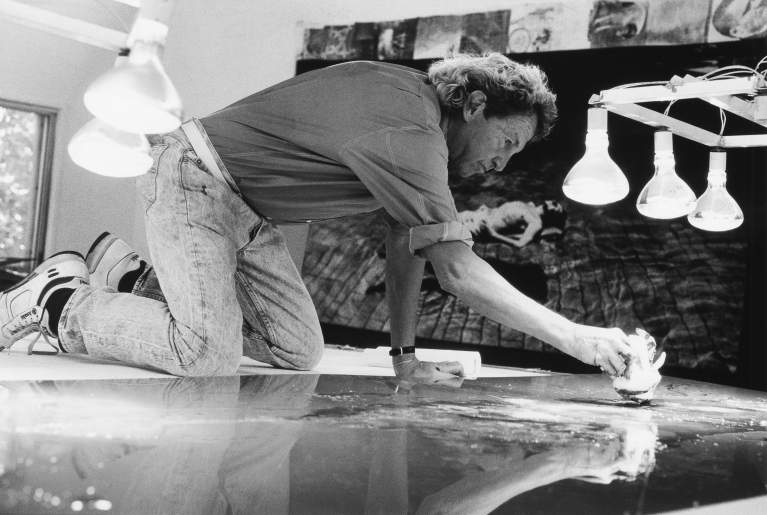 Rauschenberg working on a metal painting in his Laika Lane studio, Captiva, Florida, 1989. Photo: Gianfranco Gorgoni
Rauschenberg working on a metal painting in his Laika Lane studio, Captiva, Florida, 1989. Photo: Gianfranco Gorgoni


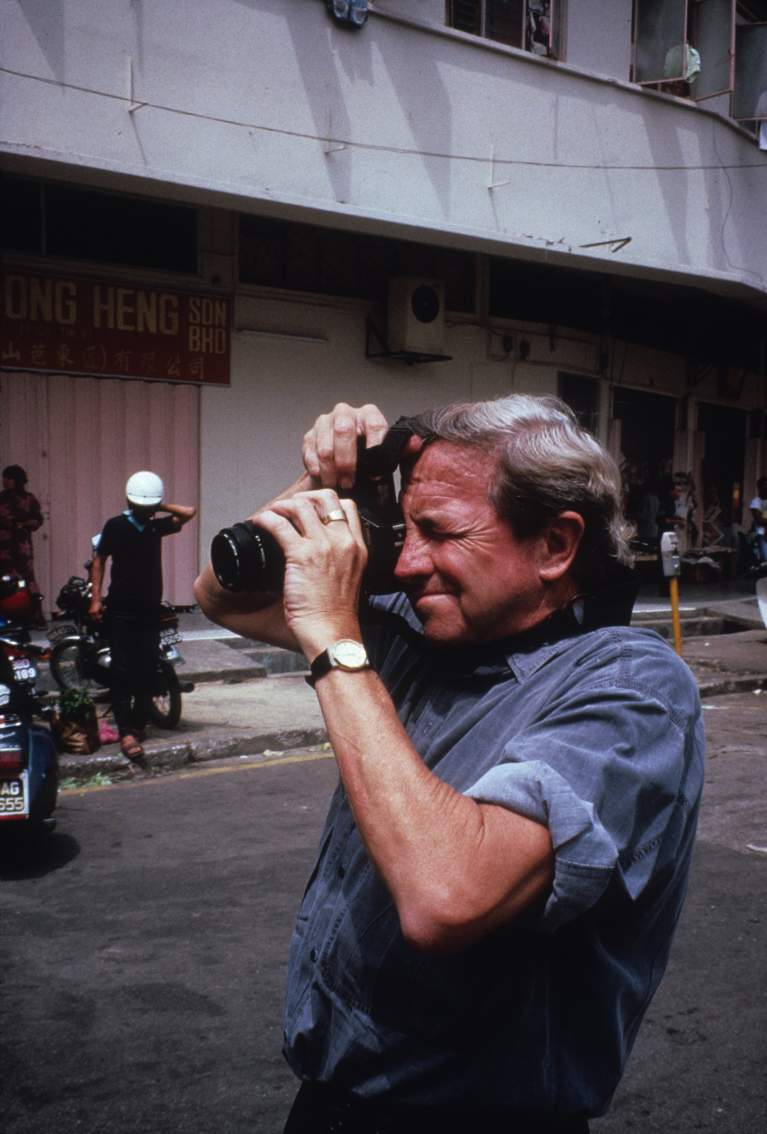 Rauschenberg taking photographs in Kuala Lumpur during a research trip for ROCI MALAYSIA, September 1989. Photo: Terry Van Brunt
Rauschenberg taking photographs in Kuala Lumpur during a research trip for ROCI MALAYSIA, September 1989. Photo: Terry Van Brunt
1990-99
1990
The Robert Rauschenberg Foundation, New York, a nonprofit organization devoted to philanthropic issues of particular interest to Rauschenberg, including the arts, education, the environment, the homeless, medical research, and world hunger, is founded. No monetary grants are awarded in Rauschenberg’s lifetime, but organizations such as the Best Buddies International and programs of the Cathedral of Saint John the Divine, New York, benefited from the donation of prints and posters created by Rauschenberg.
February: Creates American Way Print in an edition of seventy-five to benefit People for the American Way, a liberal lobbying group.
February 1–March 3: Robert Rauschenberg: Paintings 1962–1980, Lang and O’Hara Gallery, New York. The exhibition will travel to Runkel-Hue-Williams, London, May 3–June 7.
March–May: Makes works for the Rauschenberg Overseas Culture Interchange: ROCI MALAYSIA exhibition.
March 10–April 1: Rauschenberg Overseas Culture Interchange: ROCI BERLIN, Neue Berliner Galerie, Altes Museum, Berlin.
April: Receives Editorial Award for Commitment to Excellence, Metropolitan Home Design 100, New York.
April 22: Twentieth anniversary of Earth Day for which Rauschenberg creates his second Earth Day screenprint, published by Gemini G.E.L., Los Angeles, in an edition of seventy-five.
April 24: Presents John Cage with Skowhegan Medal for Alternate Genre, Skowhegan School of Painting and Sculpture, Maine, at the Plaza Hotel, New York.
May 15: Testifies before Senate Appropriations Subcommittee on the Interior, Washington, D.C., for continued funding of the National Endowment for the Arts.
May 21–June 24: ROCI MALAYSIA, Balai Seni Lukis Negara (National Art Gallery), Kuala Lumpur. The works reveal Rauschenberg’s concern for the country’s conflict between urban and indigenous cultures.
May 27–September 30: Orrery (Borealis) (1990) is exhibited in the pavilion of the Union of Soviet Socialist Republics (USSR) at the 44th Venice Biennale.
May 30–July 6: Robert Rauschenberg: Works on Paper, M. Knoedler, New York.
August: Makes Borealis Shares (1990) series, consisting of brass-and-Lexan chairs that are attached to brass panels, which have been hand painted with acids and salt patinas; these are then silkscreened with photographic imagery using epoxy inks. The series includes only two works. Gemini G.E.L. publishes twenty-six unique versions of each.
[Fall]: Creates Shirtboard series, composed of facsimiles of collages from Rauschenberg’s North African Collage series from 1952, in a format fifty-percent larger than the originals. The series is hand printed at Styria Studio, New York, in an edition of sixty-five in 1991.
Fall: U.S. Congress passes legislation that Rauschenberg has advocated for, providing artists with better copyright protection and opportunities for compensation in the event of the destruction or mutilation of their work.
September 20: Honored by the chair of the Texas Commission of the Arts, Margaret Mills, for his “immense contributions to the arts, humanity and world culture.”105
September 22: Premiere of Trisha Brown Dance Company’s Foray Forêt, Biennale de la Danse, Lyon, for which Rauschenberg designed the set and costumes. The male dancers wear matte-gold skirt-pants, their chests bare, while the female dancers wear glimmering gold outfits. During the performance, a local brass band plays while marching outside the theater.
October: Begins to make works for Rauschenberg Overseas Culture Interchange: ROCI USA. The majority are from the Wax Fire Works series (1990–91), created in association with Saff Tech Arts, Oxford, Maryland. They are made using a technique Rauschenberg coined “fire wax,” in which wax, containing pigment, is painted or silkscreened onto polished aluminum supports and fixed using heat, as in traditional encaustic painting.
October: Completion of new house, known as the Gulf House, designed by Rauschenberg and Darryl Pottorf in Captiva, Florida.
October 3, 1990–January 15, 1991: High and Low: Modern Art and Popular Culture, organized by Kirk Varnedoe and Adam Gopnik, Museum of Modern Art, New York.
October 12–November 24: Robert Rauschenberg: Gluts, Feigen, Chicago.
November: Mary Lynn Kotz’s monograph, Rauschenberg: Art and Life, is published by Harry N. Abrams, New York.
December 7, 1990–March 17, 1991: Robert Rauschenberg: The Silkscreen Paintings, 1962–64, organized by Roni Feinstein, Whitney Museum of American Art, New York.
- 105. Robert Rauschenberg Archives, Robert Rauschenberg Foundation. See also H.R. 245, State of Texas House of Representatives and S.R. 233, Texas Senate.

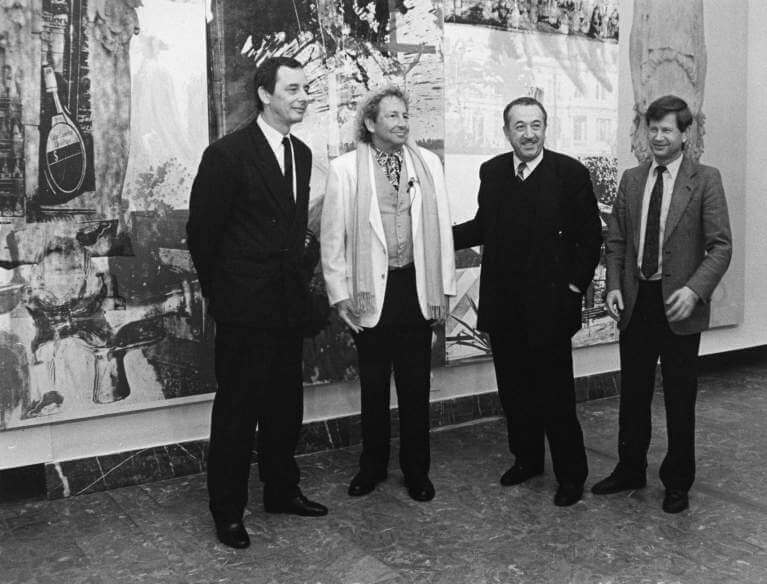 Rauschenberg with Dr. Dietmar Keller, Minister of Culture of the German Democratic Republic (left), and Tahir Salakhov (right), ROCI BERLIN, Neue Berliner Galerie im Alten Museum, March 1990. Photo: Elfriede Schönborn
Rauschenberg with Dr. Dietmar Keller, Minister of Culture of the German Democratic Republic (left), and Tahir Salakhov (right), ROCI BERLIN, Neue Berliner Galerie im Alten Museum, March 1990. Photo: Elfriede Schönborn

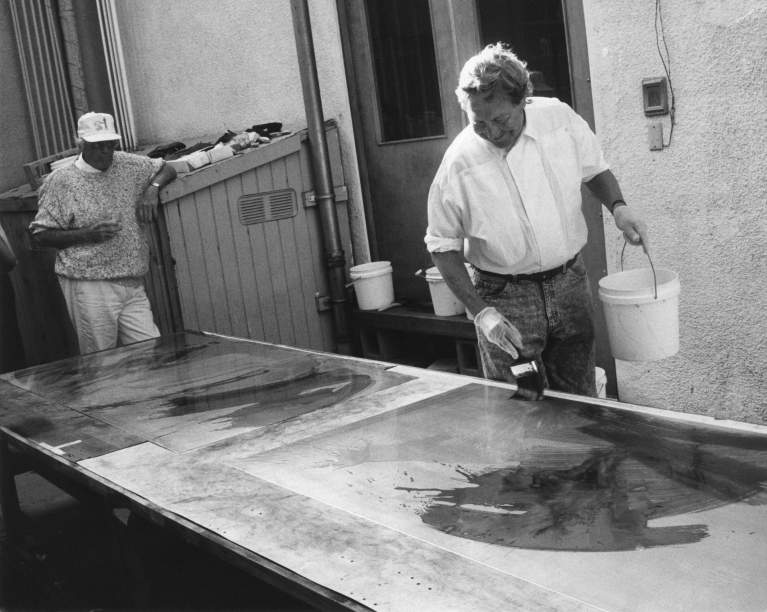 Rauschenberg working on Borealis Shares while talking to Gregory Peck, Gemini G.E.L. courtyard, Los Angeles, August 1990. Photo: Sidney B. Felsen © 1990
Rauschenberg working on Borealis Shares while talking to Gregory Peck, Gemini G.E.L. courtyard, Los Angeles, August 1990. Photo: Sidney B. Felsen © 1990

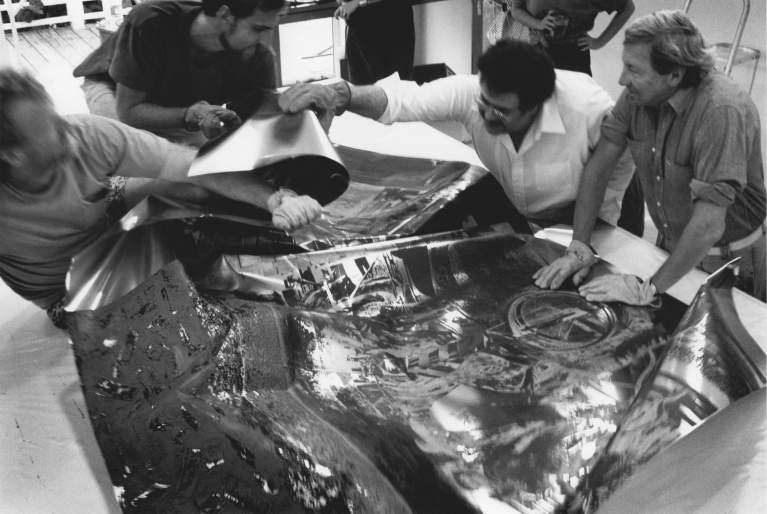 Rauschenberg in his Laika Lane studio with Graphicstudio staff Patrick Foy, Tom Pruitt, and Donald Saff, working on In-Dependents/ROCI USA (Wax Fire Works) (1990), Captiva, Florida, 1990. Courtesy of Saff Tech Arts. Photo: George Holzer
Rauschenberg in his Laika Lane studio with Graphicstudio staff Patrick Foy, Tom Pruitt, and Donald Saff, working on In-Dependents/ROCI USA (Wax Fire Works) (1990), Captiva, Florida, 1990. Courtesy of Saff Tech Arts. Photo: George Holzer
1991
Creates Illegal Tender L.A. series, which are lithographs made from inkjet transfers, published by Gemini G.E.L., Los Angeles.
Makes Spartan series, a nearly monochromatic body of work produced with acrylic silkscreened on enameled or anodized aluminum.
February 25: Returns to his hometown, Port Arthur, Texas, where he is recognized by the State of Texas and Governor Ann Richards for his contribution to twentieth-century art. Rauschenberg in turn donates Can House (Night Shade) (1991) to the Port Arthur Historical Society in honor of Richards. It will be displayed as part of the Robert Rauschenberg Collection at the Museum of the Gulf Coast, Port Arthur. This day in 1991 is proclaimed “Robert Rauschenberg Day” by Port Arthur Mayor Mary Ellen Summerlin.
April: Inducted into Florida Artists Hall of Fame, Tallahassee, by Florida Secretary of State Jim Smith.
May 12–September 2: The final Rauschenberg Overseas Culture Interchange (ROCI) exhibition, Rauschenberg Overseas Culture Interchange: ROCI USA, National Gallery of Art, Washington, D.C. All ROCI works, inspired by the eleven host countries, are exhibited. A selection of Rauschenberg’s photographs taken during his travels is also included, and travelogue videos made by members of his team run continuously on monitors throughout the show.
May 14: Premiere of Trisha Brown Dance Company’s Astral Converted (50"), the first choreographic commission by the National Gallery of Art. The work reuses Rauschenberg’s set for Astral Convertible (1989) and is performed on the steps outside the museum. The performance marks the first collaboration among Rauschenberg, Brown, and John Cage, who composed the music.
June 15–August 11: Robert Rauschenberg: The Early 1950s, organized by the Menil Collection, Houston, and the Corcoran Gallery of Art, Washington, D.C. The exhibition, curated by Walter Hopps, originates at the Corcoran and will travel to the Menil Collection; Museum of Contemporary Art, Chicago; San Francisco Museum of Modern Art; and Guggenheim Museum SoHo, New York. Works from 1949 to mid-1954, some of which have never before been exhibited or published, are included.
June 16: Interviewed by Pat Mitchell for the CBS television program Sunday Morning.
[Summer]: Works on Night Shade series, in which photographic images are silkscreened onto brushed aluminum with acrylic washes. The overall tone ranges from dark gray to black with a tarnished effect similar to the Borealis series (1989–92).
Makes Phantom series using clear epoxy and acrylic to silkscreen Rauschenberg’s photographs onto mirrored aluminum surfaces. In the process, color disappears almost entirely and the images are rendered pale and ghostlike.
September 14–October 27: Robert Rauschenberg 1974–1991: Animals and Other Themes, City Gallery of Contemporary Art, Raleigh, North Carolina.
Fall: Grand Street publishes issue with portfolio of seven works created by Rauschenberg from his own photographs, silkscreened on paper, and overlaid with acrylic washes.1
October 8: Awarded Medal of Merit, Lotos Club, New York, for outstanding achievement in the arts.
October 26–December 7: Robert Rauschenberg: Print Survey in Themes, 1952–1992, with related performance videos, Leo Castelli, West Broadway and Broadway locations, New York.
December 6: Presents at the United Nations, New York, the lithograph Last Turn—Your Turn, published by the Robert Rauschenberg Foundation, New York, in an edition of 200. The work was created to generate awareness of Earth Summit, the United Nations Conference on Environment and Development, which will be held in Rio de Janeiro, June 1–12, 1992. The print will also be produced as a color offset poster.
- 1. Robert Rauschenberg, “A Portfolio of Seven Drawings,” Grand Street (New York) no. 38 (Autumn 1991), pp. 57–92.

 Rauschenberg working on his Illegal Tender L.A. series in the Gemini G.E.L. workshop, Los Angeles, September 1991. Photo: Sidney B. Felsen © 1991
Rauschenberg working on his Illegal Tender L.A. series in the Gemini G.E.L. workshop, Los Angeles, September 1991. Photo: Sidney B. Felsen © 1991

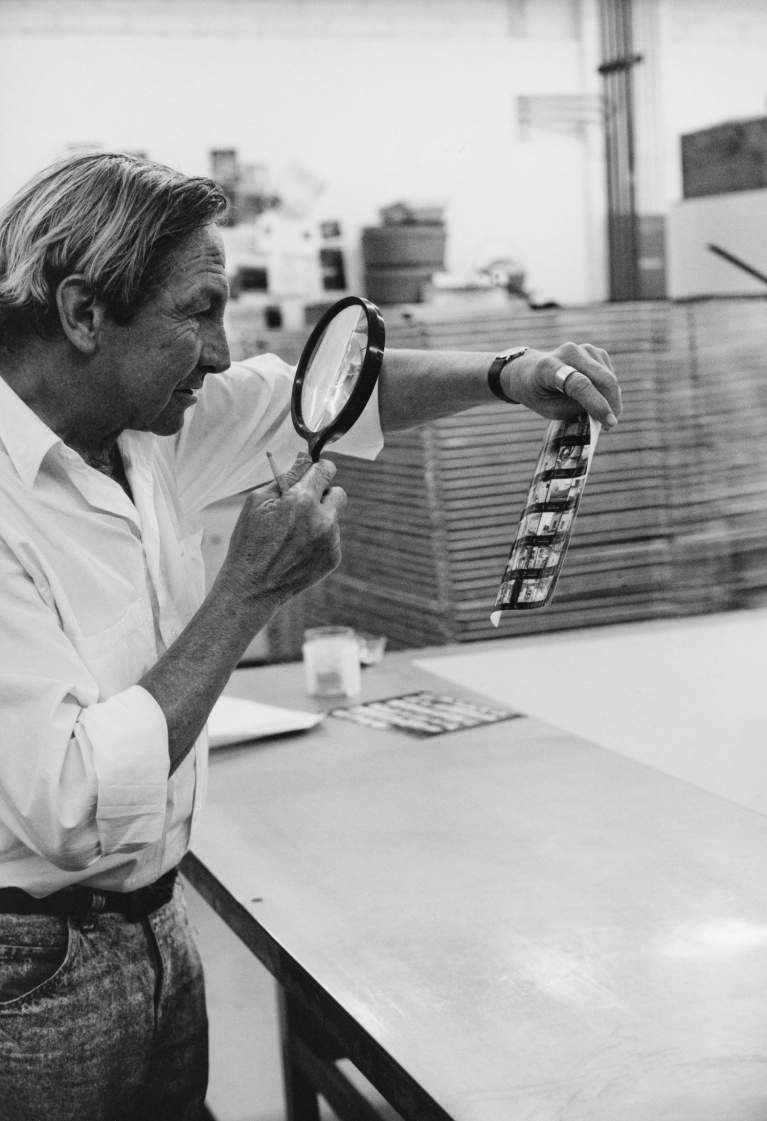 Rauschenberg studying a proof sheet of his photographs at Gemini G.E.L., Los Angeles, 1991. Photo: Sidney B. Felsen
Rauschenberg studying a proof sheet of his photographs at Gemini G.E.L., Los Angeles, 1991. Photo: Sidney B. Felsen

 Rauschenberg’s Ozone Bus Billboard (1991) on a New York City bus
Rauschenberg’s Ozone Bus Billboard (1991) on a New York City bus
1992
Creates For Ferraro, a screenprint published by Gemini G.E.L., Los Angeles, in an edition of 125, for Geraldine Ferraro’s 1992 U.S. Senate campaign in New York.
Begins Waterworks series (formerly titled Day Lights and Night Sights, 1992–95). Using an Iris printer, Rauschenberg makes digital color prints that are then transferred to paper by using water and a stone lithographer’s press. With his heightened interest in caring for the environment, the artist now chose to use water as a solvent as well as biodegradable and soy-based dyes. The artist refers to the process as “vegetable dye transfer.”
Three bus billboards designed by Rauschenberg in 1991 to draw attention to environmental issues—Last Turn—Your Turn (based on the 1991 print of the same title), Ozone, and Pledge (all 1991)—are displayed on buses in major U.S. cities.
Produces five etchings for the ongoing publication The First Meeting of the Satie Society, a literary, visual, and musical tribute to French composer Erik Satie, conceived by John Cage, which will be published in 1994. At Universal Limited Art Editions (ULAE), West Islip, New York, the etchings are printed on sheets of Cage’s mesostic poem “Musikus.” Stephen Bastian, Cage, Jasper Johns, Sol LeWitt, Robert Ryman, and Michael Silver also contribute artworks.1
Begins Bicycloid series (1992–94), a sculptural series in which each work consists of a vintage bicycle outlined with colored neon tubing mounted on an aluminum base.
Starts Street Sounds (1992–93/1995), a series of intaglio prints with photogravure published by ULAE. The Street Sounds were made in 1992, the Street Sounds West in 1993, and the Street Sounds East in 1995.
Makes Windward Series, comprising acrylic, solvent transfer, and graphite on paper.
January 28: Receives Federal Design Achievement Award, a quadrennial design award given by the National Endowment for the Arts, Washington, D.C., for the exhibition catalogue Rauschenberg Overseas Culture Interchange (1991).
February 1–29: Rauschenberg at Knoedler: Night Shades and New Gluts, M. Knoedler, New York.
March 3: Honored at a benefit dinner hosted by the Natural Resources Defense Council at Tavern on the Green, New York, for his commitment to preserving the environment.
June 3–12: Attends United Nations Conference on Environment and Development (Earth Summit) in Rio de Janeiro, for which he created a bus billboard and a poster, Last Turn—Your Turn (both 1991).
June 12: Named Commandeur de l’Ordre des Arts et des Lettres, Le Ministère de la Culture et de la Communication, Paris.
[After June]: On returning from Earth Summit, begins Eco-Echo series (1992–93), in collaboration with Donald Saff, Saff Tech Arts, Oxford, Maryland. Made with silkscreened and painted aluminum and Lexan, the windmill-like structures are sonar-activated and respond to the presence of a viewer standing near the work.
- 1. John Cage, The First Meeting of the Satie Society (New York: Osiris, 1985–94).


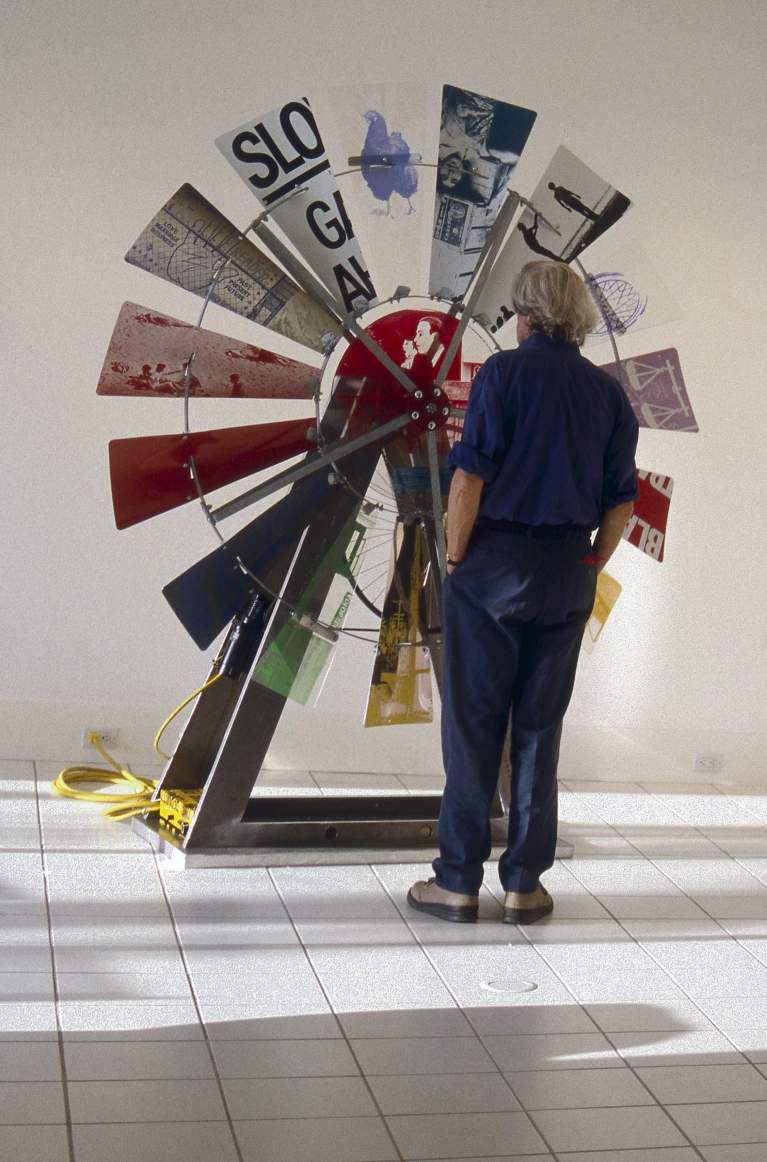 Rauschenberg with Eco-Echo I, 1993. Photo: Donald Saff
Rauschenberg with Eco-Echo I, 1993. Photo: Donald Saff
1993
Contributes design for a limited-edition necktie, sold for $125, to benefit the Foundation for AIDS Research (AMFAR), New York. Randomly cut from fabric silkscreened with Rauschenberg’s photographs, each necktie in the edition of 480 is unique. Sixteen other artists, including Barbara Kruger, Richard Prince, Cindy Sherman, and William Wegman, design clothing and accessories.
Creates poster Charms Against Harm for Médecins du Monde, Paris, a French medical organization.
Makes Double Feature series, a group of lithographs exploring duplication, published by Gemini G.E.L., Los Angeles.
Begins Off Kilter Keys series (1993–94) that consists of wall reliefs made from aluminum sheets folded into sharply creased forms. Areas of the panels are left imageless and are interspersed with, and often hide, other surfaces that are silkscreened with brightly colored paints.
Wins Knight Purchase Award, Akron Art Museum, Ohio, for the use of photographic images in artworks. Rauschenberg is the second artist—Henry Callahan being the first—to receive this award, given annually to a key figure working with photography.
March: Completion of new studio, designed by Rauschenberg and Darryl Pottorf in Captiva, Florida.
April 22: Presented with the first Earth Day Award for Environment and the Arts, IMAGINE magazine, at the National Arts Club, New York.
May 8–June 4: Rauschenberg: Bicycloids, Urban Bourbons + Eco-Echo, M. Knoedler, New York.
September 12–November 28: Participates in Rolywholyover A Circus, an exhibition devoted to the work and ideas of John Cage, at the Museum of Contemporary Art, Los Angeles. The exhibition will travel to the Menil Collection, Houston; Guggenheim Museum SoHo, New York; Contemporary Art Tower, Mito, Japan; and Philadelphia Museum of Art.
September 20: Presents at the United Nations, New York, an untitled print created for Earth Pledge Foundation to promote global awareness at the International Conference on Population and Development, which will be held in Cairo in September 1994.
October 7: Receives National Medal of Arts Award, presented by President Bill and First Lady Hillary Clinton. Rauschenberg is one of thirteen recipients selected by the National Endowment for the Arts, Washington, D.C., for the ninth annual award.
November 2: Presented Second Hiroshima Art Prize, City of Hiroshima, at the Hiroshima Art Museum. This award, which he was granted in October 1992, is given to artists who promote peace and understanding among different cultures. In conjunction with the award presentation, a commemorative exhibition The Second Hiroshima Art Prize—Robert Rauschenberg is held at the museum, November 3, 1993–January 16, 1994. Rauschenberg’s statement regarding his selection reads, “Peace is a fragile ideal; it vaporizes in greed and power. The anatomy of non-aggression is controlled, not by trust but by bureaucracy. (No wonder it doesn’t exist.) People need to know each other to meet their friends. It remains complex to separate control, finance, religion and tradition from a workable understanding. Everyone has to be a part to this struggle if it can move even a small step in a unified direction. Hope is not enough. Generosity, socially and radically, has to be an international fact proven by attitudes and action.”1
November 5, 1993–January 10, 1994: Participates in Roma—New York 1948–1964, An Art Exploration, Murray and Isabella Rayburn Foundation, New York. Exhibits works created from 1950 to 1960, including 22 The Lily White (ca. 1950), collages on Italian shirt boards (ca. 1952), photographs (1952–53), Monk (1955), and an illustration for Dante’s Inferno (1958–60).
- 1. Letter to Mr. Tsutomu Takashima, Aquavella Gallery, New York, Robert Rauschenberg, Captiva Island, Florida, Sept. 9, 1993. Robert Rauschenberg Archives, Robert Rauschenberg Foundation.

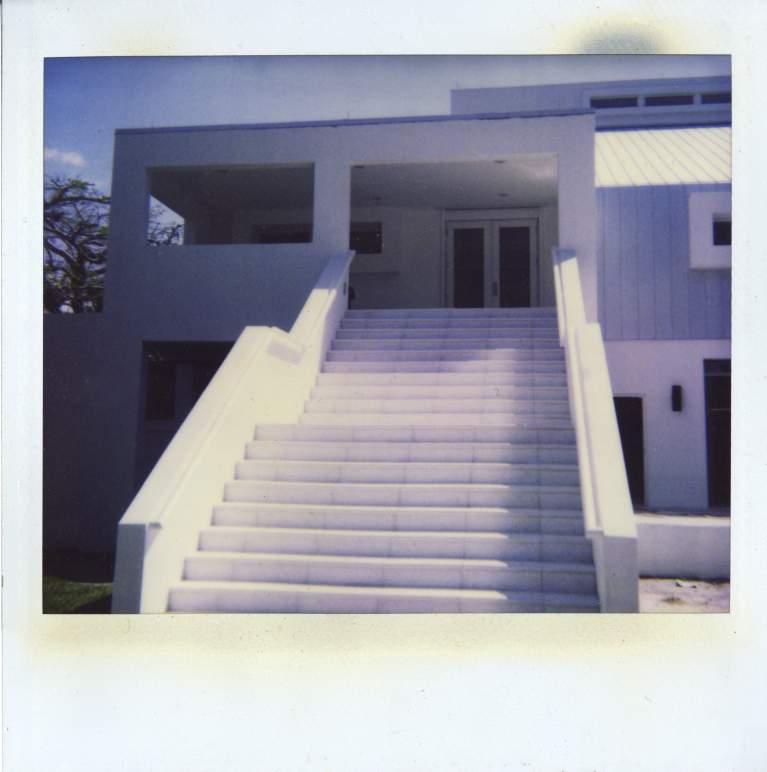 Exterior of Rauschenberg’s Captiva Drive studio, Captiva, Florida, ca. 1993
Exterior of Rauschenberg’s Captiva Drive studio, Captiva, Florida, ca. 1993

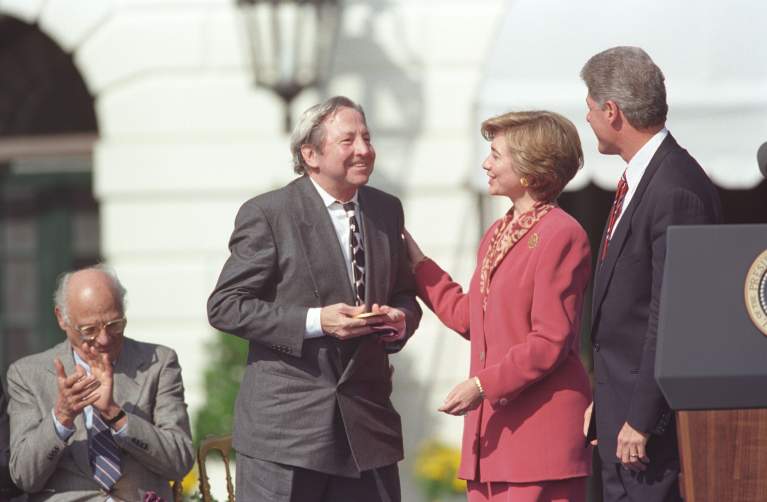 Rauschenberg receiving the National Medal of Arts Award, presented by President Bill Clinton and First Lady Hillary Clinton, White House Lawn, Washington, D.C., October 1993
Rauschenberg receiving the National Medal of Arts Award, presented by President Bill Clinton and First Lady Hillary Clinton, White House Lawn, Washington, D.C., October 1993
1994
Makes offset lithographic poster for Arts for ACT to benefit the Abuse, Counseling, and Treatment Center, Fort Myers, Florida. Founded in 1978, ACT assists victims of rape and domestic violence.
Creates Bulkhead, a print in the Waterworks series (1992–95), to benefit the World Federation of United Nations Associations, New York.
Begins Speculations (1994/1996–97), a series of color screenprints on paper published by Gemini G.E.L., Los Angeles.
February 26–March 26: Rauschenberg: Scores (Off Kilter Keys), Leo Castelli, Broadway and Thompson Street locations, New York.
April 1–May 15: Head On: Image and Text in the Prints of Robert Rauschenberg, Archer M. Huntington Art Gallery, University of Texas, Austin.
May 3: Premiere of Trisha Brown’s solo performance If you couldn’t see me, Joyce Theater, New York, for which Rauschenberg designed Brown’s costume of a white sheath dress, and he composed electronic music. Brown dances with her back to the audience, never permitting a full view of her face.
May 7–July 10: Robert Rauschenberg, organized by Armin Zweite, Kunstsammlung Nordrhein-Westfalen, Düsseldorf, with works from the ROCI (1985–90), Shiner (1986–93), Glut (1986–89/1991–94), Galvanic Suite (1988–91), Urban Bourbon (1988–96), Borealis (1989–92), Phantom (1991), and Night Shade (1991) series.
June 19: Presents fourteenth annual Samuel H. Scripps American Dance Festival Award to Trisha Brown, who performs If you couldn’t see me at the ceremony held at Duke University, Durham, North Carolina.
Late summer: Begins Shales series (1994–95). Using the fire-wax technique developed with Donald Saff, Saff Tech Arts, Oxford, Maryland, Rauschenberg’s photographic images are transferred, using encaustic, to wax-covered canvas. The clarity and depth of the wax medium creates a trompe l’œil effect as if the actual objects are suspended in wax.
September 13: Performance of Merce Cunningham Dance Company’s Events, Joyce Theater, New York, for which Rauschenberg created the set, Immerse, a large unstretched painting. Immerse will be used in all subsequent versions of Events. Rauschenberg and Alex Hay had designed the costumes and props for Cunningham’s first “event” in 1964.

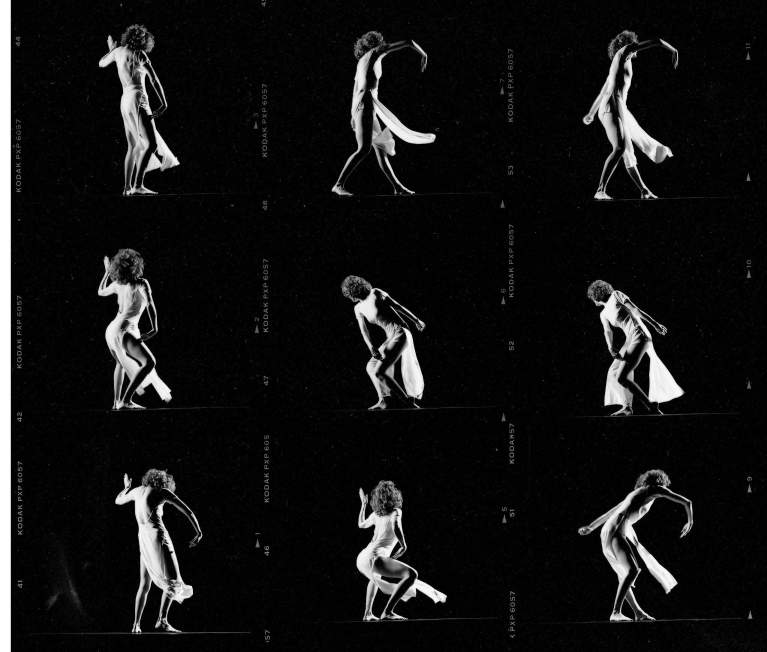 Costume designed by Rauschenberg for Trisha Brown Dance Company’s If you couldn’t see me (1994). Pictured: Trisha Brown. Photo: Joanne Savio
Costume designed by Rauschenberg for Trisha Brown Dance Company’s If you couldn’t see me (1994). Pictured: Trisha Brown. Photo: Joanne Savio
1995
Makes a group of works entitled Faux-Tapis, conceived as “fake tapestries.” The works incorporate fabrics made, using Rauschenberg’s photographs, at a batik workshop in Sri Lanka in 1983.
Creates Tolerance Flag for the United Nations Educational, Scientific and Cultural Organization (UNESCO), Paris.
January 12–February 11: Tradition and Invention: Contemporary Artists Interpret the Japanese Garden, Thread Waxing Space, New York, curated by Nam June Paik; Rauschenberg; and Hiroshi Teshigahara, filmmaker and headmaster of the Sogetsu School, a school for flower arranging in Tokyo. Proceeds benefit the American Foundation for AIDS Research (AMFAR), New York.
March 18–May 13: Robert Rauschenberg: Night Shades and Urban Bourbons, Galerie Beyeler, Basel. The exhibition will travel to Ordrupgaard, Charlottenlund, Denmark, October 14–December 10.
March 25–April 29: Robert Rauschenberg: Tribute 21, Leo Castelli, Broadway, New York. This exhibition features prints created one year prior for Tribute 21 (1994), a series of offset lithographs printed at Universal Limited Art Editions (ULAE), West Islip, New York, and published by Felissimo, Tokyo. Each of twenty-one prints celebrates a different humanitarian theme for the twenty-first century and accompanies statements by prominent figures such as Vice President Al Gore (Environment), writer Toni Morrison (Literature), and Olympic athlete Bonnie Blair (Sports); a twenty-second print is entitled Happiness (all 1994). The works are also printed as notecards and sold to benefit Future Generations Alliance Foundation, a nonprofit branch of Felissimo.
May 27–July 22: Robert Rauschenberg: Quake in Paradise—A Labyrinth, Galerie Jamileh Weber, Zurich, an exhibition that features A Quake in Paradise (Labyrinth) (1994). The installation consists of silkscreened acrylic on freestanding aluminum and Lexan panels in a variety of configurations, presenting a maze that the viewer navigates.
Summer: Makes Vydock series, comprised of large vertical paintings on bonded aluminum panels, with graphite, silkscreening, and handpainting in acrylic.
Makes Reef series, comprised of freestanding, tall, and narrow rectangular structures of mirrored bonded aluminum. The interior of each is silkscreened with photographic imagery, embellished with gestural strokes of acrylic, and illuminated by electric lights.
Begins Anagram series (1995–97). As with the smaller Waterworks (1992–95), the images are transferred to paper using water and inkjet dyes. In the Anagrams, however, the artist’s hand is more apparent as Rauschenberg transferred the images using a handheld burnishing implement instead of an electric press.
June 28: Premiere of Trisha Brown Dance Company’s You can see us, Jacques Coeur Palace courtyard, Montpellier, France. The work is performed by Brown and Bill T. Jones with music and costumes by Rauschenberg.
September 6–October 22: Robert Rauschenberg: Major Printed Works, 1962–1995, Morris Museum of Art, Augusta, Georgia. The exhibition will travel to the Kemper Museum of Contemporary Art, Kansas City, Missouri (June 8–August 11, 1996).
September 11–December 1: Robert Rauschenberg: Two Decades at Graphicstudio, Graphicstudio, USF Institute for Research in Art, Tampa.
September 23–October 21: Robert Rauschenberg, New Paintings: Vydocks and Doubleluck, Gagosian Gallery, Wooster Street, and Robert Rauschenberg, New Paintings: Reefs, Gagosian Gallery, Thompson Street, New York.
October 22–December 31: The first retrospective exhibition devoted solely to Rauschenberg’s sculptures, Robert Rauschenberg: Sculpture, organized by Julia Brown Turrell, Modern Art Museum of Fort Worth. The exhibition will travel to the Museum of Contemporary Art, Miami (April 25–June 9, 1996).
December 16: Receives “Leonardo da Vinci” World Award of Arts, Interdisciplinary Committee of the World Cultural Council, presented at the Palacio de Bellas Artes, Mexico City.


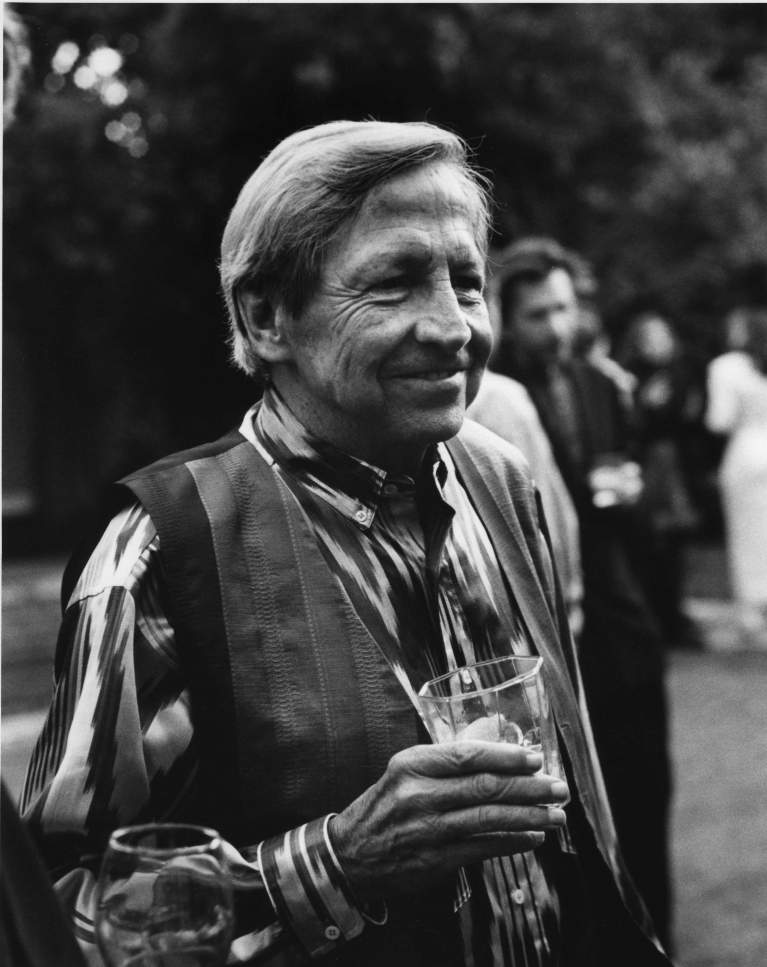 Rauschenberg at his seventieth birthday party, Los Angeles, October 1995. Photo: Sidney Felsen
Rauschenberg at his seventieth birthday party, Los Angeles, October 1995. Photo: Sidney Felsen
1996
Begins Ground Rules series (1996–97), composed of color lithographs and published by Universal Limited Art Editions (ULAE), West Islip, New York.
Design house Felissimo, Tokyo, establishes Tribute 21 Plate project with United Nations Educational, Scientific and Cultural Organization (UNESCO) bringing artists, designers, and celebrities together to create decorative plates to benefit various international charities. For Rauschenberg’s Tribute 21 Plate series (1996–98/2002–06), he designs porcelain plates on which artwork is produced in honor of, and sometimes even created by, an inspiring individual. Other contributors to the project this same year include designers Todd Oldham and Sonia Rykiel, and founder of the National Dance Institute, Jacques d’Amboise. The plates are published by Felissimo and Tribute 21 Foundation and honoree receives funds to donate to a philanthropic cause of his or her choosing—honoring the artist’s legacy of art, culture, and contribution in the twenty-first century.
January 6–February 3: Rauschenberg: Carnal Clocks, Cardboards, Jammers, Sonnabend Gallery, New York. The exhibition presents works from the late 1960s and early 1970s.
February 6: Exhibits twenty-nine posters, created for various United Nations (UN) organizations, philanthropic groups, and events, at the UN, New York. The artist unveils the print and poster Clan Destiny (1995), created for the United Nations Conference on Human Settlements (Habitat II), which will be held in Istanbul June 3–14. For the occasion Rauschenberg is awarded a Citation of Commendation by the UN.
June: Travels to Istanbul for the United Nations Conference on Human Settlements (Habitat II). Visits Ephesus and other archaeological sites in Turkey.
June 7: Honored with the fifth annual Lifetime Achievement Award in Contemporary Sculpture, International Sculpture Center, Washington, D.C., during the Sixteenth Annual International Sculpture Conference, Sculpture: Crossing Boundaries, Rhode Island School of Design, Providence. Rauschenberg is also featured in the September–October 1995 issue of Sculpture magazine in conjunction with the award. The artist accepts an invitation to join the center’s Honorary Board of Trustees in July 1996.
June 22–July 31: Robert Rauschenberg, Monastero Mechitarista dell’Isola di San Lazzaro degli Armeni, Venice, features A Quake in Paradise (Labyrinth) (1994), Tribute 21 (1994), and Quattro Mani (1996). Rauschenberg collaborated with Darryl Pottorf on the Quattro Mani series (1996/1998–99), the title of which refers to the four hands of the two artists. Rauschenberg and Pottorf later take up the concept in 1999 and 2000, working in color screenprints, in a series entitled Quattro Mani Marrakech.
July 17: Presents Domicile, a lithograph published by the Robert Rauschenberg Foundation, New York, in an edition of fifty and created for the tenth anniversary of Friends of Art and Preservation in Embassies, Washington, D.C., at a White House ceremony attended by President Bill Clinton.
[August]: Begins Arcadian Retreat series of frescos, made in collaboration with Donald Saff, Saff and Company (formerly Saff Tech Arts), Oxford, Maryland. Inspired by the gift of a Pompeian fresco fragment from Saff, Rauschenberg derives imagery for the series from his own photographs taken in Turkey when he was visiting for Habitat II in June 1996. Similar to the method used for the Waterworks (1992–95) and Anagram (1995–97) series, Rauschenberg transferred imagery from Iris prints, this time using wet plaster rather than paper supports. For the Arcadian Retreats, each fresco is housed in a frame designed by the artist and made from wood and aluminum.
September 19–October 19: Robert Rauschenberg: Anagrams, PaceWildenstein, New York. Other works from the Anagrams series (1995-97) will be exhibited later in the fall at PaceWildenstein, Beverly Hills, and Galerie Jamileh Weber, Zurich.
November: Rauschenberg is photographed at the studio of painter and good friend Chuck Close in preparation for a portrait painting. As is customary in Close’s practice, the portrait begins with a photograph, from which he develops a large-scale painting composed of rows of two-inch squares. Reacting to the completed work, Rauschenberg states, “His magic is real. . . . I was honored to have served as a catalyst to trigger his truth and sorcery.” The finished portrait, entitled Robert (1996–97), is first exhibited at Close’s 1998 retrospective at the Museum of Modern Art, New York.1 In 2001, Close paints a second portrait entitled Robert II.
December 10, 1996–January 25, 1997: Winter Works: Rauschenberg and Pottorf, Philharmonic Center for the Arts, Naples, Florida.
- 1. Allison Adato, “The Magic of Art: A Master Painter Shows How He Does It.” Life magazine (New York) 21, no. 2 (Feb. 1998), pp. 51, 53. See also, Chuck Close, online catalogue-raisonné, Artifex. Accessed on May 15, 2013.

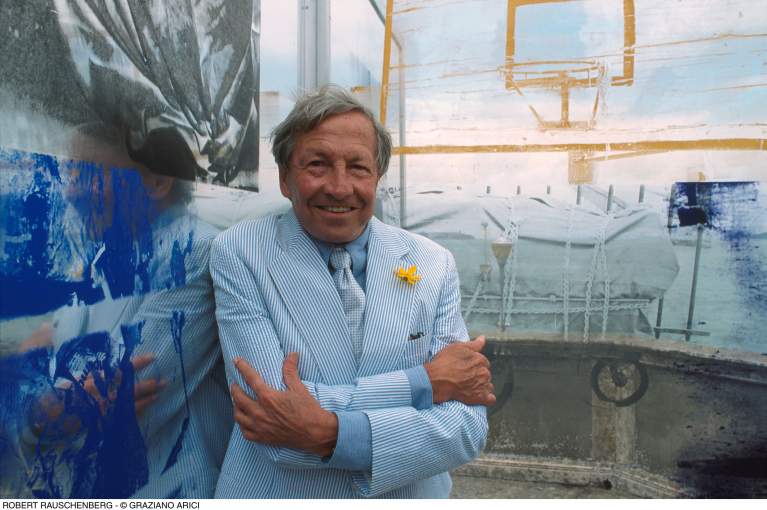 Rauschenberg with a portion of his 29-panel installation work A Quake in Paradise (Labyrinth) (1994), exhibited at the Mekhitarian Monastery of Saint Lazarus, Isle of San Lazzaro degli Armeni, Venice, summer 1996. Photo: Graciano Arici
Rauschenberg with a portion of his 29-panel installation work A Quake in Paradise (Labyrinth) (1994), exhibited at the Mekhitarian Monastery of Saint Lazarus, Isle of San Lazzaro degli Armeni, Venice, summer 1996. Photo: Graciano Arici

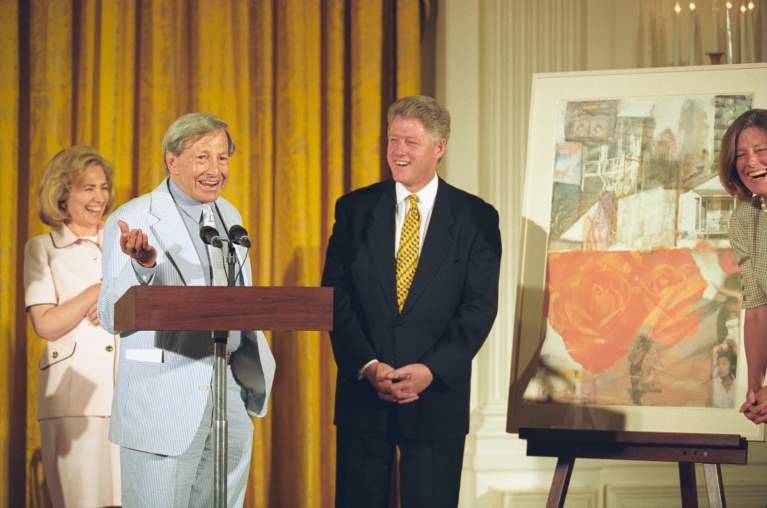 Rauschenberg with First Lady Hillary Clinton and President Bill Clinton during the White House presentation of the artist’s lithographs to mark 10th anniversary of Friends of Art and Preservation in Embassies, Washington, D.C., 1996. Photo: Ralph Alswang
Rauschenberg with First Lady Hillary Clinton and President Bill Clinton during the White House presentation of the artist’s lithographs to mark 10th anniversary of Friends of Art and Preservation in Embassies, Washington, D.C., 1996. Photo: Ralph Alswang

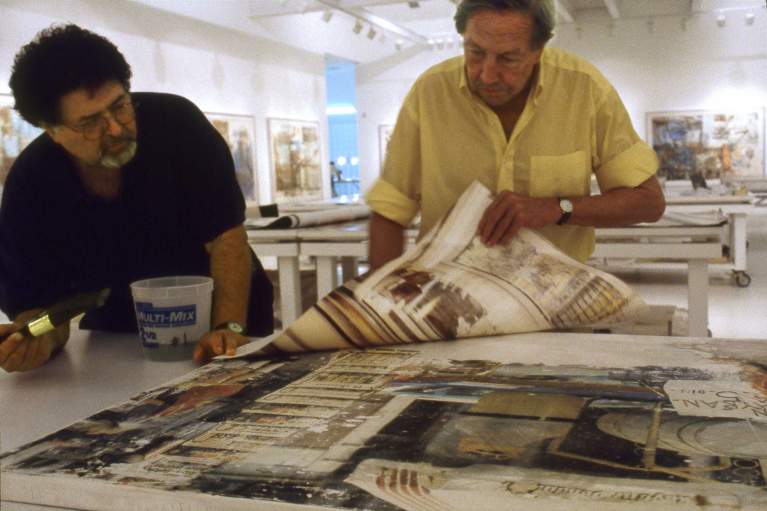 Donald Saff and Rauschenberg working on Party Line (Arcadian Retreats) (1996), from the fresco series, in Rauschenberg’s Captiva Drive studio, Captiva, Florida, 1996. Courtesy of Saff Tech Arts. Photo: George Holzer
Donald Saff and Rauschenberg working on Party Line (Arcadian Retreats) (1996), from the fresco series, in Rauschenberg’s Captiva Drive studio, Captiva, Florida, 1996. Courtesy of Saff Tech Arts. Photo: George Holzer
1997
January: Travels to Asia to attend the openings of two exhibitions of his recent work, at Gallerie Taksu, Kuala Lumpur, and Wetterling Teo Gallery, Singapore.
Featured in Artnews list “The 50 Most Powerful People in the Art World,” alongside such figures as art historian and curator Robert Rosenblum, Solomon R. Guggenheim Museum, New York; Nicholas Serota, director of Tate, London; and artist Sigmar Polke. In the issue, Rauschenberg is described as “the master of many mediums” and highlighted as a philanthropist for his efforts with the Rauschenberg Overseas Culture Interchange (ROCI) (1984–91).
January 28: Provides music for If you couldn’t see me (1994) during the Trisha Brown Dance Company’s program, Accumulation of Talking Plus Repertory, The Kitchen, New York.
February 15–June 30: Proof Positive: Forty Years of Contemporary American Printmaking at ULAE: 1957–1997, Corcoran Gallery of Art, Washington, D.C. Rauschenberg and master printer Bill Goldston speak about their collaboration on April 2. The exhibition travels to the Nelson-Atkins Museum of Art, Kansas City; Gallery of Contemporary Art, University of Colorado, Colorado Springs; and Hammer Museum, University of California, Los Angeles; Sezon Museum of Art, Tokyo; and Kitakyushu Museum of Art, Japan.
February 28–April 13: Robert Rauschenberg: Through the Lens, University of Missouri, Kansas City.
March 18: Awarded First Prize in Contemporary Art, First Contemporary Art Awards, Fundación Argentaria with “La Revista” of El Mundo newspaper and ARCO, Madrid.
March 22–May 19: Robert Rauschenberg: Haywire, Technologische Hauptwerke aus den sechziger Jahren [Haywire, major technological works from the 1960s], Aktionsforum Praterinsel, Munich. The exhibition includes the newly restored Soundings (1968).
April 23: Attends celebration in Houston for the ninetieth birthday of arts patron Dominique de Menil (a longtime collector of his work) and the tenth anniversary of the Menil Collection.
June 18: Attends eleventh annual Friends of Art and Preservation in Embassies benefit at the White House, Washington, D.C., alongside artists Ellsworth Kelly, Roy Lichtenstein, and Frank Stella, the proceeds from which benefit renovating and restoring U.S. representational facilities abroad.
Late summer/early fall: Working for the first time in glass, the artist re-creates quotidian objects that have previously informed his imagery, such as a tire, pillow, shovel, and broom, each of which is presented on a silver-plated pedestal.
August: Benefiting the Abuse, Counseling, and Treatment Center, which serves victims of domestic violence, the annual Arts for ACT Auction is held in Fort Myers, Florida, to which Rauschenberg donates Study for Intermission (Ground Rules) (1996), the evening’s highest priced auctioned artwork. Rauschenberg will attend the auction each year.
September 10: Attends luncheon celebrating Leo Castelli’s ninetieth birthday at the Museum of Modern Art, New York. He contributes the print Caucus (1997) to the portfolio produced as a surprise for Castelli’s party. The portfolio also includes prints by Jasper Johns, Ellsworth Kelly, Joseph Kosuth, Roy Lichtenstein, Bruce Nauman, James Rosenquist, Ed Ruscha, and Richard Serra. Castelli first represented Rauschenberg in 1958.
September 19–October 18: Robert Rauschenberg: Arcadian Retreats, PaceWildenstein, 32 East Fifty-seventh Street, New York. On view in the same building at PaceWildensteinMacGill (September 11–October 25) are new Iris prints of black-and-white photographs taken from the late 1940s to the early 1980s.
September 19, 1997–January 7, 1998: Robert Rauschenberg: A Retrospective, featuring 482 artworks, takes place at the Solomon R. Guggenheim Museum, Guggenheim Museum SoHo, and Guggenheim Museum at Ace Gallery, New York. The exhibition will subsequently travel to the Menil Collection, Contemporary Arts Museum, and Museum of Fine Arts, Houston; Museum Ludwig, Cologne; and Guggenheim Museum Bilbao, Spain. The September issue of Artforum is devoted to Rauschenberg, and feature articles on the artist and his work appear in Harper’s Bazaar, The New Yorker, Vanity Fair, and Vogue. In a text titled “Seen of the Crime,” written in conjunction with the Guggenheim opening and published in Grand Street, Rauschenberg writes: “The evidence of my existance [sic] seems to me like an interesting adventure had by a stranger that I would like to meet.”1
September 23–November 1: Rauschenberg Art for Change, Gemini G.E.L. at Joni Moisant Weyl, New York, which includes editions published by Gemini G.E.L., Los Angeles. Proceeds benefit Change, Inc.
October 9: Attends Independent Curators Incorporated (ICI) Leo Awards Benefit Dinner, donating work for a silent auction to advance the initiatives of ICI, a nonprofit that mounts traveling exhibitions of contemporary art throughout the country.
October 14–19: Merce Cunningham Dance Company opens its season entitled Cunningham, Merce: Forward & Reverse at the Brooklyn Academy of Music Opera House as part of the Next Wave Festival. The company performs Winterbranch (1964), for which Rauschenberg designed the set as part of a series of segmented revival performances, termed both MinEvents and Events, in which amalgamated excerpts from across the choreographer’s repertory come together anew.
October 23: Makes Mirthday Man, a 10-by-10-foot, three-panel work from the Anagram [A Pun] series (1997–2002) for his seventy-second birthday. The series uses the same technique as the Anagram series (1995–97), but the polylaminate paper is now mounted on a rigid panel and left unglazed, giving the finished works a more painterly appearance. Mirthday Man includes a reproduction of the X-rays of the artist’s full body first used in the print Booster (1967) and will debut as part of Robert Rauschenberg: A Retrospective in Houston. Rauschenberg will replicate Mirthday Man in two ceramic editions the following year, at the request of the Otsuka Omi Ceramic Company, Japan, which will retain one example for its museum.
October 27: Attends benefit gala in Manhattan’s Puck Building celebrating the opening of the exhibition The Art of Healing: A Collection in Support of the Excluded, created to advance the work of Doctors of the World (DOW), an organization that seeks to strengthen relief and human-rights efforts. The exhibition is on view at galleries across the United States and includes Rauschenberg’s original artwork for the Médecins du Monde poster (1997), printed at Universal Limited Art Editions (ULAE), West Islip, New York. In 2001, the artist makes another edition of one hundred prints to benefit DOW, printed at ULAE and published by Art of This Century.
November 10: Attends premiere of the BBC film Man at Work at the Solomon R. Guggenheim Museum, New York. Filming took place in Port Arthur, Texas; at Rauschenberg’s studio in Captiva, Florida; and in New York, during the installation the artist’s Guggenheim retrospective. Also included is the artist at work on his monumental The 1/4 Mile or 2 Furlong Piece (1981–98).
Red Interior (1954) is sold at a Christie’s auction in New York as part of the Victor and Sally Ganz Collection; the collection sells for a record price of $6.3 million.
November 16: Honored with other artists at the home of gallerist Marian Goodman, commemorating the second decade of October magazine. In the spirit of the celebration, artists Sol Lewitt, Rauschenberg, Gerhard Richter, and Edward Ruscha contribute works to October Portfolio Two, a benefit portfolio to ensure the continuation of the magazine.
- 1. Robert Rauschenberg, “Seen of the Crime,” Grand Street (New York) no. 62 (Fall 1997), p. 21.

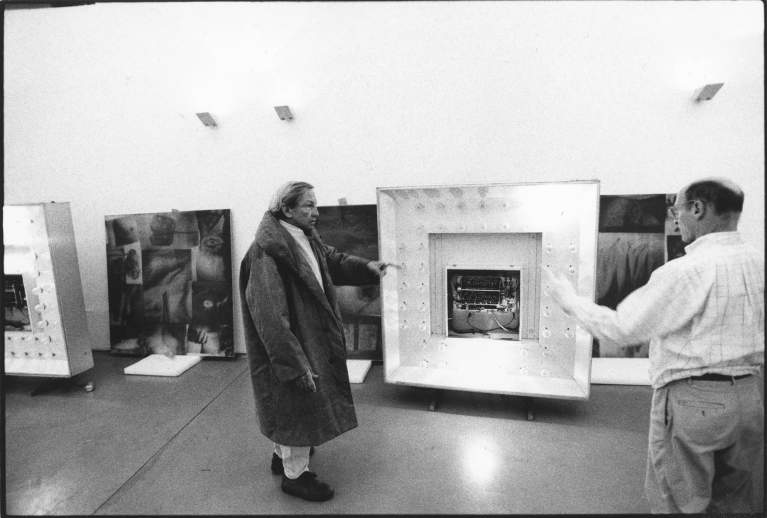 Rauschenberg and David White installing works from the Carnal Clocks series (1969) for the exhibition Robert Rauschenberg: Haywire, Major Technological Works from the 1960s, Aktionsforum Praterinsel, Munich, 1997. Photo: Jens Bode
Rauschenberg and David White installing works from the Carnal Clocks series (1969) for the exhibition Robert Rauschenberg: Haywire, Major Technological Works from the 1960s, Aktionsforum Praterinsel, Munich, 1997. Photo: Jens Bode

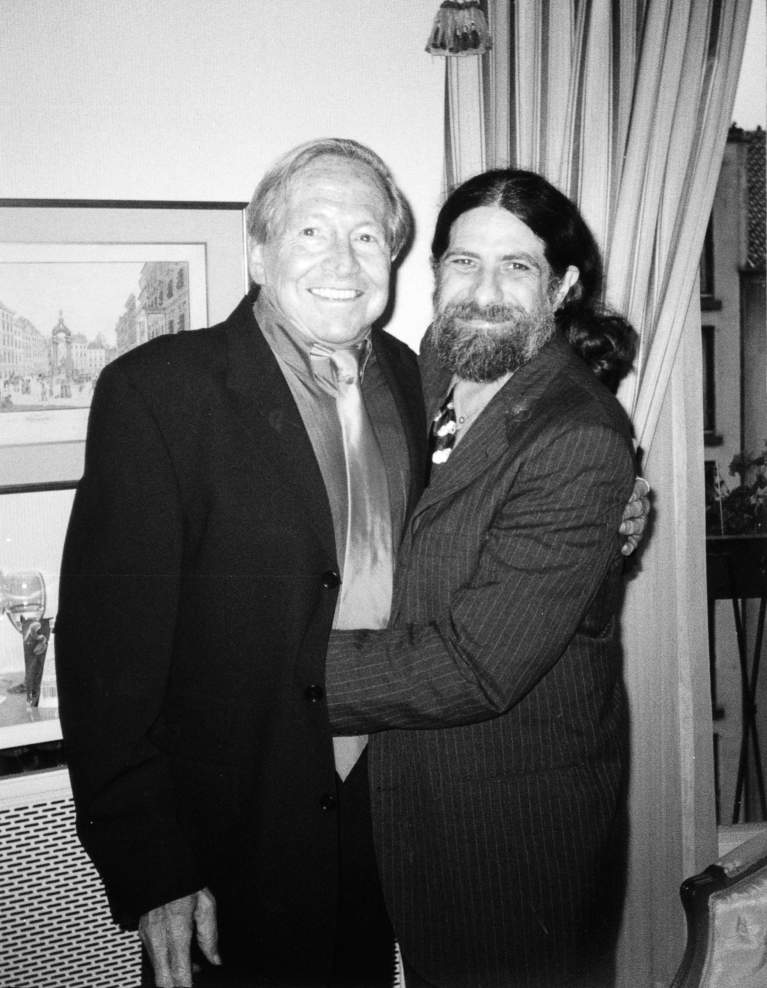 Rauschenberg and his son Christopher on the occasion of the opening of Robert Rauschenberg: A Retrospective, Museum Ludwig, Cologne, Germany, June 1998. Photo: Sidney B. Felsen © 1998
Rauschenberg and his son Christopher on the occasion of the opening of Robert Rauschenberg: A Retrospective, Museum Ludwig, Cologne, Germany, June 1998. Photo: Sidney B. Felsen © 1998
1998
January: Travels to Los Angeles to work at Gemini G.E.L. on L.A. Uncovered, a series of twelve prints printed in limited editions ranging from fifty to sixty-four. The series will be shown at Gemini G.E.L. at Joni Moisant Weyl, New York, later in the year, along with a series of collaborative editions with Darryl Pottorf entitled Quattro Mani (1996/1998–99).
January 6: Throws a benefit party for his philanthropic organization, Change, Inc. that offers emergency grants to artists. Rauschenberg cohosts the party, held at Le Cirque 2000, New York, with espresso company illycaffè. In collaboration with illycaffè, Rauschenberg designs espresso cup and saucer sets, the proceeds from which also benefit Change, Inc.
January 29–March 7: Robert Rauschenberg: Anagrams (A Pun), Galleria Lawrence Rubin, Milan.
February: Cover of Art in America features a detailed photograph of Rauschenberg’s silkscreen painting, Estate (1963). The issue includes an essay by art historian Roni Feinstein, entitled “Rauschenberg: Solutions for a Small Planet.”
February 14: Rauschenberg and Trisha Brown discuss their collaborations at the Contemporary Arts Museum, Houston, for the opening of Robert Rauschenberg: A Retrospective at the Menil Collection, Contemporary Arts Museum, and the Museum of Fine Arts.
February 14–April 11: Robert Rauschenberg (Anagrams), Texas Gallery, Houston.
March 9: Rauschenberg’s Deng Xiaoping Man of the Year cover for Time magazine from January 1986 is reprinted in the seventy-fifth-anniversary issue, chronicling the most celebrated images that have graced the magazine’s cover since its beginnings.
April 7: As part of the annual Hilla Rebay Lecture series at the Solomon R. Guggenheim Museum, New York, Hubert Damisch, Director, École des Hautes Études en Sciences Sociales, Paris, presents a lecture exploring a dialogue between music and abstract painting, examining the work of figures such as John Cage, Vasily Kandinsky, Rauschenberg, and Arnold Schoenberg.
April 12: The artist’s life and work serves as the topic of a lecture held at Valencia Community College, Orlando, Florida, given by Philip Bishop, a humanities professor, author, and art reviewer for the Orlando Sentinel.
April 13: Designs the cover for Time 100 magazine’s special issue entitled, Leaders and Revolutionaries, which names and profiles the twenty most influential leaders and revolutionaries of the past one hundred years. Working over the course of four intense days and nights in his Captiva, Florida, studio, Rauschenberg reflects, “There’s no such thing as power and politics without personalities, and power and revolution do not exist with hands in pockets. I hoped to get that across in my cover.” 1
May 4: Serves as event sponsor for a celebration of visual art and performance by artists with Marfan syndrome, hosted by the Marfan Artists Project at Liz Claiborne, New York. Rauschenberg donates Byway (Waterworks) (1995) for the silent auction.
May 5: Presented with the Twenty-first Annual Spirit of the City Award at the Cathedral of Saint John the Divine, New York. The award honors those whose efforts on behalf of New York have brought distinction to the city.
June: Travels to Rome at the invitation of the Vatican. In honor of the Jubilee year 2000, the Vatican has commissioned him to contribute a work on the theme of the Last Judgment for the Liturgical Hall at the Renzo Piano–designed Padre Pio Pilgrimage Church, San Giovanni Rotondo in Puglia, Italy. For inspiration, he visits the ninth-century Byzantine mosaics in Santa Prassede, Rome.
July: Completes and installs Riding Bikes, a sculptural commission for the Daimler-Benz headquarters on Potsdamer Platz in Berlin. The commission consists of two bicycles mounted to face each other vertically on stainless-steel posts contoured with multicolored neon tubes and set in a pool of water.
August 21–September 12: Robert Rauschenberg: Tribute 21, National Gallery of Modern Art, New Delhi.
September 12: Seattle Symphony inaugurates Benaroya Hall, Seattle. The new building features a commission by Rauschenberg, Echo, a nine-panel Anagram (A Pun), installed above the entrance to the S. Mark Taper Foundation Auditorium. A detail of Rauschenberg’s Echo [Anagram (A Pun)] appears on the cover of the January/February 1999 issue of Symphony magazine.
September 18: Inducted into Notable People Hall of Fame, Museum of the Gulf Coast, Port Arthur, Texas, in recognition of his “personal contribution to the popular culture heritage of the Gulf Coast region, the United States and the World.”
September 19–November 30: Robert Rauschenberg: Tribute 21, Museum of the Gulf Coast, Port Arthur, Texas. Rauschenberg attends an opening banquet in his hometown held in his honor. September 19 is declared Robert Rauschenberg Day. He designs a poster for the occasion, the proceeds from which will benefit the museum.
October 19: Receives prize for Divulging Culture and Social Involvement (DCSI) on behalf of GLB Presents, a division of the American Dance Asylum, New York, along with Merce Cunningham, Nobel Prize winner Dario Fò, poet laureate Robert Pinsky, and Steven Spielberg. Prize is awarded for experimentation in the arts and for Rauschenberg’s work done with his foundation.
October 29: Receives Praemium Imperiale for Painting, Japan Art Association, Tokyo.
November 23: Receives Kitty Carlisle Hart Award for Outstanding Achievement in the Visual Arts, Arts and Business Council, New York.
November 30: Appointment [Anagram (A Pun)] (1997) is featured on the cover of Forbes magazine’s annual ASAP Big Issue. Created under the art direction of Tony Lane, Forbes sought to highlight artwork that resonated with concepts of time and space; six Rauschenberg paintings illustrate editorials throughout the issue.
December 10–23: Contributes Street Music (Anagram) (1995) to the Amnesty International benefit drawing show at Paula Cooper Gallery, New York.
- 1. Rauschenberg quoted in Norman Pearlstine, “To Our Readers,” Time magazine (New York) 151, no. 14, April 13, 1998, pp. TK.

 Rauschenberg working on L.A. Uncovered series, Gemini G.E.L., Los Angeles, 1998. Photo: Sidney B. Felsen © 1998
Rauschenberg working on L.A. Uncovered series, Gemini G.E.L., Los Angeles, 1998. Photo: Sidney B. Felsen © 1998

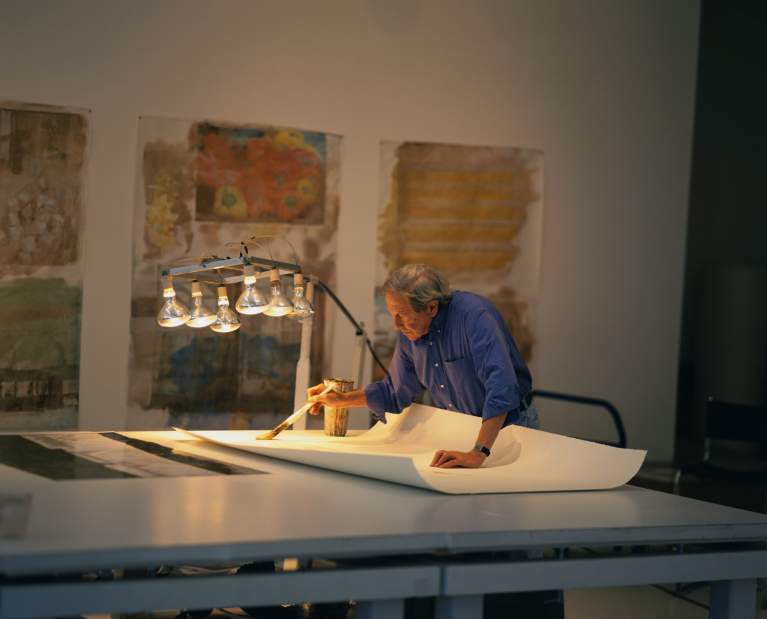 Rauschenberg working in his Captiva Drive studio, Captiva, Florida, 1998. Photo: © Richard Schulman/CORBIS
Rauschenberg working in his Captiva Drive studio, Captiva, Florida, 1998. Photo: © Richard Schulman/CORBIS
1999
Creates The Happy Apocalypse (1999), comprised of images of world maps and spiritual crystals taken with the artist’s kaleidoscope camera, specially designed and fabricated for a commission for the Padre Pio Liturgical Hall, San Giovanni Rotondo, Italy. The Vatican ultimately rejects the work on the grounds that his choice to depict God as a satellite dish is an inappropriate theological reference. The twenty-foot-long maquette will be donated to the Menil Collection, Houston, in 2005. Rauschenberg will later recall: “I thought it was very awkward to convey a sense of joy to people who were in great pain, which is the reason why they would have made the pilgrimage to Padre Pio. . . . So I tried to illustrate the story as sensitively as I could. . . . I managed to transform the Judgment Day into something to celebrate, something that would heal you through faith. My art is based on hope and aims to inspire spirituality and life.”1
Starts work on the Apogamy Pods series (1999–2000). The word “apogamy” refers to a form of asexual reproduction. Rauschenberg said that he wants the paintings “to grow out of themselves, to contain their own contradictions and get rid of narrative, which is the sex of picture-making. . . . I was really trying not to make narratives, to keep the images apart and have them relate the way real memories relate to one another, by their look, by their shape or their transparency, by their colors and their atmospheres. It was very hard to do. The hardest thing since I erased Bill’s drawing [Erased de Kooning Drawing (1953)].”2
Begins Ruminations series (1999–2000). The series employs images representing important figures and moments in the artist’s early life. The nine prints are published by Universal Limited Art Editions (ULAE), West Islip, New York, each in an edition of forty-six.
January 16–April 18: Rauschenberg in Transparency, Orange County Museum of Art, Newport Beach, California. Featuring works made since the 1960s, the exhibition is the first to focus on the artist’s use of transparent materials such as Plexiglas, Lexan, and Mylar and includes Shades (1964), Opal Gospel (1971), Sling-Shots Lit #2 (1984), Borealis Shares I (1990).
March 5–May 9: PhotoImage: Printmaking 60s to 90s, a traveling group exhibition from the Museum of Fine Arts (MFA), Boston, opens at the Des Moines Art Center. In a related program, exhibition organizer and curator of the department of prints, drawings, and photographs at the MFA Clifford S. Ackley hosts a lecture entitled “Rauschenberg and After: The Dialogue of Photography and Print-Making.”
March 19–April 17: Robert Rauschenberg: Anagrams (A Pun), PaceWildenstein, New York. As with the Waterworks (1992–95) and Anagram series (1995–97), for Anagrams (A Pun) (1997–2002), Rauschenberg made digital color transfers using inkjet dyes or pigment; these images are then transferred to paper using water. With Anagrams (A Pun), however, the paper is mounted onto a rigid, polylaminate panel and left unglazed, giving the finished works a more painterly appearance. In a statement included in the catalogue, the artist says: “We are all unique. It is a precious thing to compare ourselves to nothing else. This is my working attitude. I do not feel shame in my joy nor regret or fright in history.”3
March 28: Attends first Two by Two for AIDS and Art fundraiser benefiting the American Foundation for AIDS Research (AMFAR) and the Dallas Museum of Art. Rauschenberg has been active in AMFAR since its inception in 1985, supporting its mission to end the global AIDS epidemic through research.
[April]: Speaks at an event at the National Arts Club, New York, honoring friend and fellow-artist James Rosenquist.
April 7: DocumentaryRobert Rauschenberg: Inventive Genius airs on PBS as part of the American Masters series.
April 8–May 15: Robert Rauschenberg Fotografie: 1949–1985, Galleria Lawrence Rubin, Milan.
April 17: Presented Butler Medal for Life Achievement in the Arts as a surprise by the Butler Institute of American Art, Youngstown, Ohio, at its Eightieth Anniversary Gala honoring Rauschenberg and Darryl Pottorf.
April 30–September 6: Hans Namuth’s 1971 black-and-white portrait of Rauschenberg is included in the exhibition Hans Namuth: Portraits, National Portrait Gallery, Washington, D.C., featuring the photographer’s work from 1950 to 1989 as he captured famed subjects of the postwar art world.
May: Named one of Artnews magazine’s twenty-five most influential artists of the century. The issue includes a photograph of the artist on the cover, in addition to a text by curator Susan Davidson.4
May 4–June 30: Rauschenberg’s is among the artist’s portraits featured in Artist’s Proof: Photographs by Sidney B. Felsen, Gemini G.E.L. at Joni Moisant Weyl, New York.
May 6–July 3: Participates in Re: Rauschenberg, Marcel Sitcoske Gallery, San Francisco, that features Rauschenberg’s work alongside that of more than a dozen artists who were influenced by his pervasive and far-ranging style. Exhibition curator Stuart Horodner states, “It wasn’t hard to find artists who reflect Rauschenberg; the hard part is finding someone who isn’t. And to do justice to him. He’s one of the top artists of this century for a million reasons. . . .”5
May 9–September 7: Robert Rauschenberg, San Francisco Museum of Modern Art. This exhibition of fourteen new acquisitions of work made between 1949 and 1964, acquired from the artist the previous year, includes such seminal pieces as Automobile Tire Print and Erased de Kooning Drawing (both 1953).
May 19: Receives Gold Medal for Painting, American Academy of Arts and Letters, New York, at its annual ceremony, presided over by Louis Auchincloss. The Gold Medal is the academy’s highest honor. In presenting the award, artist and former studio assistant Brice Marden reflects on Rauschenberg’s work as invoking “immense range, intensity, beauty of thought, and entire love of image that lifts you up to a realm of near, pure awe.” He continues, “Quite simply I have never seen his burning concentration equaled or even approached.”6 An exhibition is mounted honoring the academy’s newly elected members and recent recipients of honors and awards, which runs through June 13.
May 25: Rauschenberg’s mother dies at age ninety-six in Lafayette, Louisiana.
May 30, 1999–April 9, 2000: The 1/4 Mile or 2 Furlong Piece (1981–98) is among the loans to inaugurate the new Massachusetts Museum of Contemporary Art, North Adams. The work is installed in a football field–size gallery and smaller adjoining gallery spaces.
June 14: Time magazine publishes issue profiling “100 Heroes and Icons of the 20th Century,” with a cover designed by Rauschenberg.
June 20: Travels to Marrakech to take photographs that will be used the following year in Marrakitch (2000), a series of prints published by Gemini G.E.L., Los Angeles, in editions ranging from fifty to fifty-four. The completed Marrakitch series is on view at Gemini G.E.L. in 2000, along with Quattro Mani Marrakech (1999–2000), a series made in collaboration with Darryl Pottorf.
[Late June]: Museum of Modern Art, New York, acquires four important works, including Untitled [matte black painting with Asheville Citizen] (1952); Untitled (ca. 1953), an Elemental Sculpture; Factum II (1957), a Combine; and Bookworms Harvest [Anagram (A Pun)] (1998). In celebration of the acquisitions, the museum hosts a small exhibition organized by Kirk Varnedoe of Untitled (1953) and Factum II alongside the artist’s early Combines from the museum’s collection. The Museum of Contemporary Art, Los Angeles, loans Factum I (1957), after which a long-term arrangement is made between the two museums, whereby each museum exhibits both of the artist’s Factum paintings for alternating four-year periods.
July: Participates in traveling exhibition, Artistry of Space: Works from the NASA Art Collection, exhibited on board the Artrain through 2002. Artrain is the country’s only museum on a train, with rail cars housing a fine-arts exhibition, an interactive area, an artist studio, and a gift shop.
Rauschenberg and Trisha Brown are featured on the cover of German Vogue in a photograph by Robert Maxwell. The issue includes more of Maxwell’s playful images in addition to an interview with Rauschenberg and the choreographer regarding their extensive collaboration.
August 21: New York art dealer Leo Castelli dies at age ninety-one. A memorial tribute is held at the Museum of Modern Art, New York, on October 13; Rauschenberg is included in a program of illustrious speakers from the art world. In 2007, the Smithsonian Institution’s Archives of American Art, Washington, D.C., acquires a substantial portion of the Leo Castelli Gallery archives, containing extensive files of clippings and correspondence with the artists whose work Castelli championed, (Rauschenberg among them), as well as materials chronicling the gallery’s history.
November 4: In Dubai, alongside artist, Romero Britto, Rauschenberg participates in the creation of a 6-mile-long painting, a project organized to benefit the international relief agency, Doctors Without Borders. In total, forty artists and approximately ten thousand children contribute to the final work, entitled Our World. Celebrating the artist’s efforts, the agency honors Rauschenberg with a Distinguished Humanitarian Donor award on December 12 for outstanding support to the organization’s action to aid populations in need. On his work abroad, the artist has stated, “Within all of the natural and man-made crises—mayhem of greed and political, religious and racial intolerances—health is the greatest essential, the most important cure overall. It is the road to peace.”
December 31: Attends the White House Millennium Dinner, followed by America’s Millennium Gala at the Lincoln Memorial, Washington, D.C., as a guest of President Bill and First Lady Hillary Clinton.
- 1. Mario Codognato and Mirta d’Argenzio, “Interview with Robert Rauschenberg,” in Rauschenberg, exh. cat. (Ferrara: Palazzo dei diamanti, 2004), p. 97 (in English and Italian).
- 2. Dave Hickey, “Apogamy Pods: Rauschenberg Erases Rauschenberg,” in Rauschenberg: Apogamy Pods, exh. cat. (New York: PaceWildenstein, 2000), p. 6.
- 3. Bernice Rose, “Anagrams,” in Anagrams, exh. cat. (New York: PaceWildenstein, 1996).
- 4. Susan Davidson, “The Century’s 25 Most Influential Artists: Unending Irreverence.” Artnews (New York) 98, no. 5 (May 1999), p. 147.
- 5. Jane Ganahl, “Rauschenberg Glides In,” San Francisco Examiner, May 8, 1999, sec. D, p. 1.
- 6. “Presentation to Robert Rauschenberg of The Gold Medal for Painting by Brice Marden.” In Proceedings of the American Academy of Arts and Letters, Second Series, no. 50 (New York: American Academy of Arts and Letters, 1999), p. 63.

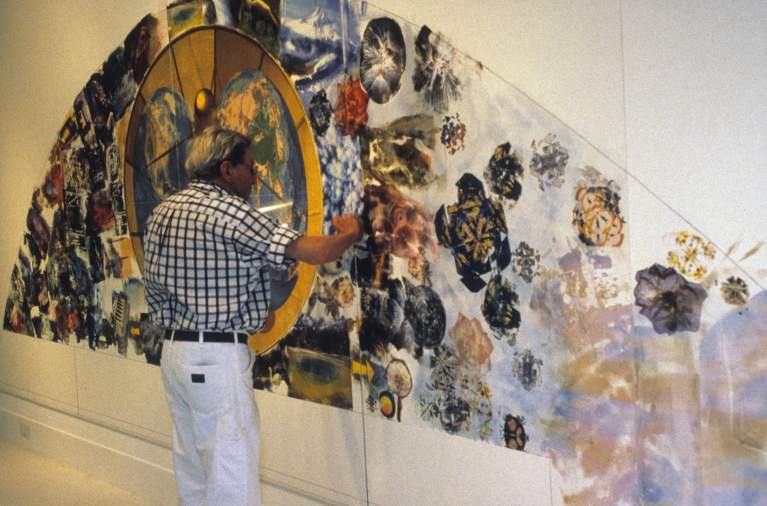 Rauschenberg working on The Happy Apocalypse [original artwork for Padre Pio Liturgical Hall] (1999) in his Captiva Drive studio, Captiva, Florida, ca. 1999. Photo: George Holzer
Rauschenberg working on The Happy Apocalypse [original artwork for Padre Pio Liturgical Hall] (1999) in his Captiva Drive studio, Captiva, Florida, ca. 1999. Photo: George Holzer

 Rauschenberg, at right, at the San Francisco Museum of Modern Art (SFMOMA) with Phyllis Wattis, seated, and SFMOMA Director David Ross, ca. 1999. Work in background is Port of Entry [Anagram (A Pun)] (1998). Photo: Sidney B. Felsen © 1999
Rauschenberg, at right, at the San Francisco Museum of Modern Art (SFMOMA) with Phyllis Wattis, seated, and SFMOMA Director David Ross, ca. 1999. Work in background is Port of Entry [Anagram (A Pun)] (1998). Photo: Sidney B. Felsen © 1999
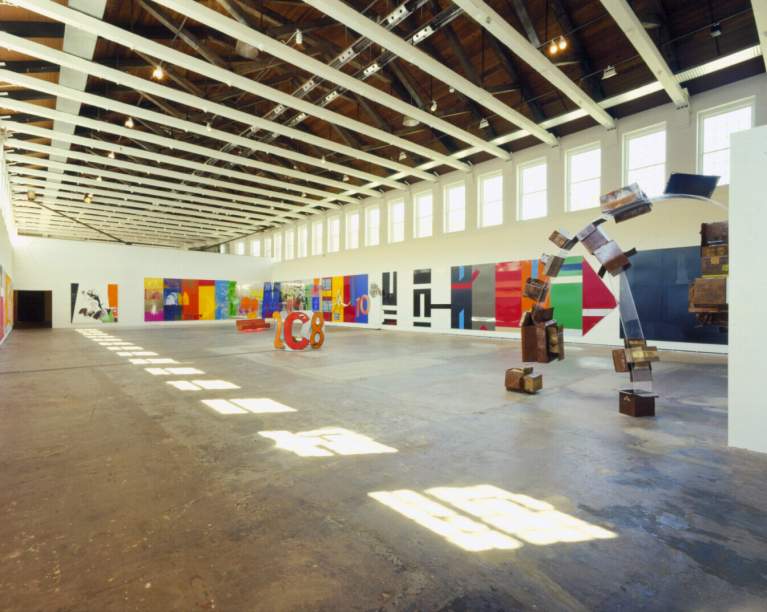 The 1/4 Mile or 2 Furlong Piece (1981–98) at the inaugural exhibition of MASS MoCA (Massachusetts Museum of Contemporary Art), North Adams, Massachusetts, 1999. Photo: Nicholas Whitman
The 1/4 Mile or 2 Furlong Piece (1981–98) at the inaugural exhibition of MASS MoCA (Massachusetts Museum of Contemporary Art), North Adams, Massachusetts, 1999. Photo: Nicholas Whitman
2000-08
2000
Begins Short Stories series (2000–02). In the Short Stories, Rauschenberg uses motifs from nature and combines them with his more characteristic imagery, such as trucks, telegraph poles, and road crossings, creating densely layered images. The works’ titles are page and paragraph numbers, as if referring to segments of a book; the viewer is encouraged to personally engage with the imagery as one would read the pages of a short story. The artist says of these works: “Think of them as seeds . . . the stories can change as time does.”118
Creates Freaks series, paintings made with inkjet pigment transfer and acrylic on polylaminate surfaces.
February 27: Receives first Award of Excellence for Artistic Contributions to the Fight Against AIDS, American Foundation for AIDS Research (AMFAR), presented by Sharon Stone during a private luncheon at the home of Deedie and Rusty Rose, following the second annual Two by Two for AIDS and Art event in Dallas the previous evening.
March 4: Receives Karen Susman Achievement Award, Texas Accountants and Lawyers for the Arts, an organization that grants scholarships to young artists and supports programs for developing the arts in the state.
March 9–April 16: Robert Rauschenberg: Recent Work, Gallery of Fine Art, Edison Community College, Fort Myers, Florida. The artist agrees to donate the sale of one hundred prints, three hundred signed posters, and three hundred unsigned posters to establish a gallery endowment.
April: Judson Memorial Church, New York, offers its twentieth-century art archives to the Fales Collection at New York University. Rauschenberg is among the featured artists in Judson’s extensive archives.
April 5: World premiere of the Merce Cunningham Dance Company’s Interscape, John F. Kennedy Center for the Performing Arts, Washington, D.C. John Cage provides the musical score 108 and Rauschenberg designs the set and costumes entitled Interscape Mirage (2000). The European premiere takes place on September 26, on the island of Tronchetto, near Venice, and it is dedicated to the Teatro La Fenice, the Venetian opera house that was being rebuilt after being entirely destroyed by fire in 1996.
April 13: Conversation between Rauschenberg and curator Walter Hopps takes place at the San Francisco Museum of Modern Art, in conjunction with the museum’s acquisition of the artist’s works the previous year.
April 18: Solomon R. Guggenheim Museum Director Thomas Krens announces a preliminary agreement between the Solomon R. Guggenheim Foundation and the Robert Rauschenberg Foundation by which a selection of Rauschenberg’s paintings, sculptures, drawings, and photographs will become part of the Guggenheim’s permanent collection. The commitment is contingent on the successful completion of a planned new Guggenheim Museum in lower Manhattan with the capacity and space to display such holdings—a plan that does not come to fruition.
May 2: In honor of the Trisha Brown Dance Company’s thirtieth anniversary and its creator, Trisha Brown, Rauschenberg and Dorothy Lichtenstein launch a special gifts program to support the company. A celebratory event is held at Rauschenberg’s New York home and studio after the company’s opening night at the Joyce Theater, New York.
May 15: Leo Steinberg’s Encounters with Rauschenberg (A Lavishly Illustrated Lecture) is published (University of Chicago Press). Steinberg offers an in-depth discussion of such major pieces as Erased de Kooning Drawing (1953), Bed (1955), and Monogram (1955–59), explaining the subtle differences between his interpretations and those of other critics, such as Clement Greenberg and Hilton Kramer; candidly reflecting on how he has changed his mind about the artist’s work over the years; and defending his new ideas about Rauschenberg’s work with precise, fresh arguments.
May 16–June 4: Robert Rauschenberg, Wexner Center for the Arts, Ohio State University, Columbus, in conjunction with the artist’s receipt of the eighth annual Wexner Prize. The award honors a major contemporary artist who is consistently original, influential, and challenging to convention. Previous recipients include Louise Bourgeois, John Cage, Merce Cunningham, Bruce Nauman, and Gerhard Richter. Rauschenberg is presented with the award on May 22, while related events, including a symposium with Frank Gehry, Yvonne Rainer, Jessica Stockholder, and Calvin Tomkins, as well as a lecture by Time magazine critic Robert Hughes take place in tandem with the ongoing exhibition.
May 18: Elected Honorary Royal Academician, Royal Academy of Arts, London.
May 23: Gagosian Gallery, New York, hosts an exhibition and silent auction, for Hillary Clinton’s campaign for the U.S. Senate seat from New York. Richard Artschwager, Louise Bourgeois, Christo and Jeanne-Claude, Chuck Close, Ellsworth Kelly, Sol LeWitt, and Rauschenberg, among others, donate artwork.
June 29–October 8: Robert Rauschenberg: Synapsis Shuffle, Whitney Museum of American Art, New York. Synapsis Shuffle (1999) is a participatory “performance” piece comprising fifty-two panels (as in a deck of cards), which are selected and arranged in compositions of between three and seven panels by someone other than Rauschenberg each time the work is displayed. The artist notes: “If I had wanted to put the panels together myself, I could have done it, but I wanted to see how other people would do it.”119 He considered asking the first twelve taxi drivers to arrive at the Whitney to make the selection of panels but ultimately invited friends to do so, including Close, Cunningham, Hopps, Hughes, Edwin Schlossberg, Ileana Sonnabend, and Mike Wallace, among others. Discussing the work, the artist says: “Screwing things up is a virtue. . . . Being right can stop all the momentum of a very interesting idea.”120
August 8: Despite an international petition to preserve the site-specific artwork, The Green Constellation of the Unicorn (1996) by Isamu Wakabayashi, signed by Rauschenberg, along with art-world peers, including the late Leo Castelli, Walter De Maria, Richard Meier, Frank Stella, Mark di Suvero, Rosemarie Trockel, and Bill Viola, the Tokyo Governor Shintaro Ishihara allows the land on which the work is installed to be expropriated for waste-disposal facilities. The installation was purposely situated in the planned landfill site as a protest to the development project that will destroy a large part of the local Hinode Forest.
August 26: In conjunction with the opening of Robert Rauschenberg and Darryl Pottorf, Evansville Museum of Arts and Science, Indiana, hosts the symposium “Robert Rauschenberg and His Influences,” featuring Rauschenberg biographer Mary Lynn Kotz and Connie Bostic, president of the board of directors at Black Mountain College Museum and Arts Center, near Asheville, North Carolina.
September 12–early October: Contributes edition of one hundred prints (Unity [Democratic National Committee Print for Gore]) to the online Democratic National Committee fundraising auction, DNC Art 2000, supporting the cause alongside artists Christo, Annie Leibovitz, Claes Oldenburg, Yoko Ono, Larry Rivers, and James Rosenquist, among others.
September 15: Attends gala reception, A Night in Morocco, at Gemini G.E.L., Los Angeles, celebrating the completed Marrakitch series of limited-edition prints inspired by Rauschenberg’s travels with Pottorf to Marrakech the year prior, along with the collaborative editions of Pottorf and Rauschenberg’s Quattro Mani/Marrakech (1998–2000) and Pottorf’s The Moroccan Series (2000). Proceeds from the gala benefit Rauschenberg’s philanthropic foundation, Change, Inc., New York.
October 9: Footage of Rauschenberg’s Pelican (1963) from the unreleased film, Mostly about Rauschenberg, is screened as part of Performing Bodies, a series of film and video projections by artists working in performance, at the Tate Modern, London.
November 10: Participates in auction benefiting Project Angel Food and Angel Art 2000 by donating Thirsty Wrapper (Anagram [A Pun]) (1999) and one hundred original lithographs to the cause. Project Angel Food is a nonprofit organization that provides 1,100 free meals and nutritional counseling daily to people disabled by HIV and AIDS throughout Los Angeles County.
November 11: Attends PaceWildenstein’s fortieth-anniversary celebration at Madison Avenue Sculpture Garden, New York.
November 17–December 30: Robert Rauschenberg: Apogamy Pods, PaceWildenstein, New York. It is PaceWildenstein’s closing exhibition in SoHo before moving to Chelsea.
December 6, 2000–February 3, 2001: Celebrating its tenth anniversary, the Ralls Collection, Washington, D.C., mounts an exhibition featuring Rauschenberg and Darryl Pottorf’s Marrakech-inspired works.
December 6, 2000–May 20, 2001: Robert Rauschenberg Combines: Painting + Sculpture, curated by Helen Molesworth, Baltimore Museum of Art. On December 12, Rauschenberg and collector Jane B. Meyerhoff hold a conversation on collecting.
- 118. Robert Rauschenberg: Short Stories, exh. cat. (Zurich: Galerie Jamileh Weber, 2001), p. 3.
- 119. Howard Kissel, “Rauschenberg Roulette: Famed Artist Brings in a Circle of Friends to Finish His Latest Project,” New York Daily News, June 25, 2000.
- 120. Michael Kimmelman, “The Irrepressible Ragman of Art,” New York Times, August 27, 2000. Accessed October 10, 2010.http://www.nytimes.com/2000/08/27/arts/art-architecture-the-irrepressible-ragman-of-art.html.

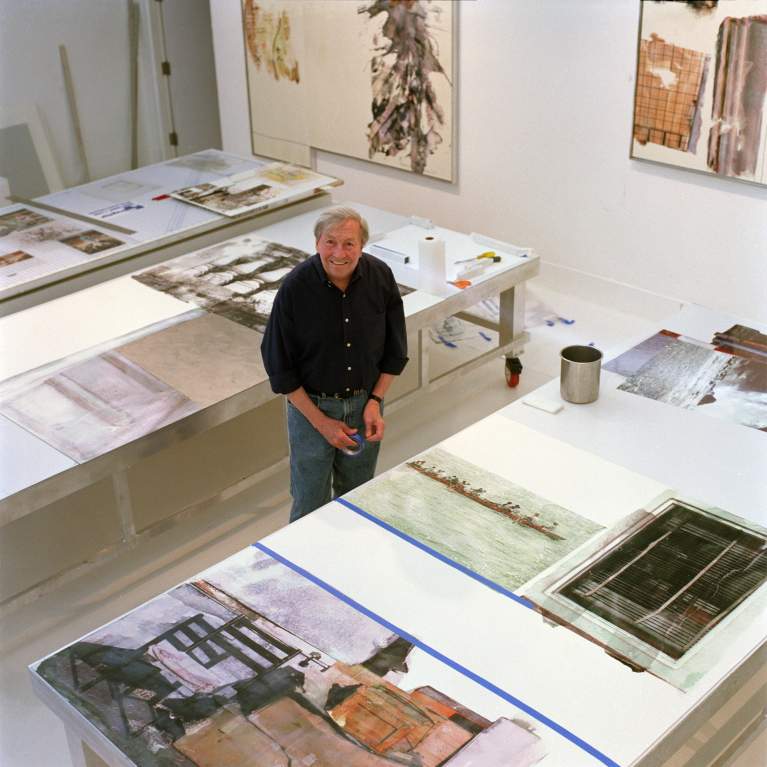 Rauschenberg working on his Short Stories series (2000–02), Captiva Drive studio, Florida, 2001. Photo: Ed Chappell
Rauschenberg working on his Short Stories series (2000–02), Captiva Drive studio, Florida, 2001. Photo: Ed Chappell

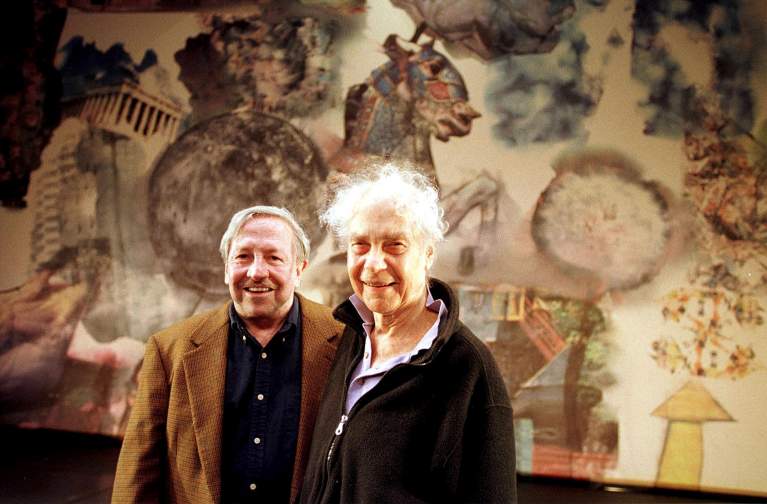 Rauschenberg and Merce Cunningham with Rauschenberg’s set for performance of Merce Cunningham Dance Company’s Interscape, September 25, 2000, Venice. Photo: © Andrea Merola/epa/Corbis
Rauschenberg and Merce Cunningham with Rauschenberg’s set for performance of Merce Cunningham Dance Company’s Interscape, September 25, 2000, Venice. Photo: © Andrea Merola/epa/Corbis
2001
January 27: Attends gala dinner establishing the Walter Hopps Award for Curatorial Achievement at the Menil Collection, Houston. The biennial prize recognizes early to mid-career curators who have made significant contributions to contemporary art.
March 18: Participates in a conversation at the Omni hotel with art historian Dave Hickey held in conjunction with the exhibition A Room of Their Own: From Rothko to Rauschenberg, Museum of Contemporary Art, Los Angeles.
March 22: bobrauschenbergamerica, written by playwright Charles L. Mee and directed by Anne Bogart, premieres at the Actors Theater of Louisville, as part of the annual Humana Festival of New American Plays. Celebrating Rauschenberg’s life and work, this theater piece incorporates imagery and a spirit that is meant to emulate the artist’s assemblages. As Mee states, “Everybody today is Rauschenbergian, whether they know it or not. . . . Rauschenberg is who we would like to be as Americans at our best, with the spirit of egalitarianism and openness to life.”1 The play has its New York premiere in 2003 at the Next Wave Festival, Brooklyn Academy of Music.
Spring: A Rauschenberg donation allows for the establishment of the Viola Farber Artists in Residence Program in Dance at Sarah Lawrence College, Bronxville, New York, in memory of the former Merce Cunningham Dance Company dancer and longtime teacher and dance department director. Through this program, Sarah Lawrence College can host visiting artists to pursue their own work while interacting with students in the larger college community.
April: Rauschenberg is featured as one of Talk magazine’s “Innovators and Navigators” of 2001.
April 6–May 12: Robert Rauschenberg: Short Stories, Texas Gallery, Houston.
May 6: Honored with achievement award celebrating excellence in visual arts, Orange County Museum of Art’s annual Art of Dining XIV benefit, Newport Beach, California. Due to a pelvic fracture, the artist is unable to attend; longtime friend Sidney B. Felsen, cofounder of Gemini G.E.L., Los Angeles, accepts the award on his behalf.
May 12–July 28: Robert Rauschenberg: Short Stories and Ruminations—A New Series of Nine Limited Edition Prints, Galerie Jamileh Weber, Zurich.
September 11: After two airplanes crash into the World Trade Center, New York, Rauschenberg is at his home in Captiva, Florida, awaiting news from studio assistants and staff members who maintain his Lafayette Street home and studio. The artist’s philanthropic foundation, Change, Inc., serves as a vital resource to those who suffer in the wake of the attacks. Rauschenberg designs the poster I Love New York, showing an image of the Statue of Liberty holding the towers of the World Trade Center, to benefit families of the victims.
October 15: Honored during World Leaders: A Festival of Creative Genius, recognizing fourteen individuals whose accomplishments have transformed their particular field of creativity as well as the world around them, at the Harbourfront Centre, Toronto. An exhibition of Rauschenberg’s work is hosted at Harbourfront Centre entitled “In + Out City Limits” Selection (September 21–November 4). The gala dinner includes a theatrical skit of Rauschenberg’s life and art, followed by a conversation between Rauschenberg and curator Susan Davidson.
October 22: Symposium Possession/Obsession—An Intimate View of Artists Through Their Homes, Studios, and Collections is held at the Carnegie Museum of Art, Pittsburgh. Ingrid Schaffner, curator at the Institute of Contemporary Art, University of Pennsylvania, and curator of the 1997 traveling exhibition (in which Rauschenberg participated) Deep Storage: Arsenale der Erinnerung (Arsenal of Memory), discusses Rauschenberg’s collages, Joseph Cornell’s assemblages, and the collecting habits of Pop artist Andy Warhol to comment on collecting as both an impulse and a process.
- 1. Celia Wren, “Bobrauschenbergamerica,” American Theatre Magazine (New York) 1807 (Sept. 1, 2001).

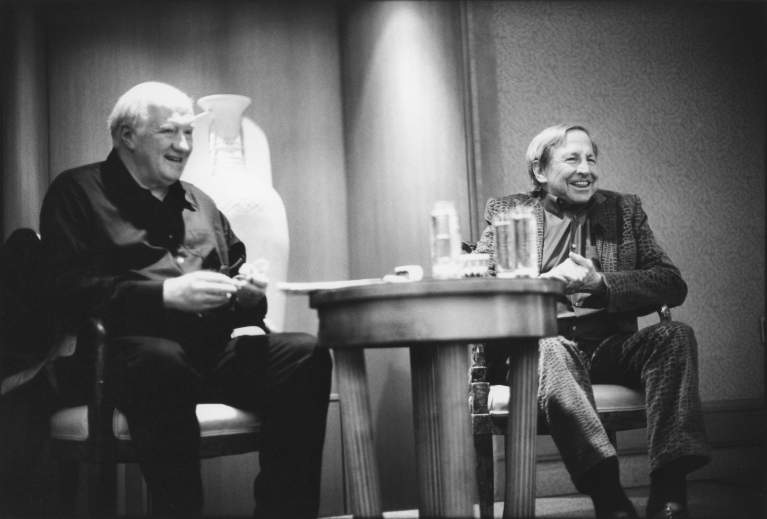 Rauschenberg in conversation with art historian Dave Hickey, March 18, 2001, in conjunction with the group exhibition A Room of Their Own: From Rothko to Rauschenberg, Museum of Contemporary Art, Los Angeles. Photo: Sidney B. Felsen
Rauschenberg in conversation with art historian Dave Hickey, March 18, 2001, in conjunction with the group exhibition A Room of Their Own: From Rothko to Rauschenberg, Museum of Contemporary Art, Los Angeles. Photo: Sidney B. Felsen

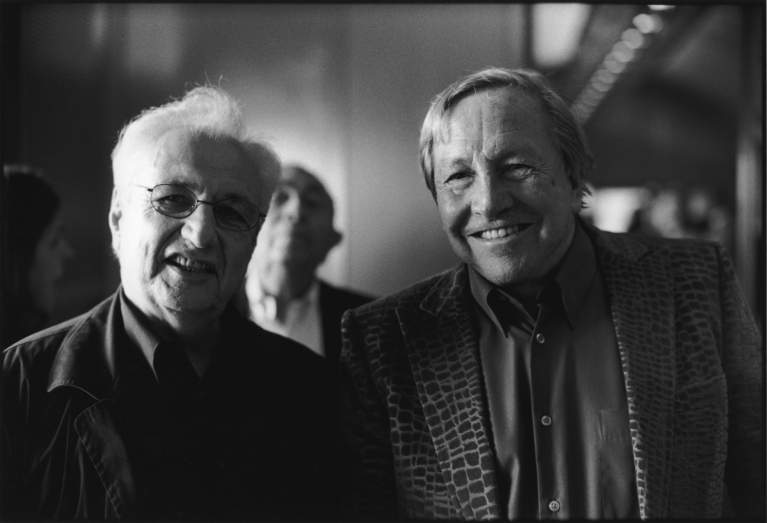 Frank Gehry and Rauschenberg, Los Angeles, March 2001. Photo: Sidney B. Felsen © 2001
Frank Gehry and Rauschenberg, Los Angeles, March 2001. Photo: Sidney B. Felsen © 2001
2002
Begins Scenario series (2002–06). Using the same transfer process employed since 1992, the Scenarios each consist of two panels whose imagery is arranged in a more grid-like format, with less overlap than previous works. Rauschenberg describes them as “a refinement of last year’s Short Stories. . . . The viewers gave the pictures their content and became their authors; they were sort of fragmented parts that one could go around and put in any location or in any time frame of their choice. . . . That is what these series have in common; they are just stories in a book.”1
[January]: Featuring work by both Rauschenberg and Darryl Pottorf, the National Neurofibromatosis Foundation hosts a benefit auction at the Gulf Harbour Yacht and Country Club, Fort Myers, Florida.
January 30–February 10: Robert Rauschenberg: Beamers, Eckert Fine Art, Naples, Florida. Among the works shown are the BMW 635 CSi Art Car-BMW (1986), painted by the artist for the auto company, and works from the Beamer series (1988), comprising acrylic on vinyl film on enameled aluminum paintings.
February 6–March 2: Portfolio of prints and photographs from artists, including Louise Bourgeois, Rebecca Horn, Annie Leibovitz, and Rauschenberg is offered for sale at Greg Kucera Gallery, Seattle. Proceeds benefit the medical relief organization Doctors of the World.
February 23: Amnesty International honors Francesco Clemente, Dennis Hopper, Jasper Johns, and Rauschenberg, among others, at SHINE, the organization’s fortieth-anniversary celebration, which includes the unveiling of a new digital art installation hosted at Studio 450, New York.
February 28–April 6: Robert Rauschenberg, Pace/MacGill Gallery, New York. The exhibition features works from the Photem Series (1981/1991).
March 4: Donates to Art Moves: A Special Art Auction for the CURE, presented by Sotheby’s, New York, with proceeds benefiting the Spinal Cord Injury Project at Rutgers, State University of New Jersey.
March 14: Participates in sixth annual Take Stock in Children Auction, Gulf Harbour Yacht and Country Club, Fort Myers, Florida. Proceeds benefit the organization from which the auction takes its name, a scholarship program providing public school students with a four-year scholarship to a Florida university.
Spring: Suffers a stroke that leaves his right arm partially paralyzed. Working with his left hand and with a group of longtime assistants, Rauschenberg remains prolific in the studio. He later remarks to Calvin Tomkins: “I can’t stand myself or anyone else if they start whining. I just have to figure out ways to continue without getting so distraught.”2
March 28–April 28: Robert Rauschenberg: Short Stories, Gallery of Fine Art, Edison Community College, Fort Myers, Florida.
April 22: Revisiting the Fifties, a lecture series sponsored by the New York Times and the Graduate Center of City University, New York, includes panelists John Ashbery, Diane Kelder, and Larry Rivers, moderated by art critic Roberta Smith, who discuss painters and poets of the New York School, Willem de Kooning, Frank O’Hara, and Rauschenberg, among them.
May 21: Presented with annual Medal Award, School of the Museum of Fine Arts, Boston, at an honorary dinner marking the opening of Robert Rauschenberg: Recent Work (May 22–August 18).
June 6–July 6: Robert Rauschenberg: Short Stories, Waddington Galleries, London. A statement by the artist describes the intention behind this series: “In this group of works there are no mistakes nor right, nor wrong. They are acronical [sic] of what you personally see and imagine. No tracks. No traces. Your story or dream and imagined or real these are your personal treasures to share or keep secret, choose to expand your reality or live it in the future.”3
June 6–October 14: Robert Rauschenberg, curated by Bernice Rose, Fondation Dina Vierny, Musée Maillol, Paris. The exhibition features works made in the last decade and includes a new configuration of Synapsis Shuffle (1999), arranged by various French friends, celebrities, and colleagues of the artist.
July 1: Accompanied by Rauschenberg’s score, Trisha Brown’s It’s a Draw premieres at Théâtre du Hangar, Montpellier, France. The music was originally produced for Brown’s If you couldn’t see me (1994).
July 9: As a member of the September Concert Foundation’s board of directors, Rauschenberg assists the foundation in raising funds for the September Concert, intended as an annual music festival in New York in memory of September 11 and in celebration of universal humanity.
August: Untitled [glossy black four panel painting] (ca. 1951) and Blue Eagle (1961) are among the eighty-seven artworks donated to the Whitney Museum of American Art, New York, by fifteen of the museum trustees as part of a $200 million acquisition. The museum’s new holdings are on view in An American Legacy, A Gift to New York (October 24, 2002–January 26, 2003).
September 9: For the sixth time, Rauschenberg’s work is featured on the cover of Time magazine, in this case, the September 11 commemorative issue. A central image of the Twin Towers is overlaid with photographs of missing persons, American flags at half-mast, and flowers. Of the cover design, managing editor Jim Kelly writes, “For our cover, we wanted an elegant image that conveyed the power of 9/11 without shouting, so [art director] Arthur Hochstein assigned the task to artist Robert Rauschenberg. I think his collage with its layering of news photos and flowers preserves the moment beautifully.”4
September 27–December 31: Trisha Brown: Dance and Art in Dialogue, 1961–2001, Addison Gallery of American Art, Phillips Academy, Andover, Massachusetts. Illuminating the choreographer’s collaborations with artists, the exhibition features two Rauschenberg costumes created specifically for the Trisha Brown Dance Company as well as several of his collages. The gallery hosts live performances including a solo performance by Brown, If you couldn’t see me (1994), with original music and costumes by Rauschenberg.
October 15: Carousel of Hope auction, Beverly Hilton Hotel, Beverly Hills, to which Rauschenberg donated a print, Flaps (Marrakitch) (2000), to benefit the Children’s Diabetes Foundation and the Barbara Davis Center for Childhood Diabetes.
October 25–26: E.A.T. (Experiments in Art and Technology) Northwest Reunion and Symposium, University of Washington, Seattle. Among other festivities celebrating the influence of E.A.T. are the exhibition Rauschenberg, Booster (October 1–November 17) and film screening of the 1966 event, 9 Evenings: Theatre & Engineering (September 6–October 6).
November 6: Participates in benefit auction “ArtWorks” for Merce, hosted in honor of the Merce Cunningham Dance Company’s fiftieth anniversary and in support of its ongoing works and programs. Donates two paintings from 1992, Passenger (Urban Bourbon) and Red Rooster (Urban Bourbon), and a lithograph, Grape Levee (1979) from the Rookery Mounds series (1979).
December: After voters reject a sales tax to preserve the Lee Memorial Health System Trauma Center, the only institution of its kind in Southwest Florida, Rauschenberg and Darryl Pottorf work to raise more than a million dollars for the cause. Rauschenberg offers 150 limited-edition prints of Captiva Coda (2003); Pottorf creates 150 original drawings. The exhibition Art for Life is mounted at Lee County Alliance for the Arts, Fort Myers, Florida (January 11–14, 2003). It presents recent works, including the original inkjet pigment transfer and acrylic from 2002 upon which Rauschenberg’s Captiva Coda prints, published in 2003 by Gemini G.E.L., Los Angeles, will be based.
- 1. Codognato and d’Argenzio, “Interview with Robert Rauschenberg,” p. 93.
- 2. Calvin Tomkins, “Profiles: Everything in Sight,” New Yorker 81, no. 14 (May 23, 2005). Accessed October 10, 2010. http://www.newyorker.com/archive/2005/05/23/050523fa_fact_tomkins.
- 3. Statement by the artist in Robert Rauschenberg: Short Stories, exh. cat. (New York: PaceWildenstein, 2003).
- 4. Jim Kelly, “To Our Readers: Covering the Story,” Time (New York) 160, no. 11 (Sept. 9, 2002), p. 8.

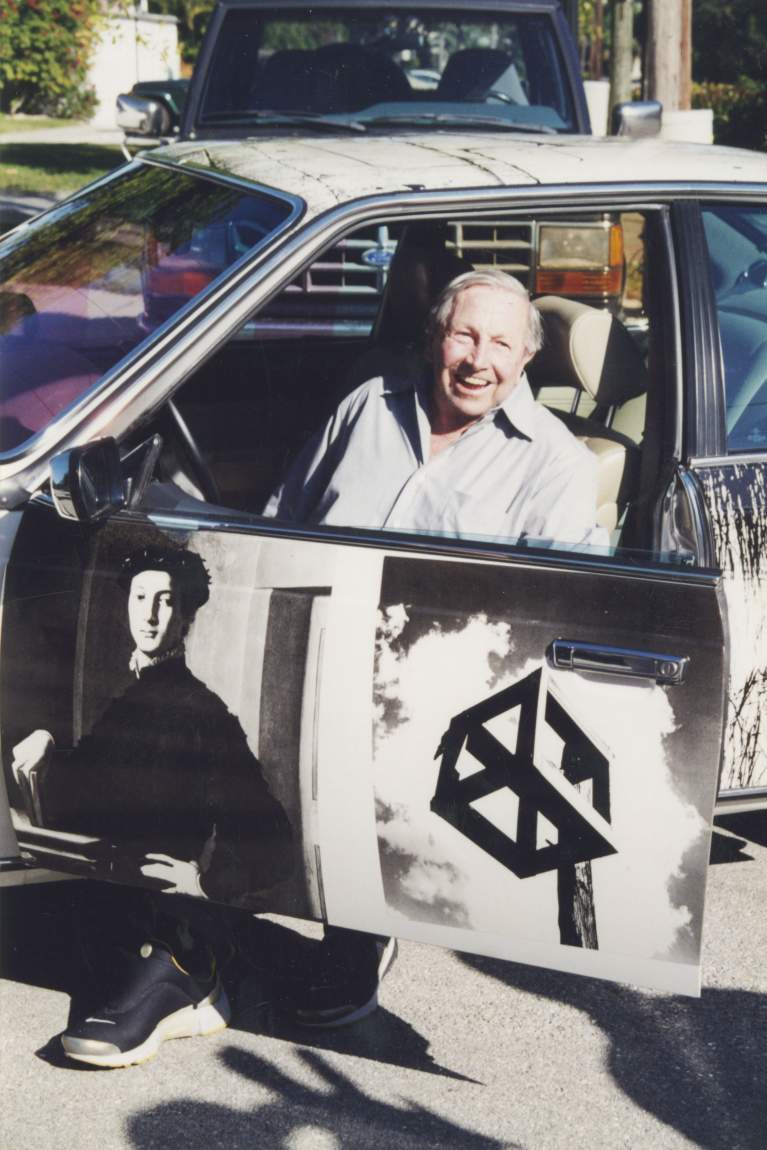 Rauschenberg with his Art Car-BMW (1986), at the exhibition Robert Rauschenberg: Beamers, Eckert Fine Art, Naples, Florida, 2002
Rauschenberg with his Art Car-BMW (1986), at the exhibition Robert Rauschenberg: Beamers, Eckert Fine Art, Naples, Florida, 2002
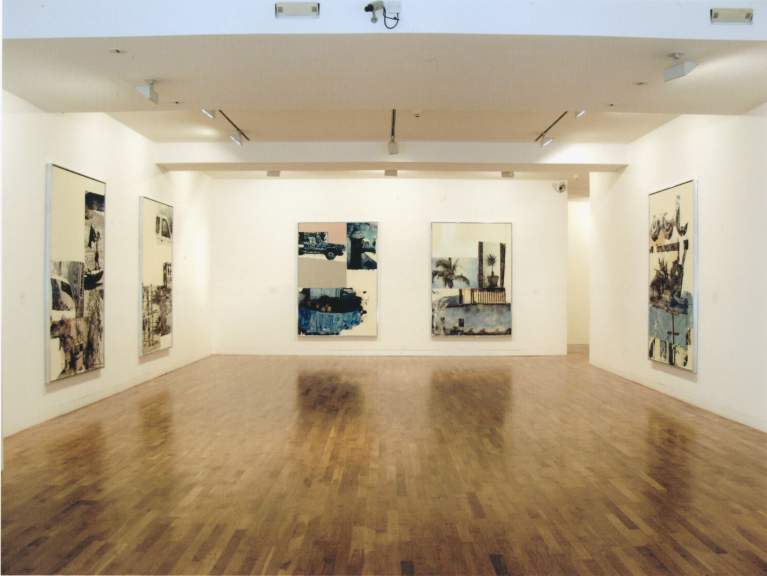 Installation view, Robert Rauschenberg: Short Stories, Waddington Galleries, London, 2002
Installation view, Robert Rauschenberg: Short Stories, Waddington Galleries, London, 2002
2003
As a result of his stroke the previous year, Rauschenberg is no longer able to hold a camera. His paintings now include source photographs taken by various studio assistants and employees who travel internationally capturing images for possible use in the artist’s paintings.
January 16–18: Participates in benefit auction, Pace Gallery, New York, in support of the Trisha Brown Dance Company.
February 6–March 30: Rauschenberg Reprise, Simmons Visual Arts Center, Brenau University, Gainesville, Georgia. Also on view is Quattro Mani: The Collaborative Work of Robert Rauschenberg and Darryl Pottorf, in the university’s Presidents Gallery. Coinciding with the opening reception for the dual exhibitions, Rauschenberg and Pottorf participate in a public conversation.
March–April: Featured in AARP The Magazine’s “The Fearless 50” list, highlighting America’s most innovative people older than fifty.
March 15–April 26: Robert Rauschenberg: Prints and Unique Works, Jim Kempner Fine Art, New York.
April 4–May 3: Robert Rauschenberg: Short Stories: You Are the Author, PaceWildenstein, New York. The artist says of the work: “The more open they are, the more room there is for spectators to get involved. I don’t want my personal taste to be part of the viewer’s inhibitions or blindness. The more I don’t say, the more room there is for you to say. And if I happen to find out what you think. . . . Well, I enjoy that, too.”1
April 12: Works are exhibited as part of Sharing the Treasures Gala, Harry Ransom Center, University of Texas at Austin, highlighting literary and artistic “treasures” from the collection.
May 15–November 2: American Pop Icons, Guggenheim Hermitage Museum, Venetian, Las Vegas. This show is the first exhibition in the Guggenheim’s Las Vegas location, having opened in October 2001, to include Rauschenberg’s work, narrating the development of the Pop art with iconic works from the postwar period.
July 22–October 19: Rauschenberg’s portrait is featured in the exhibition Photographs of Artists by Alexander Liberman, curated by Glenn Phillips, Getty Research Institute Exhibition Gallery, Los Angeles.
August: Collectors Robert E. and Jane B. Meyerhoff promise their esteemed collection that includes the work of Ellsworth Kelly, Roy Lichtenstein, and Rauschenberg, to the National Gallery of Art, Washington, D.C.
October 14: Joins Merce Cunningham, Jasper Johns, as well as former Cunningham dancer Carolyn Brown and the musicians of Radiohead and Sigur Rós on stage in the final week of the Merce Cunningham Dance Company’s fiftieth-anniversary season to take part in the ritualistic roll of the dice, determining the order of the evening’s performances.
October 16: Attends opening of his close friend James Rosenquist’s retrospective at the Solomon R. Guggenheim Museum, New York. In conjunction with the exhibition, the museum will host a conversation between the artists on December 16, moderated by Guggenheim curators Sarah Bancroft and Walter Hopps.
October 18: Serves as an honorary chair, along with actors Richard Gere and Carey Lowell, for the twenty-fifth anniversary gala celebration of the Northern Westchester Center for the Arts at the Performing Arts Center, Purchase College, Harrison, New York.
November 4: Robert S. Mattison, Marshall R. Metzgar Professor of Art History, Lafayette College, Easton, Pennsylvania, and author of Robert Rauschenberg: Breaking Boundaries, hosts the lecture Robert Rauschenberg: Inside and Out, examining select projects to discuss the artist’s working procedures and artistic choices, including those pertaining to the performing arts.
December 3: Attends opening of his one-person exhibition at the Galerie Jamileh Weber booth at Art Basel Miami Beach. The show includes works from series that the span his career: Carnal Clock (1969), Currents (1970), Cardboard (1971–72), Jammer (1975–76), Spread (1975–83), Scale (1977–81), Glut (1986–89/1991–94), Urban Bourbon (1988–96), Borealis (1989–92), ROCI TIBET (1985), ROCI CUBA (1988), and his more-recent Apogamy Pods (1999–2000) and Short Stories (2000–02).
- 1. Sarah Schmerler, “3 Questions for Robert Rauschenberg,” Time Out New York, no. 392 (April 3–10, 2003), p. 6.

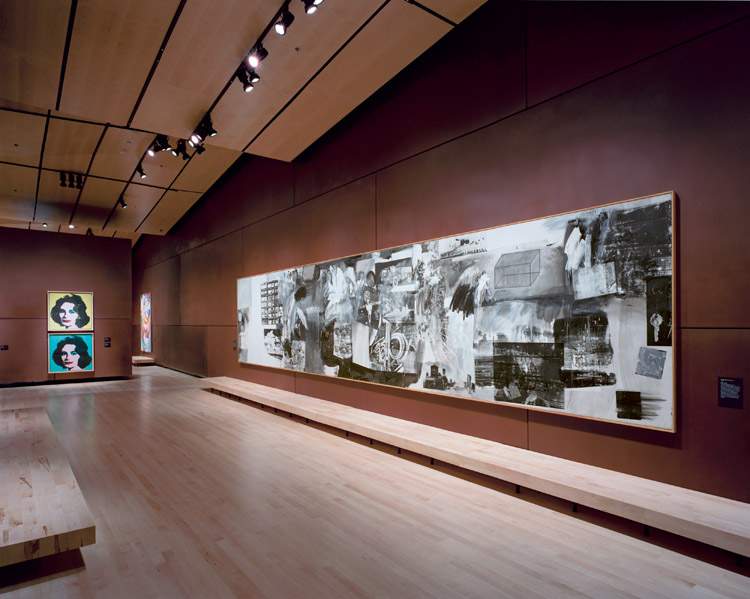 Installation view, American Pop Icons, Guggenheim Hermitage Museum, Venetian, Las Vegas, 2003. Work shown at right is Rauschenberg’s Barge (1962–63)
Installation view, American Pop Icons, Guggenheim Hermitage Museum, Venetian, Las Vegas, 2003. Work shown at right is Rauschenberg’s Barge (1962–63)
2004
January: At the opening of The East Village Now and Then: A 20 Year Anniversary, Studio 18 Gallery, New York, artist Michael Bidlo theatrically re-creates Rauschenberg’s Erased de Kooning Drawing (1953), a performance Bidlo first staged in 2001, using Bidlo’s drawing inspired by Willem de Kooning’s Woman I (1950–52).
January 11: Billy Klüver, friend and founding member of E.A.T. (Experiments in Art and Technology) alongside Rauschenberg, Fred Waldhauer, and Robert Whitman, dies at age seventy-six in his home in Berkeley Heights, New Jersey.
January 22: Eckert Fine Art, Naples, Florida, hosts a private reception for Rauschenberg and Dorothy Lichtenstein in celebration of the dual exhibitions Rauschenberg: 7 Chinese Characters and Lichtenstein: Chinese Landscapes (January 19–February 7).
January 31–March 18: Robert Rauschenberg: An American Iconoclast, Vanderbilt University Fine Arts Gallery, Nashville. The exhibition, which includes works from the Wax Fire Works series (1990–91) and a selection of photographs from Study for Chinese Summerhall (1983), honors a major gift to the university from Donald and Ruth Saff.
February: Moderna Museet, Stockholm, which has a strong collection of Rauschenberg’s work, including his Combine Monogram (1955–59), creates a new institutional logo using Rauschenberg’s recognizable script.
February 7–September 5: Robert Rauschenberg: Current Scenarios, Wadsworth Atheneum, Hartford, Connecticut. In the first public showing of the Scenarios (2002–06), seventeen are on display. The large-scale panels feature commonplace images, such as traffic signs, billboards, plants, and animals, derived from the artist’s existing photographs. The artist says of his imagery: “I like photographs of anything uninteresting. Maybe just two doors on a wall.”1 The exhibition also includes Gluts (1986–89/1991–94) and works from the museum’s collection, Features (from Currents) and Surface Series (from Currents) (both 1970).
February 29–June 6: First retrospective in Italy, Rauschenberg, curated by Susan Davidson and David White, is on view at the Palazzo dei Diamanti, Ferrara, Italy. Works created over the previous six decades, many of which were inspired by the artist’s long-standing engagement with the country, are included.
March 7: Named first recipient of the Angels of the Arts Award for Lifetime Achievement, Lee County Alliance for the Arts, Fort Myers, Florida.
May: Publication is released in celebration of the Art in Embassies program’s fortieth anniversary, and a number of exhibitions are held around the world. Rauschenberg’s work is included in the following presentations: A Century of American Art (Copenhagen), Faces of America by Contemporary American Artists (Moscow), and Late Nineteenth and Twentieth Century American Art (New York).
May 20–July 3: Repeat Performance, Artists Space, New York. The show features the work of emerging artists whose creative efforts are inspired by—and oftentimes use—that of other artists and architects as points of departure. Jeff Feld’s print The only part of Robert Rauschenberg’s “Pelican” that I know (2001) is on view.
June: Untitled (Mirror) (1952) is among the eighty-one newly acquired drawings at the Museum of Modern Art, New York, from trustee Werner H. Kramarsky.
June 4–July 11: Bob Rauschenberg Gallery is inaugurated at Edison College, Fort Myers, Florida, in honor of the artist’s twenty-five-year engagement with the college. It is the first institutional facility to be named after the artist. On view as part of the gallery’s inaugural exhibition, Rauschenberg: Scenarios are ten works from the Short Stories (2000–02) and Scenario (2002–06) series.
July 15–August 28: Robert Rauschenberg: Paintings, Screenprints and Lithographs, John Berggruen Gallery, San Francisco.
August 8: Appears on CBS Sunday Morning with Morley Safer. The program features footage from an earlier interview at the artist’s home in Captiva, Florida, on March 10, 2002. Rauschenberg is adamant that his best work is yet to come, saying: “Wouldn’t you just hate the fact if the future wasn’t the best thing you ever did?”2
August 13: Hurricane Charley reaches the Gulf Coast of Florida, with the eye traveling almost directly over Captiva, where the artist, his friends, and studio staff remain throughout the storm. The eight houses and studios on his twenty-acre property sustain mostly water damage, but the surrounding jungle is decimated. The artist evacuates the island by helicopter the next day. He takes this opportunity to renovate his living quarters and puts considerable effort into replanting the jungle, He later says: “You have to keep step—don’t fall behind. The hurricane has gotten in the way, but you can’t let things stay in your way. . . . There is no life without art.”3
October: Menil Collection, Houston, acquires Glider (1962), a mural-size black-and-white silkscreen painting that adds to the museum’s significant holdings by the artist.
Robert Rauschenberg Gallery opens within the Museum of the Gulf Coast, Port Arthur, Texas. The gallery’s permanent installation features twenty-one works donated or loaned by the artist, including Opal Gospel (1971) and prints from his ROCI (1985–90) and Star Quarters (1971) suites.
Featured as Lifetime Achievement Award winner in the October issue of Gulfshore Life as one of the thirteen “Men and Women of the Year,” a list highlighting outstanding citizens of Southwest Florida.
October 18: Contributes limited-edition print to the Artists Coming Together exhibition and benefit auction for ACT (America Coming Together), mounted at Matthew Marks Gallery, New York, helping to elect Democratic candidates to federal, state, and local positions.
October 20: Participates in Vote With Your Art exhibition, OK Harris, New York, joining “artists and collectors who share a passion for art and a desire to restore America’s standing in the world after four years of the [George W.] Bush administration.”4
October 28, 2004–January 22, 2005: Robert Rauschenberg, Artist-Citizen: Posters for a Better World, University Art Gallery, California State University, Hayward. Among the institutions to which it will travel are the Dallas Museum of Art; Hofstra University Museum, Hempstead, New York; and the Bob Rauschenberg Gallery, Edison College, Fort Myers, Florida, through early 2008. The exhibition focuses on posters made between 1969 and 1996 that address political and social concerns.
November 14: Invited to design a menu, along with a number of artists, for the twenty-fifth anniversary of the famed New York restaurant Chanterelle, where he has dined regularly over the years.
November 16: Attends reopening of the Museum of Modern Art, New York, following the redesign of its building by architect Yoshio Taniguchi that provides additional space for the work of Rauschenberg and his contemporaries.
November 20–22: Featured among other artists at a party and auction hosted at Sotheby’s, New York, in honor of the tenth anniversary of ARTWALK NY, the proceeds from which benefit the Coalition for the Homeless.
December 13–17: Represents the United States in the Olympic Truce: Pieces of Peace exhibition, sponsored by the Delegation of the European Commission in the United States. Artists from around the globe present artwork and performing arts from their distinct cultures as part of a multinational effort toward peace and unity and to examine the intersection of art and politics. The show includes Pull (Hoarfrost Edition) (1974).
- 1. Deborah Solomon, “Growing Old, Artfully,” New York Times Magazine, Feb. 15, 2004, p. 13. Accessed Oct. 10, 2010. http://www.nytimes.com/2004/02/15/magazine/15QUESTIONS.html.
- 2. Transcript of footage for “CBS Sunday Morning,” Aug. 8, 2004. Robert Rauschenberg Archives, Robert Rauschenberg Foundation.
- 3. Barbara Linstrom-Arnold, “Artists in Residence,” Times of the Islands (Sanibel, Fla.) 10, no. 2 (March–April 2005), p. 59.
- 4. Invitation card for “Vote with Your Art, OK Harris, New York, Oct. 20, 2004, Robert Rauschenberg Archives, Robert Rauschenberg Foundation.

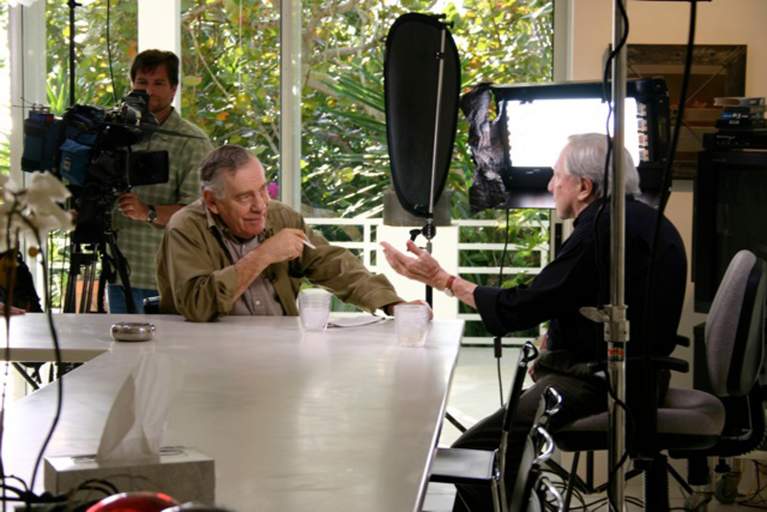 Rauschenberg being interviewed by Morley Safer at the artist’s Gulf House, Captiva, Florida, 2004. Photo: Laurence Getford
Rauschenberg being interviewed by Morley Safer at the artist’s Gulf House, Captiva, Florida, 2004. Photo: Laurence Getford
2005
January 7–February 26: A Quake in Paradise (Labyrinth) (1994) is shown for the first time in the United States, at the Bob Rauschenberg Gallery, Edison College, Fort Myers, Florida.
January 14–February 5: Robert Rauschenberg: Scenarios, PaceWildenstein, New York.
January 14–March 12: Robert Mapplethorpe’s portrait of Rauschenberg appears alongside images of art-world contemporaries, including Louise Bourgeois and Andy Warhol, in Mapplethorpe’s solo exhibition, curated by David Hockney, at Alison Jacques Gallery, London.
March 4–July 3: Robert Rauschenberg, Miami Art Museum. The exhibition, curated by Peter Boswell, includes new paintings from the Scenario series (2002–06). In the accompanying brochure, Oscar Hijuelos writes: “They are anti-advertisements about American life, and fly in the face of the polished and neatly organized documents that we, in our information-glutted age, live with daily.”1
March 10–June 12: Robert Rauschenberg: Posters, Los Angeles County Museum of Art. The exhibition, curated by Carter Foster, includes more than one hundred mass-editioned posters from the 1960s to the present.
March 17–May 15: Robert Rauschenberg, organized by Susan Davidson and David White and featuring works from the Glut series (1986–89/1991–94), is on view at the IVAM Centre Julio González, Valencià, Spain. The artist is awarded the fifth Julio González International Prize by the Conseil de la Generalitat Valenciana and the museum for his lifetime contribution to contemporary art. Previous recipients include Georg Baselitz, Eduardo Chillida, Markus Lüpertz, Anish Kapoor, and Cy Twombly.
March 19: Exhibits work in the Dallas Center for Contemporary Art’s annual Wish! fundraising exhibition and auction.
March 20: Walter Hopps, legendary art-world figure, founding director of the Menil Collection, and organizer of several important exhibitions of the artist’s work, including the 1976 and 1997 retrospectives, dies at age seventy-two.
April 13: Honored at the thirty-fifth Anniversary Gala, Trisha Brown Dance Company, New York, for his continued assistance and support, having served as the long-term chair of the board of directors. The company commemorates the anniversary with performances at Lincoln Center’s new Rose Theater, New York—the first program devoted to a retrospective of Trisha Brown’s projects with Rauschenberg, including Glacial Decoy (1979), Set and Reset (1983), and Astral Convertible (1989).
April 27: Moderna Museet, Stockholm, hosts the first of three seminars, in which scholars, critics, curators, and art historians explore questions relating to both the interpretation and institutionalization of the postwar art world through the lens of Rauschenberg’s oeuvre. This series is in anticipation of Robert Rauschenberg: Combines, February 17–May 6, 2007.
May 13: National Gallery of Art, Washington, D.C., trustees host a dinner for the Friends of the Lab School, Washington, D.C. Christopher Rauschenberg, the artist’s son, presents Robert Rauschenberg Foundation Award Certificates honoring outstanding art educators from around the country who teach students with learning disabilities.
May 21–September 3: Robert Rauschenberg: Scenarios and Short Stories, Paul and Lulu Hilliard University Art Museum, University of Louisiana, Lafayette, the hometown of the artist’s family since 1945. Running concurrently are exhibitions by the artist’s son, photographer Christopher Rauschenberg, and Darryl Pottorf. In celebration of the artist’s homecoming, the university hosts a conversation between Rauschenberg, Trisha Brown, jazz musician Richard “Dickie” Landry, Pottorf, and Christopher Rauschenberg (May 27). All three exhibitions travel to Herron Galleries, Herron School of Art and Design, Indiana University–Purdue University Indianapolis (September 10–October 8) and Jepson Center for the Arts, Telfair Museum of Art, Savannah, Georgia (March 10–June 4, 2006).
June: Museum of Modern Art, New York, acquires the artist’s painting Rebus (1955) for a reported $30 million, fulfilling a long-term goal of more than forty years when the museum tried unsuccessfully to acquire the Combine in the early 1960s. As recounted by MoMA’s chief curator of painting and sculpture John Elderfield, the museum’s founding director, Alfred H. Barr, Jr., had asked Jasper Johns in 1963 which Rauschenberg work the museum should purchase, to which the artist immediately replied Rebus.2 The Combine is on view for the first time on August 10 in the museum’s Donald B. and Catherine C. Marron Atrium near the installation of Cy Twombly’s monumental work The Four Seasons: Spring, Summer, Autumn and Winter (1993–94).
June 24, 2005–January 8, 2006: Robert Rauschenberg: On and Off the Wall, Oeuvres des Années 80 & 90 [Works from the 80’s and the 90’s], Musée d’Art Moderne et d’Art Contemporain, Nice, France. The show, curated by Susan Davidson and David White, will travel to the Aarhus Kunstmuseum, Denmark. On display are works from the series Borealis (1989–92), Glut (1986–89/1991–94), Night Shade (1991), Photem Series (1981/ 1991), and Urban Bourbon (1988–96) as well as A Quake in Paradise (Labyrinth) (1994).
August 12–October 23: Robert Rauschenberg: Hoarfrosts, Guild Hall, East Hampton, New York. The exhibition, organized by White, includes sixteen works from the Hoarfrost series (1974–76).
September 21–25: Taking Rauschenberg’s Erased de Kooning Drawing (1953) as its point of departure, choreographer Anne Teresa De Keersmaeker performs Erase-E(x), in which the choreographer, members of the Wooster Group, and film actress Isabella Soupart take part in figuratively “erasing” De Keersmaeker’s work at REDCAT, Walt Disney Concert Hall, Los Angeles.
November: Metropolitan Museum of Art, New York, acquires Winter Pool (1959), a Combine in which two panels are joined together by a wooden ladder. It is the first painting by the artist to enter into the collection and is exhibited as part of Robert Rauschenberg: Combines, December 20, 2005–April 2, 2006.
November 5: Contributes to benefit auction Flappers to Forties, featuring hard hats painted by local artists in an effort to raise funds to turn the historic federal courthouse in downtown Fort Myers, Florida, into the Florida Arts Cultural Center.
November 7: Honored, along with Matthew Barney, Richard Prince, Ed Ruscha, and Richard Serra, at the Guggenheim International Gala hosted at the Seagram Building, New York.
November 18: Kotz presents a lecture at the Dallas Museum of Art in conjunction with Dialogues: Duchamp, Cornell, Johns, Rauschenberg, September 4, 2005–January 8, 2006.
December: A dinner is held at the Alfred I. DuPont Building as part of Art Basel Miami Beach. The evening begins with a multifaceted homage to Rauschenberg, with contributions from artist James Rosenquist, writer Alain Robbe-Grillet, and musician Arto Lindsay.
December 20, 2005–April 2, 2006: Robert Rauschenberg: Combines, curated by Paul Schimmel, Metropolitan Museum of Art, New York. It is organized by and will travel to the Museum of Contemporary Art, Los Angeles, where the artist is honored at the annual gala on May 19, 2006; Centre Georges Pompidou, Musée National d’Art Moderne, Paris; and Moderna Museet, Stockholm. The first exhibition devoted solely to the artist’s Combines, it showcases sixty-seven works made between 1954 and 1964 and highlights the strategy by which Rauschenberg reinvented collage. The artist describes the experience of seeing the works as one of “joy, like seeing old friends you haven’t seen in decades.”3 In his review of the exhibition, critic Robert Hughes sums up Rauschenberg’s pragmatic worldview in the 1950s and 1960s: “He didn’t give a damn about pie in the sky; what interested him more was a disc of used rubber from a truck tyre in the street, and what might happen if you nailed it on a striped board as part of a randomly accumulated ‘palette of objects.’”4 The Association of Art Museum Curators cited Robert Rauschenberg: Combines as one of the year’s most outstanding exhibitions nationwide and the catalogue was named the most outstanding book of the year.
- 1. Quoted in Rauschenberg Scenarios, exh. cat. (New York: PaceWildenstein, 2005), pp. 7–8.
- 2. Carol Vogel, “The Modern Buys ‘Rebus,’” New York Times, June 17, 2005. Accessed October 1, 2014. http://www.nytimes.com/2005/06/17/arts/design/17voge.html.
- 3. Carol Vogel, “The Robert Rauschenberg Reunion Tour,” New York Times, Dec. 18, 2005. Accessed October 1, 2014. http://www.nytimes.com/2005/12/18/arts/design/18vogel.html.
- 4. Robert Hughes, “Spirit of the Age,” Guardian (London), Jan. 25, 2006. Accessed October 1, 2014. http://www.theguardian.com/artanddesign/2006/jan/26/art1.

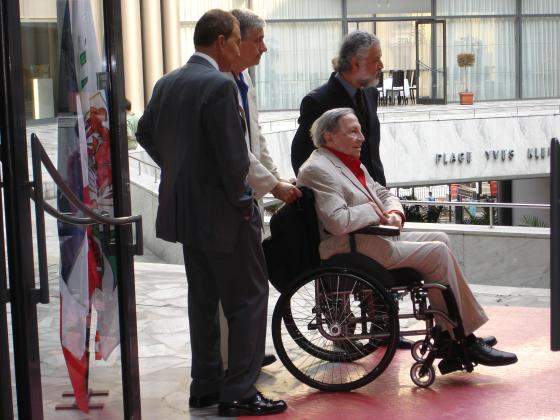 Exhibition opening for Rauschenberg: On and Off the Wall: Works from the 1980s and 1990s, Musée d’Art Moderne et d’Art Contemporain (MAMAC), Nice, June 2005. Photo: Thomas Buehler
Exhibition opening for Rauschenberg: On and Off the Wall: Works from the 1980s and 1990s, Musée d’Art Moderne et d’Art Contemporain (MAMAC), Nice, June 2005. Photo: Thomas Buehler
2006
The sculpture The Ancient Incident (Kabal American Zephyr) (1981) is cast in bronze in an edition of five with an artist’s proof.
February: Contributes to auction held in conjunction with the second annual Champagne & Chocolate Jazz & Casino Night at the Atrium, Fort Myers, Florida, supported by the Florida Repertory Theater in an effort to raise funds for its arts and education programs.
February 5: In conjunction with Robert Rauschenberg: Combines, the Metropolitan Museum of Art, New York, hosts a conversation between the artist and Calvin Tomkins. They will reprise this conversation at the Museum of Contemporary Art, Los Angeles, on May 21. Curators Nan Rosenthal and Paul Schimmel serve as the moderators at their respective institutions.
February 16: Contributes to Choice Art 2006 auction held at Sotheby’s, New York, to benefit the Planned Parenthood Federation of America.
April 17: Honored by Merce Cunningham Dance Company at its benefit gala, To Bob with Love Merce. The event nancelebrates Rauschenberg and Cunningham’s long-running collaboration with a display of Rauschenberg-designed costumes and a world premiere of the composition For Bob by Takehisa Kosugi and Christian Wolff.
April 26: In conjunction with the exhibition Robert Rauschenberg: Scenarios and Short Stories, Jepson Center for the Arts, Telfair Museum of Art, Savannah, Georgia, Rauschenberg participates in a panel discussion with Darryl Pottorf and the artist’s son Christopher Rauschenberg.
April 28–September 24: Art From Life: Prints by Robert Rauschenberg from the Marmor Foundation and the Fearer Family Collection, Iris and B. Gerald Cantor Center for Visual Arts, Stanford University, Palo Alto, California, focuses on the artist’s work with Universal Limited Art Editions (ULAE), West Islip, New York, and Gemini G.E.L., Los Angeles, over the previous four decades.
May: Rauschenberg, a Port Arthur, Texas, native, provides a grant to the art department at the local Port Arthur Memorial High School after the school suffered severe damage in the wake of Hurricane Rita.
October 27–November 25: Robert Rauschenberg: Scenarios and The Ancient Incident, PaceWildenstein, New York.
November 7, 2006–January 17, 2007: Rauschenberg: Express, organized by Barbara Rose, is the first exhibition dedicated to a living artist at the Museo Thyssen-Bornemisza, Madrid. The show focuses on his silkscreen paintings, which includes Express (1963) from the museum’s collection, as well as several of the Dante drawings (1958–60).
December: Begins Runts (2006–08), which will be the artist’s last painting series. It gains its title from the fact that the paintings are smaller than the Scenarios (2002–06); however, the artist executes them using the same methods. The series debuts at Galerie Jamileh Weber, Zurich, in May 2007, and the artist continues to work on the series into the following year.
 Calvin Tomkins, Rauschenberg, and Nan Rosenthal, Metropolitan Museum of Art, New York, 2006. Still from "Robert Rauschenberg and Calvin Tomkins: A Conversation about Art and Life.”
Calvin Tomkins, Rauschenberg, and Nan Rosenthal, Metropolitan Museum of Art, New York, 2006. Still from "Robert Rauschenberg and Calvin Tomkins: A Conversation about Art and Life.”
2007
January 12–February 24: Rauschenberg: Scenarios, Bob Rauschenberg Gallery, Edison College, Fort Myers, Florida. The exhibition features his most recent Scenarios, from 2006, which have not previously been shown.
February 10–April 5: Barge (1962–63) and Wrong Distance [Anagram (A Pun)] (1997) are included in the traveling exhibition, Art in America: 300 Years of Innovation, organized by the Solomon R. Guggenheim Museum, New York, in partnership with the Terra Foundation for American Art, Chicago, and premiering at the National Art Museum of China, Beijing. Solomon R. Guggenheim Foundation director Thomas Krens leads the curatorial team, which includes Susan Davidson from the Guggenheim, Elizabeth Kennedy from the Terra Foundation, and Nancy Mowell Matthews from the Williams College Museum of Art. This is the first time since ROCI China (1985) that Rauschenberg’s work will be exhibited in China.
February 23: Inspired by her meeting with the artist at his studio in Captiva, Florida, in 2006, choreographer and photographer Claire Parsons returns to Stockholm to create the performance, Hej Robert! in conjunction with the traveling exhibition Robert Rauschenberg: Combines, on view at Moderna Museet, Stockholm, February 17–May 6. The choreography is performed by Jennie Lindström.
February 23–March 17: Robert Rauschenberg: Transfer Drawings from the 1960s, Jonathan O’Hara Gallery, New York. The exhibition contains forty-four drawings, with imagery ranging from portraits of Malcolm X and Richard Nixon to the Apollo 7 astronauts and Merce Cunningham as well as newspaper headlines. In her review, critic Roberta Smith notes that the transfer hatching marks could be a “cousin, once removed, of Pollock’s drips.”1
February 23–May 13: Robert Rauschenberg: Cardboards and Related Pieces, conceived by the late Walter Hopps and current Menil Collection director Josef Helfenstein, Menil Collection, Houston. It is the first comprehensive viewing of these works and the first major exhibition of cardboard pieces since the artist began them in 1971. On February 24, the museum presents a conversation with Rauschenberg, Davidson, and Helfenstein.
March 6: Following a performance in Naples, Florida, Merce Cunningham Dance Company members, staff, and friends join Rauschenberg on Captiva Island where the artist hosts an afternoon picnic. Reflecting on the day, Cunningham states, “Out the window was the sea, with palm trees partially concealing it, and the indoors on the walls of the studio hung a series of new paintings that Bob had made. It was a splendid end to our Florida tour.”2
April 28–May 13: Being Robert Rauschenberg, Zon Moderna with Peter Geschwind, Moderna Museet, Stockholm. Created for the educational outreach project Zon Moderna 2007 and inspired by the movie Being John Malkovich (1999), artist Peter Geschwind designs a room to reflect the inside of Rauschenberg’s head. Here a collage of impressions, interpretations, and ideas develop at the hands of the project participants.
May: Collaged label design for the Taittinger Collection of specially commissioned vintage champagne bottles is released.
May 8: Attends American Patrons of Tate Artists Dinner, Riverfront Pavilion, New York.
May 15: Photograph (1959), a Combine, sells for a reported $10.68 million at the Sotheby’s Contemporary Art Evening Sale, New York—a record for the artist at auction.
May 18: Robert Rauschenberg Foundation; Lab School of Washington, D.C.; and the artist’s son Christopher Rauschenberg host an event at the Corcoran Gallery of Art, Washington, D.C., honoring outstanding art educators from around the country who teach students with learning disabilities.
May 25–September 8: Signs of Life: Robert Rauschenberg Posters, Black Mountain College Museum and Arts Center, near Asheville, North Carolina. It contains nearly two dozen posters collected over the previous three decades by Rauschenberg biographer Mary Lynn Kotz.
June 19–October 13: Invention: Merce Cunningham & Collaborators, New York Public Library for the Performing Arts. The exhibition features a range of photographs, manuscripts, designs, and other memorabilia that span the sixty-year career of choreographer Cunningham and his noted collaborators, Rauschenberg among them, whose visual art complemented and completed the performance experience.
September 15, 2007–February 17, 2008: Robert Rauschenberg’s Currents: Features and Surface Series, Michael C. Carlos Museum, Emory University, Atlanta.
October: Begins Lotus paintings, created as the basis for the Lotus series, a suite of twelve prints in an edition of fifty each, published by Universal Limited Art Editions (ULAE), West Islip, New York in 2008. The images are derived from photographs the artist took in China in 1982; each print includes an embossed image of a lotus in a different color. The complete series is shown for the first time posthumously in 2008.
October 5: Merce Cunningham Dance Company’s performance XOVER premieres at Dartmouth College, Hanover, New Hampshire, with a set and costumes designed by Rauschenberg, adapted from his painting Plank (2003) from the Scenario series (2002–06). The piece, which includes music by John Cage, is described as a tribute by Cunningham to Cage and Rauschenberg, his two most important collaborators.
October 21: Ileana Sonnabend, Rauschenberg’s friend and former dealer who helped to establish his reputation both in the United States and abroad, dies at age ninety-two.
October 26, 2007–March 30, 2008: Robert Rauschenberg: Travelling ’70–’76, curated by Mirta d’Argenzio, Museu de Arte Contemporânea de Serralves, Porto, Portugal. The exhibition, which includes works from the series Cardboard (1971–72), Early Egyptian (1973–74), Hoarfrost (1974–76), Jammer (1975–76), Venetian (1972–73), among others, will travel to the Haus der Kunst, Munich, and the Museo d’Arte Contemporanea Donnaregina, Naples.
October 28, 2007–March 30, 2008: Let the World In: Prints by Robert Rauschenberg from the National Gallery of Art and Related Collections, National Gallery of Art, Washington, D.C.
November: Donates $100,000 to a local AIDS treatment center to be formally announced on World AIDS Day (December 1). In honor of this gift, the center is renamed the Bob Rauschenberg Center for Living, as it provides care for patients with HIV and AIDS, many of whom are uninsured and in need.
November 24, 2007–January 26, 2008: Robert Rauschenberg: Three Decades, Faurschou Beijing, the gallery’s inaugural exhibition. Included is work from the mid-1980s until 2007 that emphasizes the artist’s American imagery. It is his first solo show in China since his Rauschenberg Overseas Culture Interchange tour in 1985.
- 1. Roberta Smith, “A Rarely Seen Side of a Rauschenberg Shift,” New York Times, March 8, 2007. Accessed July 31, 2014. http://query.nytimes.com/gst/fullpage.html.
- 2. Merce Cunningham, “Artistic Director’s Remarks,” Merce Cunningham Dance Company Newsletter 1, no. 3 (May 2007).

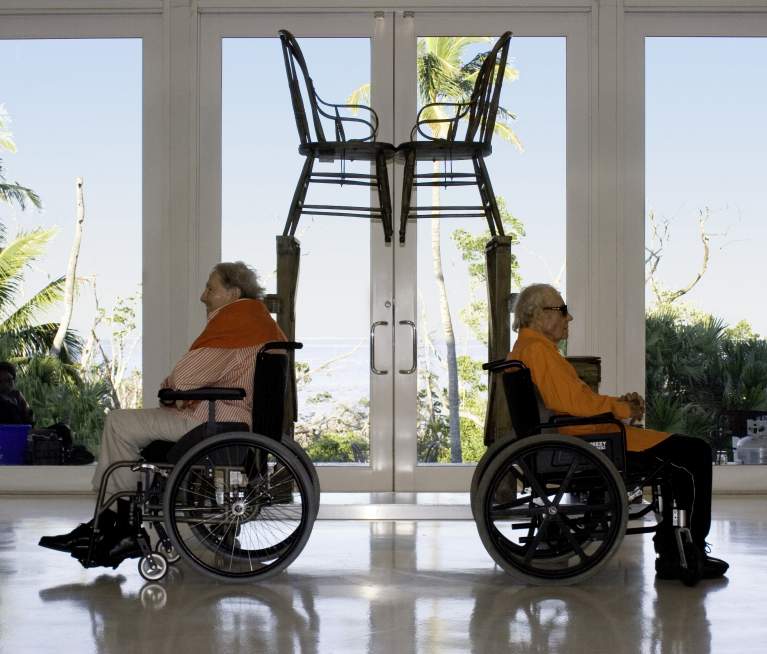 Rauschenberg and Merce Cunningham with Rauschenberg’s The Ancient Incident (Kabal American Zephyr) (1981/2006), Captiva Drive studio, Captiva, Florida, 2007. Photo: Attributed to Laurence Getford
Rauschenberg and Merce Cunningham with Rauschenberg’s The Ancient Incident (Kabal American Zephyr) (1981/2006), Captiva Drive studio, Captiva, Florida, 2007. Photo: Attributed to Laurence Getford

 Merce Cunningham Dance Company at Rauschenberg’s Captiva Drive studio, Florida, March 6, 2007. Photo: Laurence Getford
Merce Cunningham Dance Company at Rauschenberg’s Captiva Drive studio, Florida, March 6, 2007. Photo: Laurence Getford
2008
January 11–February 16: Robert Rauschenberg: Runts, Pace Gallery, New York.
January 30: In conjunction with the traveling exhibition Robert Rauschenberg, Artist-Citizen: Posters for a Better World, Donald Saff, Rauschenberg’s longtime friend and founder of Graphicstudio, USF Institute for Research in Art, Tampa, hosts a lecture at the Bob Rauschenberg Gallery at Edison State College, Fort Myers, Florida.
March 6–April 12: Last Turn–Your Turn: Robert Rauschenberg and the Environmental Crisis, Jacobson Howard Gallery, New York. The exhibition chronicles Rauschenberg’s prophetic rendering of current issues related to global warming and the intersection of industrial development and planetary health. Proceeds of sales from the exhibition benefit the Nurture Nature Foundation, New York, an organization dedicated to environmental protection.
May 12: Rauschenberg dies at age eighty-two in his studio in Captiva, Florida. In an obituary published on May 14, the New York Times lauds his many professional accomplishments: “he helped obscure the lines between painting and sculpture, painting and photography, photography and printmaking, sculpture and photography, sculpture and dance, sculpture and technology, technology and performance art—not to mention between art and life.”1 The September issue of Artforum dedicates a section to honoring Rauschenberg’s life and work, with essays by Thomas Crow, Branden W. Joseph, and Barbara Rose, and statements by Trisha Brown, Merce Cunningham, Brice Marden, James Rosenquist, and Robert Whitman. A memorial is organized in New York, with events at three locations around the city (October 26–27). The Museum of Modern Art hosts the panel discussion, Living and Working with Rauschenberg—A Conversation. Participants include Brown, Cunningham, Marden, Julie Martin, Darryl Pottorf, Dorothea Rockburne, Rose, Rosenquist, and Susan Weil. The Solomon R. Guggenheim Museum presents an exhibition of photographs by and of the artist, accompanied by a memory wall where visitors can leave comments. The Metropolitan Museum of Art hosts an event in the Temple of Dendur and the Grace Rainey Rogers Auditorium, with a roster of speakers that includes Janet Begneaud, Rick Begneaud, Janine Boardman, Brown, Bill Clinton, Chuck Close, Cunningham, Dennis Hopper (video message), Thomas Krens, Christophe de Menil, Pottorf, Christopher Rauschenberg, Rosenquist, Nan Rosenthal, Saff, and Edwin Schlossberg. Memorial events will also be held in two other cities: Los Angeles (November 23) and Venice (May 29, 2009), for the opening of the exhibition, Robert Rauschenberg: Gluts, Peggy Guggenheim Collection (May 30–September 20, 2009).
- 1. Michael Kimmelman, “Robert Rauschenberg: American Artist, Dies at 82,” New York Times, May 14, 2008. Accessed Oct. 1, 2014. http://www.nytimes.com/2008/05/14/arts/design/14rauschenberg.html.
